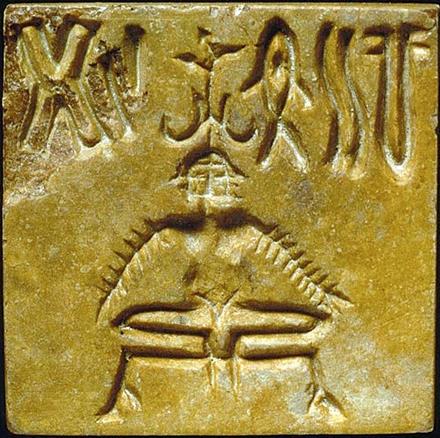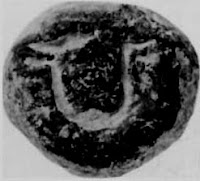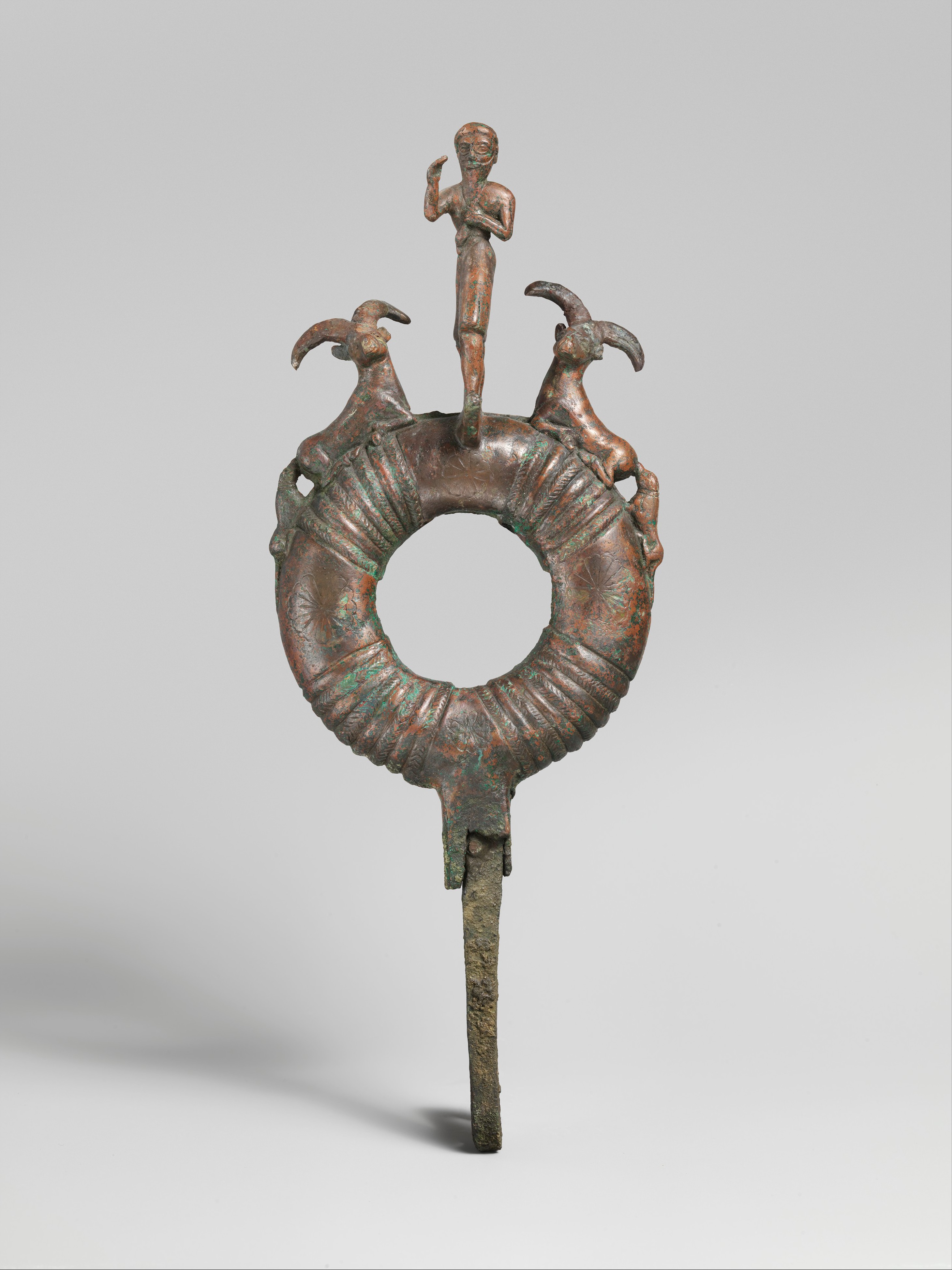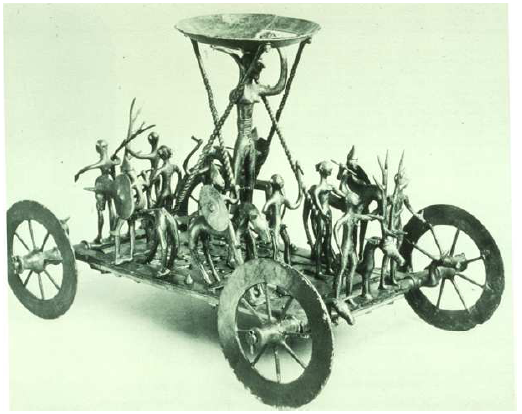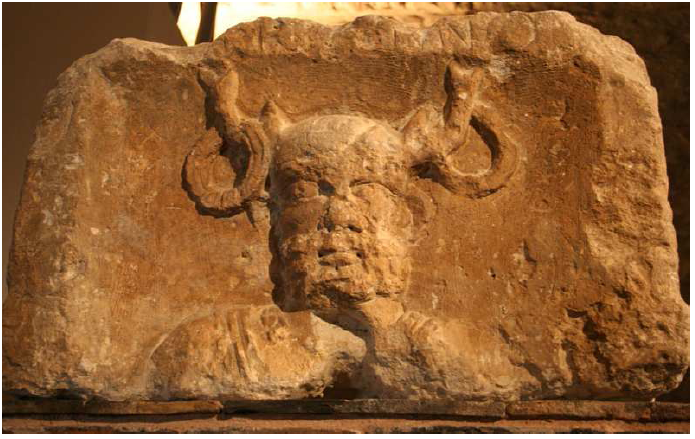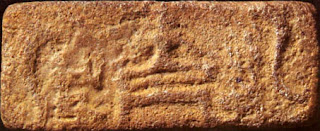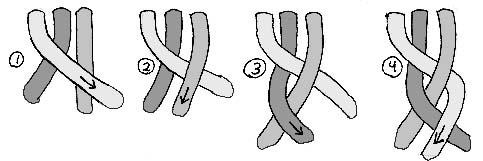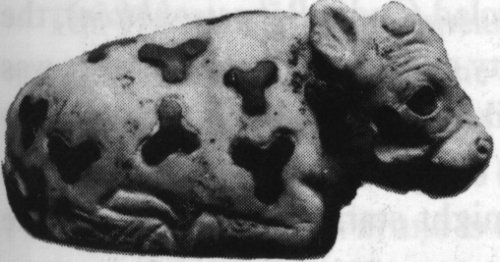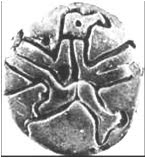Itihāsa. Early Islamic manufacture of crucible steel at Merv, Turkmenistan -- Dafydd Griffiths, Ann Feuerbach (1999)
Itihāsa. Kumbakonam: the ritual topography of a sacred and royal city of South India -- Vivek Nanda (1999)
Itihāsa. Indus Script metalwork hypertexts of trading civilization of Failaka, Saar & Barbar Temple, Bahrain.Dilmun revisited: excavations at Saar, Bahrain -- Harriet Crawford (1997) Excavations at Barbar Temple -- Hojlund, Flemming et al (2005)
https://tinyurl.com/ycozar7v
This monograph posits the presence of Meluhha artisans and seafaring merchants in Dilmun and failaka. This presence explains the decipherment of Dilmun seals, Barbar temple bronze bull's head and Failaka seals as Indus Script inscriptions constituting wealth-accounting ledgers, metalwork catalogues. Dilmun and Failaka seals are archives recording trade transactions with Meluhha (Sarasvati Civilization).
Dilmun finds mention in cuneiform texts as a trade partner and as a trading post of the Mesopotamia and the Indus Valley Civilization trade route. The bronze bull's head found in Barbar Temple of Bahrein is paralleled by the artifacts of Early Dynastic Sumer as posited by Elisabeth CL During Caspers and also by the Indus Script rebus representation of ḍhangra ‘bull’ Rebus: ṭhakkura m. ʻ idol, deity (Pkt.); Mth. ṭhākur ʻ blacksmith.ʼ Thus, the deity venerated as the bull's head is a veneration of the ancestor blacksmith who has attained divinity; hence, ṭhakkura m. ʻ idol, deity in Meluhha (Indian sprachbund, 'speech union'). Three temples were discovered in Barbar village, Bahrein, and the oldest is dated to 3000 BCE.
https://en.wikipedia.org/wiki/Barbar_Temple
Map with known natural distribution of softstone (adapted from David-Cuny, H, 2012, Introduction in: H. David-Cuny and I. Azpeitia (eds.) Failaka Seals catalogue Vol. 1, Al-Khidr, 13-27, Kuwaiti City, National Council for Culture, Arts and Letters, p. 19)
![]() Stamp seal no. 693. Disc profile concave, grey steatite, while-glazed. On the reverse three lines and four circles. Dia. 25 mm. A leaping lion (?) with claws, wide-open toothed jaws and sigmoid tail, followed by an antelope. Above the scene a snake with wide-open toothless jaws. The scales of the snake are indicated with close incisions from both sides. Between the lion and the gazelle a palm front. Below the lion an angular figure -- probably a crescent. (Hojlund, Flemming et al, 2005, p.115). (s)phaṭa-, sphaṭā- a serpent's expanded hood, Pkt. phaḍā id. rebus: phaḍā, paṭṭaḍa 'metals manufactory'. dhāḷ'slanted stroke' rebus: dhāḷako 'large ingot'. ranku 'antelope' rebus: ranku 'tin'.kola 'tiger' rebus: kol 'working in iron' kolhe 'smelter' PLUS panja 'feline paws' rebus: panja 'furnace, kiln'. kudi 'jump' rebus: kuṭhi 'smelter'
Stamp seal no. 693. Disc profile concave, grey steatite, while-glazed. On the reverse three lines and four circles. Dia. 25 mm. A leaping lion (?) with claws, wide-open toothed jaws and sigmoid tail, followed by an antelope. Above the scene a snake with wide-open toothless jaws. The scales of the snake are indicated with close incisions from both sides. Between the lion and the gazelle a palm front. Below the lion an angular figure -- probably a crescent. (Hojlund, Flemming et al, 2005, p.115). (s)phaṭa-, sphaṭā- a serpent's expanded hood, Pkt. phaḍā id. rebus: phaḍā, paṭṭaḍa 'metals manufactory'. dhāḷ'slanted stroke' rebus: dhāḷako 'large ingot'. ranku 'antelope' rebus: ranku 'tin'.kola 'tiger' rebus: kol 'working in iron' kolhe 'smelter' PLUS panja 'feline paws' rebus: panja 'furnace, kiln'. kudi 'jump' rebus: kuṭhi 'smelter'
This monograph posits the presence of Meluhha artisans and seafaring merchants in Dilmun and failaka. This presence explains the decipherment of Dilmun seals, Barbar temple bronze bull's head and Failaka seals as Indus Script inscriptions constituting wealth-accounting ledgers, metalwork catalogues. Dilmun and Failaka seals are archives recording trade transactions with Meluhha (Sarasvati Civilization).
Dilmun finds mention in cuneiform texts as a trade partner and as a trading post of the Mesopotamia and the Indus Valley Civilization trade route. The bronze bull's head found in Barbar Temple of Bahrein is paralleled by the artifacts of Early Dynastic Sumer as posited by Elisabeth CL During Caspers and also by the Indus Script rebus representation of ḍhangra ‘bull’ Rebus: ṭhakkura m. ʻ idol, deity (Pkt.); Mth. ṭhākur ʻ blacksmith.ʼ Thus, the deity venerated as the bull's head is a veneration of the ancestor blacksmith who has attained divinity; hence, ṭhakkura m. ʻ idol, deity in Meluhha (Indian sprachbund, 'speech union'). Three temples were discovered in Barbar village, Bahrein, and the oldest is dated to 3000 BCE.
https://en.wikipedia.org/wiki/Barbar_Temple
 Stamp seal no. 693. Disc profile concave, grey steatite, while-glazed. On the reverse three lines and four circles. Dia. 25 mm. A leaping lion (?) with claws, wide-open toothed jaws and sigmoid tail, followed by an antelope. Above the scene a snake with wide-open toothless jaws. The scales of the snake are indicated with close incisions from both sides. Between the lion and the gazelle a palm front. Below the lion an angular figure -- probably a crescent. (Hojlund, Flemming et al, 2005, p.115). (s)phaṭa-, sphaṭā- a serpent's expanded hood, Pkt. phaḍā id. rebus: phaḍā, paṭṭaḍa 'metals manufactory'. dhāḷ'slanted stroke' rebus: dhāḷako 'large ingot'. ranku 'antelope' rebus: ranku 'tin'.kola 'tiger' rebus: kol 'working in iron' kolhe 'smelter' PLUS panja 'feline paws' rebus: panja 'furnace, kiln'. kudi 'jump' rebus: kuṭhi 'smelter'
Stamp seal no. 693. Disc profile concave, grey steatite, while-glazed. On the reverse three lines and four circles. Dia. 25 mm. A leaping lion (?) with claws, wide-open toothed jaws and sigmoid tail, followed by an antelope. Above the scene a snake with wide-open toothless jaws. The scales of the snake are indicated with close incisions from both sides. Between the lion and the gazelle a palm front. Below the lion an angular figure -- probably a crescent. (Hojlund, Flemming et al, 2005, p.115). (s)phaṭa-, sphaṭā- a serpent's expanded hood, Pkt. phaḍā id. rebus: phaḍā, paṭṭaḍa 'metals manufactory'. dhāḷ'slanted stroke' rebus: dhāḷako 'large ingot'. ranku 'antelope' rebus: ranku 'tin'.kola 'tiger' rebus: kol 'working in iron' kolhe 'smelter' PLUS panja 'feline paws' rebus: panja 'furnace, kiln'. kudi 'jump' rebus: kuṭhi 'smelter' The Bull's Head from Barbar Temple II, Baḥrain A Contact with Early Dynastic Sumer
Elisabeth C. L. During CaspersEast and WestVol. 21, No. 3/4 (September-December 1971), pp. 217-223Published by: Istituto Italiano per l'Africa e l'Oriente (IsIAO)https://www.jstor.org/stable/29755698![]()
Add caption
See:Eric Olijdam and Helene David-Cuny, 2018, Dilmun-Meluhhan Relations Revisited in Light of Observations on Early Dilmun Seal Production during the City IIa-c Period (c. 2050-1800 BCE)In book: Walking with the Unicorn. Social Organization an Material Culture in Ancient South Asia. Jonathan Mark Kenoyer Felicitation Volume, Publisher: ISMEO / Archaeopress, pp. 406-432https://www.academia.edu/36750743/Dilmun-Meluhhan_Relations_Revisited_in_Light_of_Observations_on_Early_Dilmun_Seal_Production_during_the_City_IIa-c_Period_c._2050-1800_BC_ Abstract. This contribution brings together information on several aspects of early seal ownership and seal production during theCity IIa-c period. It shows that seals were common objects and that ownership was not restricted to specific professionsor socio-economic segments of society. Seals were made in small workshops, alongside other items of jewellery andpersonal ornaments. They were carved from exotic raw materials that had to be imported. Softstone was the mostcommon and there is mounting evidence that suggests a specific type of steatite was preferred by the ancient seal-cutters. Surface treatments were applied in order to achieve the desired effect of a shiny white seal. This dictated the preference for dolomitic steatite and limited the scope of possible alternative materials. It is suggested that the pyrotechniques that were employed and the choices that were made by the ancient seal-cutters form a technological style highly reminiscent of that of the Indus Civilization, including some of the important ideological associations. Thisapproach and its tentative outcomes bolster the commonly accepted theory of a westward transmission of Harappan sealing technology, which has so far been based primarily on iconographic analysis.
Dilmun seal morphology
Figure 4. Eleven seals from the workshop area in Excavation 520 at Qal’at al-Bahrain (Kjærum 1994: figs.1726, 1729, 1731– 2, 1734 – 5, 1737, 1739, 1741 – 43)
![]() Circular seal, of steatite, from Bahrein, found at Lothal.A Stamp seal and its impression from the Harappan site of Lothal north of Bombay, of the type also found in the contemporary cultures of southern Iraq and the Persian Gulf Area. http://www.penn.museum/sites/expedition/archaeology-in-india/
Circular seal, of steatite, from Bahrein, found at Lothal.A Stamp seal and its impression from the Harappan site of Lothal north of Bombay, of the type also found in the contemporary cultures of southern Iraq and the Persian Gulf Area. http://www.penn.museum/sites/expedition/archaeology-in-india/-
- http://www.bible-history.com/sketches/assyria/assyrian_stone_altar.html “Amongst the ruins of Khorsaba were discovered two circular altars, which are so much like the Greek tripod…The altar is supposed by three lion’s paws. Round the upperpart is an inscription, in cuneiform characters, containing the name of the Korsabad king.”
- (Sir Austen Henry Layard, 1849, Nineveh and its remains: with an account of a visit to the Chaldaean christians of Kurdistan, and the Yezidis, or devil worshippers, and an enquiry into the manners and arts of the ancient Assyrians, Volume 2, J. Murray,
- The feline paws at the bottom of the altar should be noted. In Meluhha (mleccha), Stamp seal no. 693. Disc profile concave, grey steatite, while-glazed. On the reverse three lines and four circles. Dia. 25 mm. A leaping lion (?) with claws, wide-open toothed jaws and sigmoid tail, followed by an antelope. Above the scene a snake with wide-open toothless jaws. The scales of the snake are indicated with close incisions from both sides. Between the lion and the gazelle a palm front. Below the lion an angular figure -- probably a crescent. (Hojlund, Flemming et al, 2005, p.115)
Feline paws shown on the Khorsabad altar are also seen on the hieroglyphs of the Elamite spinner:Bas relief fragment, called the 'spinner'. Louvre.
Technical descriptionBitumenJ. de Morgan excavationsSb 2834Near Eastern AntiquitiesSully wingGround floorIran in the Iron Age (14th––mid-6th century BC) and during the Neo-Elamite dynastiesRoom 11Display case 6 b: Susiana in the Neo-Elamite period (8th century–middle 6th century BC). Goldwork, sculpture, and glyptics. - Decoding of hieroglyphs on spinner bas-relief:
panja 'feline paws' rebus; panja 'kiln, smelter' kātī ‘spinner’ (G.) Rebus: khati 'wheelwright' (H.) kāṭi = fireplace in the form of a long ditch (Ta.Skt.Vedic) kāṭya = being in a hole (VS. XVI.37); kāṭ a hole, depth (RV. i. 106.6) khāḍ a ditch, a trench; khāḍ o khaiyo several pits and ditches (G.) khaṇḍrun: ‘pit (furnace)’ (Santali) - Kur. kaṇḍō a stool. Malt. kanḍo stool, seat. (DEDR 1179) Rebus: kaṇḍ ‘fire-altar, furnace’ (Santali) kola ‘tiger, jackal’ (Kon.); rebus: kolami ‘smithy’ (Te.) Grapheme as a phonetic determinant of the depiction of woman, kola; rebus: kolami ‘smithy’ (Te.)kola ‘woman’ (Nahali); Rebus: kolami ‘smithy’ (Te.) ayo ‘fish’ (Mu.); rebus: aya ‘metal’ (G.)bhaṭa ‘six’ (G.); rebus: bhaṭa ‘furnace’ (Santali) viciṟi fan; bīsāle fan (as the one made of areca spathe). Koḍ. bi·j- (bi·ji-), (Mercara dialect) bi·d- (bi·di-) to wave (tr.); (wind) blows, (tree, cloth) waves; grind with grinding stones. Cf. Skt. vīj-, vyaj- to fan; vījana-, vyajana- fanning, a fan; Turner, CDIAL, no. 12043 (DEDR 5450) Rebus: bica 'haematite, ferrite ore'. kola 'tiger' rebus: kol 'working in iron' kolhe 'smelter' PLUS panja 'feline paws' rebus: panja 'furnace, kiln'.
Dotted circle is Indus Script hypertext
 |
| Add caption |
- http://www.bible-history.com/sketches/assyria/assyrian_stone_altar.html “Amongst the ruins of Khorsaba were discovered two circular altars, which are so much like the Greek tripod…The altar is supposed by three lion’s paws. Round the upperpart is an inscription, in cuneiform characters, containing the name of the Korsabad king.”
- (Sir Austen Henry Layard, 1849, Nineveh and its remains: with an account of a visit to the Chaldaean christians of Kurdistan, and the Yezidis, or devil worshippers, and an enquiry into the manners and arts of the ancient Assyrians, Volume 2, J. Murray,
- The feline paws at the bottom of the altar should be noted. In Meluhha (mleccha), Stamp seal no. 693. Disc profile concave, grey steatite, while-glazed. On the reverse three lines and four circles. Dia. 25 mm. A leaping lion (?) with claws, wide-open toothed jaws and sigmoid tail, followed by an antelope. Above the scene a snake with wide-open toothless jaws. The scales of the snake are indicated with close incisions from both sides. Between the lion and the gazelle a palm front. Below the lion an angular figure -- probably a crescent. (Hojlund, Flemming et al, 2005, p.115)Feline paws shown on the Khorsabad altar are also seen on the hieroglyphs of the Elamite spinner:Bas relief fragment, called the 'spinner'. Louvre.Technical descriptionBitumenJ. de Morgan excavationsSb 2834Near Eastern AntiquitiesSully wingGround floorIran in the Iron Age (14th––mid-6th century BC) and during the Neo-Elamite dynastiesRoom 11Display case 6 b: Susiana in the Neo-Elamite period (8th century–middle 6th century BC). Goldwork, sculpture, and glyptics.
- Decoding of hieroglyphs on spinner bas-relief:panja 'feline paws' rebus; panja 'kiln, smelter' kātī ‘spinner’ (G.) Rebus: khati 'wheelwright' (H.) kāṭi = fireplace in the form of a long ditch (Ta.Skt.Vedic) kāṭya = being in a hole (VS. XVI.37); kāṭ a hole, depth (RV. i. 106.6) khāḍ a ditch, a trench; khāḍ o khaiyo several pits and ditches (G.) khaṇḍrun: ‘pit (furnace)’ (Santali)
- Kur. kaṇḍō a stool. Malt. kanḍo stool, seat. (DEDR 1179) Rebus: kaṇḍ ‘fire-altar, furnace’ (Santali) kola ‘tiger, jackal’ (Kon.); rebus: kolami ‘smithy’ (Te.) Grapheme as a phonetic determinant of the depiction of woman, kola; rebus: kolami ‘smithy’ (Te.)kola ‘woman’ (Nahali); Rebus: kolami ‘smithy’ (Te.)ayo ‘fish’ (Mu.); rebus: aya ‘metal’ (G.)bhaṭa ‘six’ (G.); rebus: bhaṭa ‘furnace’ (Santali) viciṟi fan; bīsāle fan (as the one made of areca spathe). Koḍ. bi·j- (bi·ji-), (Mercara dialect) bi·d- (bi·di-) to wave (tr.); (wind) blows, (tree, cloth) waves; grind with grinding stones. Cf. Skt. vīj-, vyaj- to fan; vījana-, vyajana- fanning, a fan; Turner, CDIAL, no. 12043 (DEDR 5450) Rebus: bica 'haematite, ferrite ore'. kola 'tiger' rebus: kol 'working in iron' kolhe 'smelter' PLUS panja 'feline paws' rebus: panja 'furnace, kiln'.
धाव (p. 250) dhāva m f A certain soft, red stone. Baboons are said to draw it from the bottom of brooks, and to besmear their faces with it. धवड (p. 249) dhavaḍa m (Or धावड) A class or an individual of it. They are smelters of iron. धावड (p. 250) dhāvaḍa m A class or an individual of it. They are smelters of iron. धावडी (p. 250) dhāvaḍī a Relating to the class धावड. Hence 2 Composed of or relating to iron.
A bow compass to draw smallest possible circles. Hope archaeologists discover this in Sarasvati civilization sites. The dotted circle signifies Sindhi. dhāī f. ʻ wisp of fibres' Hindi. dhāv 'throw of dice' rebus: dhāū, dhāv 'mineral'.
वृत्त [p= 1009,2] mfn. turned , set in motion (as a wheel) RV.; a circle; vr̥ttá ʻ turned ʼ RV., ʻ rounded ʼ ŚBr. 2. ʻ completed ʼ MaitrUp., ʻ passed, elapsed (of time) ʼ KauṣUp. 3. n. ʻ conduct, matter ʼ ŚBr., ʻ livelihood ʼ Hariv. [√vr̥t 1 ] 1. Pa. vaṭṭa -- ʻ round ʼ, n. ʻ circle ʼ; Pk. vaṭṭa -- , vatta -- , vitta -- , vutta -- ʻ round ʼ; L. (Ju.) vaṭ m. ʻ anything twisted ʼ; Si. vaṭa ʻ round ʼ, vaṭa -- ya ʻ circle, girth (esp. of trees) ʼ; Md. va'ʻ round ʼ GS 58; -- Paš.ar. waṭṭəwīˊk, waḍḍawik ʻ kidney ʼ ( -- wĭ̄k vr̥kká -- ) IIFL iii 3, 192?(CDIAL 12069) வட்டம்போர் vaṭṭam-pōr, n. < வட்டு +. Dice-play; சூதுபோர். (தொல். எழுத். 418, இளம்பூ.)வட்டச்சொச்சவியாபாரம் vaṭṭa-c-cocca-viyāpāram, n. < id. + சொச்சம் +. Money-changer's trade; நாணயமாற்று முதலிய தொழில். Pond. வட்டமணியம் vaṭṭa-maṇiyam, n. < வட் டம் +. The office of revenue collection in a division; வட்டத்து ஊர்களில் வரிவசூலிக்கும் வேலை. (R. T .) వట్ట (p. 1123) vaṭṭa vaṭṭa. [Tel.] n. The bar that turns the centre post of a sugar mill. చెరుకుగానుగ రోటినడిమిరోకలికివేయు అడ్డమాను. వట్టకాయలు or వట్టలు vaṭṭa-kāyalu. n. plu. The testicles. వృషణములు, బీజములు. వట్టలుకొట్టు to castrate. lit: to strike the (bullock's) stones, (which are crushed with a mallet, not cut out.) వట్ర (p. 1123) vaṭra or వట్రన vaṭra. [from Skt. వర్తులము.] n. Roundness. నర్తులము, గుండ్రన. వట్ర. వట్రని or వట్రముగానుండే adj. Round. గుండ్రని.
Rebus readings of m0352 hieroglyphs:![]()
![]()
![]()
![]() m0352 cdef
m0352 cdef![]() The + glyph of Sibri evidence is comparable to the large-sized 'dot', dotted circles and + glyph shown on this Mohenjo-daro seal m0352 with dotted circles repeated on 5 sides A to F. Mohenjo-daro Seal m0352 shows dotted circles in the four corners of a fire-altar and at the centre of the altar together with four raised 'bun' ingot-type rounded features.
The + glyph of Sibri evidence is comparable to the large-sized 'dot', dotted circles and + glyph shown on this Mohenjo-daro seal m0352 with dotted circles repeated on 5 sides A to F. Mohenjo-daro Seal m0352 shows dotted circles in the four corners of a fire-altar and at the centre of the altar together with four raised 'bun' ingot-type rounded features.
Rebus readings of m0352 hieroglyphs:
dhātu 'layer, strand'; dhāv 'strand, string' Rebus: dhāu, dhātu 'ore'
1. Round dot like a blob -- . Glyph: raised large-sized dot -- (gōṭī ‘round pebble);goTa 'laterite (ferrite ore)2. Dotted circle khaṇḍa ‘A piece, bit, fragment, portion’; kandi ‘bead’;3. A + shaped structure where the glyphs 1 and 2 are infixed. The + shaped structure is kaṇḍ ‘a fire-altar’ (which is associated with glyphs 1 and 2)..Rebus readings are: 1. khoṭ m. ʻalloyʼgoTa 'laterite (ferrite ore); 2. khaṇḍā ‘tools, pots and pans and metal-ware’; 3. kaṇḍ ‘furnace, fire-altar, consecrated fire’.
Four ‘round spot’; glyphs around the ‘dotted circle’ in the center of the composition: gōṭī ‘round pebble; Rebus 1: goTa 'laterite (ferrite ore); Rebus 2:L. khoṭf ʻalloy, impurityʼ, °ṭā ʻalloyedʼ, awāṇ. khoṭā ʻforgedʼ; P. khoṭ m. ʻbase, alloyʼ M.khoṭā ʻalloyedʼ (CDIAL 3931) Rebus 3: kōṭhī ] f (कोष्ट S) A granary, garner, storehouse, warehouse, treasury, factory, bank. khoṭā ʻalloyedʼ metal is produced from kaṇḍ ‘furnace, fire-altar’ yielding khaṇḍā ‘tools, pots and pans and metal-ware’. This word khaṇḍā is denoted by the dotted circles.![ahar12]() Stepped cross seals with Indus Script hieroglyphs
Stepped cross seals with Indus Script hieroglyphs
![ahar33]() Hieroglyph: eruvai ‘kite’ Rebus: eruvai = copper (Ta.lex.) eraka, er-aka = any metal infusion (Ka.Tu.); erako molten cast (Tu.lex.) Rebus: eraka = copper (Ka.) eruvai = copper (Ta.); ere – a dark-red colour (Ka.)(DEDR 817). eraka, era, er-a = syn. erka, copper, weapons (Ka.) The central dot in the cross (which signifies a fire-altar) is: goTa ’round’ Rebus: khoT ‘ingot’. gaNDA ‘four’ rebus: kanda.’fire-altar’.khamba ‘wing’ rebus: kammaTa ‘mint’. (s)phaṭa-, sphaṭā- a serpent's expanded hood, Pkt. phaḍā id. rebus: phaḍā, paṭṭaḍa 'metals manufactory'.
Hieroglyph: eruvai ‘kite’ Rebus: eruvai = copper (Ta.lex.) eraka, er-aka = any metal infusion (Ka.Tu.); erako molten cast (Tu.lex.) Rebus: eraka = copper (Ka.) eruvai = copper (Ta.); ere – a dark-red colour (Ka.)(DEDR 817). eraka, era, er-a = syn. erka, copper, weapons (Ka.) The central dot in the cross (which signifies a fire-altar) is: goTa ’round’ Rebus: khoT ‘ingot’. gaNDA ‘four’ rebus: kanda.’fire-altar’.khamba ‘wing’ rebus: kammaTa ‘mint’. (s)phaṭa-, sphaṭā- a serpent's expanded hood, Pkt. phaḍā id. rebus: phaḍā, paṭṭaḍa 'metals manufactory'.
![]() Artifacts from Jiroft.
Artifacts from Jiroft.
![]()
Ivory combs. Turkmenistan.
![]()
![]()
Ivory objects. Sarasvati Civilization
![]()
![]()
Tablets.Ivory objects. Mohenjo-daro.
Ivory rod, ivory plaques with dotted circles. Mohenjo-daro (Musee National De Arts Asiatiques, Guimet, 1988-1989, , Les cites oubliees de l’Indus Archeologie du Pakistan.] dhātu '
![]()
Button seal. Baror, Rajasthan.![]()
Button tablet. Harappa. Dotted circles.
![File:Musée GR de Saint-Romain-en-Gal 27 07 2011 13 Des et jetons.jpg]() Dices and chips in bone, Roman time. Gallo-Roman Museum of Saint-Romain-en-Gal-Vienne.
Dices and chips in bone, Roman time. Gallo-Roman Museum of Saint-Romain-en-Gal-Vienne.
Indus Script hypertext/hieroglyph: Dotted circle: दाय 1 [p= 474,2] dāya n. game , play Pan5cad.; mfn. ( Pa1n2. 3-1 , 139 ; 141) giving , presenting (cf. शत- , गो-); m. handing over , delivery Mn. viii , 165 (Monier-Williams)
தாயம் tāyam :Number one in the game of dice; கவறுருட்ட விழும் ஒன்று என்னும் எண். Colloq. (Tamil)
rebus: dhāˊtu n. ʻ substance ʼ RV., m. ʻ element ʼ MBh., ʻ metal, mineral, ore (esp. of a red colour) ʼ Mn., ʻ ashes of the dead ʼ lex., ʻ *strand of rope ʼ (cf. tridhāˊtu -- ʻ threefold ʼ RV., ayugdhātu -- ʻ having an uneven number of strands ʼ KātyŚr.). [√dhā]Pa. dhātu -- m. ʻ element, ashes of the dead, relic ʼ; KharI. dhatu ʻ relic ʼ; Pk. dhāu -- m. ʻ metal, red chalk ʼ; N. dhāu ʻ ore (esp. of copper) ʼ; Or. ḍhāu ʻ red chalk, red ochre ʼ (whence ḍhāuā ʻ reddish ʼ; M. dhāū, dhāv m.f. ʻ a partic. soft red stone ʼ(whence dhā̆vaḍ m. ʻ a caste of iron -- smelters ʼ, dhāvḍī ʻ composed of or relating to iron ʼ); -- Si. dā ʻrelic ʼ; -- S. dhāī f. ʻ wisp of fibres added from time to time to a rope that is being twisted ʼ, L. dhāī˜ f.(CDIAL 6773) धाव (p. 250) dhāva m f A certain soft, red stone. Baboons are said to draw it from the bottom of brooks, and to besmear their faces with it. धावड (p. 250) dhāvaḍa m A class or an individual of it. They are smelters of iron. In these parts they are Muhammadans. धावडी (p. 250) dhāvaḍī a Relating to the class धावड. Hence 2 Composed of or relating to iron. (Marathi).
PLUS
Hieroglyph: vaṭṭa 'circle'.
Thus, together, the hypertext reads rebus dhā̆vaḍ 'smelter'
The dotted circle hypertexts link with 1. iron workers called धावड (p. 250) dhāvaḍa and 2. miners of Mosonszentjános, Hungary; 3. Gonur Tepe metalworkers, metal traders and 4. the tradition of अक्ष-- पटल [p= 3,2] n. court of law; depository of legal document Ra1jat. Thus, अक्ष on Indus Script Corpora signify documents, wealth accounting ledgers of metal work with three red ores. Akkha2 [Vedic akṣa, prob. to akṣi & Lat. oculus, "that which has eyes" i. e. a die; cp. also Lat. ālea game at dice (fr.* asclea?)] a die D i. 6 (but expld at DA i. 86 as ball -- game: guḷakīḷa); S i. 149 = A v. 171 = Sn 659 (appamatto ayaŋ kali yo akkhesu dhanaparājayo); J i. 379 (kūṭ˚ a false player, sharper, cheat) anakkha one who is not a gambler J v. 116 (C.: ajūtakara). Cp. also accha3 . -- dassa (cp. Sk. akṣadarśaka) one who looks at (i. e. examines) the dice, an umpire, a judge Vin iii. 47; Miln 114, 327, 343 (dhamma -- nagare). -- dhutta one who has the vice of gambling D ii. 348; iii. 183; M iii. 170; Sn 106 (+ itthidhutta & surādhutta). -- vāṭa fence round an arena for wrestling J iv. 81. (? read akka -- ).
దాయము (p. 588) dāyamu dāyamu. [Skt.] n. Heritage. పంచుకొనదగినతంత్రిసొమ్ము. Kinship, heirsh జ్ఞాతిత్వము. A gift, ఈవి. దాయము, దాయలు or దాయాలు dāyamu. [Tel.] n. A certain game among girls. గవ్వలాట; గవ్వలు పాచికలు మొదలగువాని సంఖ్య. (Telugu)
ஏர்த்தாயம் ēr-t-tāyam , n. < id. +. Ploughing in season; பருவகாலத்துழவு. (W.)காணித்தாயவழக்கு kāṇi-t-tāya-vaḻakku, n. < id. +. Dispute between coparceners about hereditary land; பங்காளிகளின் நிலவழக்கு. (J.)தர்மதாயம் tarma-tāyam , n. < id. + dāya. Charitable inams; தருமத்துக்கு விடப்பட்ட மானியம். (G. Sm. D. I, ii, 55.)தாயம் tāyam ![]() Kot Diji type seals with concentric circles from (a,b) Taraqai Qila (Trq-2 &3, after CISI 2: 414), (c,d) Harappa(H-638 after CISI 2: 304, H-1535 after CISI 3.1:211), and (e) Mohenjo-daro (M-1259, aftr CISI 2: 158). (From Fig. 7 Parpola, 2013).
Kot Diji type seals with concentric circles from (a,b) Taraqai Qila (Trq-2 &3, after CISI 2: 414), (c,d) Harappa(H-638 after CISI 2: 304, H-1535 after CISI 3.1:211), and (e) Mohenjo-daro (M-1259, aftr CISI 2: 158). (From Fig. 7 Parpola, 2013).![]() Distribution of geometrical seals in Greater Indus Valley during the early and *Mature Harappan periods (c. 3000 - 2000 BCE). After Uesugi 2011, Development of the Inter-regional interaction system in the Indus valley and beyond: a hypothetical view towards the formation of the urban society' in: Cultural relagions betwen the Indus and the Iranian plateau during the 3rd millennium BCE, ed. Toshiki Osada & Michael Witzel. Harvard Oriental Series, Opera Minora 7. Pp. 359-380. Cambridge, MA: Dept of Sanskrit and Indian Studies, Harvard University: fig.7
Distribution of geometrical seals in Greater Indus Valley during the early and *Mature Harappan periods (c. 3000 - 2000 BCE). After Uesugi 2011, Development of the Inter-regional interaction system in the Indus valley and beyond: a hypothetical view towards the formation of the urban society' in: Cultural relagions betwen the Indus and the Iranian plateau during the 3rd millennium BCE, ed. Toshiki Osada & Michael Witzel. Harvard Oriental Series, Opera Minora 7. Pp. 359-380. Cambridge, MA: Dept of Sanskrit and Indian Studies, Harvard University: fig.7![]() Dotted circles and three lines on the obverse of many Failaka/Dilmun seals are read rebus as hieroglyphs: Hieroglyph: ḍāv m. ʻdice-throwʼ rebus: dhāu 'ore'; dã̄u ʻtyingʼ, ḍāv m. ʻdice-throwʼ read rebus: dhāu 'ore' in the context of glosses: dhā̆vaḍ m. ʻa caste of iron -smelters', dhāvḍī ʻcomposed of or relating to ironʼ. Thus, three dotted circles signify: tri-dhāu, tri-dhātu 'three ores' (copper, tin, iron).
Dotted circles and three lines on the obverse of many Failaka/Dilmun seals are read rebus as hieroglyphs: Hieroglyph: ḍāv m. ʻdice-throwʼ rebus: dhāu 'ore'; dã̄u ʻtyingʼ, ḍāv m. ʻdice-throwʼ read rebus: dhāu 'ore' in the context of glosses: dhā̆vaḍ m. ʻa caste of iron -smelters', dhāvḍī ʻcomposed of or relating to ironʼ. Thus, three dotted circles signify: tri-dhāu, tri-dhātu 'three ores' (copper, tin, iron).![]() A (गोटा) gōṭā Spherical or spheroidal, pebble-form. (Marathi) Rebus: khoṭā ʻalloyedʼ (metal) (Marathi) खोट [khōṭa] f A mass of metal (unwrought or of old metal melted down); an ingot or wedge (Marathi). P. khoṭ m. ʻalloyʼ (CDIAL 3931) goTa 'laterite ferrite ore'.
A (गोटा) gōṭā Spherical or spheroidal, pebble-form. (Marathi) Rebus: khoṭā ʻalloyedʼ (metal) (Marathi) खोट [khōṭa] f A mass of metal (unwrought or of old metal melted down); an ingot or wedge (Marathi). P. khoṭ m. ʻalloyʼ (CDIAL 3931) goTa 'laterite ferrite ore'.
![]() Circular seal, of steatite, from Bahrein, found at Lothal.A Stamp seal and its impression from the Harappan site of Lothal north of Bombay, of the type also found in the contemporary cultures of southern Iraq and the Persian Gulf Area. http://www.penn.museum/sites/expedition/archaeology-in-india/These powerful narratives are also validated -- archaeologically attested -- by the discovery of Mohenjo-daro priest wearing (on his forehead and on the right shoulder) fillets of a dotted circle tied to a string and with a uttarīyam decorated with one, two, three dotted circles. The fillet is an Indus Script hypertext which reads: dhã̄i 'strand' PLUS vaṭa 'string' rebus: dhāvaḍ 'smelter'. The same dotted circles enseemble is also shown as a sacred hieroglyph on the bases of Śivalingas found in Mohenjo-dar. The dotted circles are painted with red pigment, the same way as Mosonszentjanos dice are painted with red iron oxide pigment.
Circular seal, of steatite, from Bahrein, found at Lothal.A Stamp seal and its impression from the Harappan site of Lothal north of Bombay, of the type also found in the contemporary cultures of southern Iraq and the Persian Gulf Area. http://www.penn.museum/sites/expedition/archaeology-in-india/These powerful narratives are also validated -- archaeologically attested -- by the discovery of Mohenjo-daro priest wearing (on his forehead and on the right shoulder) fillets of a dotted circle tied to a string and with a uttarīyam decorated with one, two, three dotted circles. The fillet is an Indus Script hypertext which reads: dhã̄i 'strand' PLUS vaṭa 'string' rebus: dhāvaḍ 'smelter'. The same dotted circles enseemble is also shown as a sacred hieroglyph on the bases of Śivalingas found in Mohenjo-dar. The dotted circles are painted with red pigment, the same way as Mosonszentjanos dice are painted with red iron oxide pigment.
वट [p= 914,3] m. (perhaps Prakrit for वृत , " surrounded , covered " ; cf. न्यग्-रोध) the Banyan or Indian fig. tree (Ficus Indica) MBh.Ka1v. &c RTL. 337 (also said to be n.); a pawn (in chess) L. (Monier-Williams) Ta. vaṭam cable, large rope, cord, bowstring, strands of a garland, chains of a necklace; vaṭi rope; vaṭṭi (-pp-, -tt-) to tie. Ma. vaṭam rope, a rope of cowhide (in plough), dancing rope, thick rope for dragging timber. Ka. vaṭa, vaṭara, vaṭi string, rope, tie. Te. vaṭi rope, cord. Go. (Mu.) vaṭiya strong rope made of paddy straw (Voc. 3150). Cf. 3184 Ta. tār̤vaṭam. / Cf. Skt. vaṭa- string, rope, tie; vaṭāraka-, vaṭākara-, varāṭaka- cord,string; Turner, CDIAL, no. 11212. (CDIAL 5220)vaṭa2 ʻ string ʼ lex. [Prob. ← Drav. Tam. vaṭam, Kan. vaṭi, vaṭara, &c. DED 4268] N. bariyo ʻ cord, rope ʼ; Bi. barah ʻ rope working irrigation lever ʼ, barhā ʻ thick well -- rope ʼ, Mth. barahā ʻ rope ʼ. (CDIAL 11212).
See: https://tinyurl.com/y85goask Wealth of a nation...
Trefoil decorated bull; traces of red pigment remain inside the trefoils. Steatite statue fragment. Mohenjo-daro (Sd 767). After Ardeleanu-Jansen, 1989: 196, fig. 1; cf. Parpola, 1994, p. 213. Trefoils painted on steatite beads. Harappa (After Vats. Pl. CXXXIII, Fig. 2) Trefoil on the shawl of the priest. Mohenjodaro. The discovery of the King Priest acclaimed by Sir John Marshall as “the finest piece of statuary that has been found at Moenjodaro….draped in an elaborate shawl with corded or rolled over edge, worn over the left shoulder and under the right arm. This shawl is decorated all over with a design of trefoils in relief interspersed occasionally with small circles, the interiors of which are filled with a red pigment “. Gold fillet with ‘standard device’ hieroglyph. Glyph ‘hole’: pottar, பொத்தல் pottal, n. < id. [Ka.poṭṭare, Ma. pottu, Tu.potre.] trika, a group of three (Skt.) The occurrence of a three-fold depiction on a trefoil may thus be a phonetic determinant, a suffix to potṛ as in potṛka.
Rebus reading of the hieroglyph: potti ‘temple-priest’ (Ma.) potr̥ "Purifier"'N. of one of the 16 officiating priests at a sacrifice (the assistant of the Brahman), यज्ञस्य शोधयिट्रि (Vedic) Rebus reading is: potri ‘priest’; poTri ‘worship, venerate’. Language is Meluhha (Mleccha) an integral component of Indian sprachbund (linguistic area or language union). The trefoil is decoded and read as: potr(i).
Steatite statue fragment; Mohenjodaro (Sd 767); trefoil-decorated bull; traces of red pigment remain inside the trefoils. After Ardeleanu-Jansen 1989: 196, fig. 1; Parpola, 1994, p. 213.



 m0352 cdef
m0352 cdef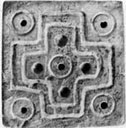 The + glyph of Sibri evidence is comparable to the large-sized 'dot', dotted circles and + glyph shown on this Mohenjo-daro seal m0352 with dotted circles repeated on 5 sides A to F. Mohenjo-daro Seal m0352 shows dotted circles in the four corners of a fire-altar and at the centre of the altar together with four raised 'bun' ingot-type rounded features.
The + glyph of Sibri evidence is comparable to the large-sized 'dot', dotted circles and + glyph shown on this Mohenjo-daro seal m0352 with dotted circles repeated on 5 sides A to F. Mohenjo-daro Seal m0352 shows dotted circles in the four corners of a fire-altar and at the centre of the altar together with four raised 'bun' ingot-type rounded features.

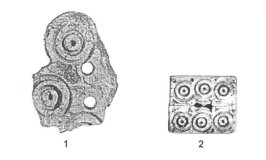 Artifacts from Jiroft.
Artifacts from Jiroft.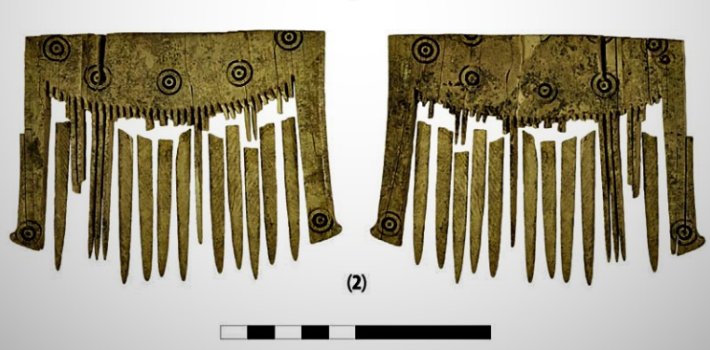
Ivory combs. Turkmenistan.
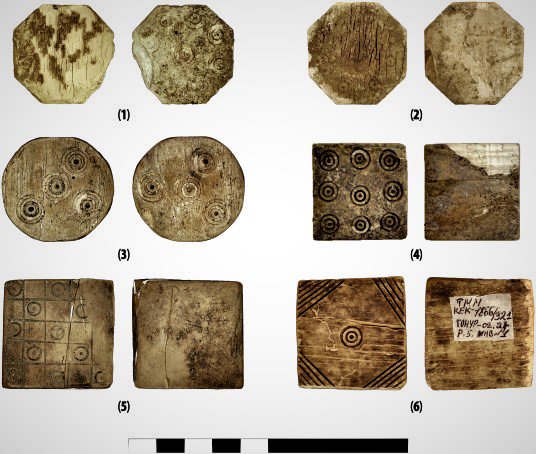
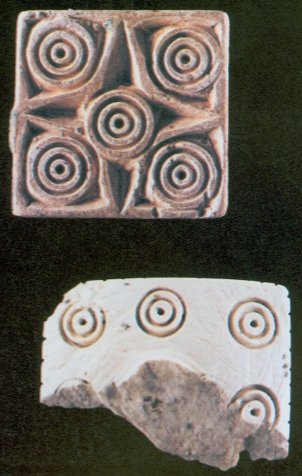
Ivory objects. Sarasvati Civilization
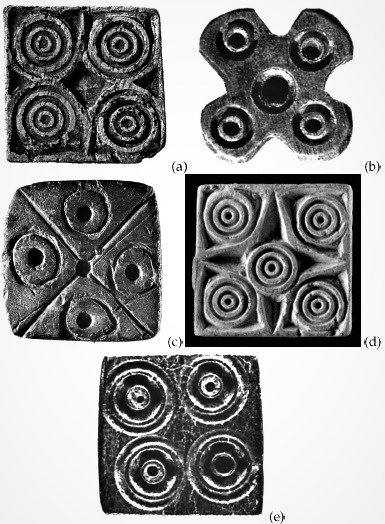
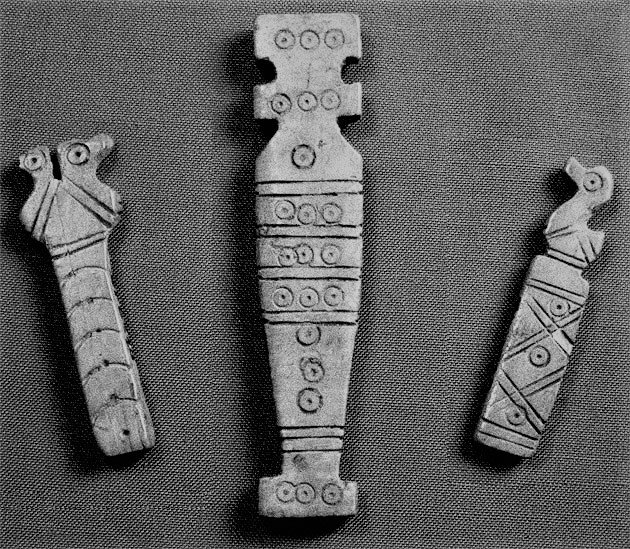
Tablets.Ivory objects. Mohenjo-daro.
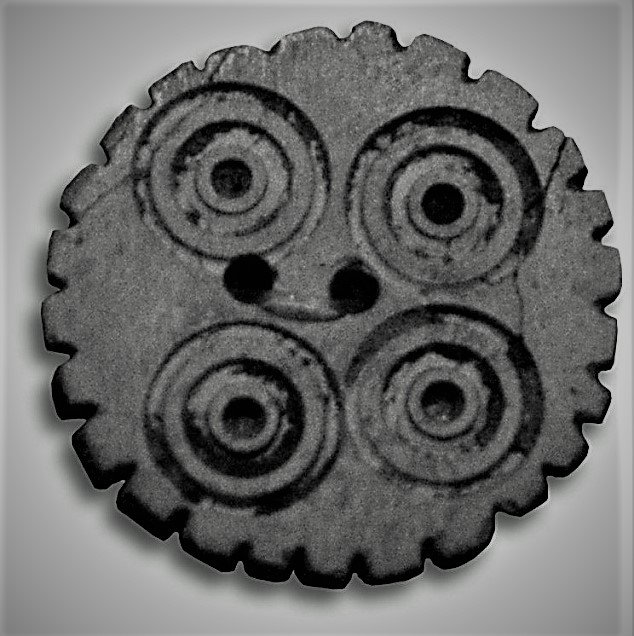
Button seal. Baror, Rajasthan.
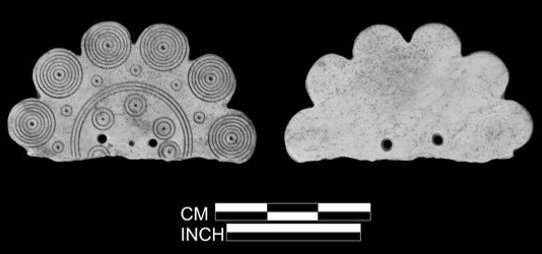
Button tablet. Harappa. Dotted circles.

தாயம் tāyam:Number one in the game of dice; கவறுருட்ட விழும் ஒன்று என்னும் எண். Colloq. (Tamil)
ஏர்த்தாயம் ēr-t-tāyam , n. < id. +. Ploughing in season; பருவகாலத்துழவு. (W.)காணித்தாயவழக்கு kāṇi-t-tāya-vaḻakku, n. < id. +. Dispute between coparceners about hereditary land; பங்காளிகளின் நிலவழக்கு. (J.)தர்மதாயம் tarma-tāyam , n. < id. + dāya. Charitable inams; தருமத்துக்கு விடப்பட்ட மானியம். (G. Sm. D. I, ii, 55.)தாயம் tāyam
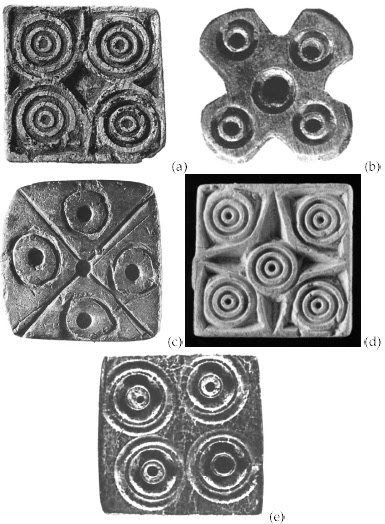
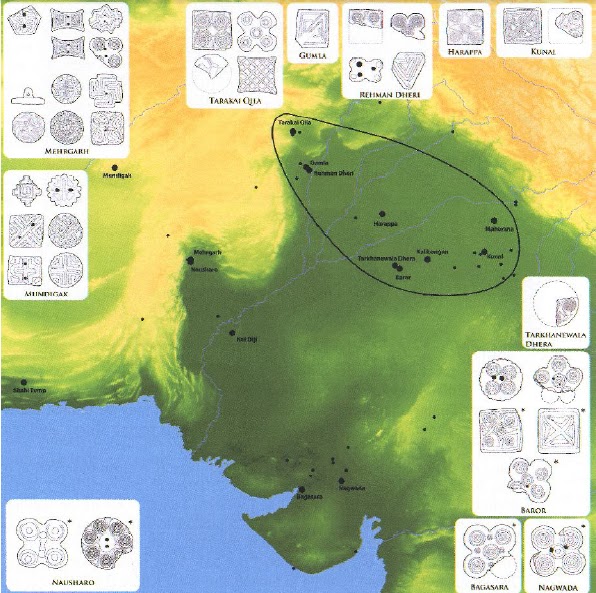

वट [p= 914,3] m. (perhaps Prakrit for वृत , " surrounded , covered " ; cf. न्यग्-रोध) the Banyan or Indian fig. tree (Ficus Indica) MBh.Ka1v. &c RTL. 337 (also said to be n.); a pawn (in chess) L. (Monier-Williams) Ta. vaṭam cable, large rope, cord, bowstring, strands of a garland, chains of a necklace; vaṭi rope; vaṭṭi (-pp-, -tt-) to tie. Ma. vaṭam rope, a rope of cowhide (in plough), dancing rope, thick rope for dragging timber. Ka. vaṭa, vaṭara, vaṭi string, rope, tie. Te. vaṭi rope, cord. Go. (Mu.) vaṭiya strong rope made of paddy straw (Voc. 3150). Cf. 3184 Ta. tār̤vaṭam. / Cf. Skt. vaṭa- string, rope, tie; vaṭāraka-, vaṭākara-, varāṭaka- cord,string; Turner, CDIAL, no. 11212. (CDIAL 5220)vaṭa2 ʻ string ʼ lex. [Prob. ← Drav. Tam. vaṭam, Kan. vaṭi, vaṭara, &c. DED 4268] N. bariyo ʻ cord, rope ʼ; Bi. barah ʻ rope working irrigation lever ʼ, barhā ʻ thick well -- rope ʼ, Mth. barahā ʻ rope ʼ. (CDIAL 11212).
See: https://tinyurl.com/y85goask Wealth of a nation...
Trefoil decorated bull; traces of red pigment remain inside the trefoils. Steatite statue fragment. Mohenjo-daro (Sd 767). After Ardeleanu-Jansen, 1989: 196, fig. 1; cf. Parpola, 1994, p. 213. Trefoils painted on steatite beads. Harappa (After Vats. Pl. CXXXIII, Fig. 2) Trefoil on the shawl of the priest. Mohenjodaro. The discovery of the King Priest acclaimed by Sir John Marshall as “the finest piece of statuary that has been found at Moenjodaro….draped in an elaborate shawl with corded or rolled over edge, worn over the left shoulder and under the right arm. This shawl is decorated all over with a design of trefoils in relief interspersed occasionally with small circles, the interiors of which are filled with a red pigment “. Gold fillet with ‘standard device’ hieroglyph. Glyph ‘hole’: pottar, பொத்தல் pottal, n. < id. [Ka.poṭṭare, Ma. pottu, Tu.potre.] trika, a group of three (Skt.) The occurrence of a three-fold depiction on a trefoil may thus be a phonetic determinant, a suffix to potṛ as in potṛka.
Role of dice in Bhāratīya Itihāsa, dotted circle Indus Script hypertexts on ivory game pieces of ANE miners and a tribute to Dennys Frenez, István Koncz and Zsuzsanna Tóth for their brilliant archaeological insights and riveting, logically argued archeo-metallurgical analyses.
![terracotta-dice-ashmolean-museum]()
![]()
![Image result for dice mohenjodaro one]() Mohenjo-daro (Ashmolean Museum), Harappa dice.. दाय 1 [p= 474,2] dāya n. game , play Pan5cad.; mfn. ( Pa1n2. 3-1 , 139 ; 141) giving , presenting (cf. शत- , गो-); m. handing over , delivery Mn. viii , 165 (Monier-Williams)
Mohenjo-daro (Ashmolean Museum), Harappa dice.. दाय 1 [p= 474,2] dāya n. game , play Pan5cad.; mfn. ( Pa1n2. 3-1 , 139 ; 141) giving , presenting (cf. शत- , गो-); m. handing over , delivery Mn. viii , 165 (Monier-Williams)
தாயம் tāyam :Number one in the game of dice; கவறுருட்ட விழும் ஒன்று என்னும் எண். Colloq. (Tamil)


 Mohenjo-daro (Ashmolean Museum), Harappa dice.. दाय 1 [p= 474,2] dāya n. game , play Pan5cad.; mfn. ( Pa1n2. 3-1 , 139 ; 141) giving , presenting (cf. शत- , गो-); m. handing over , delivery Mn. viii , 165 (Monier-Williams)
Mohenjo-daro (Ashmolean Museum), Harappa dice.. दाय 1 [p= 474,2] dāya n. game , play Pan5cad.; mfn. ( Pa1n2. 3-1 , 139 ; 141) giving , presenting (cf. शत- , गो-); m. handing over , delivery Mn. viii , 165 (Monier-Williams)தாயம் tāyam:Number one in the game of dice; கவறுருட்ட விழும் ஒன்று என்னும் எண். Colloq. (Tamil)
Dotted circles, tulips on ivory combs signify dāntā 'ivory' rebus dhāˊtu 'ore of red colour' (Rigveda) tagaraka 'tulip' rebus tagara 'tin'![]() Discovery of tin-bronzes was momentous in progressing the Bronze Age Revolution of 4th millennium BCE. This discovery created hard alloys combining copper and tin. This discovery was also complemented by the discovery of writing systems to trade in the newly-produced hard alloys.The discovery found substitute hard alloys, to overcome the scarcity of naturally occurring arsenical copper or arsenical bronzes. The early hieroglyph signifiers of tin and copper on an ivory comb made by Meluhha artisans & seafaring merchants point to the contributions made by Bhāratam Janam (RV), ca. 3300 BCE to produce tin-bronzes. The abiding significance of the 'dotted circle' is noted in the continued use on early Punch-marked coins. http://bharatkalyan97.blogspot.in/2016/10/vajra-six-angled-hypertext-of-punch.html Vajra षट्--कोण 'six-angled' hypertext of Punch-marked coins khambhaṛā 'fish-fin' rebus: kammaṭa 'mint'. A hypertext is orthographed with three arrows emanating from the dotted circle and three ‘twists’ emanating from the dotted circle, thus signifying six-armed semantic extensions. baṭa ‘six’ rebus:baṭa 'iron' bhaṭa ‘furnce’. kaṇḍa ‘arrow’ rebus: khaṇḍa ‘implements’ मेढा mēḍhā ‘twist’ rebus: meḍ ‘iron’ med ‘copper’ (Slavic languages) medha ‘yajna, dhanam, wealth’.
Discovery of tin-bronzes was momentous in progressing the Bronze Age Revolution of 4th millennium BCE. This discovery created hard alloys combining copper and tin. This discovery was also complemented by the discovery of writing systems to trade in the newly-produced hard alloys.The discovery found substitute hard alloys, to overcome the scarcity of naturally occurring arsenical copper or arsenical bronzes. The early hieroglyph signifiers of tin and copper on an ivory comb made by Meluhha artisans & seafaring merchants point to the contributions made by Bhāratam Janam (RV), ca. 3300 BCE to produce tin-bronzes. The abiding significance of the 'dotted circle' is noted in the continued use on early Punch-marked coins. http://bharatkalyan97.blogspot.in/2016/10/vajra-six-angled-hypertext-of-punch.html Vajra षट्--कोण 'six-angled' hypertext of Punch-marked coins khambhaṛā 'fish-fin' rebus: kammaṭa 'mint'. A hypertext is orthographed with three arrows emanating from the dotted circle and three ‘twists’ emanating from the dotted circle, thus signifying six-armed semantic extensions. baṭa ‘six’ rebus:baṭa 'iron' bhaṭa ‘furnce’. kaṇḍa ‘arrow’ rebus: khaṇḍa ‘implements’ मेढा mēḍhā ‘twist’ rebus: meḍ ‘iron’ med ‘copper’ (Slavic languages) medha ‘yajna, dhanam, wealth’.
Harappan male ornament styles. After Fig.6.7 in Kenoyer, JM, 1991, Ornament styles of the Indus valley tradition: evidence from recent excavations at Harappa, Pakistan in: Paleorient, vol. 17/2 -1991, p.93 Source: Marshall, 1931: Pl. CXVIII
http://a.harappa.com/sites/g/files/g65461/f/Kenoyer1992_Ornament%20Styles%20of%20the%20Indus%20Valley%20Tradition%20Ev.pdfClearly, the wearing a fillet on the shoulder and wearing a dress with trefoil hieroglyphs made the figure of some significance to the community.
"Inlaid bead. No. 53 (L445). (See also Pl. CLII,17) Steatite. An exceptionally fine bead. The interiors of the trefoils were probably filled in with either paste or colour. The former is the more probable, for in the base of each foil there is a small pitting that may been used for keying a coloured paste. The depth of the cutting is 0.05 inch. Level, 3 feet below surface. late Period. Found in Chamber 27, Block 4, L Area. The most interesting of these beads are those with the trefoil pattern, which also occurs on the robe worn by the statue pictured in Pl. XCVIII. The trefoils on both the beads and statue are irregular in shape and in this respect differ from the pattern as we ordinarily know it. (For another example of this ornamentation, see the bull illustrated in Jastrow, Civilization of Babylonia and Assyria, pl. liii, and the Sumerian bull from Warka shown in Evans, Palace of Minos, vol. ii, pt. 1, p.261, fig. 156. Sir Arthus Evans has justly compared the trefoil markings on this latter bull with the quatrefoil markings of Minoan 'rytons', and also with the star-crosses on Hathor's cow. Ibid., vol. i, p.513. Again, the same trefoil motif is perhaps represented on a painted sherd from Tchechme-Ali in the environs of Teheran. Mem. Del. en Perse, t.XX, p. 118, fig. 6)."(John Marshall, opcit., p.517)
Trefoil Decorated bead. Pl. CXLVI, 53 (Marshall, opcit.)
Hieroglyph-multiplex of dotted circles as 'beads': kandi 'bead' Rebus: kanda 'fire-altar' khaNDa 'metal implements'. Alternative: dotted circles as dice: dhāv, dāya 'one in dice' + vaṭṭa 'circle' rebus धावड dhāvaḍa 'red ferrite ore smelter'
Trefoil Hieroglyph-multiplex as three dotted circles: kolom 'three' Rebus: kole.l kanda 'temple fire-altar'. Alternative: kole.l धावड dhāvaḍa 'temple PLUS red ferrite ore smelter'.
(After Fig. 18.10 Parpola, 2015, p. 232) (a) Neo-Sumerian steatite bowl from Ur (U.239), bearing symbols of the sun, the moon (crucible), stars and trefoils (b) Fragmentary steatite statuette from Mohenjo-daro. After Ardeleanu-Jansen 1989-205, fig. 19 and 196, fig. 1a. koṭhārī ʻ
A finely polished pedestal. Dark red stone. Trefoils. (DK 4480, cf. Mackay 1938: I, 412 and II, pl. 107.35). National Museum, Karachi.
Hieroglyph: kolmo 'three' Rebus: kolimi 'smithy'; kolle 'blacksmith'; kole.l 'smithy, temple' (Kota) Trefoil Hieroglyph-multiplex as three dotted circles: kolom 'three' Rebus: kole.l kanda 'temple fire-altar'. Alternative: kole.l धावड dhāvaḍa 'temple PLUS red ferrite ore smelter'.
Trefoils painted on steatite beads, Harappa (After Vats, Pl. CXXXIII, Fig.2)![]() Late Harappan Period dish or lid with perforation at edge for hanging or attaching to large jar. It shows a Blackbuck antelope with trefoil design made of combined circle-and-dot motifs, possibly representing stars. It is associated with burial pottery of the Cemetery H period, dating after 1900 BC. Credit Harappa.com
Late Harappan Period dish or lid with perforation at edge for hanging or attaching to large jar. It shows a Blackbuck antelope with trefoil design made of combined circle-and-dot motifs, possibly representing stars. It is associated with burial pottery of the Cemetery H period, dating after 1900 BC. Credit Harappa.comHieroglyph markhor, ram: mēṇḍha2 m. ʻ ram ʼ, °aka -- , mēṇḍa -- 4, miṇḍha -- 2, °aka -- , mēṭha -- 2, mēṇḍhra -- , mēḍhra -- 2, °aka -- m. lex. 2. *mēṇṭha- (mēṭha -- m. lex.). 3. *mējjha -- . [r -- forms (which are not attested in NIA.) are due to further sanskritization of a loan -- word prob. of Austro -- as. origin (EWA ii 682 with lit.) and perh. related to the group s.v. bhēḍra -- ]1. Pa. meṇḍa -- m. ʻ ram ʼ, °aka -- ʻ made of a ram's horn (e.g. a bow) ʼ; Pk. meḍḍha -- , meṁḍha -- (°ḍhī -- f.), °ṁḍa -- , miṁḍha -- (°dhiā -- f.), °aga -- m. ʻ ram ʼ, Dm. Gaw. miṇ Kal.rumb. amŕn/aŕə ʻ sheep ʼ (a -- ?); Bshk. mināˊl ʻ ram ʼ; Tor. miṇḍ ʻ ram ʼ, miṇḍāˊl ʻ markhor ʼ; Chil. mindh*ll ʻ ram ʼ AO xviii 244 (dh!), Sv. yēṛo -- miṇ; Phal. miṇḍ, miṇ ʻ ram ʼ, miṇḍṓl m. ʻ yearling lamb, gimmer ʼ; P. mẽḍhā m.,°ḍhī f., ludh. mīḍḍhā, mī˜ḍhā m.; N. meṛho, meṛo ʻ ram for sacrifice ʼ; A. mersāg ʻ ram ʼ ( -- sāg < *chāgya -- ?), B. meṛā m., °ṛi f., Or. meṇḍhā, °ḍā m., °ḍhi f., H. meṛh, meṛhā, mẽḍhā m., G. mẽḍhɔ, M.mẽḍhā m., Si. mäḍayā.2. Pk. meṁṭhī -- f. ʻ sheep ʼ; H. meṭhā m. ʻ ram ʼ.3. H. mejhukā m. ʻ ram ʼ.A. also mer (phonet. mer) ʻ ram ʼ (CDIAL 10310). Rebus: mẽṛhẽt, meḍ 'iron' (Munda.Ho.)Trefoil Hieroglyph-multiplex as three dotted circles: kolom 'three' Rebus: kole.l kanda 'temple fire-altar'. Alternative: kole.l धावड dhāvaḍa 'temple PLUS red ferrite ore smelter'.![]() Trefoil inlay decorated on a bull calf. Uruk (W.16017) ca. 3000 BCE. kõdā 'young bull calf' Rebus: kõdā 'turner-joiner' (forge); kundaṇa 'fine gold'.
Trefoil inlay decorated on a bull calf. Uruk (W.16017) ca. 3000 BCE. kõdā 'young bull calf' Rebus: kõdā 'turner-joiner' (forge); kundaṇa 'fine gold'.
damkom = a bull calf (Santali) Rebus: damha = a fireplace; dumhe = to heap, to collect together (Santali)Trefoil Hieroglyph-multiplex as three dotted circles: kolom 'three' Rebus: kole.l kanda 'temple fire-altar'. Alternative: kole.l धावड dhāvaḍa 'temple PLUS red ferrite ore smelter'.
http://a.harappa.com/sites/g/files/g65461/f/Kenoyer1992_Ornament%20Styles%20of%20the%20Indus%20Valley%20Tradition%20Ev.pdf
"Inlaid bead. No. 53 (L445). (See also Pl. CLII,17) Steatite. An exceptionally fine bead. The interiors of the trefoils were probably filled in with either paste or colour. The former is the more probable, for in the base of each foil there is a small pitting that may been used for keying a coloured paste. The depth of the cutting is 0.05 inch. Level, 3 feet below surface. late Period. Found in Chamber 27, Block 4, L Area. The most interesting of these beads are those with the trefoil pattern, which also occurs on the robe worn by the statue pictured in Pl. XCVIII. The trefoils on both the beads and statue are irregular in shape and in this respect differ from the pattern as we ordinarily know it. (For another example of this ornamentation, see the bull illustrated in Jastrow, Civilization of Babylonia and Assyria, pl. liii, and the Sumerian bull from Warka shown in Evans, Palace of Minos, vol. ii, pt. 1, p.261, fig. 156. Sir Arthus Evans has justly compared the trefoil markings on this latter bull with the quatrefoil markings of Minoan 'rytons', and also with the star-crosses on Hathor's cow. Ibid., vol. i, p.513. Again, the same trefoil motif is perhaps represented on a painted sherd from Tchechme-Ali in the environs of Teheran. Mem. Del. en Perse, t.XX, p. 118, fig. 6)."(John Marshall, opcit., p.517)
Trefoil Decorated bead. Pl. CXLVI, 53 (Marshall, opcit.)
Hieroglyph-multiplex of dotted circles as 'beads': kandi 'bead' Rebus: kanda 'fire-altar' khaNDa 'metal implements'. Alternative: dotted circles as dice: dhāv, dāya 'one in dice' + vaṭṭa 'circle' rebus धावड dhāvaḍa 'red ferrite ore smelter'
 Late Harappan Period dish or lid with perforation at edge for hanging or attaching to large jar. It shows a Blackbuck antelope with trefoil design made of combined circle-and-dot motifs, possibly representing stars. It is associated with burial pottery of the Cemetery H period, dating after 1900 BC. Credit Harappa.com
Late Harappan Period dish or lid with perforation at edge for hanging or attaching to large jar. It shows a Blackbuck antelope with trefoil design made of combined circle-and-dot motifs, possibly representing stars. It is associated with burial pottery of the Cemetery H period, dating after 1900 BC. Credit Harappa.comHieroglyph markhor, ram: mēṇḍha2 m. ʻ ram ʼ, °aka -- , mēṇḍa -- 4, miṇḍha -- 2, °aka -- , mēṭha -- 2, mēṇḍhra -- , mēḍhra -- 2, °aka -- m. lex. 2. *mēṇṭha- (mēṭha -- m. lex.). 3. *mējjha -- . [r -- forms (which are not attested in NIA.) are due to further sanskritization of a loan -- word prob. of Austro -- as. origin (EWA ii 682 with lit.) and perh. related to the group s.v. bhēḍra -- ]1. Pa. meṇḍa -- m. ʻ ram ʼ, °aka -- ʻ made of a ram's horn (e.g. a bow) ʼ; Pk. meḍḍha -- , meṁḍha -- (°ḍhī -- f.), °ṁḍa -- , miṁḍha -- (°dhiā -- f.), °aga -- m. ʻ ram ʼ, Dm. Gaw. miṇ Kal.rumb. amŕn/aŕə ʻ sheep ʼ (a -- ?); Bshk. mināˊl ʻ ram ʼ; Tor. miṇḍ ʻ ram ʼ, miṇḍāˊl ʻ markhor ʼ; Chil. mindh*ll ʻ ram ʼ AO xviii 244 (dh!), Sv. yēṛo -- miṇ; Phal. miṇḍ, miṇ ʻ ram ʼ, miṇḍṓl m. ʻ yearling lamb, gimmer ʼ; P. mẽḍhā m.,°ḍhī f., ludh. mīḍḍhā, mī˜ḍhā m.; N. meṛho, meṛo ʻ ram for sacrifice ʼ; A. mersāg ʻ ram ʼ ( -- sāg < *chāgya -- ?), B. meṛā m., °ṛi f., Or. meṇḍhā, °ḍā m., °ḍhi f., H. meṛh, meṛhā, mẽḍhā m., G. mẽḍhɔ, M.mẽḍhā m., Si. mäḍayā.2. Pk. meṁṭhī -- f. ʻ sheep ʼ; H. meṭhā m. ʻ ram ʼ.3. H. mejhukā m. ʻ ram ʼ.A. also mer (phonet. mer) ʻ ram ʼ (CDIAL 10310). Rebus: mẽṛhẽt, meḍ 'iron' (Munda.Ho.)Trefoil Hieroglyph-multiplex as three dotted circles: kolom 'three' Rebus: kole.l kanda 'temple fire-altar'. Alternative: kole.l धावड dhāvaḍa 'temple PLUS red ferrite ore smelter'.a. Symmetry of tigers, scorpions, lizards (KK Hall, Catalogue of Egyptian scarabs in the British Museum, Royal scarabs, British Museum, London, 1902)
![]() b. Seal with lion and antelope; c. Two crocodiles, two scorpions. (J. Ward, 1902, The sacred beetle a popular treatise on Egyptian scarabs in art and history, John Murray, London, 1902).Two seals of the Egyptian Museum Collection, Torino with bilateral and rotational symmetries.
b. Seal with lion and antelope; c. Two crocodiles, two scorpions. (J. Ward, 1902, The sacred beetle a popular treatise on Egyptian scarabs in art and history, John Murray, London, 1902).Two seals of the Egyptian Museum Collection, Torino with bilateral and rotational symmetries.
From the Egyptian Museum of Torino. A cowroid seal with lentoid shape, like a cowrie shell. Dated to ca. 2200=2040 BCE.
Symmetries on seals parallel symmetries in patterns woven into textiles. Symmetries are orthographic rebus representations achieved by Indus Script Cipher with the underlying Meluhha words (of Indian sparchbund, 'speech union').Scarab is a representation of the image of a beetle. Scarabs are a gem hut, a common type of amulet, seal or ring bezel found in Egypt, Nubia and Syria from the 6th Dynasty until the Ptolemaih Period (2345-30 BC). The earliest were purely amulet and uninscribed: it was only during the Middle Kingdom (2055-1650 BC) that they were used as seals. The scarab seal is so called because it was made in the shape of the sacred scarab beetle (scarabaeus sacer), which was personified by Khepri, a sun god associated with resurrection. The flat underside of the scarab, carved in stone or moulded in faience or glass, was usually decorated with designs or inscriptions, sometimes incorporating a royal name. "Finely carved scarabs were used as seals; inscribed scarabs were issued to commemorate important events or buried with mummies. Lapis Luzauli was a mineral often used... Over the ages, they have been used to symbolise wealth, used as currency, fashion accessory and also to serve as a form of artistic expression. Precious metals and stones were used from very earl ages as a sign of wealth and opulence. Royalty have always used Scarabs as a means for securing and consolidating wealth and even to the present day, some of the most precious pieces of jewelry are antiques. Royal jewels rank among the most expensive and luxurious assets of all times. " https://www.gemrockauctions.com/fr/learn/did-you-know/what-is-the-meaning-of-scarab
![Related image]()
![Image result for scarabs]()
Stamp seal. Dilmun. http://www.uaeinteract.com Mirror symmetry is achieved in two parts flanking the crucible+Sun pictograph. The antelope looking backward is clearly influenced by the Indus Script orthography. Four of two pairs of almost identical aquatic birds are shown.
“One of the biggest surprises of the excavations at Saar has been the enormous amount of glyptic material present. We have now more than 80 round stamp seals made of chlorite steatite and 300-400 fragments of seal impressions, all in the local Early Dilmun style…The seals were apparently mainly used for economic purposes, implying that much of the Saar population was actively engaged in the exchange of goods, and perhaps in their manufacture. Because all the seals and seal impressions are in the native Early Dilmun style, it also shows that most of the commerce for which we have evidence was taking place within the Dilmun polity itself. The limited range of foreign goods for which we have evidence were probably redistributed from their port of entry.” -- Harriet Crawford (1997, ibid.)
The earliest evidence of impressing carved stones into clay to seal containers is from Syria dated to 7th millennium BCE.During the Ubaid period, designs of geometric forms expanded to include animals and human images, snakes and birds.Stamp seal from the region North Syria, Iraq (image redrawn from M. Schoyen, Seals, at www.schoyencollection.com/index.html), dated 5th-4thmillennium BCE. A standing male figure is seen between two horned quadrupeds back to back and head to tail. The rotational symmetry of the animals is two-fold.![]() Stamp seal from Susa (image redrawn from www.hindunet.org/hindu_history/sarasvati/lapis_lazuli.htm, at the Louvre Museum). Susa is the oldest known settlement of the world, founded ca. 4200 BCE; inhabited villages of Susa have been dated to 7000 BCE. The seal depicts two goat-antelopes head to tail, and an oval at the centre. The two antelopes seem to be running on the rim of the seal. (http://www.ijSciences.com Intl Journal of Sciences, Volume 2, Issue August 2013.)
Stamp seal from Susa (image redrawn from www.hindunet.org/hindu_history/sarasvati/lapis_lazuli.htm, at the Louvre Museum). Susa is the oldest known settlement of the world, founded ca. 4200 BCE; inhabited villages of Susa have been dated to 7000 BCE. The seal depicts two goat-antelopes head to tail, and an oval at the centre. The two antelopes seem to be running on the rim of the seal. (http://www.ijSciences.com Intl Journal of Sciences, Volume 2, Issue August 2013.)


Indus writing in ancient Near East (Failaka seal readings)
Dotted circles and three lines on the obverse of many Failaka/Dilmun seals are read rebus as hieroglyphs:
![]()
A (गोटा) gōṭā Spherical or spheroidal, pebble-form. (Marathi) Rebus: khoṭā ʻalloyedʼ (metal) (Marathi) खोट [khōṭa] f A mass of metal (unwrought or of old metal melted down); an ingot or wedge (Marathi). P. khoṭ m. ʻalloyʼ (CDIAL 3931)
kolom ‘three’ (Mu.) Rebus: kolami ‘furnace, smithy’ (Telugu)
Thus, the seals are intended to serve as metalware catalogs from the smithy/forge. Details of the alloyed metalware are provided by the hieroglyphs of Indus writing on the reverse of the seal.
![]() Composition of two horned animals, sitting human playing a four-string musical instrument, a star and a moon.
Composition of two horned animals, sitting human playing a four-string musical instrument, a star and a moon.
The rebus reading of hieroglyphs are: తంబుర [tambura] or తంబురా tambura. [Tel. తంతి +బుర్ర .] n. A kind of stringed instrument like the guitar. A tambourine. Rebus: tam(b)ra 'copper' tambabica, copper-ore stones; samṛobica, stones containing gold (Mundari.lex.) tagara 'antelope'. Rebus 1: tagara 'tin' (ore) tagromi 'tin, metal alloy' (Kuwi) Rebus 2: damgar 'merchant'.
Thus the seal connotes a merchant of tin and copper.
![]() Inventory No. 8480. A seal from Dilmun, A seal from Dilmun, made of soft stone, classified as the 3rd largest seal in Failaka Island, decorated with human and zoomorphic figures. 0.16 X 4.8 cm. Site: the Ruler's Palace. 2nd millennium BCE, Dilmun civilization [NOTE: Many such seals of Failaka and Dilmun have been read rebus as Indus writing on blogposts.]
Inventory No. 8480. A seal from Dilmun, A seal from Dilmun, made of soft stone, classified as the 3rd largest seal in Failaka Island, decorated with human and zoomorphic figures. 0.16 X 4.8 cm. Site: the Ruler's Palace. 2nd millennium BCE, Dilmun civilization [NOTE: Many such seals of Failaka and Dilmun have been read rebus as Indus writing on blogposts.]
Hieroglyphs on this Dilmun seal are: star, tabernae montana flower, cock, two divided squares, two bulls, antelope, sprout (paddy plant), drinking (straw), stool, twig or tree branch. A person with upraised arm in front of the antelope. All these hieroglyphs are read rebus using lexemes (Meluhha, Mleccha) of Indiansprachbund.
meḍha ‘polar star’ (Marathi). Rebus: meḍ ‘iron’ (Ho.Mu.)
ṭagara (tagara) fragrant wood (Pkt.Skt.).tagara 'antelope'. Rebus 1: tagara 'tin' (ore) tagromi 'tin, metal alloy' (Kuwi) Rebus 2: damgar 'merchant'
kuṭi (-pp-, -tt-) to drink, inhale. Rebus: kuṭhi ‘smelting furnace’ (Santali)
ḍangar ‘bull’; rebus: ḍangar ‘blacksmith’ (Hindi) dula 'pair' (Kashmiri). Rebus: dul 'cast metal' (Santali) Thus, a pair of bulls connote 'cast metal blacksmith'.
khaṇḍ ‘field, division’ (Skt.) Rebus 1: Ga. (Oll.) kanḍ, (S.) kanḍu (pl. kanḍkil) stone (ore). Rebus 2: kaṇḍ 'fire-altar' (Santali) Thus, the two divided squares connote furnace for stone (ore).
kolmo ‘paddy plant’ (Santali) Rebus: kolami ‘furnace, smithy’ (Telugu)
Kur. kaṇḍō a stool. Rebus: kaṇḍ 'fire-altar' (Santali)
Tu. aḍaru twig. Rebus: aduru 'native (unsmelted) metal' (Kannada) Alternative reading: కండె [kaṇḍe] kaṇḍe. [Tel.] n. A head or ear of millet or maize. Rebus 1: kaṇḍ 'fire-altar' (Santali) Rebus 2: khānḍa ‘tools, pots and pans, metal-ware’.
eraka ‘upraised arm’ (Te.); eraka ‘copper’ (Te.)
Thus, the Dilmun seal is a metalware catalog of damgar 'merchant' dealing with copper and tin.
The two divided squares attached to the straws of two vases in the following seal can also be read as hieroglyphs:
khaṇḍ ‘field, division’ (Skt.) Rebus 1: Ga. (Oll.) kanḍ, (S.) kanḍu (pl. kanḍkil) stone (ore). Rebus 2: kaṇḍ 'fire-altar' (Santali) Thus, the two divided squares connote furnace for stone (ore).
kuṭi (-pp-, -tt-) to drink, inhale. Rebus: kuṭhi ‘smelting furnace’ (Santali)
ḍangā = small country boat, dug-out canoe (Or.); ḍõgā trough, canoe, ladle (H.)(CDIAL 5568). Rebus: ḍānro term of contempt for a blacksmith (N.); ḍangar (H.) (CDIAL 5524)
Thus, a smelting furnace for stone (ore) is connoted by the seal of a blacksmith, ḍangar :
Stamp seal with a boat scene. Steatite. L. 2 cm. Gulf regio, Failaka, F6 758. Early Dilmun, ca. 2000-1800 BCE. Ntional Council for Culture, Arts and Letters, Kuwait National Museum, 1129 ADY. The subject is a nude male figure standing in the middle of a flat-bottomed boat, facing right. The man's arms are bent at the elbow, perpendicular to his torso. Beside him are two jars stand on the deck of the boat, each containing a long pole to which is attached a hatched square that perhaps represents a banner. Six square stamp seals from Failaka have been published...It is unlikely that the hatched squares represent sails, since the poles to which they are attached emerge from vases. The two diagonal lines on the body of the boat may represent the reed bundles from which these craft were buit. See Kjaerum 1983, seal nos. 192, 234, 254, 266, 335, 367. Source: Source: Joan Aruz et al., 2003, Art of the First cities: the third millennium BCE from the Mediterranean to the Indus, New York, Metropolitan Museum of Art (Pages 320, 322).See also: http://ancientworldonline.blogspot.in/2012/10/kuwaiti-slovak-archaeological-mission.html
Similar readings are suggested for all hieroglyphs on Failaka seals treating them as evidences of Indus writing in ancient Near East. The suggested rebus readings for specific hieroglyphs of Failaka seals (akin to Dilmun seal readings) are listed in the following section.
Note: What is shown like the phase of a moon may not denote a moon but the shape of a bun-ingot. ḍabu ‘an iron spoon’ (Santali) Rebus: ḍab, ḍhimba, ḍhompo ‘lump (ingot?)’. Alternative reading: mū̃h 'ingot'. Read together with the polar star, the rebus reading is: meḍ mū̃h 'iron ingot'. [meḍha ‘polar star’ (Marathi). meḍ ‘iron’ (Ho.Mu.)] The antelope + divided square is read rebus: eraka tagara kaṇḍ 'tin furnace' (merchant, damgar). The upraised arm indicates eraka 'copper': eraka ‘upraised arm’ (Telugu); eraka ‘copper’ (Telugu) Thus, the seal denotes a merchant dealing in iron, tin and copper ingots.
Rebus readings of hieroglyphs on Failaka seals (akin to Dilmun seal readings):
తంబుర [tambura] or తంబురా tambura. [Tel. తంతి +బుర్ర .] n. A kind of stringed instrument like the guitar. A tambourine. Rebus: tam(b)ra 'copper' tambabica, copper-ore stones; samṛobica, stones containing gold (Mundari.lex.)
Skt. kuṭī- intoxicating liquor. Ta. kuṭi (-pp-, -tt-) to drink, inhale; n. drinking, beverage (DEDR 1654). Rebus: kuṭhi‘smelting furnace’.
kolmo ‘paddy plant’ (Santali); kolom = cutting, graft; to graft, engraft, prune; kolma hoṛo = a variety of the paddy plant (Desi)(Santali.) kolom ‘three’ (Mu.) Rebus: kolami ‘furnace, smithy’ (Telugu)
khaṇḍ ‘field, division’ (Skt.) Rebus: Ga. (Oll.) kanḍ, (S.) kanḍu (pl. kanḍkil) stone (DEDR 1298). खडा (Marathi) is ‘metal, nodule, stone, lump’. kaṇi ‘stone’ (Kannada) with Tadbhava khaḍu. khaḍu, kaṇ ‘stone/nodule (metal)’. Rebus: khaṇḍaran, khaṇḍrun ‘pit furnace’ (Santali) kaṇḍ ‘furnace’ (Skt.) लोहकारकन्दुः f. a blacksmith's smelting furnace (Grierson Kashmiri lex.) [khaṇḍa] A piece, bit, fragment, portion.(Marathi) Rebus: khānḍa ‘tools, pots and pans, metal-ware’.
Allographs: Kur. kaṇḍō a stool. Malt. kanḍo stool, seat. (DEDR 1179) खंड [ khaṇḍa ] A piece, bit, fragment, portion.(Marathi) khaṇḍ ‘ivory’ (H.) jaṇḍ khaṇḍ = ivory (Jaṭkī) khaṇḍ ī = ivory in rough (Jaṭkī) kandhi = a lump, a piece (Santali.lex.) kandi (pl. -l) beads, necklace (Pa.); kanti (pl. -l) bead, (pl.) necklace; kandit. bead (Ga.)(DEDR 1215).
Ta. kaṇ eye, aperture, orifice, star of a peacock's tail. (DEDR 1159a) Rebus ‘brazier, bell-metal worker’: கன்னான் kaṉṉāṉ , n. < கன்¹. [M. kannān.] Brazier, bell-metal worker, one of the divisions of the Kammāḷa caste; செம்புகொட்டி. (திவா.) కండె [ kaṇḍe ] kaṇḍe. [Tel.] n. A head or ear of millet or maize. జొన్నకంకి (Telugu) kã̄ṛ ʻstack of stalks of large milletʼ(Maithili) kã̄ḍ 2 काँड् m. a section, part in general; a cluster, bundle, multitude (Śiv. 32). kã̄ḍ 1 काँड् । काण्डः m. the stalk or stem of a reed, grass, or the like, straw. In the compound with dan 5 (p. 221a, l. 13) the word is spelt kāḍ.
Ka. (Hav.) aḍaru twig; (Bark.) aḍïrï small and thin branch of a tree; (Gowda) aḍəri small branches. Tu. aḍaru twig.(DEDR 67) Rebus: aduru gan.iyinda tegadu karagade iruva aduru = ore taken from the mine and not subjected to melting in a furnace (Ka. Siddhānti Subrahmaṇya’ Śastri’s new interpretation of the AmarakoŚa, Bangalore, Vicaradarpana Press, 1872, p.330).
meḍha ‘polar star’ (Marathi). meḍ ‘iron’ (Ho.Mu.) Allograph: meḍh ‘ram’.
satthiya ‘svastika glyph’; rebus: satthiya ‘pewter’.
Skt. kuṭī- intoxicating liquor. (DEDR 1654) Ta. kuṭi (-pp-, -tt-) to drink, inhale; n. drinking, beverage,drunkenness; kuṭiyaṉ drunkard. Rebus: kuṭi= smelter furnace (Santali)
gaṇḍ 'four'. kaṇḍ 'bit'. Rebus: kaṇḍ 'fire-altar'. kolmo 'three'. Rebus: kolami 'smithy, forge'.
tagara 'antelope'; rebus 1: tagara 'tin'; rebus 2: tamkāru, damgar 'merchant' (Akkadian)
The bamboo-shoot is tã̄bā read rebus: tamba 'copper'.
B. Or. bichā 'scorpion', Mth. bīch (CDIAL 12081) Rebus: meṛed-bica = iron stone ore, in contrast to bali-bica, iron sand ore (Mu.lex.) bica, bica-diri (Sad. bicā; Or. bicī) stone ore; meṛeḍ bica, stones containing iron; tambabica, copper-ore stones; samṛobica, stones containing gold (Mundari.lex.)
kamḍa, khamḍa 'copulation' (Santali) Rebus:kaṇḍ ‘furnace, fire altar, consecrated fire’.
mūxā ‘frog’. Rebus: mũh ‘(copper) ingot’ (Santali) mũhã̄ = the quantity of iron produced at one time in a native smelting furnace of the Kolhes; iron produced by the Kolhes and formed like a four-cornered piece a little pointed at each end (Santali) Allographs: mũhe ‘face’ (Santali) मोख [ mōkha ] . Add:--3 Sprout or shoot. (Marathi) Kuwi (Su.) mṛogla shoot of bamboo; (P.) moko sprout (DEDR 4997) Tu. mugiyuni to close, contract, shut up; muguru sprout, shoot, bud; tender, delicate; muguruni, mukuruni to bud, sprout; muggè, moggè flower-bud, germ; (BRR; Bhattacharya, non-brahmin informant) mukkè bud. Kor. (O.) mūke flower-bud. (DEDR 4893)
pajhar. = to sprout from a root (Santali) Rebus: pasra ‘smithy’ (Santali)
ḍangar ‘bull’; rebus: ḍangar ‘blacksmith’ (Hindi)
ḍumgara ‘mountain’ (Pkt.)(CDIAL 5423). Rebus: damgar ‘merchant’.
kangha (IL 1333) kãgherā comb-maker (H.) Rebus: kangar ‘portable furnace’
गोदा [ gōdā ] m A circular brand or mark made by actual cautery (Marathi) गोटा [ gōṭā ] m A roundish stone or pebble. 2 A marble (of stone, lac, wood &c.) 2 A marble. 3 A large lifting stone. Used in trials of strength among the Athletæ. 4 A stone in temples described at length underउचला 5 fig. A term for a round, fleshy, well-filled body. 6 A lump of silver: as obtained by melting down lace or fringe. गोटुळा or गोटोळा [ gōṭuḷā or gōṭōḷā ] a (गोटा) Spherical or spheroidal, pebble-form. (Marathi) Allographs: Ta. kōṭu (in cpds. kōṭṭu-) horn, tusk, branch of tree, cluster, bunch, coil of hair, line, diagram, bank of stream or pool (DEDR 2200) Koḍ. ko·ḷi fowl. Tu. kōri, (B-K. also) kōḷi id. Te. kōḍi id. Nk. (Ch.) gogoḍi, gogoṛi cock (< Go.). Go. (Tr.) gōgōṛi, (Ph.)gugoṛī, (Y.) ghogṛi, (Mu. Ma. S. Ko.) gogoṛ id. (Voc. 1184). Cf. Apabhraṃśa (Jasaharacariu) koḍi- id., fowl. (DEDR 2248). Rebus: khoṭ ‘alloy’ (Marathi). खोट [ khōṭa ] f A mass of metal (unwrought or of old metal melted down); an ingot or wedge (Marathi). P. khoṭ m. ʻalloyʼ M.khoṭā ʻalloyedʼ, (CDIAL 3931) Rebus: khoṭ ‘alloy’ (Marathi). खोट [ khōṭa ] f A mass of metal (unwrought or of old metal melted down); an ingot or wedge (Marathi). P. khoṭ m. ʻalloyʼ M.khoṭā ʻalloyedʼ, (CDIAL 3931)
தமரூசி tamar-ūci, n. < தமர்² +. 1. See தமர்², 2. 2. Bits of a brace; தமரில் மாட்டும் ஆணி. தமர்² tamar , n. [M. tamar.] 1. Hole, as in a plank, commonly bored or cut; கருவியால் அமைத்த துளை. தமரிடு கருவியாம் (திருவிளை. மாணிக்க. 61). 2. Gimlet, spring awl, boring instrument; துளையிடுங் கருவி. Ta. tamar hole in a plank, commonly bored or cut; gimlet, spring awl, boring instrument; tavar (-v-, -nt-) to bore a hole; n. hole in a board. Ma. tamar hole made by a gimlet; a borer, gimlet, drill. ? Ko. tav- (tavd-) to butt with both horns, gore. Tu. tamirů gimlet. Te. tamire, (VPK) tagire the pin in the middle of a yoke. (DEDR 3078) āˊrā f. ʻ shoemaker's awl ʼ RV. Pa. Pk. ārā -- f. ʻ awl ʼ; Ash. arċūˊċ ʻ needle ʼ; K. örü f. ʻ shoemaker's awl ʼ, S. āra f., L. ār f.; P. ār f. ʻ awl, point of a goad ʼ; N. āro ʻ awl ʼ; A. āl ʻ sharp point, spur ʼ; B. ārā ʻ awl ʼ, Or. āra, āri, Bi. ār, araī, aruā, (Patna) arauā ʻ spike at the end of a driving stick ʼ, Mth. aruā, (SETirhut) ār ʻ cobbler's awl ʼ; H. ār f. ʻ awl, goad ʼ, ārī f. ʻ awl ʼ, araī ʻ goad ʼ, ārā m. ʻ shoemaker's awl or knife ʼ; G. M. ār f. ʻ pointed iron spike ʼ; M. ārī, arī ʻ cobbler's awl ʼ.Addenda: āˊrā -- : S.kcch. ār f. ʻpointed iron spikeʼ.(CDIAL 1313) Rebus: ताम्रिकः A brazier coppersmith (Sanskrit)
ayo ‘fish’(Mu.); ayas ‘iron’ (Skt.) Rebus: ayas ‘metal’
ḍato ‘claws or pincers (chelae) of crabs’; ḍaṭom, ḍiṭom to seize with the claws or pincers, as crabs, scorpions; ḍaṭkop = to pinch, nip (only of crabs) (Santali) Rebus: dhātu ‘mineral’ (Vedic); dhatu ‘a mineral, metal’ (Santali)
Allographs:1. aru m. ʻ sun ʼ lex. Kho. yor Morgenstierne NTS ii 276 with ? <-> Whence y -- ? (CDIAL 612)2. aru(m), eru(m), harum "branch, frond " of date palm (Akkadian) Akkadian aru/eru may be equivalent of the Hebrew 'rh 'eagle'. The concise dictionary of Akkadian (Jeremy A. Black, 2000) notes: eru, aru, also ru 'eagle'. aru 'granary, storehouse' OA, jB lex. aru(m) 'warrior'.
Rebus: eraka, era, er-a = syn. erka, copper, weapons (Ka.) eruvai ‘copper’ (Ta.); ere dark red (Ka.)(DEDR 446). eraka, er-aka = any metal infusion (Ka.Tu.) Tu. eraka molten, cast (as metal); eraguni to melt (DEDR 866)
Ta. kara-tāḷam palmyra palm. Ka. kara-tāḷa fan-palm, Corypha umbraculifera Lin. Tu. karatāḷa cadjan. Te. (B.) kara-tāḷamu the small-leaved palm tree.(DEDR 1270). karukku teeth of a saw or sickle, jagged edge of palmyra leaf-stalk, sharpness (Ta.) Ka. garasu. / Cf. Skt. karaṭa- a low, unruly, difficult person; karkara- hard, firm; karkaśa- rough, harsh, hard; krakaca-, karapattra- saw; khara- hard, harsh, rough, sharp-edged; kharu- harsh, cruel; Pali kakaca- saw; khara- rough; saw; Pkt.karakaya- saw; Apabhraṃśa (Jasaharacariu) karaḍa- hard. Cf. esp. Turner, CDIAL, no. 2819. Cf. also Skt. karavāla- sword (for second element, cf. 5376 Ta. vāḷ). (DEDR 1265) Allograph: Ta. karaṭi, karuṭi, keruṭi fencing, school or gymnasium where wrestling and fencing are taught. Ka. garaḍi, garuḍi fencing school. Tu.garaḍi, garoḍi id. Te. gariḍi, gariḍī id., fencing.(DEDR 1262)
Ko. meṭ- (mec-) to trample on, tread on; meṭ sole of foot, footstep, footprint (DEDR 5057). Allograph: meḍ ‘dance’ (Santali). mēḍamu. A fight, battle, యుద్ధము. మేడము పొడుచు mēdamu-poḍuṭsu. v. n. To fight a battle. M. meḍhā m. ʻ curl, snarl, twist or tangle in cord or thread ʼ (CDIAL 10312) మేడెము [ mēḍemu ] or మేడియము mēḍemu. [Tel.] n. A spear or dagger. ఈటె, బాకు. mēḍha The polar star. (Marathi) Rebus: meḍ, mẽṛhẽt 'iron'(Mu.Ho.)
ḍabe, ḍabea ‘large horns, with a sweeping upward curve, applied to buffaloes’ (Santali) Rebus: ḍab, ḍhimba, ḍhompo ‘lump (ingot?)’, clot, make a lump or clot, coagulate, fuse, melt together (Santali)
See:http://bharatkalyan97.blogspot.in/2013/05/indus-writing-on-gold-disc-kuwait.html Indus writing on gold disc, Kuwait Museum al-Sabah collection: An Indus metalware cataloghttp://bharatkalyan97.blogspot.in/2013/05/see-httpbharatkalyan97.html Indus writing in ancient Near East (Dilmun seal readings)
Stamp seal with figures and animals. Steatite. Early Dilmun, ca. 2000-1800 BCE. Dia. 2.9 cm. Gulf region, Bahrain, Karrana, Bahrain National Museum, Manama![]() Designs of stamp seals from Al-Khidr are composed of characteristic Early Dilmun stamp seal motifs. This stamp seal depicts human and half-human-half-animal horned figures, monkeys, serpents and birds on either side of a central motif of a standard and a podium at the bottom (drawing of stamp seal impression).
Designs of stamp seals from Al-Khidr are composed of characteristic Early Dilmun stamp seal motifs. This stamp seal depicts human and half-human-half-animal horned figures, monkeys, serpents and birds on either side of a central motif of a standard and a podium at the bottom (drawing of stamp seal impression).![]() On the obverse of Dilmun seals from Al-Khidr are depicted human or divine figures, half human-half animal creatures, animal figures (such as gazelles, bulls, scorpions, and snakes), celestial bodies (star or sun and moon), sometimes drinking scenes and also other activities (playing musical instruments). Composition of these motifs varies from formal (with ordering the figures and symbols to clear scenes) to chaotic.
On the obverse of Dilmun seals from Al-Khidr are depicted human or divine figures, half human-half animal creatures, animal figures (such as gazelles, bulls, scorpions, and snakes), celestial bodies (star or sun and moon), sometimes drinking scenes and also other activities (playing musical instruments). Composition of these motifs varies from formal (with ordering the figures and symbols to clear scenes) to chaotic. ![]()
![]()
![]() Seals with rotating designs usually bear pure plant, animal or geometric motifs.
Seals with rotating designs usually bear pure plant, animal or geometric motifs.
![]() Until now only one single seaal has been discovered (in 2004) which comes from a non-Dilmun cultural environment. It is a cylinder seal with a cuneiform inscription that refers to "Ab-gina, sailor from a huge ship, the son of Ur-Abba" (F. Rahman). This seal provides further evidence of the existing contacts between Dilmun and ancient Mesopotamia at the end of the 3rd- beginning of the 2nd millennium BCE.
Until now only one single seaal has been discovered (in 2004) which comes from a non-Dilmun cultural environment. It is a cylinder seal with a cuneiform inscription that refers to "Ab-gina, sailor from a huge ship, the son of Ur-Abba" (F. Rahman). This seal provides further evidence of the existing contacts between Dilmun and ancient Mesopotamia at the end of the 3rd- beginning of the 2nd millennium BCE.
![]() A minor fragment of a globularly shaped metal sheet may represent a fragment of a vessel.
A minor fragment of a globularly shaped metal sheet may represent a fragment of a vessel. ![]() Blades are technologically more demanding than awls and fish-hooks. A few complete pieces and some major fragments seem to represent knives and perhaps razors.
Blades are technologically more demanding than awls and fish-hooks. A few complete pieces and some major fragments seem to represent knives and perhaps razors.![]() Metal awls are made from thin copper rods of circular or rectangular section. Most of them have both ends pointed. A handful of pieces have simple handles from bird and mammal bones. These awls may have been used for various purposes. Large amounts of shells at the site may indicate that the awls could have served to open and take out the flesh from the shells of bivalves and gastropods.
Metal awls are made from thin copper rods of circular or rectangular section. Most of them have both ends pointed. A handful of pieces have simple handles from bird and mammal bones. These awls may have been used for various purposes. Large amounts of shells at the site may indicate that the awls could have served to open and take out the flesh from the shells of bivalves and gastropods.
![]() Two tanged arrowheads have been found.
Two tanged arrowheads have been found. ![]() From among other utensils, needles with eyes and a pair of tweezers have been uncovered.
From among other utensils, needles with eyes and a pair of tweezers have been uncovered. ![]() Collection of copper fish-hooks.
Collection of copper fish-hooks.![]() Besides vessels, steatite was used for the production of stamp seals and small personal ornaments (pendants). Sherds of broken vessels were further used also as tools (e.g. polishers).
Besides vessels, steatite was used for the production of stamp seals and small personal ornaments (pendants). Sherds of broken vessels were further used also as tools (e.g. polishers).![]()
![]() Typical globular bowl with incised decoration (dotted-circles).
Typical globular bowl with incised decoration (dotted-circles).![]() Small carnelian bead (pointing to link with Gujarat as the possible source of carnelian).
Small carnelian bead (pointing to link with Gujarat as the possible source of carnelian).![]() Net sinker (left) and limestone lid (above). The local limestone was also used for the production of working slabs, grinders and grindstones (below).Pearls were recovered from heavy residue fractions of the soil samples processed by water flotation. They almost exclusively occur in contexts dominated by mother-of-pearl shells.
Net sinker (left) and limestone lid (above). The local limestone was also used for the production of working slabs, grinders and grindstones (below).Pearls were recovered from heavy residue fractions of the soil samples processed by water flotation. They almost exclusively occur in contexts dominated by mother-of-pearl shells.![]() Stamp seal cut from shell nacre layers (above). Pendant made from a strombus shell (left). Semi-product made from an oyster shell (right).
Stamp seal cut from shell nacre layers (above). Pendant made from a strombus shell (left). Semi-product made from an oyster shell (right).
Source. http://www.kuwaitarchaeology.org/gallery/al-khidr-finds-2.html Kuwaiti-Slovak Archaeological Mission
Failaka Island is located approximately 20 km northeast of Kuwait City. The island has a shallow surface measuring 12 km in length and 6 km width. The island proved to be an ideal location for human settlements, because of the wealth of natural resources, including harbours, fresh water, and fertile soil. It was also a strategic maritime commercial route that linked the northern side of the Gulf to the southern side. Studies show that traces of human settlement can be found on Failaka dating back to as early as the end of the 3rd millennium BC and extended through most of the 20th century CE.
Failaka was first known as Agarum, the land of Enzak, the great god of Dilmun civilisation according to Sumerian cuneiform texts found on the island. Dilmun was the leading commercial hub for its powerful neighbours in their need to exchange processed goods for raw materials. Sailing the Arabian Gulf was by far the most convenient trade route at a time as transportation over land meant a much longer and more hazardous journey. As part of Dilmun, Failaka became a hub for the activities which radiated around Dilmun (Bahrain) from the end of the 3rd millennium to the mid-1st millennium BCE.
The cities of Sumer in Mesopotamia, the Harappan people from the Indus Valley, the inhabitants of Magan and the Iranian hinterland have left many archaeological traces of their encounters on Failaka Island. More speculative is the ongoing debate among academics on whether Failaka might be the mythical Eden: the place where Sumerian hero Gilgamesh almost unraveled the secret of immortality; the paradise later described in the Bible.
As a result of changes in the balance of political powers in the region towards the end of the 2nd millennium BCE and beginning of 1st millennium BCE, the importance of Failaka began to decline.
Studies indicate that Alexander the Great received reports from missions sent to explore the Arabian shoreline of the Gulf. The reports referenced two islands, one located approximately 120 stadia (almost 19 km) from an estuary; the second island located a complete day and night sailing journey with proper climate conditions. As the historian Aryan stated, “Alexander the Great ordered that the nearer island be named “Ikaros” (now Failaka) and the distant island as “Tylos” (now the Kingdom of Bahrain). Ikaros was described by the explorers as an island covered with rich vegetation and a shelter for numerous wild animals, considered sacred by the inhabitants who dedicate them to their local goddess.
After the collapse of the great empires in western Asia (Greek, Persian, Roman), the first centuries of the Christian era brought new settlers to Failaka. The island became a secure home for a Christian community, possibly Nestorian, until the 9th century CE. At Al- Qusur, in the centre of the island, archaeologists have uncovered two churches, built at an undetermined date, around which a large settlement grew. Its name may have changed again at that time, to Ramatha.
Failaka was continuously inhabited throughout the Islamic period until the 1990s. Excavations on the Island began in 1958 and continue today. Many archaeological expeditions have worked on Failaka and it is considered one of the key sources of knowledge about civilisations emerging from within the Gulf region.
Brochure at http://darmuseum.org.kw/dai/wp-content/uploads/2013/05/Loans-From-KNM-Brochure.pdf![]() Failaka geography
Failaka geography

A (गोटा) gōṭā Spherical or spheroidal, pebble-form. (Marathi) Rebus: khoṭā ʻalloyedʼ (metal) (Marathi) खोट [khōṭa] f A mass of metal (unwrought or of old metal melted down); an ingot or wedge (Marathi). P. khoṭ m. ʻalloyʼ (CDIAL 3931)
kolom ‘three’ (Mu.) Rebus: kolami ‘furnace, smithy’ (Telugu)
Thus, the seals are intended to serve as metalware catalogs from the smithy/forge. Details of the alloyed metalware are provided by the hieroglyphs of Indus writing on the reverse of the seal.
 Composition of two horned animals, sitting human playing a four-string musical instrument, a star and a moon.
Composition of two horned animals, sitting human playing a four-string musical instrument, a star and a moon.The rebus reading of hieroglyphs are: తంబుర [tambura] or
Thus the seal connotes a merchant of tin and copper.
 Inventory No. 8480. A seal from Dilmun, A seal from Dilmun, made of soft stone, classified as the 3rd largest seal in Failaka Island, decorated with human and zoomorphic figures. 0.16 X 4.8 cm. Site: the Ruler's Palace. 2nd millennium BCE, Dilmun civilization [NOTE: Many such seals of Failaka and Dilmun have been read rebus as Indus writing on blogposts.]
Inventory No. 8480. A seal from Dilmun, A seal from Dilmun, made of soft stone, classified as the 3rd largest seal in Failaka Island, decorated with human and zoomorphic figures. 0.16 X 4.8 cm. Site: the Ruler's Palace. 2nd millennium BCE, Dilmun civilization [NOTE: Many such seals of Failaka and Dilmun have been read rebus as Indus writing on blogposts.]Hieroglyphs on this Dilmun seal are: star, tabernae montana flower, cock, two divided squares, two bulls, antelope, sprout (paddy plant), drinking (straw), stool, twig or tree branch. A person with upraised arm in front of the antelope. All these hieroglyphs are read rebus using lexemes (Meluhha, Mleccha) of Indiansprachbund.
meḍha ‘polar star’ (Marathi). Rebus: meḍ ‘iron’ (Ho.Mu.)
ṭagara (tagara) fragrant wood (Pkt.Skt.).tagara 'antelope'. Rebus 1: tagara 'tin' (ore) tagromi 'tin, metal alloy' (Kuwi) Rebus 2: damgar 'merchant'
kuṭi (-pp-, -tt-) to drink, inhale. Rebus: kuṭhi ‘smelting furnace’ (Santali)
ḍangar ‘bull’; rebus: ḍangar ‘blacksmith’ (Hindi) dula 'pair' (Kashmiri). Rebus: dul 'cast metal' (Santali) Thus, a pair of bulls connote 'cast metal blacksmith'.
khaṇḍ ‘field, division’ (Skt.) Rebus 1: Ga. (Oll.) kanḍ, (S.) kanḍu (pl. kanḍkil) stone (ore). Rebus 2: kaṇḍ 'fire-altar' (Santali) Thus, the two divided squares connote furnace for stone (ore).
kolmo ‘paddy plant’ (Santali) Rebus: kolami ‘furnace, smithy’ (Telugu)
Kur. kaṇḍō a stool. Rebus: kaṇḍ 'fire-altar' (Santali)
Tu. aḍaru twig. Rebus: aduru 'native (unsmelted) metal' (Kannada) Alternative reading: కండె [kaṇḍe] kaṇḍe. [Tel.] n. A head or ear of millet or maize. Rebus 1: kaṇḍ 'fire-altar' (Santali) Rebus 2: khānḍa ‘tools, pots and pans, metal-ware’.
eraka ‘upraised arm’ (Te.); eraka ‘copper’ (Te.)
Thus, the Dilmun seal is a metalware catalog of damgar 'merchant' dealing with copper and tin.
The two divided squares attached to the straws of two vases in the following seal can also be read as hieroglyphs:
khaṇḍ ‘field, division’ (Skt.) Rebus 1: Ga. (Oll.) kanḍ, (S.) kanḍu (pl. kanḍkil) stone (ore). Rebus 2: kaṇḍ 'fire-altar' (Santali) Thus, the two divided squares connote furnace for stone (ore).
kuṭi (-pp-, -tt-) to drink, inhale. Rebus: kuṭhi ‘smelting furnace’ (Santali)
ḍangā = small country boat, dug-out canoe (Or.); ḍõgā trough, canoe, ladle (H.)(CDIAL 5568). Rebus: ḍānro term of contempt for a blacksmith (N.); ḍangar (H.) (CDIAL 5524)
Thus, a smelting furnace for stone (ore) is connoted by the seal of a blacksmith, ḍangar :
Similar readings are suggested for all hieroglyphs on Failaka seals treating them as evidences of Indus writing in ancient Near East. The suggested rebus readings for specific hieroglyphs of Failaka seals (akin to Dilmun seal readings) are listed in the following section.
Note: What is shown like the phase of a moon may not denote a moon but the shape of a bun-ingot. ḍabu ‘an iron spoon’ (Santali) Rebus: ḍab, ḍhimba, ḍhompo ‘lump (ingot?)’. Alternative reading: mū̃h 'ingot'. Read together with the polar star, the rebus reading is: meḍ mū̃h 'iron ingot'. [meḍha ‘polar star’ (Marathi). meḍ ‘iron’ (Ho.Mu.)] The antelope + divided square is read rebus: eraka tagara kaṇḍ 'tin furnace' (merchant, damgar). The upraised arm indicates eraka 'copper': eraka ‘upraised arm’ (Telugu); eraka ‘copper’ (Telugu) Thus, the seal denotes a merchant dealing in iron, tin and copper ingots.
Rebus readings of hieroglyphs on Failaka seals (akin to Dilmun seal readings):
తంబుర [tambura] or
Ka. (Hav.) aḍaru twig; (Bark.) aḍïrï small and thin branch of a tree; (Gowda) aḍəri small branches. Tu. aḍaru twig.(DEDR 67) Rebus: aduru gan.iyinda tegadu karagade iruva aduru = ore taken from the mine and not subjected to melting in a furnace (Ka. Siddhānti Subrahmaṇya’ Śastri’s new interpretation of the AmarakoŚa, Bangalore, Vicaradarpana Press, 1872, p.330).
tagara 'antelope'; rebus 1: tagara 'tin'; rebus 2: tamkāru, damgar 'merchant' (Akkadian)
The bamboo-shoot is tã̄bā read rebus: tamba 'copper'.
mūxā ‘frog’. Rebus: mũh ‘(copper) ingot’ (Santali) mũhã̄ = the quantity of iron produced at one time in a native smelting furnace of the Kolhes; iron produced by the Kolhes and formed like a four-cornered piece a little pointed at each end (Santali) Allographs: mũhe ‘face’ (Santali) मोख [ mōkha ] . Add:--3 Sprout or shoot. (Marathi) Kuwi (Su.) mṛogla shoot of bamboo; (P.) moko sprout (DEDR 4997) Tu. mugiyuni to close, contract, shut up; muguru sprout, shoot, bud; tender, delicate; muguruni, mukuruni to bud, sprout; muggè, moggè flower-bud, germ; (BRR; Bhattacharya, non-brahmin informant) mukkè bud. Kor. (O.) mūke flower-bud. (DEDR 4893)
kangha (IL 1333) kãgherā comb-maker (H.) Rebus: kangar ‘portable furnace’
ḍato ‘claws or pincers (chelae) of crabs’; ḍaṭom, ḍiṭom to seize with the claws or pincers, as crabs, scorpions; ḍaṭkop = to pinch, nip (only of crabs) (Santali) Rebus: dhātu ‘mineral’ (Vedic); dhatu ‘a mineral, metal’ (Santali)
 Designs of stamp seals from Al-Khidr are composed of characteristic Early Dilmun stamp seal motifs. This stamp seal depicts human and half-human-half-animal horned figures, monkeys, serpents and birds on either side of a central motif of a standard and a podium at the bottom (drawing of stamp seal impression).
Designs of stamp seals from Al-Khidr are composed of characteristic Early Dilmun stamp seal motifs. This stamp seal depicts human and half-human-half-animal horned figures, monkeys, serpents and birds on either side of a central motif of a standard and a podium at the bottom (drawing of stamp seal impression). On the obverse of Dilmun seals from Al-Khidr are depicted human or divine figures, half human-half animal creatures, animal figures (such as gazelles, bulls, scorpions, and snakes), celestial bodies (star or sun and moon), sometimes drinking scenes and also other activities (playing musical instruments). Composition of these motifs varies from formal (with ordering the figures and symbols to clear scenes) to chaotic.
On the obverse of Dilmun seals from Al-Khidr are depicted human or divine figures, half human-half animal creatures, animal figures (such as gazelles, bulls, scorpions, and snakes), celestial bodies (star or sun and moon), sometimes drinking scenes and also other activities (playing musical instruments). Composition of these motifs varies from formal (with ordering the figures and symbols to clear scenes) to chaotic. 

 Seals with rotating designs usually bear pure plant, animal or geometric motifs.
Seals with rotating designs usually bear pure plant, animal or geometric motifs.  Until now only one single seaal has been discovered (in 2004) which comes from a non-Dilmun cultural environment. It is a cylinder seal with a cuneiform inscription that refers to "Ab-gina, sailor from a huge ship, the son of Ur-Abba" (F. Rahman). This seal provides further evidence of the existing contacts between Dilmun and ancient Mesopotamia at the end of the 3rd- beginning of the 2nd millennium BCE.
Until now only one single seaal has been discovered (in 2004) which comes from a non-Dilmun cultural environment. It is a cylinder seal with a cuneiform inscription that refers to "Ab-gina, sailor from a huge ship, the son of Ur-Abba" (F. Rahman). This seal provides further evidence of the existing contacts between Dilmun and ancient Mesopotamia at the end of the 3rd- beginning of the 2nd millennium BCE. A minor fragment of a globularly shaped metal sheet may represent a fragment of a vessel.
A minor fragment of a globularly shaped metal sheet may represent a fragment of a vessel.  Blades are technologically more demanding than awls and fish-hooks. A few complete pieces and some major fragments seem to represent knives and perhaps razors.
Blades are technologically more demanding than awls and fish-hooks. A few complete pieces and some major fragments seem to represent knives and perhaps razors. Metal awls are made from thin copper rods of circular or rectangular section. Most of them have both ends pointed. A handful of pieces have simple handles from bird and mammal bones. These awls may have been used for various purposes. Large amounts of shells at the site may indicate that the awls could have served to open and take out the flesh from the shells of bivalves and gastropods.
Metal awls are made from thin copper rods of circular or rectangular section. Most of them have both ends pointed. A handful of pieces have simple handles from bird and mammal bones. These awls may have been used for various purposes. Large amounts of shells at the site may indicate that the awls could have served to open and take out the flesh from the shells of bivalves and gastropods. Two tanged arrowheads have been found.
Two tanged arrowheads have been found.  From among other utensils, needles with eyes and a pair of tweezers have been uncovered.
From among other utensils, needles with eyes and a pair of tweezers have been uncovered.  Collection of copper fish-hooks.
Collection of copper fish-hooks. Besides vessels, steatite was used for the production of stamp seals and small personal ornaments (pendants). Sherds of broken vessels were further used also as tools (e.g. polishers).
Besides vessels, steatite was used for the production of stamp seals and small personal ornaments (pendants). Sherds of broken vessels were further used also as tools (e.g. polishers).
 Typical globular bowl with incised decoration (dotted-circles).
Typical globular bowl with incised decoration (dotted-circles). Small carnelian bead (pointing to link with Gujarat as the possible source of carnelian).
Small carnelian bead (pointing to link with Gujarat as the possible source of carnelian). Net sinker (left) and limestone lid (above). The local limestone was also used for the production of working slabs, grinders and grindstones (below).Pearls were recovered from heavy residue fractions of the soil samples processed by water flotation. They almost exclusively occur in contexts dominated by mother-of-pearl shells.
Net sinker (left) and limestone lid (above). The local limestone was also used for the production of working slabs, grinders and grindstones (below).Pearls were recovered from heavy residue fractions of the soil samples processed by water flotation. They almost exclusively occur in contexts dominated by mother-of-pearl shells. Stamp seal cut from shell nacre layers (above). Pendant made from a strombus shell (left). Semi-product made from an oyster shell (right).
Stamp seal cut from shell nacre layers (above). Pendant made from a strombus shell (left). Semi-product made from an oyster shell (right).Source. http://www.kuwaitarchaeology.org/gallery/al-khidr-finds-2.html Kuwaiti-Slovak Archaeological Mission
Failaka Island is located approximately 20 km northeast of Kuwait City. The island has a shallow surface measuring 12 km in length and 6 km width. The island proved to be an ideal location for human settlements, because of the wealth of natural resources, including harbours, fresh water, and fertile soil. It was also a strategic maritime commercial route that linked the northern side of the Gulf to the southern side. Studies show that traces of human settlement can be found on Failaka dating back to as early as the end of the 3rd millennium BC and extended through most of the 20th century CE.
Failaka was first known as Agarum, the land of Enzak, the great god of Dilmun civilisation according to Sumerian cuneiform texts found on the island. Dilmun was the leading commercial hub for its powerful neighbours in their need to exchange processed goods for raw materials. Sailing the Arabian Gulf was by far the most convenient trade route at a time as transportation over land meant a much longer and more hazardous journey. As part of Dilmun, Failaka became a hub for the activities which radiated around Dilmun (Bahrain) from the end of the 3rd millennium to the mid-1st millennium BCE.
The cities of Sumer in Mesopotamia, the Harappan people from the Indus Valley, the inhabitants of Magan and the Iranian hinterland have left many archaeological traces of their encounters on Failaka Island. More speculative is the ongoing debate among academics on whether Failaka might be the mythical Eden: the place where Sumerian hero Gilgamesh almost unraveled the secret of immortality; the paradise later described in the Bible.
As a result of changes in the balance of political powers in the region towards the end of the 2nd millennium BCE and beginning of 1st millennium BCE, the importance of Failaka began to decline.
Studies indicate that Alexander the Great received reports from missions sent to explore the Arabian shoreline of the Gulf. The reports referenced two islands, one located approximately 120 stadia (almost 19 km) from an estuary; the second island located a complete day and night sailing journey with proper climate conditions. As the historian Aryan stated, “Alexander the Great ordered that the nearer island be named “Ikaros” (now Failaka) and the distant island as “Tylos” (now the Kingdom of Bahrain). Ikaros was described by the explorers as an island covered with rich vegetation and a shelter for numerous wild animals, considered sacred by the inhabitants who dedicate them to their local goddess.
After the collapse of the great empires in western Asia (Greek, Persian, Roman), the first centuries of the Christian era brought new settlers to Failaka. The island became a secure home for a Christian community, possibly Nestorian, until the 9th century CE. At Al- Qusur, in the centre of the island, archaeologists have uncovered two churches, built at an undetermined date, around which a large settlement grew. Its name may have changed again at that time, to Ramatha.
Failaka was continuously inhabited throughout the Islamic period until the 1990s. Excavations on the Island began in 1958 and continue today. Many archaeological expeditions have worked on Failaka and it is considered one of the key sources of knowledge about civilisations emerging from within the Gulf region.
Brochure at http://darmuseum.org.kw/dai/wp-content/uploads/2013/05/Loans-From-KNM-Brochure.pdf
 Failaka geography
Failaka geography Arabian Archaeology and Epigraphy Volume 23, Issue 2, pages 165–173, November 2012
![]()
![]()
Failaka (also transcribed as Failakah or Faylakah, and locally known by the names Feileche, Feiliche or Feliche), in antiquity known as Ikaros was mentioned by the Geographer Strabo in ca. 25 AD and later by Arrian. It is the second biggest offshore island of Kuwait situated at the entrance to Kuwait Bay ca. 16 – 17 km far from Ras Al-Ardh in Salmiya and ca. 12 km from Ras As-Sabbiya. It blocks access to the Bay opposite the mouths of the Tigris and Euphrates (Shatt Al-Arab). Failaka has attracted the attention of researchers since 1957 when Danish archaeologists first had the opportunity to study material from the island received from a member of the British political representation to Kuwait. According to the results of up-to-date archaeological research, the ancient history of Failaka goes back to the beginning of the second millennium BC – to the Bronze Age when the Dilmun cultural phenomenon occupied the western shoreline and islands of the Arabian Gulf.
The Dilmun monuments are the most significant antiquities of the history of Failaka and Kuwait. Major Bronze Age sites on Failaka are located on its south-west (Tell Sa’ad/F3; F6; G3), north-west (Al-Khidr) and north-east (Al-Awazim) coasts, one perhaps even being located in the south-east (Al-Sed Al-Aaliy/Matitah) part of the island [6,14]. During the Bronze Age the temple of the god Inzak, tutelary god of Dilmun, existed on Failaka as it is mentioned in the cuneiform and Proto-Aramaic inscriptions on vessel fragments, Dilmun stamp seals and slabs from excavations [5]. In F6, the French excavations revealed buildings interpreted as a tower temple and palace [8].
After the most flourishing Early Dilmun period (first third of the second millennium BC), Failaka remained settled until the mid second millennium, during the so-called Kassite period [13].
There is no significant evidence for the habitation of Failaka during later periods; from the Iron Age only a single jar-burial is known [7].
Another peak in the history of Failaka was the Hellenistic period when the travellers of Alexander the Great reached the island [3,9]. The Seleucids built a fort at the south-western edge of the island (Tell Sa’id/F5) and occupied also its surroundings for buildings of different purposes (F4; B6), using the ruins and suitable location of the Bronze Age Dilmun settlement. Within F5 a temple was unearthed and an important commemorative monument was found – a stone slab with an inscription mentioning Ikaros, the first historically documented name of Failaka that was given to the island by command of Alexander himself [4,9,11]. Another Hellenistic site (Tell Al-Khazneh) is situated around 0.5 km north-north-east of the archaeological sites at Tell Sa’ad wa Sa’id. This site is known as the discovery spot of the so-called Soteles stone – classical Greek dedication slab with an inscription in Greek of an Athenian Soteles and his companions to the Greek gods [2,15]. With the collapse of the Seleucid power, the Hellenistic sites at F5, F4, B6 and Tell Al-Khazneh were probably abandoned, even though F5 and B6 could have been resettled even in the post-Seleucid era during the 1st century BC [10,12,16]. From the following historical epochs, the Late Pre-Islamic Period is important for Failaka. During the 5th/6th – 7th/8th cent. AD [1] a large village existed in the middle of the island, in the location known as Al-Qusur. An agriculturally suitable area of ca. 5 km2 was settled during that time. Al-Qusur was first described and excavated by the Italian mission in 1976 [14], in 1989 the French mission discovered and excavated a church in the centre of the village [1]. This formed the focal part of a Nestorian Christian community which lived on the island. In 2006, KSAM resumed activities here and began detailed mapping and survey of the southern and south-western parts of the settlement. The inhabitants of Al-Qusur lived in farmsteads, each with a habitation and activity area. Around 140 such units have been recognized within the whole village.
The situation in the Gulf probably changed after the Early Islamic Period and from the strategic point of view it became more convenient to establish settlements not within the interior of the island but on the shoreline as it is shown by the location of the Middle and Late Islamic Period site of Al-Quraniya. Such a strategy is retained until the modern era when the northern, western and southern shorelines of the island remained or became settled in the locations Al-Quraniya, Al-Zor, Kharaib Al-Dasht, Umm Al-Dakhan, Al-Subahiya and elsewhere [14].
Referencies
[1] Bernard, V. - Callot, O. - Salles, J.-F. 1999: Al-Qusur church at Failaka, State of Kuwait, 1989. Original report translated to Arabic by Khaloud Al-Salem.
[2] Bibby, G. 1969: Looking for Dilmun. New York, 200
[3] Bibby, G. 1969: Looking for Dilmun. New York, 248 sqq.
[4] Bibby, G. 1969: Looking for Dilmun. New York, 248, 251
[5] Bibby, G. 1969: Looking for Dilmun. New York, 254, 332
[6] Callot, O. - Calvet, Y. 1999: Preliminary report on the topographical mission at Failaka, Kuwait (February 26 - March 25 1999). Unpublished report, NCCAL.
[7] Calvet, Y. - Pic, M. 1986: Un nouveau batiment de l'age du bronze sur le tell F6. In: Calvet, Y. - Salles, J.-F. (sous la dir.): Failaka. Fouilles Françaises 1984 - 1985. Lyon - Paris, 13-87.
[8] Calvet, Y. - Pic, M. 1990: Un temple-tour de l'age du bronze a Failaka. In: Calvet, Y. - Gachet, J. (sous la dir.): Failaka. Fouilles Françaises 1986 - 1988. Lyon - Paris, 103-122.
[9] Calvet, Y. 1984: Ikaros: Testimonia. In: Salles, J.-F. (sous la dir.): Failaka. Fouilles Françaises 1983. Lyon - Paris, 21-29.
[10] Caubet, A. - Salles, J.-F. 1984: Le sanctuaire hellénistique (B6). In: Salles, J.-F. (sous la dir.): Failaka. Fouilles Françaises 1983. Lyon - Paris, 73-156.
[11] Gachet, J. - Salles, J.-F. 1986: Chantier F5: Rapport préliminaire, 1985. In: Calvet, Y. - Salles, J.-F. (sous la dir.): Failaka. Fouilles Françaises 1984 - 1985. Lyon - Paris, 297-333.
[12] Gachet, J. 1990: Un habitat du IIe siecle av. J.-C. dans la fortresse de Failaka. In: Calvet, Y. - Gachet, J. (sous la dir.): Failaka. Fouilles Françaises 1986 - 1988. Lyon - Paris, 167-208.
[13] Højlund, F. 1987 : Failaka/Dilmun. The Second Millenium Settlements. Volume 2. The Bronze Age Pottery. Aaarhus - Kuwait.
[14] Patitucci, S. - Uggeri, G. 1984: Failakah. Insediamenti Islamici. Ricerche e scavi nel Kuwait. Rome.
[15] Salles, J.-F. 1986: Les Fouilles de Tell Khazneh. In: Calvet, Y. - Salles, J.-F. (sous la dir.): Failaka. Fouilles Françaises 1984 - 1985. Lyon - Paris, 107.
[16] Salles, J.-F. 1990: Questioning the BI-ware. In: Calvet, Y. - Gachet, J. (sous la dir.): Failaka. Fouilles Françaises 1986 - 1988. Lyon - Paris, 303-334.
Research
Peter Barta and Lucia Benediková
The main focus of the Kuwaiti-Slovak Archaeological Mission (KSAM) activity is the Bronze Age site of Al-Khidr on the Failaka island. In the early 2nd millennium BC Failaka belonged to the Dilmun culture spread throughout the west coast of Arabian Gulf (east Saudi Arabia up to Kuwait and the adjacent islands). With its centre on the Island of Bahrain (The City of Qala’at al-Bahrain), Dilmun is thought to have played a significant role in the sea trade between the south Mesopotamian city states, the Arabian Peninsula and civilization of the Indus valley (Mohenjo-Daro) from the late 3rd until the first half of the 2nd millennium BC.
Al-Khidr is an inconspicuous, low settlement mound in the northwest of Failaka that has been known to yield the red-ridged Dilmun pottery for at least past 50 years ([1], p. 195-212). The mound stretches along the west shore of the shallow Al-Khidr bay, which offers still waters in almost northernmost outpost of the island swept by Shamal, the principal wind of Failaka. This natural harbour is in several works suggested to have served as a port in the past (e.g. [2]) and as such is known also among the elders of the island.
The investigations of the Dilmun settlement at Al-Khidr have been carried out since 2004. Beyond excavation, the project encompasses mapping, geophysics, environmental archaeology (archaeobotany, archaeozoology, physical anthropology), GIS and digital archaeology, conservation and restoration.
The main research tasks are:
to find out the extent, development and spatial organization of the settlement,
to establish the chronology of the settlement,
to collect evidence concerning the palaeoenvironment and resources of the settlement,
to elucidate the role of the site (a port?) within the Early Dilmun world on Failaka and beyond (within the Gulf region),
to trace distinctive features of the settlement and its inhabitants,
to establish a plan for the conservation and restoration of uncovered finds and in situ remains.
The Kuwaiti-Slovak Archaeological Mission has also been active in surveying Failaka and in processing the obtained data for future presentation of archaeological and environmentally sites of interest. These activities were triggered by the planned governmental development project that will definitely change the character of the island and threaten known and unknown archaeological sites.
Selected archaeological sites on Failaka (Al-Quraniya, Al-Qusur, Al-Zor, F6, and Al-Awazim) were mapped and surveyed with the help of a GPS and total station. Topographic plans were prepared, the sites were photographed and surface finds were collected and catalogised. Geophysical prospection was carried out at these sites and they were also partially investigated from the point of view of environmental studies (building up of reference collections of plant macro- and micro-remains as well as animal bones) and ethnoarchaeology.
References
[1] Bibby, G. 1969: Looking for Dilmun. Alfred Knopf, New York.
[2] Patitucci, S. – Uggeri, G. 1984: Failakah. Insediamenti Islamici. Ricerche e scavi nel Kuwait. Rome.
http://www.kuwaitarchaeology.org/research.html
Failaka (also Failakah, Faylakah, locally Feileche / Feiliche / Feliche), in antiquity known as Ikaros mentioned by Geographer Strabo in ca. 25 AD and later by Arrian, is situated at the entrance to Kuwait Bay ca. 16 – 17 km far from Ras Al-Ardh in Salmiya and ca. 12 km from Ras As-Sabbiya; and blocks access to the Bay opposite the mouths of the Tigris and Euphrates (Shatt Al-Arab)...
The Kuwaiti-Slovak Archaeological Mission to Failaka (KSAM) was established following an original idea of Mr Shehab A. H. Shehab, Department of Museums and Antiquities Director, National Council for Culture, Arts & Letters (NCCAL), State of Kuwait. His visit to the Slovak Academy of Sciences (SAS) Institute of Archaeology in May 2004 resulted in the agreement for a five year scientific programme signed between the National Council for Culture, Arts & Letters, State of Kuwait, and the Institute of Archaeology, Slovak Academy of Sciences, Slovak Republic, in September 2004 in Nitra. The KSAM project could have not materialized and would not have taken its present shape if not for the constant and generous support of the NCCAL presided by Secretary General Mr Bader S. A. Al-Rifai, and the kindest, expeditious and effective role of Mr Shehab A. H. Shehab. Regarding the prolific and smooth cooperation with NCCAL, the help of the Secretary General Assistant for Antiquities and Museums and Engineering Affairs Sector, Mr Ali Al-Youha, must be pointed out. Without him the documentation and preliminary conservation of the site as it is being realized would hardly be possible.
KSAM has been designed as a joint Kuwaiti-Slovak multidisciplinary research project fostering international cooperation and ties between young-generation researchers. The KSAM project was developed and has been elaborated and steered by Ms Lucia Benediková and Mr Peter Barta.
As for the Slovak side, the mission has been working under the auspices of the SAS Institute of Archaeology. Thanks to Mr Karol Pieta, SAS Institute of Archaeology scientific secretary and Slovak team director, the mission has been able to take advantage of the presence of specialists in environmental archaeology and geo-disciplines that strongly cross-fertilize archaeological research. Apart from senior archaeologists and academicians, the fieldwork has very much benefited from the presence of graduates and undergraduates in archaeology and neighbouring disciplines coming from Kuwait (National Council for Culture, Arts & Letters, State of Kuwait), Slovakia (Institute of Archaeology, Slovak Academy of Sciences, Nitra, and from the Department of Archaeology, Constantine the Philosopher University, Nitra) and Turkey (Prehistoric Section, Istanbul University). For analyses of particular material groups that require a special approach KSAM cooperates with Kuwaiti (KISR and KOC), German, Czech, Belgian, British, Polish and Turkish laboratories and specialists. In their laboratories steatites, bitumens, metals, mortars, obsidians, archaeobotanical and archaeozoological material have been analysed and investigated.
Four excavation seasons have taken place on Al-Khidr – in 2004, 2006, 2007 and by mid April 2008 the last field work season came to ist end. From 2009 onwards the material studies are scheduled that shall be concluded by a publication of the results.
Thanks to the really warm and cordial welcome of the mission by the National Council for Culture, Arts & Letters our stay in Kuwait became and remains extraordinarily pleasant and unforgettable.
Source: http://www.kuwaitarchaeology.org/index.htmlDilmun and Arabian Gulf seals Source: https://www.academia.edu/28814924/Dilmun_And_Arabian_Gulf_Seals_Bibliographie_1932_-_2016_with_introduction_in_Arabic_![Related image]() Seals from the ancient maritime kingdom of Dilmun, believed to have stretched from Kuwait to QatarNEW NATIONAL MUSEUM
Seals from the ancient maritime kingdom of Dilmun, believed to have stretched from Kuwait to QatarNEW NATIONAL MUSEUMTwo kings of the shadowy ancient civilisation of Dilmun have been named for the first time. Discoveries on the island of Bahrain in the Persian Gulf include recently deciphered texts that refer to a ruler named Yagli-El, the son of Rimum.The inscriptions were discovered on stone vessels in a Bronze Age tomb dating to about 1700BC, and take the written history of the Kingdom of Bahrain back several millennia, according to the country’s culture and antiquities authority. They were written in the cuneiform script of Mesopotamia and in the Akkadian language, testifying to Dilmun’s strong links with what is now Iraq at the head of the Gulf, and the kings seem to have been of Amorite origin. https://www.thetimes.co.uk/article/pot-fragments-seal-the-deal-on-naming-lost-kings-of-commerce-5j3hdqbm3


Failaka (also transcribed as Failakah or Faylakah, and locally known by the names Feileche, Feiliche or Feliche), in antiquity known as Ikaros was mentioned by the Geographer Strabo in ca. 25 AD and later by Arrian. It is the second biggest offshore island of Kuwait situated at the entrance to Kuwait Bay ca. 16 – 17 km far from Ras Al-Ardh in Salmiya and ca. 12 km from Ras As-Sabbiya. It blocks access to the Bay opposite the mouths of the Tigris and Euphrates (Shatt Al-Arab). Failaka has attracted the attention of researchers since 1957 when Danish archaeologists first had the opportunity to study material from the island received from a member of the British political representation to Kuwait. According to the results of up-to-date archaeological research, the ancient history of Failaka goes back to the beginning of the second millennium BC – to the Bronze Age when the Dilmun cultural phenomenon occupied the western shoreline and islands of the Arabian Gulf.
The Dilmun monuments are the most significant antiquities of the history of Failaka and Kuwait. Major Bronze Age sites on Failaka are located on its south-west (Tell Sa’ad/F3; F6; G3), north-west (Al-Khidr) and north-east (Al-Awazim) coasts, one perhaps even being located in the south-east (Al-Sed Al-Aaliy/Matitah) part of the island [6,14]. During the Bronze Age the temple of the god Inzak, tutelary god of Dilmun, existed on Failaka as it is mentioned in the cuneiform and Proto-Aramaic inscriptions on vessel fragments, Dilmun stamp seals and slabs from excavations [5]. In F6, the French excavations revealed buildings interpreted as a tower temple and palace [8].
After the most flourishing Early Dilmun period (first third of the second millennium BC), Failaka remained settled until the mid second millennium, during the so-called Kassite period [13].
There is no significant evidence for the habitation of Failaka during later periods; from the Iron Age only a single jar-burial is known [7].
Another peak in the history of Failaka was the Hellenistic period when the travellers of Alexander the Great reached the island [3,9]. The Seleucids built a fort at the south-western edge of the island (Tell Sa’id/F5) and occupied also its surroundings for buildings of different purposes (F4; B6), using the ruins and suitable location of the Bronze Age Dilmun settlement. Within F5 a temple was unearthed and an important commemorative monument was found – a stone slab with an inscription mentioning Ikaros, the first historically documented name of Failaka that was given to the island by command of Alexander himself [4,9,11]. Another Hellenistic site (Tell Al-Khazneh) is situated around 0.5 km north-north-east of the archaeological sites at Tell Sa’ad wa Sa’id. This site is known as the discovery spot of the so-called Soteles stone – classical Greek dedication slab with an inscription in Greek of an Athenian Soteles and his companions to the Greek gods [2,15]. With the collapse of the Seleucid power, the Hellenistic sites at F5, F4, B6 and Tell Al-Khazneh were probably abandoned, even though F5 and B6 could have been resettled even in the post-Seleucid era during the 1st century BC [10,12,16]. From the following historical epochs, the Late Pre-Islamic Period is important for Failaka. During the 5th/6th – 7th/8th cent. AD [1] a large village existed in the middle of the island, in the location known as Al-Qusur. An agriculturally suitable area of ca. 5 km2 was settled during that time. Al-Qusur was first described and excavated by the Italian mission in 1976 [14], in 1989 the French mission discovered and excavated a church in the centre of the village [1]. This formed the focal part of a Nestorian Christian community which lived on the island. In 2006, KSAM resumed activities here and began detailed mapping and survey of the southern and south-western parts of the settlement. The inhabitants of Al-Qusur lived in farmsteads, each with a habitation and activity area. Around 140 such units have been recognized within the whole village.
The situation in the Gulf probably changed after the Early Islamic Period and from the strategic point of view it became more convenient to establish settlements not within the interior of the island but on the shoreline as it is shown by the location of the Middle and Late Islamic Period site of Al-Quraniya. Such a strategy is retained until the modern era when the northern, western and southern shorelines of the island remained or became settled in the locations Al-Quraniya, Al-Zor, Kharaib Al-Dasht, Umm Al-Dakhan, Al-Subahiya and elsewhere [14].
Referencies
[1] Bernard, V. - Callot, O. - Salles, J.-F. 1999: Al-Qusur church at Failaka, State of Kuwait, 1989. Original report translated to Arabic by Khaloud Al-Salem.
[2] Bibby, G. 1969: Looking for Dilmun. New York, 200
[3] Bibby, G. 1969: Looking for Dilmun. New York, 248 sqq.
[4] Bibby, G. 1969: Looking for Dilmun. New York, 248, 251
[5] Bibby, G. 1969: Looking for Dilmun. New York, 254, 332
[6] Callot, O. - Calvet, Y. 1999: Preliminary report on the topographical mission at Failaka, Kuwait (February 26 - March 25 1999). Unpublished report, NCCAL.
[7] Calvet, Y. - Pic, M. 1986: Un nouveau batiment de l'age du bronze sur le tell F6. In: Calvet, Y. - Salles, J.-F. (sous la dir.): Failaka. Fouilles Françaises 1984 - 1985. Lyon - Paris, 13-87.
[8] Calvet, Y. - Pic, M. 1990: Un temple-tour de l'age du bronze a Failaka. In: Calvet, Y. - Gachet, J. (sous la dir.): Failaka. Fouilles Françaises 1986 - 1988. Lyon - Paris, 103-122.
[9] Calvet, Y. 1984: Ikaros: Testimonia. In: Salles, J.-F. (sous la dir.): Failaka. Fouilles Françaises 1983. Lyon - Paris, 21-29.
[10] Caubet, A. - Salles, J.-F. 1984: Le sanctuaire hellénistique (B6). In: Salles, J.-F. (sous la dir.): Failaka. Fouilles Françaises 1983. Lyon - Paris, 73-156.
[11] Gachet, J. - Salles, J.-F. 1986: Chantier F5: Rapport préliminaire, 1985. In: Calvet, Y. - Salles, J.-F. (sous la dir.): Failaka. Fouilles Françaises 1984 - 1985. Lyon - Paris, 297-333.
[12] Gachet, J. 1990: Un habitat du IIe siecle av. J.-C. dans la fortresse de Failaka. In: Calvet, Y. - Gachet, J. (sous la dir.): Failaka. Fouilles Françaises 1986 - 1988. Lyon - Paris, 167-208.
[13] Højlund, F. 1987 : Failaka/Dilmun. The Second Millenium Settlements. Volume 2. The Bronze Age Pottery. Aaarhus - Kuwait.
[14] Patitucci, S. - Uggeri, G. 1984: Failakah. Insediamenti Islamici. Ricerche e scavi nel Kuwait. Rome.
[15] Salles, J.-F. 1986: Les Fouilles de Tell Khazneh. In: Calvet, Y. - Salles, J.-F. (sous la dir.): Failaka. Fouilles Françaises 1984 - 1985. Lyon - Paris, 107.
[16] Salles, J.-F. 1990: Questioning the BI-ware. In: Calvet, Y. - Gachet, J. (sous la dir.): Failaka. Fouilles Françaises 1986 - 1988. Lyon - Paris, 303-334.
Research
Peter Barta and Lucia Benediková
The main focus of the Kuwaiti-Slovak Archaeological Mission (KSAM) activity is the Bronze Age site of Al-Khidr on the Failaka island. In the early 2nd millennium BC Failaka belonged to the Dilmun culture spread throughout the west coast of Arabian Gulf (east Saudi Arabia up to Kuwait and the adjacent islands). With its centre on the Island of Bahrain (The City of Qala’at al-Bahrain), Dilmun is thought to have played a significant role in the sea trade between the south Mesopotamian city states, the Arabian Peninsula and civilization of the Indus valley (Mohenjo-Daro) from the late 3rd until the first half of the 2nd millennium BC.
Al-Khidr is an inconspicuous, low settlement mound in the northwest of Failaka that has been known to yield the red-ridged Dilmun pottery for at least past 50 years ([1], p. 195-212). The mound stretches along the west shore of the shallow Al-Khidr bay, which offers still waters in almost northernmost outpost of the island swept by Shamal, the principal wind of Failaka. This natural harbour is in several works suggested to have served as a port in the past (e.g. [2]) and as such is known also among the elders of the island.
The investigations of the Dilmun settlement at Al-Khidr have been carried out since 2004. Beyond excavation, the project encompasses mapping, geophysics, environmental archaeology (archaeobotany, archaeozoology, physical anthropology), GIS and digital archaeology, conservation and restoration.
The main research tasks are:
to find out the extent, development and spatial organization of the settlement,
to establish the chronology of the settlement,
to collect evidence concerning the palaeoenvironment and resources of the settlement,
to elucidate the role of the site (a port?) within the Early Dilmun world on Failaka and beyond (within the Gulf region),
to trace distinctive features of the settlement and its inhabitants,
to establish a plan for the conservation and restoration of uncovered finds and in situ remains.
The Kuwaiti-Slovak Archaeological Mission has also been active in surveying Failaka and in processing the obtained data for future presentation of archaeological and environmentally sites of interest. These activities were triggered by the planned governmental development project that will definitely change the character of the island and threaten known and unknown archaeological sites.
Selected archaeological sites on Failaka (Al-Quraniya, Al-Qusur, Al-Zor, F6, and Al-Awazim) were mapped and surveyed with the help of a GPS and total station. Topographic plans were prepared, the sites were photographed and surface finds were collected and catalogised. Geophysical prospection was carried out at these sites and they were also partially investigated from the point of view of environmental studies (building up of reference collections of plant macro- and micro-remains as well as animal bones) and ethnoarchaeology.
References
[1] Bibby, G. 1969: Looking for Dilmun. Alfred Knopf, New York.
[2] Patitucci, S. – Uggeri, G. 1984: Failakah. Insediamenti Islamici. Ricerche e scavi nel Kuwait. Rome.
http://www.kuwaitarchaeology.org/research.html
Failaka (also Failakah, Faylakah, locally Feileche / Feiliche / Feliche), in antiquity known as Ikaros mentioned by Geographer Strabo in ca. 25 AD and later by Arrian, is situated at the entrance to Kuwait Bay ca. 16 – 17 km far from Ras Al-Ardh in Salmiya and ca. 12 km from Ras As-Sabbiya; and blocks access to the Bay opposite the mouths of the Tigris and Euphrates (Shatt Al-Arab)...
The Kuwaiti-Slovak Archaeological Mission to Failaka (KSAM) was established following an original idea of Mr Shehab A. H. Shehab, Department of Museums and Antiquities Director, National Council for Culture, Arts & Letters (NCCAL), State of Kuwait. His visit to the Slovak Academy of Sciences (SAS) Institute of Archaeology in May 2004 resulted in the agreement for a five year scientific programme signed between the National Council for Culture, Arts & Letters, State of Kuwait, and the Institute of Archaeology, Slovak Academy of Sciences, Slovak Republic, in September 2004 in Nitra. The KSAM project could have not materialized and would not have taken its present shape if not for the constant and generous support of the NCCAL presided by Secretary General Mr Bader S. A. Al-Rifai, and the kindest, expeditious and effective role of Mr Shehab A. H. Shehab. Regarding the prolific and smooth cooperation with NCCAL, the help of the Secretary General Assistant for Antiquities and Museums and Engineering Affairs Sector, Mr Ali Al-Youha, must be pointed out. Without him the documentation and preliminary conservation of the site as it is being realized would hardly be possible.
KSAM has been designed as a joint Kuwaiti-Slovak multidisciplinary research project fostering international cooperation and ties between young-generation researchers. The KSAM project was developed and has been elaborated and steered by Ms Lucia Benediková and Mr Peter Barta.
As for the Slovak side, the mission has been working under the auspices of the SAS Institute of Archaeology. Thanks to Mr Karol Pieta, SAS Institute of Archaeology scientific secretary and Slovak team director, the mission has been able to take advantage of the presence of specialists in environmental archaeology and geo-disciplines that strongly cross-fertilize archaeological research. Apart from senior archaeologists and academicians, the fieldwork has very much benefited from the presence of graduates and undergraduates in archaeology and neighbouring disciplines coming from Kuwait (National Council for Culture, Arts & Letters, State of Kuwait), Slovakia (Institute of Archaeology, Slovak Academy of Sciences, Nitra, and from the Department of Archaeology, Constantine the Philosopher University, Nitra) and Turkey (Prehistoric Section, Istanbul University). For analyses of particular material groups that require a special approach KSAM cooperates with Kuwaiti (KISR and KOC), German, Czech, Belgian, British, Polish and Turkish laboratories and specialists. In their laboratories steatites, bitumens, metals, mortars, obsidians, archaeobotanical and archaeozoological material have been analysed and investigated.
Four excavation seasons have taken place on Al-Khidr – in 2004, 2006, 2007 and by mid April 2008 the last field work season came to ist end. From 2009 onwards the material studies are scheduled that shall be concluded by a publication of the results.
Thanks to the really warm and cordial welcome of the mission by the National Council for Culture, Arts & Letters our stay in Kuwait became and remains extraordinarily pleasant and unforgettable.
Source: http://www.kuwaitarchaeology.org/index.html
 Seals from the ancient maritime kingdom of Dilmun, believed to have stretched from Kuwait to Qatar
Seals from the ancient maritime kingdom of Dilmun, believed to have stretched from Kuwait to QatarMount Mashu
![]() The sun god Shamash rising between Mashu's Twin Peaks.
The sun god Shamash rising between Mashu's Twin Peaks.
![]() Ea stands in his watery home the Apsu
Ea stands in his watery home the Apsu
Enki walks out of the water to the land attended by his messenger, Isimud![]() who is readily identifiable by his two faces looking in opposite directions (duality)
who is readily identifiable by his two faces looking in opposite directions (duality)
Enki stands with the Gods and the Initiate![]()
![Delmon Seal]()
![+9739453585 a sample product: DELMON SEAL (Kingdom of Bahrain) "Drinking Men" Two deities drink through long tubes toward their mouth, and amid them from the top there is a stick holds three half-moon with open ends where a sun can be seen. Ritual objects indicate the religious character of the scene. SOURCE: Karranah, State of Bahrain TYPE: Late Delmon Civilization (2000 to 1600 BC)]()
A sample product of ceramist nabih saleh +9739453585 :
delmon seal (kingdom of bahrain)
“drinking men” two deities drink through long tubes toward their mouth, and amid them from the top there is a stick holds three half-moon with open ends where a sun can be seen. Ritual objects indicate the religious character of the scene.
Source: karranah, state of bahrain type: late delmon civilization (2000 to 1600 BCE)![Image result for Masonry at the site of the ancient Barbar Temple, in Bahrain, dating from the 2nd millennium]()
![Related image]()
![Related image]()
![Related image]()
![Image result for Masonry at the site of the ancient Barbar Temple, in Bahrain, dating from the 2nd millennium]()
![Related image]()
![]()
![]()
![]()
![]()
![]()
![]()
![]()
![Image result for Masonry at the site of the ancient Barbar Temple, in Bahrain, dating from the 2nd millennium]()
![Image result for Masonry at the site of the ancient Barbar Temple, in Bahrain, dating from the 2nd millennium]()
![Image result for Masonry at the site of the ancient Barbar Temple, in Bahrain, dating from the 2nd millennium]()
![Related image]()
![Related image]()
![Related image]()
![Image result for Masonry at the site of the ancient Barbar Temple, in Bahrain, dating from the 2nd millennium]()
![Related image]()
![Image result for Masonry at the site of the ancient Barbar Temple, in Bahrain, dating from the 2nd millennium]()
![]()
![Related image]()
![Related image]()
![Image result for Masonry at the site of the ancient Barbar Temple, in Bahrain, dating from the 2nd millennium]()
![]() Bronze bull-head. Discovered at Saar. Bahrein.
Bronze bull-head. Discovered at Saar. Bahrein.
I suggest that this bronze sculpture is signifier of a zebu read rebus in Indus Script Meluhha (Indian sprachbund, 'speech union'): poḷa'zebu' पोळ pōḷa m A bull dedicated to the gods, marked with a trident and discus, and set at large (Marathi) rebus: poḷa'magnetite ferrite ore' .
Copper ? Bull's head. c. 20 cm. high After Fig. 3 in: During Caspers, Elizabeth C.L., 1971, The bull's head from Barbar temple II, Bahrain, a contact with early dynastic Sumer, East and West, Vol. 21, No.3/4, September-December 1971, p.217. The curved style of the horns becomes a way of decorating the crowns of eminent persons on Sumerian, Elamite and Mesopotamian cylinder seals.
ḍhangra ‘bull’ Rebus: ṭhakkura m. ʻ idol, deity (cf. ḍhakkārī -- ), ʼ lex., ʻ title ʼ Rājat. [Dis- cussion with lit. by W. Wüst RM 3, 13 ff. Prob. orig. a tribal name EWA i 459, which Wüst considers nonAryan borrowing ofśākvará -- : very doubtful] Pk. ṭhakkura -- m. ʻ Rajput, chief man of a village ʼ; Kho. (Lor.) takur ʻ barber ʼ (= ṭ° ← Ind.?), Sh. ṭhăkŭr m.; K. ṭhôkur m. ʻ idol ʼ ( ← Ind.?); S. ṭhakuru m. ʻ fakir, term of address between fathers of a husband and wife ʼ; P. ṭhākar m. ʻ landholder ʼ, ludh. ṭhaukar m. ʻ lord ʼ; Ku. ṭhākur m. ʻ master, title of a Rajput ʼ; N. ṭhākur ʻ term of address from slave to master ʼ (f. ṭhakurāni), ṭhakuri ʻ a clan of Chetris ʼ (f. ṭhakurni); A.ṭhākur ʻ a Brahman ʼ, ṭhākurānī ʻ goddess ʼ; B. ṭhākurāni, ṭhākrān, °run ʻ honoured lady, goddess ʼ; Or. ṭhākura ʻ term of address to a Brahman, god, idol ʼ, ṭhākurāṇī ʻ goddess ʼ; Bi. ṭhākur ʻ barber ʼ; Mth.ṭhākur ʻ blacksmith ʼ; Bhoj. Aw.lakh. ṭhākur ʻ lord, master ʼ; H. ṭhākur m. ʻ master, landlord, god, idol ʼ, ṭhākurāin, ṭhā̆kurānī f. ʻ mistress, goddess ʼ; G. ṭhākor, °kar m. ʻ member of a clan of Rajputs ʼ, ṭhakrāṇī f. ʻ his wife ʼ, ṭhākor ʻ god, idol ʼ; M. ṭhākur m. ʻ jungle tribe in North Konkan, family priest, god, idol ʼ; Si. mald. "tacourou"ʻ title added to names of noblemen ʼ (HJ 915) prob. ← Ind.Garh. ṭhākur ʻ master ʼ; A. ṭhākur also ʻ idol ʼ AFD 205.(CDIAL 5488)
About 400 seals and seal impressions of Saar, Bahrain are Indus Script signifiers of metalwork catalogues, wealth accounting ledgers.
See:
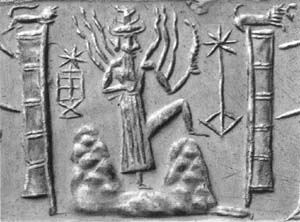
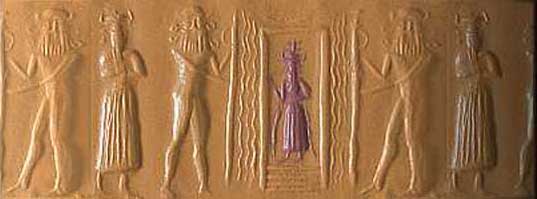
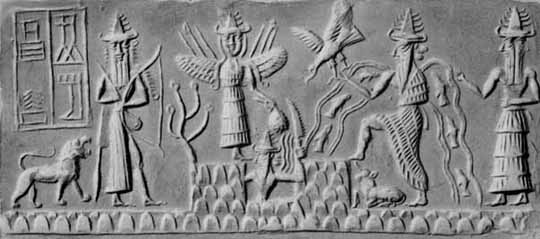
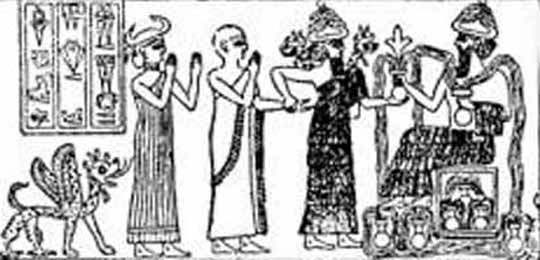


delmon seal (kingdom of bahrain)
“drinking men” two deities drink through long tubes toward their mouth, and amid them from the top there is a stick holds three half-moon with open ends where a sun can be seen. Ritual objects indicate the religious character of the scene.
Source: karranah, state of bahrain type: late delmon civilization (2000 to 1600 BCE)






















 Bronze bull-head. Discovered at Saar. Bahrein.
Bronze bull-head. Discovered at Saar. Bahrein.Dilmun seals of Saar (12) with Indus Script hieroglyphs signify metalwork catalogues
Mirror: http://tinyurl.com/hfznzjl
Sarasvati civilization was a trading partner with Bahrain from 2800 to 1500 BCE.
Meluhha merchant settlements are attested in cuneiform texts in Elam and in Mesopotamia. Thanks to Eric Olijdam who has provided an insightful monograph brilliantly collating a number of related artifacts from Ancient Near East. Some of these artifacts signify metalwork catalogues using Indus Script cipher and should be added to the Indus Script Corpora which is catalogus catalogorum of Bronze Age documented by seafaring Meluhha merchants along the Maritime Tin Route.![]() Circular seal of Bahrain found at Lothal. miṇḍāl 'markhor' (Tōrwālī) meḍho a ram, a sheep (Gujarati)(CDIAL 10120) Rebus: mẽṛhẽt, meḍ 'iron' (Munda.Ho.) gaNDa 'four' rebus: khaNDa 'implements' dhAtu 'strand' rebus: dhAtu 'mineral' tri-dhAtu 'three strands' rebus: tri-dhAtu 'three minerals' ALSO, dhAvaD 'strands' rebus: dhAvad 'smelter'. Thus, the seal signifies implements out of smelter for iron minerals. See: http://www.penn.museum/sites/expedition/shipping-and-maritime-trade-of-the-indus-people/ (Includes article of SR Rao).
Circular seal of Bahrain found at Lothal. miṇḍāl 'markhor' (Tōrwālī) meḍho a ram, a sheep (Gujarati)(CDIAL 10120) Rebus: mẽṛhẽt, meḍ 'iron' (Munda.Ho.) gaNDa 'four' rebus: khaNDa 'implements' dhAtu 'strand' rebus: dhAtu 'mineral' tri-dhAtu 'three strands' rebus: tri-dhAtu 'three minerals' ALSO, dhAvaD 'strands' rebus: dhAvad 'smelter'. Thus, the seal signifies implements out of smelter for iron minerals. See: http://www.penn.museum/sites/expedition/shipping-and-maritime-trade-of-the-indus-people/ (Includes article of SR Rao).
http://bharatkalyan97.blogspot.in/2014/04/ant-twisted-rope-and-other-meluhha.html Twisted rope, ant and other Meluhha hieroglyphs on Ancient Near East and Indian sea
![]() Most of the seals from Saar are made from steatite. Seals were used to seal goods intended for seafaring trade.
Most of the seals from Saar are made from steatite. Seals were used to seal goods intended for seafaring trade.
![]()
Dilmun seal. Afghanistan (Sarianidi 1986a: drawing on . 231). After Fig. 14 in Eric Olijdam opcit.
barad, balad 'bull' Rebus: bharata 'alloy of copper, pewter, tin' (Marathi) dula ‘pair’ Rebus: dul ‘cast metal’. kolom 'three' Rebus: kolimi 'smithy, forge' Hieroglyph: dotted circles: pottal 'hole' Rebus: pota 'metal casting. పోత (p. 0823) [ pōta ] pōta. [Tel. from పోయు.] n. Pouring, పోయుట. Casting, as of melted metal. పోత pōta. adj. Molten, cast in metal. పోతచెంబు a metal bottle or jug, which has been cast not hammered.(Telugu) Hieroglyphs: dotted circle and three strands on the knob of the seal: dhāˊtu *strand of rope ʼ (cf. tridhāˊtu -- ʻ threefold ʼ RV., ayugdhātu -- ʻ having an uneven number of strands ʼ KātyŚr.) S. dhāī f. ʻ wisp of fibres added from time to time to a rope that is being twisted ʼ, L. dhāī˜ f.(CDIAL 6773 ) Rebus: dhāˊtu n. ʻ substance ʼ RV., m. ʻ element ʼ MBh., ʻ metal, mineral, ore (esp. of a red colour) ʼ Mn.Pk. dhāu -- m. ʻ metal, red chalk ʼ; N. dhāu ʻ ore (esp. of copper) ʼ; Or. ḍhāu ʻ red chalk, red ochre ʼ (whence ḍhāuā ʻ reddish ʼ; M. dhāū, dhāv m.f. ʻ a partic. soft red stone ʼ (whence dhā̆vaḍ m. ʻ a caste of iron -- smelters ʼ, dhāvḍī ʻ composed of or relating to iron ʼ)(CDIAL 6773).
Unprovenanced Harappan-style cylinder seal impression; Museedu Louvre; cf. Corbiau, 1936, An Indo-Sumerian cylinder, Iraq 3, 100-3, p. 101, Fig.1; De ClercqColl.; burnt white agate; De Clercqand Menant, 1888, No. 26; Collon, 1987, Fig. 614. A hero grasping two tigers and a buffalo-and-leaf-horned person, seated on a stool with hoofed legs, surrounded by a snake and a fish on either side, a pair of water buffaloes. Another person stands and fights two tigers and is surrounded by trees, a markhor goat and a vulture above a rhinoceros. Text 9905
Hieroglyphs on the cylinder seal impression are: buffalo, tiger, rice-plant, eagle, ram, hooded snake, fish pair, round object (circle), crucible, twigs as part of hair-style of the seated person.
kula 'hooded snake' Rebus: kol 'working in iron'; kolle 'blacksmith' kolhe 'smelter'
dula 'pair' Rebus: dul 'cast metal'
The bunch of twigs = kūdī,kūṭī (Samskritam)kūdī (also written as kūṭī in manuscripts) occurs in the Atharvaveda (AV 5.19.12) and KauśikaSūtra (Bloomsfield'sed.n, xliv. cf. Bloomsfield, American Journal of Philology, 11, 355; 12,416; Roth, Festgrussan Bohtlingk, 98) denotes it as a twig. This is identified as that of Badarī, the jujube tied to the body of the dead to efface their traces. (See Vedic Index, I, p. 177). Rebus: kuThi 'smelter'
Hieroglyph multiplexes of the hypertext of the cylinder seal from a Near Eastern Source can be identified: aquatic bird, rhinoceros, buffalo, buffalo horn, crucible, markhor, antelope, hoofed stool, fish, tree, tree branch, twig, roundish stone, tiger, rice plant.
![]() Hieroglyph components on the head-gear of the person on cylinder seal impression are: twig, crucible, buffalo horns: kuThI 'badari ziziphus jojoba' twig Rebus: kuThi 'smelter'; koThAri 'crucible' Rebus: koThAri 'treasurer'; tattAru 'buffalo horn' Rebus: ṭhã̄ṭhāro 'brassworker'.
Hieroglyph components on the head-gear of the person on cylinder seal impression are: twig, crucible, buffalo horns: kuThI 'badari ziziphus jojoba' twig Rebus: kuThi 'smelter'; koThAri 'crucible' Rebus: koThAri 'treasurer'; tattAru 'buffalo horn' Rebus: ṭhã̄ṭhāro 'brassworker'.
![]() This hieroglyph multiplex ligatures head of an antelope to a snake: nAga 'snake' Rebus: nAga 'lead' ranku 'antelope' Rebus: ranku 'tin'. tuttināgamu is a Prakritam gloss meaning 'pewter, zinc'. A comparable alloy may be indicated by the hieroglyph-multiplex of antelope-snake: rankunAga, perhaps a type of zinc or lead alloy.
This hieroglyph multiplex ligatures head of an antelope to a snake: nAga 'snake' Rebus: nAga 'lead' ranku 'antelope' Rebus: ranku 'tin'. tuttināgamu is a Prakritam gloss meaning 'pewter, zinc'. A comparable alloy may be indicated by the hieroglyph-multiplex of antelope-snake: rankunAga, perhaps a type of zinc or lead alloy.
Two fish hieroglyphs flank the hoofed legs of the stool or platform signify: warehouse of cast metal alloy metal implements:
Hieroglyph: kaṇḍō a stool Rebus: kanda 'implements'Hieroglyph: maṇḍā 'raised platform, stool' Rebus: maṇḍā 'warehouse'.
dula 'pair' Rebus: dul 'cast metal'ayo 'fish' Rebus: aya 'iron' (Gujarati) ayas 'metal' (Rigveda)barad, barat 'ox' Rebus: भरत (p. 603) [ bharata ] n A factitious metal compounded of copper, pewter, tin &c.(Marathi).
![]() This mkultiplx is flanked by 1. kolom 'rice plant' Rebus: kolimi 'smithy, forge'; 2. kuTi 'tree' Rebus: kuThi 'smeter'. Thus the message is that the warehouse of cast metal alloy metal implements is complemented by a smelter and a smithy/forge -- part of the metalwork repertoire.
This mkultiplx is flanked by 1. kolom 'rice plant' Rebus: kolimi 'smithy, forge'; 2. kuTi 'tree' Rebus: kuThi 'smeter'. Thus the message is that the warehouse of cast metal alloy metal implements is complemented by a smelter and a smithy/forge -- part of the metalwork repertoire.
The hieroglyph-multiplex of a woman thwarting two rearing tigers is also signified on other seals and tablets to signify:
Hieroglyph: kola 'woman' Rebus: kol 'working in iron'dula 'pair' Rebus: dul 'cast metal' PLUS kola 'tiger' Rebus: kolle 'blacksmith'; kolhe 'smeter'; kole.l 'smithy, forge'. The kolmo 'rice-plant' Rebus kolimi 'smithy, forge' is a semantic determinant of the cipher: smithy with smelter.
The bottom register of the cylinder seal impression lists the products: smithy/forge forged iron, alloy castings (laterite PLUS spelter), hard alloy implements.
goTa 'roundish stone' Rebus: gota 'laterite'dula 'pair' Rebus: dul 'cast metal' PLUS rã̄go 'buffalo' Rebus: rāṅgā 'zinc alloy, spelter, pewter'. Thus, cast spelter PLUS laterite.
markhor PLUS tail
miṇḍāl 'markhor' (Tōrwālī) meḍho a ram, a sheep (Gujarati)(CDIAL 10120) Rebus: mẽṛhẽt, meḍ 'iron' (Munda.Ho.) koṭe meṛed = forged iron, in contrast to dul meṛed, cast iron (Mundari) PLUS Kur. xolā tail. Malt. qoli id. (DEDR 2135) Rebus: kol 'working in iron' Ta. kol working in iron, blacksmith; kollaṉ blacksmith. Ma. kollan blacksmith, artificer. Ko. kole·l smithy, temple in Kota village.
Rhinoceros PLUS aquatic bird or eagle
Hieroglyhph: kāṇṭā 'rhinoceros. gaṇḍá m. ʻ rhinoceros ʼ Rebus: kāṇḍa 'tools, pots and pans and metal-ware' (Gujarati)
karaṛa 'large aquatic bird' (Sindhi) Rebus: karaḍā 'hardalloy of metals' (Marathi) Alternative: eruvai 'kite, eagle' Rebus: eruvai 'copper (red)'
Two water-buffalos flanks a hieroglyph: something round, like a seed. Hieroglyph: rã̄go 'buffalo' Rebus: rāṅgā 'zinc alloy, spelter, pewter'. What does the hieroglyph 'something round' signify? I suggest that it signifies goTa 'laterite (ferrous ore)'.
All these hieroglyhphs/hieroglyph-multiplexes are read as metalwork catalogue items in Prakritam which had tadbhava, tatsama identified in Samskritam in Indian sprachbund (speech union).
Hieroglyphs on this seal impression are: safflower, eagle, bull calf.
Hieroglyph: karaḍā '
kōḍe, kōḍiya. [Tel.] n. A bullcalf. Rebus: koḍ artisan’s workshop (Kuwi) kunda ‘turner’ kundār turner (Assamese)
eruvai 'eagle, a kind of kite' Rebus: eruvai 'copper'
The cylinder seal impression may be a message about the contents of the storage jar:
copper-iron hard alloy workshop.
![]() Thanks to Eric Olijdam who has provided an insightful monograph brilliantly collating a number of related artifacts from Ancient Near East. (Eric Olijdam, 2008, A possible central Asian origin for seal-impressed jar from the 'Temple Tower' at Failaka, in: Eric Olijdam and Richard H. Spoor, eds., 2008, Intercultural relations between south and southwest Asia, Studies in commemoration of ECL During Caspers (1934-1996), Society for Arabian Studies Monographs No. 7 [eds. D. Kennet & St J. Simpson], BAR International Series 1826 pp. 268-287).
Thanks to Eric Olijdam who has provided an insightful monograph brilliantly collating a number of related artifacts from Ancient Near East. (Eric Olijdam, 2008, A possible central Asian origin for seal-impressed jar from the 'Temple Tower' at Failaka, in: Eric Olijdam and Richard H. Spoor, eds., 2008, Intercultural relations between south and southwest Asia, Studies in commemoration of ECL During Caspers (1934-1996), Society for Arabian Studies Monographs No. 7 [eds. D. Kennet & St J. Simpson], BAR International Series 1826 pp. 268-287).
https://www.academia.edu/403945/A_Possible_Central_Asian_Origin_for_the_Seal-Impressed_Jar_from_the_Temple_Tower_at_Failaka In this monograph, Eric Olijdam has provided remarkable evidences for mercantile and intercultural connections in a remarkably interactive civilizational area of the Bronze Age covering the Persian (Arab) Gulf, Bactria-Margiana Archaeological Complex (BMAC) and in my view, also Meluhha since some artifacts cited seem to signify Indus Script hieroglyphs since the links of Persian Gulf sites with Meluhha are well attested by a cylinder seal impression signifying hieroglyphs: elephant, rhinoceros, crocodile (gharial):![]() Tell AsmarCylinder seal modern impression [elephant, rhinoceros and gharial (alligator) on the upper register] bibliography and image source: Frankfort, Henri: Stratified Cylinder Seals from the Diyala Region. Oriental Institute Publications 72. Chicago: University of Chicago Press, no. 642. Museum Number: IM14674 3.4 cm. high. Glazed steatite. ca. 2250 - 2200 BCE. ibha 'elephant' Rebus: ib 'iron' (Santali). karibha 'trunk of elephant' (Pali) Rebus: karba 'iron' (Tulu) kāṇḍā 'rhinoceros' Rebus: khāṇḍa ‘tools, pots and pans, and metal-ware’. karā 'crocodile'(Telugu) Rebus: khār 'blacksmith' (Kashmiri)
Tell AsmarCylinder seal modern impression [elephant, rhinoceros and gharial (alligator) on the upper register] bibliography and image source: Frankfort, Henri: Stratified Cylinder Seals from the Diyala Region. Oriental Institute Publications 72. Chicago: University of Chicago Press, no. 642. Museum Number: IM14674 3.4 cm. high. Glazed steatite. ca. 2250 - 2200 BCE. ibha 'elephant' Rebus: ib 'iron' (Santali). karibha 'trunk of elephant' (Pali) Rebus: karba 'iron' (Tulu) kāṇḍā 'rhinoceros' Rebus: khāṇḍa ‘tools, pots and pans, and metal-ware’. karā 'crocodile'(Telugu) Rebus: khār 'blacksmith' (Kashmiri)
http://bharatkalyan97.blogspot.in/2015/09/seafaring-meluhha-artisans-use-indus.html
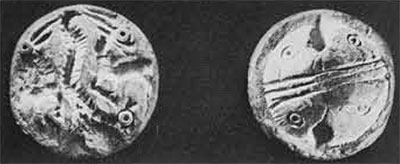 Circular seal of Bahrain found at Lothal. miṇḍāl 'markhor' (Tōrwālī) meḍho a ram, a sheep (Gujarati)(CDIAL 10120) Rebus: mẽṛhẽt, meḍ 'iron' (Munda.Ho.) gaNDa 'four' rebus: khaNDa 'implements' dhAtu 'strand' rebus: dhAtu 'mineral' tri-dhAtu 'three strands' rebus: tri-dhAtu 'three minerals' ALSO, dhAvaD 'strands' rebus: dhAvad 'smelter'. Thus, the seal signifies implements out of smelter for iron minerals. See: http://www.penn.museum/sites/expedition/shipping-and-maritime-trade-of-the-indus-people/ (Includes article of SR Rao).
Circular seal of Bahrain found at Lothal. miṇḍāl 'markhor' (Tōrwālī) meḍho a ram, a sheep (Gujarati)(CDIAL 10120) Rebus: mẽṛhẽt, meḍ 'iron' (Munda.Ho.) gaNDa 'four' rebus: khaNDa 'implements' dhAtu 'strand' rebus: dhAtu 'mineral' tri-dhAtu 'three strands' rebus: tri-dhAtu 'three minerals' ALSO, dhAvaD 'strands' rebus: dhAvad 'smelter'. Thus, the seal signifies implements out of smelter for iron minerals. See: http://www.penn.museum/sites/expedition/shipping-and-maritime-trade-of-the-indus-people/ (Includes article of SR Rao).
barad, balad 'bull' Rebus: bharata 'alloy of copper, pewter, tin' (Marathi) dula ‘pair’ Rebus: dul ‘cast metal’. kolom 'three' Rebus: kolimi 'smithy, forge' Hieroglyph: dotted circles: pottal 'hole' Rebus: pota 'metal casting. పోత (p. 0823) [ pōta ] pōta. [Tel. from పోయు.] n. Pouring, పోయుట. Casting, as of melted metal. పోత pōta. adj. Molten, cast in metal. పోతచెంబు a metal bottle or jug, which has been cast not hammered.(Telugu) Hieroglyphs: dotted circle and three strands on the knob of the seal: dhāˊtu *strand of rope ʼ (cf. tridhāˊtu -- ʻ threefold ʼ RV., ayugdhātu -- ʻ having an uneven number of strands ʼ KātyŚr.) S. dhāī f. ʻ wisp of fibres added from time to time to a rope that is being twisted ʼ, L. dhāī˜ f.(CDIAL 6773 ) Rebus: dhāˊtu n. ʻ substance ʼ RV., m. ʻ element ʼ MBh., ʻ metal, mineral, ore (esp. of a red colour) ʼ Mn.Pk. dhāu -- m. ʻ metal, red chalk ʼ; N. dhāu ʻ ore (esp. of copper) ʼ; Or. ḍhāu ʻ red chalk, red ochre ʼ (whence ḍhāuā ʻ reddish ʼ; M. dhāū, dhāv m.f. ʻ a partic. soft red stone ʼ (whence dhā̆vaḍ m. ʻ a caste of iron -- smelters ʼ, dhāvḍī ʻ composed of or relating to iron ʼ)(CDIAL 6773).
 Hieroglyph components on the head-gear of the person on cylinder seal impression are: twig, crucible, buffalo horns: kuThI 'badari ziziphus jojoba' twig Rebus: kuThi 'smelter'; koThAri 'crucible' Rebus: koThAri 'treasurer'; tattAru 'buffalo horn' Rebus: ṭhã̄ṭhāro 'brassworker'.
Hieroglyph components on the head-gear of the person on cylinder seal impression are: twig, crucible, buffalo horns: kuThI 'badari ziziphus jojoba' twig Rebus: kuThi 'smelter'; koThAri 'crucible' Rebus: koThAri 'treasurer'; tattAru 'buffalo horn' Rebus: ṭhã̄ṭhāro 'brassworker'. This hieroglyph multiplex ligatures head of an antelope to a snake: nAga 'snake' Rebus: nAga 'lead' ranku 'antelope' Rebus: ranku 'tin'. tuttināgamu is a Prakritam gloss meaning 'pewter, zinc'. A comparable alloy may be indicated by the hieroglyph-multiplex of antelope-snake: rankunAga, perhaps a type of zinc or lead alloy.
This hieroglyph multiplex ligatures head of an antelope to a snake: nAga 'snake' Rebus: nAga 'lead' ranku 'antelope' Rebus: ranku 'tin'. tuttināgamu is a Prakritam gloss meaning 'pewter, zinc'. A comparable alloy may be indicated by the hieroglyph-multiplex of antelope-snake: rankunAga, perhaps a type of zinc or lead alloy. This mkultiplx is flanked by 1. kolom 'rice plant' Rebus: kolimi 'smithy, forge'; 2. kuTi 'tree' Rebus: kuThi 'smeter'. Thus the message is that the warehouse of cast metal alloy metal implements is complemented by a smelter and a smithy/forge -- part of the metalwork repertoire.
This mkultiplx is flanked by 1. kolom 'rice plant' Rebus: kolimi 'smithy, forge'; 2. kuTi 'tree' Rebus: kuThi 'smeter'. Thus the message is that the warehouse of cast metal alloy metal implements is complemented by a smelter and a smithy/forge -- part of the metalwork repertoire.
https://www.academia.edu/403945/A_Possible_Central_Asian_Origin_for_the_Seal-Impressed_Jar_from_the_Temple_Tower_at_Failaka In this monograph, Eric Olijdam has provided remarkable evidences for mercantile and intercultural connections in a remarkably interactive civilizational area of the Bronze Age covering the Persian (Arab) Gulf, Bactria-Margiana Archaeological Complex (BMAC) and in my view, also Meluhha since some artifacts cited seem to signify Indus Script hieroglyphs since the links of Persian Gulf sites with Meluhha are well attested by a cylinder seal impression signifying hieroglyphs: elephant, rhinoceros, crocodile (gharial):
http://bharatkalyan97.blogspot.in/2015/09/seafaring-meluhha-artisans-use-indus.html
Seals in Dilmun Society - Universiteit Leiden
https://openaccess.leidenuniv.nl/bitstream/.../ba-2011-sophietews.pdf?...1
by S Tews - 2012Steatite Dilmun Seal from Saar (Crawford 2001,58) ![]() Decoration beside the natural volute of the shell: miṇḍāl 'markhor' (Tōrwālī) meḍho a ram, a sheep (Gujarati)(
Decoration beside the natural volute of the shell: miṇḍāl 'markhor' (Tōrwālī) meḍho a ram, a sheep (Gujarati)(![]() meD 'dance' meTTu 'dance step' allograph: miṇḍāl 'markhor' (Tōrwālī) meḍho a ram, a sheep (Gujarati)(
meD 'dance' meTTu 'dance step' allograph: miṇḍāl 'markhor' (Tōrwālī) meḍho a ram, a sheep (Gujarati)(![]() kolmo 'rice plant' rebus: kolimi 'smithy, forge' karNaka 'spread legs' rebus: karNI 'Supercargo'. Thus, seal of a merchant responsible for cargo from smithy, forge.
kolmo 'rice plant' rebus: kolimi 'smithy, forge' karNaka 'spread legs' rebus: karNI 'Supercargo'. Thus, seal of a merchant responsible for cargo from smithy, forge.![]() [ karaḍū or ṅkaraḍēṃ ] n A kid. कराडूं (p. 137) [ karāḍūṃ ] n (Commonly करडूं ) A kid. (Marathi) Rebus: करडा (p. 137) [ karaḍā ] 'hard alloy' PLUS kolom 'three' rebus: kolimi 'smithy, forge'. Thus seal of an artisan working with hard alloy smithy/forge.
[ karaḍū or ṅkaraḍēṃ ] n A kid. कराडूं (p. 137) [ karāḍūṃ ] n (Commonly करडूं ) A kid. (Marathi) Rebus: करडा (p. 137) [ karaḍā ] 'hard alloy' PLUS kolom 'three' rebus: kolimi 'smithy, forge'. Thus seal of an artisan working with hard alloy smithy/forge.![]() dula 'two' rebus: dul 'metal casting' [ karaḍū or ṅkaraḍēṃ ] n A kid. कराडूं (p. 137) [ karāḍūṃ ] n (Commonly करडूं ) A kid. (Marathi) Rebus: करडा (p. 137) [ karaḍā ] 'hard alloy' PLUS hieroglyph: twig: kūdī,kūṭī (Samskritam)kūdī (also written as kūṭī in manuscripts) occurs in the Atharvaveda (AV 5.19.12) and KauśikaSūtra (Bloomsfield'sed.n, xliv. cf. Bloomsfield, American Journal of Philology, 11, 355; 12,416; Roth, Festgrussan Bohtlingk, 98) denotes it as a twig. This is identified as that of Badarī, the jujube tied to the body of the dead to efface their traces. (See Vedic Index, I, p. 177). Rebus: kuThi 'smelter'. Thus the seal signifies a smelter for hard alloy.
dula 'two' rebus: dul 'metal casting' [ karaḍū or ṅkaraḍēṃ ] n A kid. कराडूं (p. 137) [ karāḍūṃ ] n (Commonly करडूं ) A kid. (Marathi) Rebus: करडा (p. 137) [ karaḍā ] 'hard alloy' PLUS hieroglyph: twig: kūdī,kūṭī (Samskritam)kūdī (also written as kūṭī in manuscripts) occurs in the Atharvaveda (AV 5.19.12) and KauśikaSūtra (Bloomsfield'sed.n, xliv. cf. Bloomsfield, American Journal of Philology, 11, 355; 12,416; Roth, Festgrussan Bohtlingk, 98) denotes it as a twig. This is identified as that of Badarī, the jujube tied to the body of the dead to efface their traces. (See Vedic Index, I, p. 177). Rebus: kuThi 'smelter'. Thus the seal signifies a smelter for hard alloy.
![]() gaNDa 'four' rebus: khaNDa 'implements' ḍato = claws of crab (Santali); dhātu = mineral (Skt.). Thus, metal ore implements.
gaNDa 'four' rebus: khaNDa 'implements' ḍato = claws of crab (Santali); dhātu = mineral (Skt.). Thus, metal ore implements.![]() [ karaḍū or ṅkaraḍēṃ ] n A kid. कराडूं (p. 137) [ karāḍūṃ ] n (Commonly करडूं ) A kid. (Marathi) Rebus: करडा (p. 137) [ karaḍā ] 'hard alloy' PLUS kuDi 'drink' rebus: kuThi 'smelter' kANDa 'water' rebus: khaNDa 'implements' karaḍā '
[ karaḍū or ṅkaraḍēṃ ] n A kid. कराडूं (p. 137) [ karāḍūṃ ] n (Commonly करडूं ) A kid. (Marathi) Rebus: करडा (p. 137) [ karaḍā ] 'hard alloy' PLUS kuDi 'drink' rebus: kuThi 'smelter' kANDa 'water' rebus: khaNDa 'implements' karaḍā '![]() कमठ [p= 252,1] m. ( Un2. i , 102) a tortoise BhP. Pan5cat. &c rebus: kammaTa 'mint, coiner, coinage' krammara 'turn back' rebus: kamar 'artisan, smith' PLUS [ karaḍū or ṅkaraḍēṃ ] n A kid. कराडूं (p. 137) [ karāḍūṃ ] n (Commonly करडूं ) A kid. (Marathi) Rebus: करडा (p. 137) [ karaḍā ] 'hard alloy' kaNDA 'arrow' rebus:khaNDa 'implements' Thus, artisan working with hard alloy and implements in a mint, coinage, a coiner.
कमठ [p= 252,1] m. ( Un2. i , 102) a tortoise BhP. Pan5cat. &c rebus: kammaTa 'mint, coiner, coinage' krammara 'turn back' rebus: kamar 'artisan, smith' PLUS [ karaḍū or ṅkaraḍēṃ ] n A kid. कराडूं (p. 137) [ karāḍūṃ ] n (Commonly करडूं ) A kid. (Marathi) Rebus: करडा (p. 137) [ karaḍā ] 'hard alloy' kaNDA 'arrow' rebus:khaNDa 'implements' Thus, artisan working with hard alloy and implements in a mint, coinage, a coiner.
![]() karNaka 'spreadlegs' rebus: karNI 'Supercargo' krammara 'turn back' rebus: kamar 'artisan, smith' PLUS [ karaḍū or ṅkaraḍēṃ ] n A kid. कराडूं (p. 137) [ karāḍūṃ ] n (Commonly करडूं ) A kid. (Marathi) Rebus: करडा (p. 137) [ karaḍā ] 'hard alloy' कमठ [p= 252,1] m. ( Un2. i , 102) a tortoise BhP. Pan5cat. &c rebus: kammaTa 'mint, coiner, coinage'. Thus, artisan working with hard alloy and implements in a mint, coinage, a coiner. He is also Supercago responsible for cargo of shipment on a seafaring vessel.
karNaka 'spreadlegs' rebus: karNI 'Supercargo' krammara 'turn back' rebus: kamar 'artisan, smith' PLUS [ karaḍū or ṅkaraḍēṃ ] n A kid. कराडूं (p. 137) [ karāḍūṃ ] n (Commonly करडूं ) A kid. (Marathi) Rebus: करडा (p. 137) [ karaḍā ] 'hard alloy' कमठ [p= 252,1] m. ( Un2. i , 102) a tortoise BhP. Pan5cat. &c rebus: kammaTa 'mint, coiner, coinage'. Thus, artisan working with hard alloy and implements in a mint, coinage, a coiner. He is also Supercago responsible for cargo of shipment on a seafaring vessel.
See:
Dilmun seal, 3 men in a boat kolom 'three' rebus kolimi 'smithy, forge' meD 'dance-step two men holding ingot dul mẽṛhẽt 'cast iron' muh 'ingot'.
Mirror: http://tinyurl.com/hmbnjgf
Thanks to Vidale et al for the focus on 3 seals from Dilmun. I suggest that the narratives are NOT related to slave trade but signifiers of cargo of tin and copper for smithy/forge. This suggestion is based on Meluhha hypertext readings of Harappa Script hieroglyphs.
Vidale, Frenez & David-Cuny 2016 - Three men in a boat. The seal of a Dilmunite slave trader? in: Seminar for Arabian Studies, British Museum, London
Four horizontal lines across the lower legs of the two human figures are a hieroglyph: gaṇḍa 'four' rebus:kaṇḍa 'implements'.
The large step of the third person with a leg above the stern is a signifier of a dance step: meḍ 'step, dance step' rebus: mẽṛhẽt, meḍ 'iron' med 'copper' (Slavic languages).
The oval object held by the two seated persons could be an ingot. Two is a hieroglyph: dula 'two' rebus: dul 'metal casting'. Thus, what is held by the two is dul mẽṛhẽt 'cast iron' mũh 'ingot'.
Thanks to Vidale et al for the focus on 3 seals from Dilmun. I suggest that the narratives are NOT related to slave trade but signifiers of cargo of tin and copper for smithy/forge. This suggestion is based on Meluhha hypertext readings of Harappa Script hieroglyphs.
Vidale, Frenez & David-Cuny 2016 - Three men in a boat. The seal of a Dilmunite slave trader? in: Seminar for Arabian Studies, British Museum, London
Four horizontal lines across the lower legs of the two human figures are a hieroglyph: gaṇḍa 'four' rebus:kaṇḍa 'implements'.
The large step of the third person with a leg above the stern is a signifier of a dance step: meḍ 'step, dance step' rebus: mẽṛhẽt, meḍ 'iron' med 'copper' (Slavic languages).
The oval object held by the two seated persons could be an ingot. Two is a hieroglyph: dula 'two' rebus: dul 'metal casting'. Thus, what is held by the two is dul mẽṛhẽt 'cast iron' mũh 'ingot'.
![]() An Early Dilmun Period (2000-1900 B.C.) stamp seal from Saar, Bahrain.(Courtesy of London-Bahrain Archaeological Expedition and Robert Killick. ṛanku, ranku = fornication, adultery (Telugu); rebus: ranku 'tin' (Santali) kamaṭha 'turtle' rebus: kammaṭa 'mint, coiner,coinage'. kāṇḍa, kã̄ṛ ʻstalk, arrow ʼ(CDIAL 3023).Rebus: kāṇḍa,'implements' Thus, the seal message: tin,mint implements.
An Early Dilmun Period (2000-1900 B.C.) stamp seal from Saar, Bahrain.(Courtesy of London-Bahrain Archaeological Expedition and Robert Killick. ṛanku, ranku = fornication, adultery (Telugu); rebus: ranku 'tin' (Santali) kamaṭha 'turtle' rebus: kammaṭa 'mint, coiner,coinage'. kāṇḍa, kã̄ṛ ʻstalk, arrow ʼ(CDIAL 3023).Rebus: kāṇḍa,'implements' Thus, the seal message: tin,mint implements.
S. Kalyanaraman, D. Litt.Sarasvati Research Centre 15 Jan. 2019
TRIANGULAR STAMP SEALS FROM ARABIAN GULF, ONCE AGAIN
E.C.L. During CaspersProceedings of the Seminar for Arabian StudiesVol. 24, Proceedings of the Twenty Seventh SEMINAR FOR ARABIAN STUDIES held at London on 22-24 July 1993 (1994), pp. 97-114 (18 pages)https://www.jstor.org/stable/41223411
Dilmun revisited: excavations at Saar, Bahrain
Decipherment of Persian or Arabian Gulf inscriptions. Indus Script hypertexts of metalwork, wealth-accounting ledgers
This monograph demonstrates that Persian or Arabian Gulf inscriptions to be Indus Script hypertexts of metalwork catalogues, wealth-accounting ledgers.
A pair of 'men' shown on many Persian Gulf or Dilmun seals are often viewed as signifiers of an underlying language which is different from the underlying Meluhha language of Indus Script inscriptions.
A pair of 'men' occurs on Indus Script inscriptions. Together with reduplication of pictrographs as mirror images, the signifiers of a pair of 'men' pictograph are read rebus as related to metal casting, cire perdue technique of casting in particular, which is reduplication metallurgical process.
The key words and expressions of Meluhha language are seen in the following glosses:
The key rebus reading of a pair of 'men' pictographs is: meḍ 'body' rebus: meḍ 'iron' PLUS dula 'pair' rebus: dul 'metal casting'. Thus, dul meḍ 'cast iron'.
 PLUS ranku 'antelope' rebus: ranku 'tin'. Thus, tin metalcasting.
PLUS ranku 'antelope' rebus: ranku 'tin'. Thus, tin metalcasting. ranku 'antelope' rebus: ranku 'tin' PLUS mē̃d, mēd 'body' rebus: mē̃d, mēd 'iron', med 'copper' (Slavic).
ranku 'antelope' rebus: ranku 'tin' PLUS mē̃d, mēd 'body' rebus: mē̃d, mēd 'iron', med 'copper' (Slavic). ḍhangra ‘bull’ Rebus: ṭhakkura m. ʻ idol, deity; dhangar 'blacksmith'Mth.ṭhākur ʻblacksmith'
ḍhangra ‘bull’ Rebus: ṭhakkura m. ʻ idol, deity; dhangar 'blacksmith'Mth.ṭhākur ʻblacksmith'  PLUS dhangra 'bull' rebus: dhangar 'blacksmith'
PLUS dhangra 'bull' rebus: dhangar 'blacksmith'The 'body' of man hieroglyph is ligatured with a series of diacritical marks to signify hypertexts of metalwork processes. This ligaturing results in 48 hypertext signs shown below (1977 Mahadevan ASI concordance).
Helmsman, supercargo (metal)
See: http://bharatkalyan97.blogspot.in/2014/09/stature-of-body-meluhha-hieroglyphs-48.html where the 'stature of body' was read rebus as kāṭi 'body stature'; Rebus: fireplace trench.
With the focus on 'spread legs' on this hieroglyph of 'standing person' orthography, it is possible that the 'body hieroglyph with spread legs' also connoted: कर्णक 'spread legs' rebus: 'helmsman',karṇi supercargo'.
Decipherment: कर्णक 'helmsman' PLUS mē̃d, mēd 'body' rebus: mē̃d, mēd 'iron', med 'copper' (Slavic). Thus the body hieroglyph signifies mē̃d कर्णक karṇi 'an iron helmsman seafaring, supercargo merchant.'
Thus, in the following renderings kāṭi 'body stature' should be supplemented with कर्णक karṇi'helmsman seafaring, supercargo metals merchant'.
Hypertext of the base hieroglyph reads: mē̃ḍ 'body' rebus: mē̃ḍ ‘iron’ (Mu.)The principal design feature of Indus Script hieroglyphs or 'signs' in Corpora is the सांगड sāṅgaḍa, which is 'a hypertext orthograph formed of two or more components linked together'. Rebus: sangraha, sangaha'catalogue, list' is applicable. Thus, all composite hypertexts composed of hieroglyph components are 'catalogues,lists'.
![]() Sign 4 Variants
Sign 4 Variants ![]() Sign 6
Sign 6![]() Sign 7 ciphertext is composed of
Sign 7 ciphertext is composed of![]() Sign 1 and 'flag' hieroglyph. Hieroglyph: dhvajapaṭa m. ʻ flag ʼ Kāv. [
Sign 1 and 'flag' hieroglyph. Hieroglyph: dhvajapaṭa m. ʻ flag ʼ Kāv. [dhvajá -- , paṭa -- ]Pk. dhayavaḍa -- m. ʻ flag ʼ, OG. dhayavaḍa m. Rebus: Pk. dhāu -- m. ʻ metal, red chalk ʼ; N. dhāu ʻ ore (esp. of copper) ʼ; Or. ḍhāu ʻ red chalk, red ochre ʼ (whence ḍhāuā ʻ reddish ʼ; M. dhāū, dhāv m.f. ʻ a partic. soft red stone ʼ (whence dhā̆vaḍ m. ʻ a caste of iron -- smelters ʼ, dhāvḍī ʻ composed of or relating to iron ʼ); -- Si. dā ʻ relic (CDIAL 6773) Hypertext reads: mē̃ḍ 'body' rebus: mē̃ḍ ‘iron’ (Mu.) PLUS dhā̆vaḍ (semantic determinative': 'iron smelter'. Vikalpa: The ligature attached to the neck of the body on Sign 7 may signify 'notch' खांडा khāṇḍā .A jag, notch, or indentation (as upon the edge of a tool or weapon). A rough furrow, ravine, gully. (Marathi) rebus: khāṇḍa '
Sign 19 ![]() Variant Sign 22
Variant Sign 22![]() Variant Sign 23
Variant Sign 23![]() Variant Sign 24
Variant Sign 24![]() mē̃ḍ 'body' rebus: mē̃ḍ ‘iron’ (Mu.) PLUS dula 'pair' rebus: dul 'metalcasting' PLUS khareḍo 'a currycomb' (Gujarati) rebus: kharaḍa, 'daybook'. Thus, iron daybook. Sign 24 variant is 'iron metalcasting daybook'. Vikalpa: Sign 24 may be orthographed to signify bracelets, wristlets: karã̄ n. pl.wristlets, banglesRebus: khãr '
mē̃ḍ 'body' rebus: mē̃ḍ ‘iron’ (Mu.) PLUS dula 'pair' rebus: dul 'metalcasting' PLUS khareḍo 'a currycomb' (Gujarati) rebus: kharaḍa, 'daybook'. Thus, iron daybook. Sign 24 variant is 'iron metalcasting daybook'. Vikalpa: Sign 24 may be orthographed to signify bracelets, wristlets: karã̄ n. pl.wristlets, banglesRebus: khãr '
Sign 20![]() mē̃ḍ 'body' rebus: mē̃ḍ ‘iron’ (Mu.) PLUS khareḍo 'a currycomb' (Gujarati) rebus: kharaḍa, 'daybook' PLUS
mē̃ḍ 'body' rebus: mē̃ḍ ‘iron’ (Mu.) PLUS khareḍo 'a currycomb' (Gujarati) rebus: kharaḍa, 'daybook' PLUS खांडा khāṇḍā .A jag, notch, or indentation (as upon the edge of a tool or weapon). A rough furrow, ravine, gully. (Marathi) rebus: khāṇḍa '
![]()
Sign 43: Kur. kaṇḍō a stool. Malt. kanḍo stool, seat. (DEDR 1179) Rebus: kaṇḍ 'fire-altar' (Santali) kāṇḍa ‘tools, pots and pans and metal-ware’ (Marathi) + kāṭi 'body stature; Rebus: fireplace trench. Thus, furnace for metals in mint. Thus, fire-altar metalware furnace.
Sign 36: kāṭi 'body stature; Rebus: fireplace trench. Thus, furnace for metals in mint + kamaḍha ‘crab’ Rebus: kammaṭa ‘mint, coiner’. ḍato = claws of crab (Santali) Rebus: dhātu ‘mineral ore’. Thus mineral ore mint, coiner.kamaḍha ‘archer, bow’ Rebus: kammaṭa ‘mint, coiner’. + kāṭi 'body stature; Rebus: fireplace trench. Thus, furnace for metals in mint.![]() Sign 29 Archer. Ligature two bow-and-arrow hieroglyphs
Sign 29 Archer. Ligature two bow-and-arrow hieroglyphs
kamaḍha ‘archer, bow’ Rebus: kammaṭa ‘mint, coiner’. dula 'two' Rebu: dul 'cast metal'. Thus metal castings mint. + kāṭi 'body stature; Rebus: fireplace trench. Thus, furnace for metal castings in mint.
![]() Ligature hieroglyph: 'lid of pot'
Ligature hieroglyph: 'lid of pot'
aḍaren
‘lid of pot’ Rebus: aduru ‘unsmelted, native metal’ + kāṭi 'body stature; Rebus: fireplace trench. Thus furnace for aduru, unsmelted, native metal.![]() Ligatures: water-carrier + lid of pot
Ligatures: water-carrier + lid of pot
Sign 14: kuṭi ‘water-carrier’ Rebus: kuṭhi‘smelter/furnace’+kāṭi 'body stature; Rebus: fireplace trench +aḍaren‘lid of pot’ Rebus: aduru ‘unsmelted, native metal’ + kāṭi 'body stature; Rebus: fireplace trench. Thus furnace for aduru, unsmelted, native metal. Thus, furnace-smelter for unsmelted, native metal.
Sign 12: kuṭi ‘water-carrier’ Rebus: kuṭhi ‘smelter/furnace’+ kāṭi 'body stature; Rebus: fireplace trench. Thus, smelter furnace.
Sign 13: kuṭi ‘water-carrier’ Rebus: kuṭhi ‘smelter/furnace’+ kāṭi 'body stature; Rebus: fireplace trench. + खांडा [ khāṇḍā] m A jag, notch, or indentation (as upon the edge of a tool or weapon)(Marathi). Rebus: kāṇḍa ‘tools, pots and pans and metal-ware’ (Marathi) + kāṭi 'body stature; Rebus: fireplace trench. + kāṭi 'body =stature; Rebus: fireplace trench. Thus, smelter-furnace metalware.![]() Ligature: rim of jar Rebus: kanda kanka 'fire-trench account, karṇi supercargo' Tu. kandůka, kandaka ditch, trench. Te. kandakamu id. Konḍa kanda trench made as a fireplace during weddings. Pe.kanda fire trench. Kui kanda small trench for fireplace. Malt. kandri a pit. (DEDR 1214). 'rim-of-jar' hieroglyph Rebus: kanka (Santali) karṇika ‘scribe’(Sanskrit) kuṭi ‘water-carrier’ Rebus: kuṭhi ‘smelter/furnace’.+kāṭi'body stature; Rebus: fireplace trench. Thus, smelter furnace account, supercargo.
Ligature: rim of jar Rebus: kanda kanka 'fire-trench account, karṇi supercargo' Tu. kandůka, kandaka ditch, trench. Te. kandakamu id. Konḍa kanda trench made as a fireplace during weddings. Pe.kanda fire trench. Kui kanda small trench for fireplace. Malt. kandri a pit. (DEDR 1214). 'rim-of-jar' hieroglyph Rebus: kanka (Santali) karṇika ‘scribe’(Sanskrit) kuṭi ‘water-carrier’ Rebus: kuṭhi ‘smelter/furnace’.+kāṭi'body stature; Rebus: fireplace trench. Thus, smelter furnace account, supercargo.![]() Ligature 'two spoked wheels'
Ligature 'two spoked wheels'
Spokes-of-wheel, nave-of-wheel āra 'spokes' Rebus: āra ‘brass’. cf. erka = ekke (Tbh. of arka) aka (Tbh. of arka) copper (metal); crystal (Kannada) Glyph: eraka’nave of wheel’ Rebus: eraka ‘copper’; cf. erka = ekke (Tbh. of arka) aka (Tbh. of arka) copper (metal); crystal (Kannada) dula 'two' Rebus: dul 'cast metal'. Thus, moltencast copper castings ++ kāṭi 'body stature; Rebus: fireplace trench. Thus, furnace for copper metal castings.
kanac ‘corner’ Rebus: kañcu ‘bronze’ + kāṭi 'body stature; Rebus: fireplace trench. Thus, furnace for bronze castings.![]() Sign 31: kana, kanac = corner (Santali); Rebus: kañcu = bronze (Telugu) PLUS खांडा [ khāṇḍā ] m A jag, notch, or indentation (as upon the edge of a tool or weapon). Rebus: kāṇḍa ‘tools, pots and pans and metal-ware’ Thus, bronze metalware. + kāṭi'body stature; Rebus: fireplace trench. Thus, furnace bronze metalware castings.Sign1 Hieroglyph: काठी [ kāṭhī ] f (
Sign 31: kana, kanac = corner (Santali); Rebus: kañcu = bronze (Telugu) PLUS खांडा [ khāṇḍā ] m A jag, notch, or indentation (as upon the edge of a tool or weapon). Rebus: kāṇḍa ‘tools, pots and pans and metal-ware’ Thus, bronze metalware. + kāṭi'body stature; Rebus: fireplace trench. Thus, furnace bronze metalware castings.Sign1 Hieroglyph: काठी [ kāṭhī ] f (काष्ट S) (or शरीराची काठी ) The frame or structure of the body: also (viewed by some as arising from the preceding sense, Measuring rod) stature (Marathi) B. kāṭhā ʻ measure of length ʼ(CDIAL 3120).
H. kāṭhī 'wood' f. G. kāṭh n. ʻ wood ʼ, °ṭhī f. ʻ stick, measure of 5 cubits ʼ(CDIAL 3120). + kāṭi 'body stature; Rebus: fireplace trench.The 'stick' hieroglyph is a phonetic reinforcement of 'body stature' hieroglyph. Alternatively, koḍ 'one' Rebus: koḍ 'workshop'+ kāṭi 'body stature; Rebus: fireplace trench.. Thus, workplace of furnace fire-trench.
Rebus: G. kāṭɔṛɔ m. ʻ dross left in the furnace after smelting iron ore ʼ.(CDIAL 2646)
Rebus: kāṭi , n. < U. ghāṭī. 1. Trench of a fort; அகழி. 2. A fireplace in the form of a long ditch; கோட்டையடுப்பு காடியடுப்பு kāṭi-y-aṭuppu , n. < காடி&sup6; +. A fireplace in the form of a long ditch used for cooking on a large scale; கோட்டையடுப்பு.
Rebus: S.kcch. kāṭhī f. ʻ wood ʼPa. Pk. kaṭṭha -- n. ʻ wood ʼ(CDIAL 3120).
Sign 37 Hieroglyph: WPah.kṭg. ṭōṭ ʻ mouth ʼ.WPah.kṭg. thótti f., thótthəṛ m. ʻ snout, mouth ʼ, A. ṭhõt(phonet. thõt) (CDIAL 5853).
Rebus:
tutthá n. (m. lex.), tutthaka -- n. ʻ blue vitriol (used as an eye ointment) ʼ Suśr., tūtaka -- lex. 2. *thōttha -- 4 . 3. *tūtta -- . 4. *tōtta -- 2 . [Prob. ← Drav. T. Burrow BSOAS xii 381; cf. dhūrta -- 2 n. ʻ iron filings ʼ lex.]1. N. tutho ʻ blue vitriol or sulphate of copper ʼ, B. tuth.2. K. thŏth, dat. °thas m., P. thothā m.3. S.tūtio m., A. tutiyā, B. tũte, Or. tutiā, H. tūtā, tūtiyā m., M. tutiyā m.4. M. totā m.(CDIAL 5855) Ka. tukku rust of iron; tutta, tuttu, tutte blue vitriol. Tu. tukků rust; mair(ů)suttu, (Eng.-Tu. Dict.) mairůtuttu blue vitriol. Te. t(r)uppu rust; (SAN) trukku id., verdigris. / Cf. Skt. tuttha- blue vitriol (DEDR 3343).
Sign 2: dula 'pair' Rebus: dul 'cast metal' + kāṭi 'body stature; Rebus: fireplace trench. Thus furnace for metal casting. koḍ 'one' Rebus: koḍ 'workshop'. Thus, furnace workshop.Sign 18: खांडा [ khāṇḍā ] m A jag, notch, or indentation (as upon the edge of a tool or weapon)(Marathi). Rebus: kāṇḍa ‘tools, pots and pans and metal-ware’ (Marathi) + kāṭi 'body stature; Rebus: fireplace trench. Thus, furnace for metalware castings of unsmelted, native metal.
Sign 19: aḍar 'harrow'; rebus: aduru 'native unsmelted metal’ (Kannada) + kāṭi 'body stature; Rebus: fireplace trench. Thus, furnace for native metal.
Sign 20: खांडा [ khāṇḍā ] m A jag, notch, or indentation (as upon the edge of a tool or weapon)(Marathi). Rebus: kāṇḍa ‘tools, pots and pans and metal-ware’ (Marathi) + kāṭi 'body stature; Rebus: fireplace trench. Thus, furnace for metalware castings of unsmelted, native metal.
kSign 38: hareḍo = a currycomb (Gujarati) खरारा [ kharārā ] m ( H) A currycomb. 2 Currying a horse. (Marathi) Rebus: करडा [karaḍā] Hard from alloy--iron, silver &c. (Marathi) kharādī ‘ turner’ (Gujarati) kāṭi 'body stature; Rebus: fireplace trench. Thus, fireplace for hard alloy metal.
Sign 40: toṭi bracelet (Tamil)(DEDR 3682). Jaina Skt. (IL 20.193) toḍaka- ananklet (Sanskrit) khuṭo ʻ leg, foot ʼ, °ṭī ʻ goat's leg ʼ Rebus: khōṭā ‘alloy’ (Marathi) Rebus: tuttha 'copper sulphate' + kāṭi 'body stature; Rebus: fireplace trench. Thus smelted copper sulphate alloy.Sign 34:muka ‘ladle’ (Tamil)(DEDR 4887) Rebus: mū̃h ‘ingot’ (Santali) baṭa = a kind of iron (G.) baṭa = rimless pot (Kannada) Thus, iron ingot.+ kāṭi 'body stature; Rebus: fireplace trench. Thus, iron ingot furnace.Sign 32: baṭa = rimless pot (Kannada) Rebus: baṭa = a kind of iron (G.)+ kāṭi 'body stature; Rebus: fireplace trench. Thus, iron furnaceSign 44: meṭ sole of foot, footstep, footprint (Ko.); meṭṭu step, stair, treading, slipper (Te.)(DEDR 1557). Rebus: meḍ ‘iron’(Munda); मेढ meḍh‘merchant’s helper’(Pkt.) meḍ iron (Ho.) meṛed-bica = iron stone ore, in contrast to bali-bica, iron sand ore (Munda) + kāṭi 'body stature; Rebus: fireplace trench. Thus, iron furnace.
Sign 35: baṭa = rimless pot (Kannada) Rebus: baṭa = a kind of iron (G.)+ kāṭi 'body stature; Rebus: fireplace trench + akho m. ʻmesh of a netʼ Rebus: L. P. akkhā m. ʻ one end of a bag or sack thrown over a beast of burden ʼ; Or. akhā ʻ gunny bag ʼ; Bi. ākhā, ã̄khā ʻ grain bag carried by pack animal ʼ; H. ākhā m. ʻ one of a pair of grain bags used as panniers ʼ; M. ã̄khā m. ʻ netting in which coco -- nuts, &c., are carried ʼ, ā̆khẽ n. ʻ half a bullock -- load ʼ (CDIAL 17) అంకెము [ aṅkemu ] ankemu. [Telugu] n. One pack or pannier, being half a bullock load. Thus, a consignment or packload of furnace iron castings.
Sign 17: loa ‘ficus religiosa’ Rebus: lo ‘iron’ (Sanskrit) PLUS unique ligatures: लोखंड [lōkhaṇḍa ] n (लोह S) Iron. लोखंडाचे चणे खावविणें or चारणें To oppress grievously.लोखंडकाम [ lōkhaṇḍakāma ] n Iron work; that portion (of a building, machine &c.) which consists of iron. 2 The business of an ironsmith.लोखंडी [ lōkhaṇḍī ] a (लोखंड) Composed of iron; relating to iron. (Marathi)bhaṭa ‘warrior’ (Sanskrit) Rebus: baṭa a kind of iron (Gujarati). Rebus: bhaṭa ‘furnace’ (Santali) Thus, together, th ligatured hieroglyph reads rebus: loa bhaṭa ‘iron furnace’Sign 8:bhaṭa ‘warrior’ (Sanskrit) Rebus: baṭa a kind of iron (Gujarati). Rebus: bhaṭa ‘furnace’ (Santali) + kāṭi 'body stature; Rebus: fireplace trench. Thus, furnace for a kind of iron.Sign 9: Read rebus as for Sign 8 PLUS Ligature hieroglyphs of two curved linesdula 'pair' Rebus: dul 'cast metal + ()kuṭila ‘bent’ CDIAL 3230 kuṭi— in cmpd. ‘curve’, kuṭika— ‘bent’ MBh. Rebus: kuṭila, katthīl = bronze (8 parts copper and 2 parts tin) [cf. āra-kūṭa, ‘brass’ (Sanskrit) +bhaṭa ‘warrior’ (Sanskrit) Rebus: baṭa a kind of iron (Gujarati). Rebus: bhaṭa ‘furnace’ (Santali) + kāṭi 'body stature; Rebus: fireplace trench. Thus, furnace bronze castings.
Sign 5: mūdh ʻ ridge of roof ʼ (Assamese)(CDIAL 10247) Rebus: mund 'iron' + kāṭi 'body stature; Rebus: fireplace trench. Thus, furnace for iron.Sign 4: koḍi ‘flag’ (Ta.)(DEDR 2049). Rebus 1: koḍ ‘workshop’ (Kuwi) Rebus 2: khŏḍ m. ‘pit’, khö̆ḍü f. ‘small pit’ (Kashmiri. CDIAL 3947). + kāṭi 'body stature; Rebus: fireplace trench. Thus, furnace workshop.Sign 16:dula 'two' Rebus: dul 'cast metal' + + kāṭi 'body stature; Rebus: fireplace trench +koḍi ‘summit of mountain' (Tamil). Thus, furnace for metal casting. mēḍu height, rising ground, hillock (Kannada) Rebus: mẽṛhẽt, meḍ ‘iron’ (Munda.Ho.) Thus, iron metal casting. The ligaured hieroglyph of Sign 11 is a ligature with two mountain peaks. Hence dul meḍ ‘iron casting’kolmo ‘paddy plant’ Rebus: kolami ‘smithy, forge’ Vikalpa: mogge ‘sprout, bud’ Rebus: mū̃h ‘ingot’ (Santali) dolu ‘plant of shoot height’ Rebus: dul ‘cast metal’ + kāṭi 'body stature; Rebus: fireplace trench. Thus furnace smithy or ingot furnace.Signs 23, 24: dula 'two' Rebus: dul 'cast metal' dhāḷ ‘a slope’; ‘inclination of a plane’ (G.); ḍhāḷiyum = adj. sloping, inclining (G.) Rebus: ḍhālako = a large metal ingot (G.) ḍhālakī = a metal heated and poured into a mould; a solid piece of metal; an ingot (Gujarati) + kāṭi 'body stature; Rebus: fireplace trench' Thus ingot furnace for castings. Three short strokes: kolom 'three' Rebus: kolami 'smithy, forge'. Thus it is a place where artisans work with furnace for metal castings. ![]() Ligatures: Worshipper + rimless pot + scarf (on pigtail)
Ligatures: Worshipper + rimless pot + scarf (on pigtail)
Signs 45, 46: A variant of ‘adorant’ hieroglyph sign is shown with a ‘rimless, broad-mouthed pot’ which is baṭa read rebus:bhaṭa ‘furnace’. If the ‘pot’ ligature is a phonetic determinant, the gloss for the ‘adorant’ is bhaṭa ‘worshipper’. If the ‘kneeling’ posture is the key hieroglyphic representation, the gloss is eragu ‘bow’ Rebus: erako ‘moltencast copper’. Thus moltencast copper furnace. + dhaṭu m. (also dhaṭhu) m. ‘scarf’ (Western Pahari) (CDIAL 6707) Rebus: dhatu ‘minerals’ (Santali). Thus Sign 46 read rebus: moltencast copper minerals furnace.
Signs 47, 48: baraḍo = spine; backbone (Tulu) Rebus: baran, bharat ‘mixed alloys’ (5 copper, 4 zinc and 1 tin) (Punjabi) +
gaṇḍa ‘four’ Rebus: kaṇḍ ‘fire-altar’. Thus, Sign 48 reads rebus: bharat kaṇḍ ‘fire-altar’, furnace for mixed alloy called bharat(copper, zinc, tin alloy),
‘Backbone, spine’ hieroglyph: baraḍo = spine; backbone; the back; baraḍo thābaḍavo = lit. to strike on the backbone or back; hence, to encourage; baraḍo bhāre thato = lit. to have a painful backbone, i.e. to do something which will call for a severe beating (Gujarati)bārṇe, bāraṇe = an offering of food to a demon; a meal after fasting, a breakfast (Tulu) barada, barda, birada = a vow (Gujarati)bharaḍo a devotee of S’iva; a man of the bharaḍā caste in the bra_hman.as (Gujarati) baraṛ = name of a caste of jat- around Bhaṭiṇḍa; bararaṇḍā melā = a special fair held in spring (Punjabi) bharāḍ = a religious service or entertainment performed by a bharāḍi_; consisting of singing the praises of some idol or god with playing on the d.aur (drum) and dancing; an order of aṭharā akhād.e = 18 gosāyi_ group; bharād. and bhāratī are two of the 18 orders of gosāyi_ (Marathi).
kamaḍha ‘archer, bow’ Rebus: kammaṭa ‘mint, coiner’. dula 'two' Rebu: dul 'cast metal'. Thus metal castings mint. + kāṭi 'body stature; Rebus: fireplace trench. Thus, furnace for metal castings in mint.
aḍaren
‘lid of pot’ Rebus: aduru ‘unsmelted, native metal’ + kāṭi 'body stature; Rebus: fireplace trench. Thus furnace for aduru, unsmelted, native metal.Ligatures: water-carrier + lid of pot
 Ligature: rim of jar Rebus: kanda kanka 'fire-trench account, karṇi supercargo' Tu. kandůka, kandaka ditch, trench. Te. kandakamu id. Konḍa kanda trench made as a fireplace during weddings. Pe.kanda fire trench. Kui kanda small trench for fireplace. Malt. kandri a pit. (DEDR 1214).
Ligature: rim of jar Rebus: kanda kanka 'fire-trench account, karṇi supercargo' Tu. kandůka, kandaka ditch, trench. Te. kandakamu id. Konḍa kanda trench made as a fireplace during weddings. Pe.kanda fire trench. Kui kanda small trench for fireplace. Malt. kandri a pit. (DEDR 1214). Sign 31: kana, kanac = corner (Santali); Rebus: kañcu = bronze (Telugu) PLUS खांडा [ khāṇḍā ] m A jag, notch, or indentation (as upon the edge of a tool or weapon). Rebus: kāṇḍa ‘tools, pots and pans and metal-ware’ Thus, bronze metalware. + kāṭi'body stature; Rebus: fireplace trench. Thus, furnace bronze metalware castings.
Sign 31: kana, kanac = corner (Santali); Rebus: kañcu = bronze (Telugu) PLUS खांडा [ khāṇḍā ] m A jag, notch, or indentation (as upon the edge of a tool or weapon). Rebus: kāṇḍa ‘tools, pots and pans and metal-ware’ Thus, bronze metalware. + kāṭi'body stature; Rebus: fireplace trench. Thus, furnace bronze metalware castings.H. kāṭhī 'wood' f. G. kāṭh n. ʻ wood ʼ, °ṭhī f. ʻ stick, measure of 5 cubits ʼ(CDIAL 3120). + kāṭi 'body stature; Rebus: fireplace trench.The 'stick' hieroglyph is a phonetic reinforcement of 'body stature' hieroglyph. Alternatively, koḍ 'one' Rebus: koḍ 'workshop'+ kāṭi 'body stature; Rebus: fireplace trench.. Thus, workplace of furnace fire-trench.
Rebus: G. kāṭɔṛɔ m. ʻ dross left in the furnace after smelting iron ore ʼ.(CDIAL 2646)
Rebus: kāṭi , n. < U. ghāṭī. 1. Trench of a fort; அகழி. 2. A fireplace in the form of a long ditch; கோட்டையடுப்பு காடியடுப்பு kāṭi-y-aṭuppu , n. < காடி&sup6; +. A fireplace in the form of a long ditch used for cooking on a large scale; கோட்டையடுப்பு.
Rebus: S.kcch. kāṭhī f. ʻ wood ʼPa. Pk. kaṭṭha -- n. ʻ wood ʼ(CDIAL 3120).
Sign 37 Hieroglyph: WPah.kṭg. ṭōṭ ʻ mouth ʼ.WPah.kṭg. thótt
Rebus:
धाव (p. 250) dhāva m f A certain soft, red stone. Baboons are said to draw it from the bottom of brooks, and to besmear their faces with it. धवड (p. 249) dhavaḍa m (Or धावड) A class or an individual of it. They are smelters of iron. धावड (p. 250) dhāvaḍa m A class or an individual of it. They are smelters of iron. धावडी (p. 250) dhāvaḍī a Relating to the class धावड. Hence 2 Composed of or relating to iron. ḍhangra ‘bull’ Rebus: ṭhakkura m. ʻ idol, deity (Pkt.); Mth. ṭhākur ʻ blacksmith.ʼ PLUS dula 'pair' rebus: dul 'metal casting'karba 'culm of millet' rebus: karba 'iron'ranku 'antelope' rebus: ranku 'tin'khaṇḍa 'divisions' rebus: kaṇḍa 'fire-altar' PLUS śrēṣṭrī 'ladder' Rebus: seṭh ʻ head of a guild PLUS med 'body' rebus: med 'iron'
धाव (p. 250) dhāva m f A certain soft, red stone. Baboons are said to draw it from the bottom of brooks, and to besmear their faces with it. धवड (p. 249) dhavaḍa m (Or धावड) A class or an individual of it. They are smelters of iron. धावड (p. 250) dhāvaḍa m A class or an individual of it. They are smelters of iron. धावडी (p. 250) dhāvaḍī a Relating to the class धावड. Hence 2 Composed of or relating to iron. Reverse: ranku 'antelope' rebus: ranku 'tin' PLUS dula 'pair' rebus: dul 'metal casting' phaḍa'throne, hood of cobra' rebus: फड, phaḍa'metalwork artisan guild
Fig. 6f: Transelamite stamp seal from Tepe Giyan Source: Archaeological National Museum of Tehran, NMI 737/6kuṭhāru कुठारु m. a tree L.; a monkey Rebus: kuṭhāru कुठारु 'armourer' PLUS dula 'pair' rebus: dul 'metal casting'; thus, metalcasting armourer PLUS koḍ '[horn' rebus: koḍ 'workshop' PLUS kolmo 'rice plant' rebus: kolimi 'smithy, forge'.kola 'woman' rebus: kol 'working in iron'; पोळ pōḷa, 'zebu, bos indicus' signifies pōḷa 'magnetite, ferrous-ferric oxide Fe3O4'; phaḍa 'hood of cobra' rebus: फड, phaḍa 'metalwork artisan guild'. kola 'tiger' rebus: kolhe 'smelter'
Feline paws as hypertexts of Indus Script- http://www.bible-history.com/sketches/assyria/assyrian_stone_altar.html “Amongst the ruins of Khorsaba were discovered two circular altars, which are so much like the Greek tripod…The altar is supposed by three lion’s paws. Round the upperpart is an inscription, in cuneiform characters, containing the name of the Korsabad king.”
- (Sir Austen Henry Layard, 1849, Nineveh and its remains: with an account of a visit to the Chaldaean christians of Kurdistan, and the Yezidis, or devil worshippers, and an enquiry into the manners and arts of the ancient Assyrians, Volume 2, J. Murray,
- The feline paws at the bottom of the altar should be noted. In Meluhha (mleccha), Stamp seal no. 693. Disc profile concave, grey steatite, while-glazed. On the reverse three lines and four circles. Dia. 25 mm. A leaping lion (?) with claws, wide-open toothed jaws and sigmoid tail, followed by an antelope. Above the scene a snake with wide-open toothless jaws. The scales of the snake are indicated with close incisions from both sides. Between the lion and the gazelle a palm front. Below the lion an angular figure -- probably a crescent. (Hojlund, Flemming et al, 2005, p.115)
Feline paws shown on the Khorsabad altar are also seen on the hieroglyphs of the Elamite spinner:Bas relief fragment, called the 'spinner'. Louvre.
Technical descriptionBitumenJ. de Morgan excavationsSb 2834Near Eastern AntiquitiesSully wingGround floorIran in the Iron Age (14th––mid-6th century BC) and during the Neo-Elamite dynastiesRoom 11Display case 6 b: Susiana in the Neo-Elamite period (8th century–middle 6th century BC). Goldwork, sculpture, and glyptics. - Decoding of hieroglyphs on spinner bas-relief:
panja 'feline paws' rebus; panja 'kiln, smelter' kātī ‘spinner’ (G.) Rebus: khati 'wheelwright' (H.) kāṭi = fireplace in the form of a long ditch (Ta.Skt.Vedic) kāṭya = being in a hole (VS. XVI.37); kāṭ a hole, depth (RV. i. 106.6) khāḍ a ditch, a trench; khāḍ o khaiyo several pits and ditches (G.) khaṇḍrun: ‘pit (furnace)’ (Santali) - Kur. kaṇḍō a stool. Malt. kanḍo stool, seat. (DEDR 1179) Rebus: kaṇḍ ‘fire-altar, furnace’ (Santali) kola ‘tiger, jackal’ (Kon.); rebus: kolami ‘smithy’ (Te.) Grapheme as a phonetic determinant of the depiction of woman, kola; rebus: kolami ‘smithy’ (Te.)kola ‘woman’ (Nahali); Rebus: kolami ‘smithy’ (Te.) ayo ‘fish’ (Mu.); rebus: aya ‘metal’ (G.)bhaṭa ‘six’ (G.); rebus: bhaṭa ‘furnace’ (Santali) viciṟi fan; bīsāle fan (as the one made of areca spathe). Koḍ. bi·j- (bi·ji-), (Mercara dialect) bi·d- (bi·di-) to wave (tr.); (wind) blows, (tree, cloth) waves; grind with grinding stones. Cf. Skt. vīj-, vyaj- to fan; vījana-, vyajana- fanning, a fan; Turner, CDIAL, no. 12043 (DEDR 5450) Rebus: bica 'haematite, ferrite ore'. kola 'tiger' rebus: kol 'working in iron' kolhe 'smelter' PLUS panja 'feline paws' rebus: panja 'furnace, kiln'.
![Related image]()
- baTa 'six' rebus: baTa 'iron' bhaTa 'furnace'
- ranku 'antelope' rebus: ranku 'tin'
![]()
khaṇḍa 'divisions' rebus: kaṇḍa 'fire-altar' PLUS Hieroglyph: dhvajapaṭa m. ʻ flag ʼ Kāv. [dhvajá -- , paṭa -- ]Pk. dhayavaḍa -- m. ʻ flag ʼ, OG. dhayavaḍa Rebus: dhā̆vaḍ (semantic determinative': 'iron smelter'.Kur. kaṇḍō a stool. Malt. kanḍo stool, seat. (DEDR 1179) Rebus: kaṇḍ 'fire-altar' (Santali) kāṇḍa ‘tools, pots and pans and metal-ware’ (Marathi)ranku 'antelope' rebus: ranku 'tin'karaNDava 'aquatic bird' Rebus: karaDa 'hard alloy'.PLUS dula 'pair' rebus: dul 'metal casting'. Thus cast hard alloy.khār 'backbone' rebus: khār 'blacksmith'kuThara 'crucible' rebus: kuThAru कुठारु 'armourer'meḍha 'polar star' rebus: meḍ 'iron'
Stamp seal from the region North Syria, Iraq (image redrawn from M. Schoyen, Seals, at www.schoyencollection.com/index.html), dated 5th-4th millennium BCE. A standing male figure is seen between two horned quadrupeds back to back and head to tail. The rotational symmetry of the animals is two-fold.![]() Stamp seal from Susa (image redrawn from www.hindunet.org/hindu_history/sarasvati/lapis_lazuli.htm, at the Louvre Museum). Susa is the oldest known settlement of the world, founded ca. 4200 BCE; inhabited villages of Susa have been dated to 7000 BCE. The seal depicts two goat-antelopes head to tail, and an oval at the centre. The two antelopes seem to be running on the rim of the seal. (http://www.ijSciences.com Intl Journal of Sciences, Volume 2, Issue August 2013.) dhangra 'bull 'rebus: dhangar 'blacksmith' PLUS dula 'pair' rebus: dul 'metal casting'. Thus, metalcasting blacksmith.
Stamp seal from Susa (image redrawn from www.hindunet.org/hindu_history/sarasvati/lapis_lazuli.htm, at the Louvre Museum). Susa is the oldest known settlement of the world, founded ca. 4200 BCE; inhabited villages of Susa have been dated to 7000 BCE. The seal depicts two goat-antelopes head to tail, and an oval at the centre. The two antelopes seem to be running on the rim of the seal. (http://www.ijSciences.com Intl Journal of Sciences, Volume 2, Issue August 2013.) dhangra 'bull 'rebus: dhangar 'blacksmith' PLUS dula 'pair' rebus: dul 'metal casting'. Thus, metalcasting blacksmith.
bun-shaped ingot: muh 'ingot'ranku 'antelope' rebus: ranku 'tin' PLUS dula 'pair' rebus: dul 'metal casting'![]() Composition of two horned animals, sitting human playing a four-string musical instrument, a star and a moon.
Composition of two horned animals, sitting human playing a four-string musical instrument, a star and a moon.
The rebus reading of hieroglyphs are: తంబుర [tambura] or తంబురా tambura. [Tel. తంతి +బుర్ర .] n. A kind of stringed instrument like the guitar. A tambourine. Rebus: tam(b)ra 'copper' tambabica, copper-ore stones; samṛobica, stones containing gold (Mundari.lex.) tagara 'antelope'. Rebus 1: tagara 'tin' (ore) tagromi 'tin, metal alloy' (Kuwi) Rebus 2: damgar 'merchant'.
Thus the seal connotes a merchant of tin and copper.
![]() Inventory No. 8480. A seal from Dilmun, A seal from Dilmun, made of soft stone, classified as the 3rd largest seal in Failaka Island, decorated with human and zoomorphic figures. 0.16 X 4.8 cm. Site: the Ruler's Palace. 2nd millennium BCE, Dilmun civilization [NOTE: Many such seals of Failaka and Dilmun have been read rebus as Indus writing on blogposts.]
Inventory No. 8480. A seal from Dilmun, A seal from Dilmun, made of soft stone, classified as the 3rd largest seal in Failaka Island, decorated with human and zoomorphic figures. 0.16 X 4.8 cm. Site: the Ruler's Palace. 2nd millennium BCE, Dilmun civilization [NOTE: Many such seals of Failaka and Dilmun have been read rebus as Indus writing on blogposts.]
Hieroglyphs on this Dilmun seal are: star, tabernae montana flower, cock, two divided squares, two bulls, antelope, sprout (paddy plant), drinking (straw), stool, twig or tree branch. A person with upraised arm in front of the antelope. All these hieroglyphs are read rebus using lexemes (Meluhha, Mleccha) of Indiansprachbund.
meḍha ‘polar star’ (Marathi). Rebus: meḍ ‘iron’ (Ho.Mu.)
ṭagara (tagara) fragrant wood (Pkt.Skt.).tagara 'antelope'. Rebus 1: tagara 'tin' (ore) tagromi 'tin, metal alloy' (Kuwi) Rebus 2: damgar 'merchant'
kuṭi (-pp-, -tt-) to drink, inhale. Rebus: kuṭhi ‘smelting furnace’ (Santali)
ḍangar ‘bull’; rebus: ḍangar ‘blacksmith’ (Hindi) dula 'pair' (Kashmiri). Rebus: dul 'cast metal' (Santali) Thus, a pair of bulls connote 'cast metal blacksmith'.
khaṇḍ ‘field, division’ (Skt.) Rebus 1: Ga. (Oll.) kanḍ, (S.) kanḍu (pl. kanḍkil) stone (ore). Rebus 2: kaṇḍ 'fire-altar' (Santali) Thus, the two divided squares connote furnace for stone (ore).
kolmo ‘paddy plant’ (Santali) Rebus: kolami ‘furnace, smithy’ (Telugu)
Kur. kaṇḍō a stool. Rebus: kaṇḍ 'fire-altar' (Santali)
Tu. aḍaru twig. Rebus: aduru 'native (unsmelted) metal' (Kannada) Alternative reading: కండె [kaṇḍe] kaṇḍe. [Tel.] n. A head or ear of millet or maize. Rebus 1: kaṇḍ 'fire-altar' (Santali) Rebus 2: khānḍa ‘tools, pots and pans, metal-ware’.
eraka ‘upraised arm’ (Te.); eraka ‘copper’ (Te.)
Thus, the Dilmun seal is a metalware catalog of damgar 'merchant' dealing with copper and tin.
The two divided squares attached to the straws of two vases in the following seal can also be read as hieroglyphs:
khaṇḍ ‘field, division’ (Skt.) Rebus 1: Ga. (Oll.) kanḍ, (S.) kanḍu (pl. kanḍkil) stone (ore). Rebus 2: kaṇḍ 'fire-altar' (Santali) Thus, the two divided squares connote furnace for stone (ore).
kuṭi (-pp-, -tt-) to drink, inhale. Rebus: kuṭhi ‘smelting furnace’ (Santali)
ḍangā = small country boat, dug-out canoe (Or.); ḍõgā trough, canoe, ladle (H.)(CDIAL 5568). Rebus: ḍānro term of contempt for a blacksmith (N.); ḍangar (H.) (CDIAL 5524)
Thus, a smelting furnace for stone (ore) is connoted by the seal of a blacksmith, ḍangar :कोंद kōnda '![]() Designs of stamp seals from Al-Khidr are composed of characteristic Early Dilmun stamp seal motifs. This stamp seal depicts human and half-human-half-animal horned figures, monkeys, serpents and birds on either side of a central motif of a standard and a podium at the bottom (drawing of stamp seal impression).Hieroglyph: dhvajapaṭa m. ʻ flag ʼ Kāv. [
Designs of stamp seals from Al-Khidr are composed of characteristic Early Dilmun stamp seal motifs. This stamp seal depicts human and half-human-half-animal horned figures, monkeys, serpents and birds on either side of a central motif of a standard and a podium at the bottom (drawing of stamp seal impression).Hieroglyph: dhvajapaṭa m. ʻ flag ʼ Kāv. [dhvajá -- , paṭa -- ]Pk. dhayavaḍa -- m. ʻ flag ʼ, OG. dhayavaḍa Rebus: dhā̆vaḍ (semantic determinative': 'iron smelter'.kuṭhāru कुठारु m. a tree L.; a monkey Rebus: kuṭhāru कुठारु 'armourer' phaḍa 'hood of cobra' rebus: फड, phaḍa 'metalwork artisan guild'dhangra 'bull' rebus: dhangar 'blacksmith' PLUS dula 'two' rebus: dul 'metal casting'; thus, metalcasting blacksmith.karaNDava 'aquatic bird' Rebus: karaDa 'hard alloy'.PLUS dula 'pair' rebus: dul 'metal casting'. Thus cast hard alloy.![]() On the obverse of Dilmun seals from Al-Khidr are depicted human or divine figures, half human-half animal creatures, animal figures (such as gazelles, bulls, scorpions, and snakes), celestial bodies (star or sun and moon), sometimes drinking scenes and also other activities (playing musical instruments). Composition of these motifs varies from formal (with ordering the figures and symbols to clear scenes) to chaotic.
On the obverse of Dilmun seals from Al-Khidr are depicted human or divine figures, half human-half animal creatures, animal figures (such as gazelles, bulls, scorpions, and snakes), celestial bodies (star or sun and moon), sometimes drinking scenes and also other activities (playing musical instruments). Composition of these motifs varies from formal (with ordering the figures and symbols to clear scenes) to chaotic. ![]()
![]() Until now only one single seaal has been discovered (in 2004) which comes from a non-Dilmun cultural environment. It is a cylinder seal with a cuneiform inscription that refers to "Ab-gina, sailor from a huge ship, the son of Ur-Abba" (F. Rahman). This seal provides further evidence of the existing contacts between Dilmun and ancient Mesopotamia at the end of the 3rd- beginning of the 2nd millennium BCEकोंद kōnda '
Until now only one single seaal has been discovered (in 2004) which comes from a non-Dilmun cultural environment. It is a cylinder seal with a cuneiform inscription that refers to "Ab-gina, sailor from a huge ship, the son of Ur-Abba" (F. Rahman). This seal provides further evidence of the existing contacts between Dilmun and ancient Mesopotamia at the end of the 3rd- beginning of the 2nd millennium BCEकोंद kōnda '![]() ranku 'antelope' rebus: ranku 'tin'karb 'stalk of millet' rebus: karba 'iron'meḍ 'body' rebus: meḍ 'iron'dhangra 'bull' rebus: dhangar 'blacksmith' PLUS meḍ 'step' rebus; meḍ 'iron'
ranku 'antelope' rebus: ranku 'tin'karb 'stalk of millet' rebus: karba 'iron'meḍ 'body' rebus: meḍ 'iron'dhangra 'bull' rebus: dhangar 'blacksmith' PLUS meḍ 'step' rebus; meḍ 'iron'![]() meḍ 'step' rebus; meḍ 'iron'karaNDava 'aquatic bird' Rebus: karaDa 'hard alloy'.ranku 'antelope' rebus: ranku 'tin'श्येन sēṇa, کار کنده kār-kunda are Indus Script metalwork wealth मेधा 'yajña, धन' hypertexts, signify آهن ګر āhan gar, 'blacksmith',eraka 'wing' rebus: eraka 'moltencast'
meḍ 'step' rebus; meḍ 'iron'karaNDava 'aquatic bird' Rebus: karaDa 'hard alloy'.ranku 'antelope' rebus: ranku 'tin'श्येन sēṇa, کار کنده kār-kunda are Indus Script metalwork wealth मेधा 'yajña, धन' hypertexts, signify آهن ګر āhan gar, 'blacksmith',eraka 'wing' rebus: eraka 'moltencast'![Related image]()
- http://www.bible-history.com/sketches/assyria/assyrian_stone_altar.html “Amongst the ruins of Khorsaba were discovered two circular altars, which are so much like the Greek tripod…The altar is supposed by three lion’s paws. Round the upperpart is an inscription, in cuneiform characters, containing the name of the Korsabad king.”
- (Sir Austen Henry Layard, 1849, Nineveh and its remains: with an account of a visit to the Chaldaean christians of Kurdistan, and the Yezidis, or devil worshippers, and an enquiry into the manners and arts of the ancient Assyrians, Volume 2, J. Murray,
- The feline paws at the bottom of the altar should be noted. In Meluhha (mleccha), Stamp seal no. 693. Disc profile concave, grey steatite, while-glazed. On the reverse three lines and four circles. Dia. 25 mm. A leaping lion (?) with claws, wide-open toothed jaws and sigmoid tail, followed by an antelope. Above the scene a snake with wide-open toothless jaws. The scales of the snake are indicated with close incisions from both sides. Between the lion and the gazelle a palm front. Below the lion an angular figure -- probably a crescent. (Hojlund, Flemming et al, 2005, p.115)Feline paws shown on the Khorsabad altar are also seen on the hieroglyphs of the Elamite spinner:Bas relief fragment, called the 'spinner'. Louvre.Technical descriptionBitumenJ. de Morgan excavationsSb 2834Near Eastern AntiquitiesSully wingGround floorIran in the Iron Age (14th––mid-6th century BC) and during the Neo-Elamite dynastiesRoom 11Display case 6 b: Susiana in the Neo-Elamite period (8th century–middle 6th century BC). Goldwork, sculpture, and glyptics.
- Decoding of hieroglyphs on spinner bas-relief:panja 'feline paws' rebus; panja 'kiln, smelter' kātī ‘spinner’ (G.) Rebus: khati 'wheelwright' (H.) kāṭi = fireplace in the form of a long ditch (Ta.Skt.Vedic) kāṭya = being in a hole (VS. XVI.37); kāṭ a hole, depth (RV. i. 106.6) khāḍ a ditch, a trench; khāḍ o khaiyo several pits and ditches (G.) khaṇḍrun: ‘pit (furnace)’ (Santali)
- Kur. kaṇḍō a stool. Malt. kanḍo stool, seat. (DEDR 1179) Rebus: kaṇḍ ‘fire-altar, furnace’ (Santali) kola ‘tiger, jackal’ (Kon.); rebus: kolami ‘smithy’ (Te.) Grapheme as a phonetic determinant of the depiction of woman, kola; rebus: kolami ‘smithy’ (Te.)kola ‘woman’ (Nahali); Rebus: kolami ‘smithy’ (Te.)ayo ‘fish’ (Mu.); rebus: aya ‘metal’ (G.)bhaṭa ‘six’ (G.); rebus: bhaṭa ‘furnace’ (Santali) viciṟi fan; bīsāle fan (as the one made of areca spathe). Koḍ. bi·j- (bi·ji-), (Mercara dialect) bi·d- (bi·di-) to wave (tr.); (wind) blows, (tree, cloth) waves; grind with grinding stones. Cf. Skt. vīj-, vyaj- to fan; vījana-, vyajana- fanning, a fan; Turner, CDIAL, no. 12043 (DEDR 5450) Rebus: bica 'haematite, ferrite ore'. kola 'tiger' rebus: kol 'working in iron' kolhe 'smelter' PLUS panja 'feline paws' rebus: panja 'furnace, kiln'.
- baTa 'six' rebus: baTa 'iron' bhaTa 'furnace'
- ranku 'antelope' rebus: ranku 'tin'
![]()
 Composition of two horned animals, sitting human playing a four-string musical instrument, a star and a moon.
Composition of two horned animals, sitting human playing a four-string musical instrument, a star and a moon.The rebus reading of hieroglyphs are: తంబుర [tambura] or
Thus the seal connotes a merchant of tin and copper.
 Inventory No. 8480. A seal from Dilmun, A seal from Dilmun, made of soft stone, classified as the 3rd largest seal in Failaka Island, decorated with human and zoomorphic figures. 0.16 X 4.8 cm. Site: the Ruler's Palace. 2nd millennium BCE, Dilmun civilization [NOTE: Many such seals of Failaka and Dilmun have been read rebus as Indus writing on blogposts.]
Inventory No. 8480. A seal from Dilmun, A seal from Dilmun, made of soft stone, classified as the 3rd largest seal in Failaka Island, decorated with human and zoomorphic figures. 0.16 X 4.8 cm. Site: the Ruler's Palace. 2nd millennium BCE, Dilmun civilization [NOTE: Many such seals of Failaka and Dilmun have been read rebus as Indus writing on blogposts.]Hieroglyphs on this Dilmun seal are: star, tabernae montana flower, cock, two divided squares, two bulls, antelope, sprout (paddy plant), drinking (straw), stool, twig or tree branch. A person with upraised arm in front of the antelope. All these hieroglyphs are read rebus using lexemes (Meluhha, Mleccha) of Indiansprachbund.
meḍha ‘polar star’ (Marathi). Rebus: meḍ ‘iron’ (Ho.Mu.)
ṭagara (tagara) fragrant wood (Pkt.Skt.).tagara 'antelope'. Rebus 1: tagara 'tin' (ore) tagromi 'tin, metal alloy' (Kuwi) Rebus 2: damgar 'merchant'
kuṭi (-pp-, -tt-) to drink, inhale. Rebus: kuṭhi ‘smelting furnace’ (Santali)
ḍangar ‘bull’; rebus: ḍangar ‘blacksmith’ (Hindi) dula 'pair' (Kashmiri). Rebus: dul 'cast metal' (Santali) Thus, a pair of bulls connote 'cast metal blacksmith'.
khaṇḍ ‘field, division’ (Skt.) Rebus 1: Ga. (Oll.) kanḍ, (S.) kanḍu (pl. kanḍkil) stone (ore). Rebus 2: kaṇḍ 'fire-altar' (Santali) Thus, the two divided squares connote furnace for stone (ore).
kolmo ‘paddy plant’ (Santali) Rebus: kolami ‘furnace, smithy’ (Telugu)
Kur. kaṇḍō a stool. Rebus: kaṇḍ 'fire-altar' (Santali)
Tu. aḍaru twig. Rebus: aduru 'native (unsmelted) metal' (Kannada) Alternative reading: కండె [kaṇḍe] kaṇḍe. [Tel.] n. A head or ear of millet or maize. Rebus 1: kaṇḍ 'fire-altar' (Santali) Rebus 2: khānḍa ‘tools, pots and pans, metal-ware’.
eraka ‘upraised arm’ (Te.); eraka ‘copper’ (Te.)
Thus, the Dilmun seal is a metalware catalog of damgar 'merchant' dealing with copper and tin.
The two divided squares attached to the straws of two vases in the following seal can also be read as hieroglyphs:
khaṇḍ ‘field, division’ (Skt.) Rebus 1: Ga. (Oll.) kanḍ, (S.) kanḍu (pl. kanḍkil) stone (ore). Rebus 2: kaṇḍ 'fire-altar' (Santali) Thus, the two divided squares connote furnace for stone (ore).
kuṭi (-pp-, -tt-) to drink, inhale. Rebus: kuṭhi ‘smelting furnace’ (Santali)
ḍangā = small country boat, dug-out canoe (Or.); ḍõgā trough, canoe, ladle (H.)(CDIAL 5568). Rebus: ḍānro term of contempt for a blacksmith (N.); ḍangar (H.) (CDIAL 5524)
Thus, a smelting furnace for stone (ore) is connoted by the seal of a blacksmith, ḍangar :
 Designs of stamp seals from Al-Khidr are composed of characteristic Early Dilmun stamp seal motifs. This stamp seal depicts human and half-human-half-animal horned figures, monkeys, serpents and birds on either side of a central motif of a standard and a podium at the bottom (drawing of stamp seal impression).
Designs of stamp seals from Al-Khidr are composed of characteristic Early Dilmun stamp seal motifs. This stamp seal depicts human and half-human-half-animal horned figures, monkeys, serpents and birds on either side of a central motif of a standard and a podium at the bottom (drawing of stamp seal impression). On the obverse of Dilmun seals from Al-Khidr are depicted human or divine figures, half human-half animal creatures, animal figures (such as gazelles, bulls, scorpions, and snakes), celestial bodies (star or sun and moon), sometimes drinking scenes and also other activities (playing musical instruments). Composition of these motifs varies from formal (with ordering the figures and symbols to clear scenes) to chaotic.
On the obverse of Dilmun seals from Al-Khidr are depicted human or divine figures, half human-half animal creatures, animal figures (such as gazelles, bulls, scorpions, and snakes), celestial bodies (star or sun and moon), sometimes drinking scenes and also other activities (playing musical instruments). Composition of these motifs varies from formal (with ordering the figures and symbols to clear scenes) to chaotic. 
 Until now only one single seaal has been discovered (in 2004) which comes from a non-Dilmun cultural environment. It is a cylinder seal with a cuneiform inscription that refers to "Ab-gina, sailor from a huge ship, the son of Ur-Abba" (F. Rahman). This seal provides further evidence of the existing contacts between Dilmun and ancient Mesopotamia at the end of the 3rd- beginning of the 2nd millennium BCEकोंद kōnda '
Until now only one single seaal has been discovered (in 2004) which comes from a non-Dilmun cultural environment. It is a cylinder seal with a cuneiform inscription that refers to "Ab-gina, sailor from a huge ship, the son of Ur-Abba" (F. Rahman). This seal provides further evidence of the existing contacts between Dilmun and ancient Mesopotamia at the end of the 3rd- beginning of the 2nd millennium BCEकोंद kōnda '

Seals from the ancient maritime kingdom of Dilmun, believed to have stretched from Kuwait to Qatar NEW NATIONAL MUSEUM कोंद kōnda '
धाव (p. 250) dhāva m f A certain soft, red stone. Baboons are said to draw it from the bottom of brooks, and to besmear their faces with it. धवड (p. 249) dhavaḍa m (Or धावड) A class or an individual of it. They are smelters of iron. धावड (p. 250) dhāvaḍa m A class or an individual of it. They are smelters of iron. धावडी (p. 250) dhāvaḍī a Relating to the class धावड. Hence 2 Composed of or relating to iron.
कोंद kōnda '




कोंद kōnda '



 bica 'scorpion' rebus: bicha 'haematite ferrite ore' kuThara 'crucible' rebus: kuThAru कुठारु 'armourer'
bica 'scorpion' rebus: bicha 'haematite ferrite ore' kuThara 'crucible' rebus: kuThAru कुठारु 'armourer' kuḍi 'drink' rebus: kuṭhi 'smelter' kuThara 'crucible' rebus: kuThAru कुठारु 'armourer'
kuḍi 'drink' rebus: kuṭhi 'smelter' kuThara 'crucible' rebus: kuThAru कुठारु 'armourer'

कोंद kōnda '


Body, peacock, ficus Indus Script hypertexts on potsherds signify helmsman metalsmith expertise on calcining metal, copper, iron

Bichrome potsherds. Peacock. Pipal leaf. Kunal, Haryana

Painted funerary urn.Late Harappan cemetery-H, Harappa. A standing person is infixed into the body of the peacock. Stars?
Differentiating summer and winter rainfall in South Asia around 4.2 ka climatic 'event'
A foraminifer oxygen isotope record from the northeastern Arabian Sea was used to reconstruct winter and summer monsoon strength from 5.4 to 3.0 ka. We found a 200-year period of strengthened winter monsoon (4.5–4.3 ka) that coincides with the earliest phase of the Mature Harappan period of the Indus Civilization, followed by weakened winter and summer monsoons by 4.1 ka. Aridity spanning both rainfall seasons at 4.1 ka may help to explain some of the observed archaeological shifts.
https://www.clim-past.net/special_issue958.html
Indus Script Civilizational journey of tambur, 'lute'. Hebrew kinnōr 'harp' , kinnara 'musical instrument, celestial choristers'
किं-नर m. " what sort of man? " a mythical being with a human figure and the head of a horse (or with a horse's body and the head of a man S3is3. iv , 38 ; originally perhaps a kind of monkey cf. वा-नर ; in later times (like the नरs) reckoned among the गन्धर्वs or celestial choristers , and celebrated as musicians ; also attached to the service of कुबेर ; (with Jains) one of the eight orders of the व्यन्तरs) Mn. MBh. &c; किं--नरा f. a kind of musical instrument; किं--नरी the lute of the चण्डालs (Monier-Williams) కిన్నర
kinnōr'string instrument, harp, lyre' (Hebrew)
https://tinyurl.com/ybpcac8 A synonym for kinnōr 'harp' is tambura. tumpuru தும்புரு tumpuru , n. < tumburu. 1. A celestial musician; ஒரு கந்தருவன். தும்புரு நாரதர் புகுந்தன ரிவரோ (திவ். திருப்பள்ளி . 8). 2. A kind of lute; ஒருவகை யாழ். தும்புருக் கருவியுங் துன்னி நின் றிசைப்ப (கல்லா . 81). तुम्बुरु m. N. of a pupil of कलापिन् Pa1n2. 4-3 , 104 Ka1s3. ( Ka1r. ) of a गन्धर्व MBh. &c (" attendant of the 5th अर्हत् of the present अवसर्पिणी " Jain. ) n. coriander or the fruit of Diospyros embryopteris (also
°री and तुबरी L. ) Sus3r. iv ; vi , 42 , 67 and (metrically °रू) 118 Pa1n2. 6-1 , 143 Ka1s3.
Source: Fig. 3 of cylinder seal impression from Choga Mish. 4th millennium BCE. Potters at work are accompanied by hardp players, and other musicians playing clappers?, trumpets and a drum. The narrative includes a person playing a lyre. I suggest that this is an Indus Script hypertext. Hieroglyph: tanbūra 'lyre' Rebus: tam(b)ra 'copper'.
Indus Script hyper texts related to metalwork of the Tin-Bronze Revolutionary Age, from ca. 4th millennium BCE provide evidences of Bhāratīya sprachbund (speech union of Ancient India). Two vivid hieroglyph-multiplexes or hypertexts in Indus Script Corpora are: bull-men (ḍhangar, 'bull') and lyre-players (tambur, 'lyre, harp').
I suggest that the auditory information processed through cochli are further processed in the deep brain, not only to record and record 'meanings' of the heard sounds, tunes and rhythms, but also to link the auditory data sets with pre-recorded visual data sets evoked by the 'meanings' of heard sounds, tunesand rhythms.
For example, the heard sound of a lyre evokes the image of a lyre. The image of a lyre links with the related semantics: tanbura 'lyre, harp' rebus: tambra 'copper'.
Thus, when a person receives an Indus Script hypertext object containing the hieroglyph the visual sensory neuronal sets related to tanbura 'lyre, harp', are spontaneously evoke (or trigger or activate) the data sets of auditory neuronal sets of networks which recollect or record the heard sounds and understand the 'meaning' of the sounds, in the context of Meluhhan life-activity of working with coppersmithy or copper metalwork.
The recipient of auditory and visual sensor information from the sound of a tanbura or the visual information or image of a tanbura (say, on a cylinder seal) are somehow linked. This linkage of auditory and visual data sets (in neuronal networks) results in an understanding of 'meaning' by the relational datasets of neuronal networks related to the recipient's life experience of heard tanbura sounds and seen images of tanbura lyre or harp.
Thus, when a recipient hears a tanbura or sees an image of a tambura (say, from a cylinder seal impression) or recollects the related image visual/auditory sensory networks from memory, the life-activity of cognate sound: tambra 'copper' is flashed as meaning of the sensory experience related to earlier life-experience working with copper metal.
This is a possible neuroscience process to explain the rebus principle in Indus Script cipher which links visual form and life-function related to a wealth-producing activity of metalwork.
The (bursting forth) of the sound sequence 'tambura' recollected from neuronal networks results in the instantaneous recognition of 'meaning' associated with 1. lyre/harp as a musical instrument and 2. rebus tambra as a copper smithy life-activity.
This is a falsifiable hypothesis suggesting a functional neuroscience model of brain activity, within the deep structures of the brain linking audotory, visual and memory data sets related to the wealth-giving meaning set: tambra 'copper'.
ḍangur ‘bullock’ (Kashmiri) rebus: bull-men, ḍhangar ‘blacksmith’ (Hindi); tambura 'lyre'-players (harpists) rebus: tāmbarā 'coppersmith' (Oriya) Indus Script Meluhha hypertexts of Ancient Near East.
It is suggested the lyre/harp is a hypertext to signify the profession of a coppersmith, in the context of metaslwork by artisans/potters. The presence of a lyre/harp in a narrative on Indus Script writing system, is not always to be interpreted as musical accompaniment of smithywork. A cylinder seal impression uses lyre/harp together with other hypertexts such as trumpet-players to signify artisanal life-activities specifying metalwork related to tambra 'copper' and tuttha, 'copper sulphate'.
Tanbur, a long-necked, string instrument originating in the Southern or Central Asia (Mesopotamia and Persia/Iran)


A bronze four sided stand showing a man carrying a copper ox-hide ingot and tree. 12th Century BC, possibly from Kourion, British Museum. The same stand also portrays a lyre-player. "There is evidence to suggest that copper was initially smelted into rough products - bars and ox-hide ingots - close to the mines. This was then transported for further refinement and working to the coastal settlements.
Ceremonial bronze stand, possibly Kourion, Cyprus. Shows a man carrying an oxhide ingot towards a tree, and another playing a Lyre. "Bronze tools and weapons were cast in double moulds. The cire perdue process was evidently employed for the sockets of the fine decorated spear-heads of the Late Minoan period. Copper was available in some parts of Crete, notably in the Asterousi mountains which border the Mesara plain on the south, but it may have been imported from Cyprus as well. The standard type of ingot found throughout the East Mediterranean in the Late Bronze Age was about two or three feet long, with inward-curving sides and projections for a man to grasp as he carried it on his shoulder. Smaller bun-shaped ingots were also in use." (Sinclair Hood, 1971, The Minoans: Crete in the Bronze Age, Thames and Hudson, p. 106)
![Image result for mohenjo-daro boat dhalako bharatkalyan97]() m1429
m1429
Oxhide ingot in Indus Script is signified by the word: ḍhālako 'a large metal ingot' (Gujarati) This shape of ingot is sshown on a Mohenjo-daro seal with a boat carrying a pair of such ingots. dula 'pair' rebus: dul 'metal casting'. Thus,metal casting ingots. The association of the lyre-player or harpist with the person carrying an ox-hide ingot is significant. This lyre-player signifies: tanbura 'harp' rebus: tambra 'copper'. Thus, the oxhide ingot is a large copper ingot. Tamar (Hebrew: תמר ) is a female name of Hebrew origin, meaning "date" (the fruit), "date palm" or just "palm tree" Renis" tambra 'copper' as signified by the two palm trees on the Mohenjo-daro boat tablet which carried a consignment of oxhide ingots. An alternative is that the palm tree hieroglyph: ताल् m. the palmyra tree or fan palm, Borassus flabelliformis. (Kashmiri) Rebus: ḍhālako 'a large metal ingot' (Gujarati) The pair of bird hieroglyphs flanking the pair of oxhide ingots on the boat: Pa. kāraṇḍava -- m. ʻ a kind of duck ʼ; Pk. kāraṁḍa -- , °ḍaga -- , °ḍava -- m. ʻ a partic. kind of bird ʼ Rebus: karaDa 'hard alloy'.
Hieroglyph: tantiburra, tambura 'lyre, harp, string musical instrument' rebus: tambra 'copper'. Tamba (nt.) [Sk. tāmra, orig. adj.=dark coloured, leaden; cp. Sk. adj. taŋsra id., to tama] copper ("the dark metal"); usually in combinations, signifying colour of or made of (cp. loha bronze), e. g. lākhātamba (adj.) Th 2, 440 (colour of an ox); ˚akkhin Vv 323 (timira˚) Sdhp 286; ˚nakhin J vi. 290; ˚nettā (f.) ibid.; ˚bhājana DhA i. 395; ˚mattika DhA iv. 106; ˚vammika DhA iii. 208; ˚loha PvA 95 (=loha).(Pali) tāmrá ʻ dark red, copper -- coloured ʼ VS., n. ʻ copper ʼ Kauś., tāmraka -- n. Yājñ. [Cf. tamrá -- . -- √tam ?]Pa. tamba -- ʻ red ʼ, n. ʻ copper ʼ, Pk. taṁba -- adj. and n.; Dm. trāmba -- ʻ red ʼ (in trāmba -- lac̣uk ʻ raspberry ʼ NTS xii 192); Bshk. l ām ʻ copper, piece of bad pine -- wood (< ʻ *red wood ʼ?); Phal. tāmba ʻ copper ʼ (→ Sh.koh. tāmbā), K. trām m. (→ Sh.gil. gur. trām m.), S. ṭrāmo m., L. trāmā, (Ju.) tarāmã̄ m., P. tāmbā m., WPah. bhad. ṭḷām n., kiũth. cāmbā, sod. cambo, jaun. tã̄bō, Ku. N. tāmo (pl. ʻ young bamboo shoots ʼ), A. tām, B. tã̄bā, tāmā, Or. tambā, Bi tã̄bā, Mth. tām, tāmā, Bhoj. tāmā, H. tām in cmpds., tã̄bā, tāmā m., G. trã̄bũ, tã̄bũ n.;M. tã̄bẽ n. ʻ copper ʼ, tã̄b f. ʻ rust, redness of sky ʼ; Ko. tāmbe n. ʻ copper ʼ; Si. tam̆ba adj. ʻ reddish ʼ, sb. ʻ copper ʼ, (SigGr) tam, tama. -- Ext. -- ira -- : Pk. taṁbira -- ʻ coppercoloured, red ʼ, L. tāmrā ʻ copper -- coloured (of pigeons) ʼ; -- with -- ḍa -- : S. ṭrāmiṛo m. ʻ a kind of cooking pot ʼ, ṭrāmiṛī ʻ sunburnt, red with anger ʼ, f. ʻ copper pot ʼ; Bhoj. tāmrā ʻ copper vessel ʼ; H. tã̄bṛā, tāmṛā ʻ coppercoloured, dark red ʼ, m. ʻ stone resembling a ruby ʼ; G. tã̄baṛ n., trã̄bṛī, tã̄bṛī f. ʻ copper pot ʼ; OM. tāṁbaḍā ʻ red ʼ. -- X trápu -- q.v. tāmrika -- ; tāmrakāra -- , tāmrakuṭṭa -- , *tāmraghaṭa -- , *tāmraghaṭaka -- , tāmracūḍa -- , *tāmradhāka -- , tāmrapaṭṭa -- , tāmrapattra -- , tāmrapātra -- , *tāmrabhāṇḍa -- , tāmravarṇa -- , tāmrākṣa -- .Addenda: tāmrá -- [< IE. *tomró -- T. Burrow BSOAS xxxviii 65] S.kcch. trāmo, tām(b)o m. ʻ copper ʼ, trāmbhyo m. ʻ an old copper coin ʼ; WPah.kc. cambo m. ʻ copper ʼ, J. cāmbā m., kṭg. (kc.) tambɔ m. (← P. or H. Him.I 89), Garh. tāmu, tã̄bu.
tāmrakāra m. ʻ coppersmith ʼ lex. [tāmrá -- , kāra -- 1 ]Or. tāmbarā ʻ id. ʼ.
tāmrakuṭṭa m. ʻ coppersmith ʼ R. [tāmrá -- , kuṭṭa -- ]N. tamauṭe, tamoṭe ʻ id. ʼ.Addenda: tāmrakuṭṭa -- : Garh. ṭamoṭu ʻ coppersmith ʼ; Ko. tāmṭi.tāraká -- 1 see tārā -- Add2 .
*tāmraghaṭa ʻ copper pot ʼ. [tāmrá -- , ghaṭa -- 1 ]Bi. tamheṛī ʻ round copper vessel ʼ; -- tamheṛā ʻ brassfounder ʼ der. *tamheṛ ʻ copper pot ʼ or < next?
*tāmraghaṭaka ʻ copper -- worker ʼ. [tāmrá -- , ghaṭa -- 2 ]Bi. tamheṛā ʻ brass -- founder ʼ or der. fr. *tamheṛ see prec.
tāmracūḍa ʻ red -- crested ʼ MBh., m. ʻ cock ʼ Suśr. [tāmrá -- , cūˊḍa -- 1 ]Pa. tambacūḷa -- m. ʻ cock ʼ, Pk. taṁbacūla -- m.; -- Si. tam̆basiluvā ʻ cock ʼ (EGS 61) either a later cmpd. (as in Pk.) or ← Pa.
*tāmradhāka ʻ copper receptacle ʼ. [tāmrá -- , dhāká -- ]Bi. tama hā ʻ drinking vessel made of a red alloy ʼ.
tāmrapaṭṭa m. ʻ copper plate (for inscribing) ʼ Yājñ. [Cf. tāmrapattra -- . -- tāmrá -- , paṭṭa -- 1 ]M. tã̄boṭī f. ʻ piece of copper of shape and size of a brick ʼ.
tāmrapattra n. ʻ copper plate (for inscribing) ʼ lex. [Cf. tāmrapaṭṭa -- . -- tāmrá -- , páttra -- ]Ku.gng. tamoti ʻ copper plate ʼ.
tāmrapātra n. ʻ copper vessel ʼ MBh. [tāmrá -- , pāˊtra -- ]Ku.gng. tamoi ʻ copper vessel for water ʼ.
*tāmrabhāṇḍa ʻ copper vessel ʼ. [tāmrá -- , bhāṇḍa -- 1 ]Bhoj. tāmaṛā, tāmṛā ʻ copper vessel ʼ; G. tarbhāṇũ n. ʻ copper dish used in religious ceremonies ʼ (< *ta ramhã̄ḍũ).
tāmravarṇa ʻ copper -- coloured ʼ TĀr. [tāmrá -- , várṇa -- 1 ]Si. tam̆bavan ʻ copper -- coloured, dark red ʼ (EGS 61) prob. a Si. cmpd.
tāmrākṣa ʻ red -- eyed ʼ MBh. [tāmrá -- , ákṣi -- ]Pa. tambakkhin -- ; P. tamak f. ʻ anger ʼ; Bhoj. tamakhal ʻ to be angry ʼ; H. tamaknā ʻ to become red in the face, be angry ʼ.
tāmrika ʻ coppery ʼ Mn. [tāmrá -- ]Pk. taṁbiya -- n. ʻ an article of an ascetic's equipment (a copper vessel?) ʼ; L. trāmī f. ʻ large open vessel for kneading bread ʼ, poṭh. trāmbī f. ʻ brass plate for kneading on ʼ; Ku.gng. tāmi ʻ copper plate ʼ; A. tāmi ʻ copper vessel used in worship ʼ; B. tāmī, tamiyā ʻ large brass vessel for cooking pulses at marriages and other ceremonies ʼ; H. tambiyā m. ʻ copper or brass vessel ʼ. (CDIAL 5779 to 5792).
![]() "... head and torso of a human but the horns, lower body and legs of a bull...Baked clay plaques like this were mass-produced using moulds in southern Mesopotamia from the second millennium BCE. British Museum. WCO2652. Bull-manTerracotta plaque. Bull-man holding a post. Mesopotamia, ca. 2000-1600 BCE." Terracotta. This plaque depicts a creature with the head and torso of a human but the horns, lower body and legs of a bull. Though similar figures are depicted earlier in Iran, they are first seen in Mesopotamian art around 2500 BC, most commonly on cylinder seals, and are associated with the sun-god Shamash. The bull-man was usually shown in profile, with a single visible horn projecting forward. However, here he is depicted in a less common form; his whole body above the waist, shown in frontal view, shows that he was intended to be double-horned. He may be supporting a divine emblem and thus acting as a protective deity.
"... head and torso of a human but the horns, lower body and legs of a bull...Baked clay plaques like this were mass-produced using moulds in southern Mesopotamia from the second millennium BCE. British Museum. WCO2652. Bull-manTerracotta plaque. Bull-man holding a post. Mesopotamia, ca. 2000-1600 BCE." Terracotta. This plaque depicts a creature with the head and torso of a human but the horns, lower body and legs of a bull. Though similar figures are depicted earlier in Iran, they are first seen in Mesopotamian art around 2500 BC, most commonly on cylinder seals, and are associated with the sun-god Shamash. The bull-man was usually shown in profile, with a single visible horn projecting forward. However, here he is depicted in a less common form; his whole body above the waist, shown in frontal view, shows that he was intended to be double-horned. He may be supporting a divine emblem and thus acting as a protective deity.

Flag-staff (ḍhāla, thãbharā) carried as a Meluhha proclamation (ketu) of metalwork competence, rebus: ḍhālako 'ingot', tambra'copper', tāmbarā 'coppersmith' (Oriya)

Girsu (Tlloh) archaeological find. 11 ft. tall copper plated flagpost. This may relate to a period when Girsu (ca. 2900-2335 BCE) was the capital of Lagash at the time of Gudea.
ḍhālako = a large metal ingot (G.) ḍhālakī = a metal heated and poured into a mould; a solid piece of metal; an ingot (Gujarati)Allograph: ढाल [ ḍhāla ] f (S through H) The grand flag of an army directing its march and encampments: also the standard or banner of a chieftain: also a flag flying on forts &c. ढालकाठी [ ḍhālakāṭhī ] f ढालखांब m A flagstaff; esp.the pole for a grand flag or standard. 2 fig. The leading and sustaining member of a household or other commonwealth. 5583 ḍhāla n. ʻ shield ʼ lex. 2. *ḍhāllā -- . 1. Tir. (Leech) "dàl"ʻ shield ʼ, Bshk. ḍāl, Ku. ḍhāl, gng. ḍhāw, N. A. B. ḍhāl, Or. ḍhāḷa, Mth. H. ḍhāl m.2. Sh. ḍal (pl. °le̯) f., K. ḍāl f., S. ḍhāla, L. ḍhāl (pl. °lã) f., P. ḍhāl f., G. M. ḍhāl f. WPah.kṭg. (kc.) ḍhāˋl f. (obl. -- a) ʻ shield ʼ (a word used in salutation), J. ḍhāl f. (CDIAL 5583).
*ut -- stambha ʻ support ʼ. [Cf. údastambhīt RV., Pk. uṭṭhaṁbhaï ʻ supports ʼ: √stambh ]OG. uṭhaṁbha m.(CDIAL 1897) stambha m. ʻ pillar, post ʼ Kāṭh., °aka -- m. Mahāvy. [√stambh ]Pa. thambha -- m. ʻ pillar ʼ, Aś.rum. thabhe loc., top. thaṁbhe, ru. ṭha(ṁ)bhasi, Pk. thaṁbha -- , °aya -- , taṁbha -- , ṭhaṁbha -- m.; Wg. štɔ̈̄ma ʻ stem, tree ʼ, Kt. štom, Pr. üštyobu; Bshk. "ṭam"ʻ tree ʼ NTS xviii 124, Tor. thām; K. tham m. ʻ pillar, post ʼ, S. thambhu m.; L. thamm, thammā m. ʻ prop ʼ, (Ju.) tham, °mā, awāṇ. tham, khet. thambā; P. thamb(h), thamm(h) ʻ pillar, post ʼ, Ku. N. B. thām, Or. thamba; Bi. mar -- thamh ʻ upright post of oil -- mill ʼ; H. thã̄bh, thām, thambā ʻ prop, pillar, stem of plantain tree ʼ; OMarw. thāma m. ʻ pillar ʼ, Si. ṭäm̆ba; Md. tambu, tabu ʻ pillar, post ʼ; -- ext. -- ḍ -- : S. thambhiṛī f. ʻ inside peg of yoke ʼ; N. thāṅro ʻ prop ʼ; Aw.lakh. thãbharā ʻ post ʼ; H. thamṛā ʻ thick, corpulent ʼ; -- -- ll -- ; G. thã̄bhlɔ, thã̄blɔ m. ʻ post, pillar ʼ. -- X sthūˊṇā -- q.v.*ut -- stambha -- , *kāstambha -- ; *kūpastambha -- . stambha -- : S.kcch. thambhlo m. ʻ pillar ʼ, A. thām, Md. tan̆bu.(CDIAL 13682)
stambhana ʻ stopping ʼ MBh., n. ʻ stiffening ʼ Suśr., ʻ means of making stiff ʼ Hcat. [√ stambh ]Pa. thambhanā -- f. ʻ firmness ʼ; Pk. thaṁbhaṇa -- n., °ṇayā -- f. ʻ act of stopping ʼ; S. thambhaṇu m. ʻ glue ʼ, L. thambhaṇ m.(CDIAL 13683)
Hieroglyph: dewlap: stambá m. ʻ tuft or clump of grass, cluster, bunch ʼ AV. [Cf. stábaka -- . -- For ʻ cluster ʼ words see *stu -- 3 ]Pa. thambha -- , °aka -- m. ʻ clump of grass ʼ; Pk. thaṁba -- m. ʻ bunch, tuft of grass &c. ʼ; Kal. istam ʻ first blossoms of spring ʼ; Si. tam̆ba ʻ dew -- lap of a bullock ʼ.(CDIAL 13681)
ḍangar ‘bull’ (Hindi) Rebus: ḍhangar ‘blacksmith’ (Hindi). Rebus: ḍān:ro = a term of contempt for a blacksmith (N.)(CDIAL 5524). ṭhākur = blacksmith (Mth.) (CDIAL 5488).
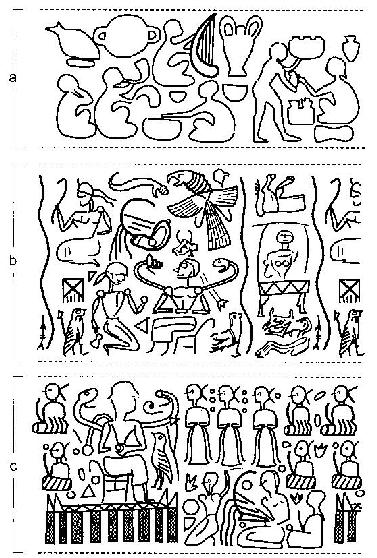

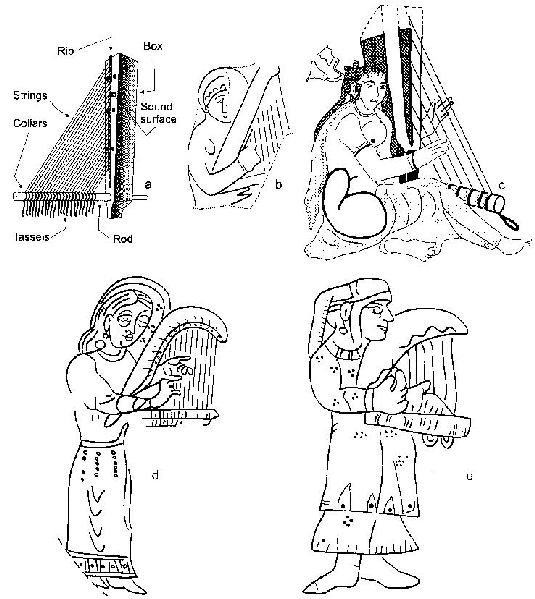
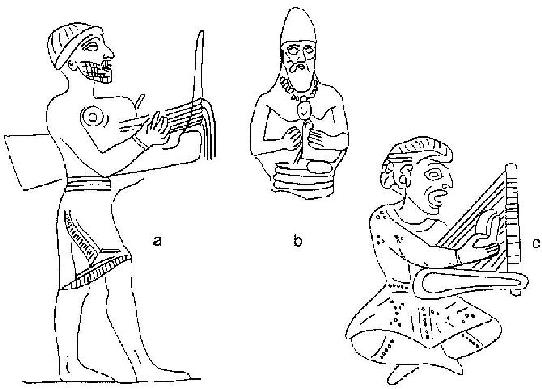
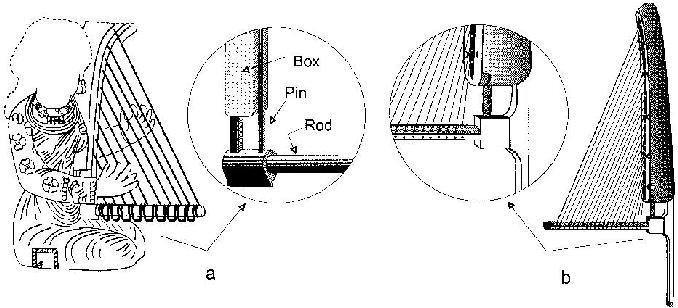

The Figure 5c. dancing terracotta figure is cognate with the narrative of नाचण्याचा फड A nach house in the following Meluhha expressions related to phaḍā a metals manufactory.
phaḍā related Meluhha expressions: फडा (p. 313) phaḍā f (फटा S) The hood of Coluber Nága &c. Ta. patam cobra's hood. Ma. paṭam id. Ka. peḍe id. Te. paḍaga id. Go. (S.) paṛge, (Mu.) baṛak, (Ma.) baṛki, (F-H.) biṛki hood of serpent (Voc. 2154). / Turner, CDIAL, no. 9040, Skt. (s)phaṭa-, sphaṭā- a serpent's expanded hood, Pkt. phaḍā- id. For IE etymology, see Burrow, The Problem of Shwa in Sanskrit, p. 45.(DEDR 47) Rebus: phaḍa फड ‘manufactory, company, guild, public office’, keeper of all accounts, registers.
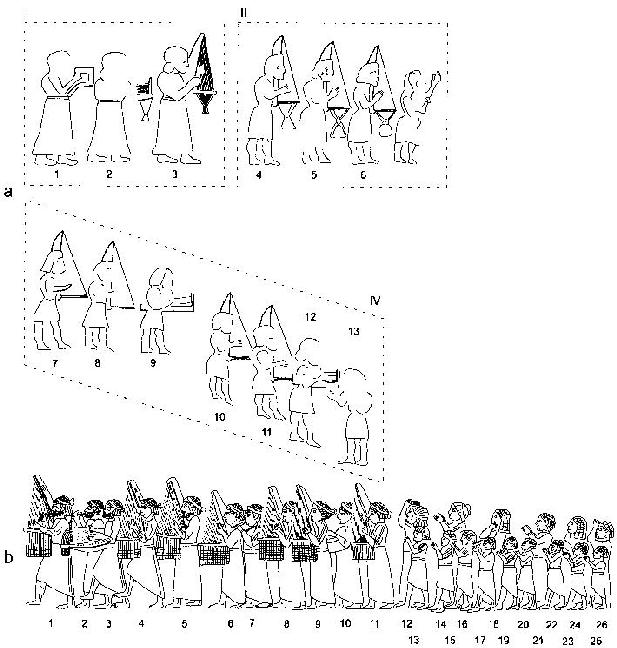
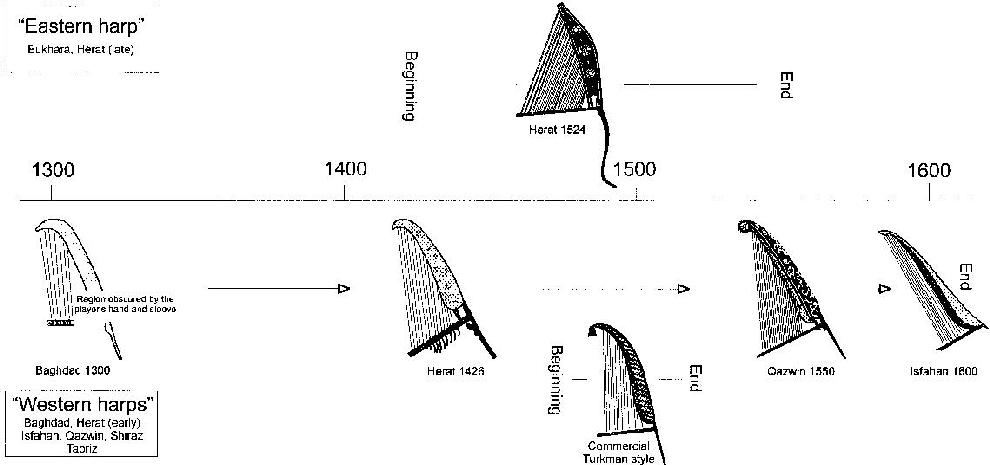
See: http://www.iranicaonline.org/articles/cang-harp ČANG “harp” (Pahl. čang, mentioned in Xusrō ī Kawādān ud rēdag, pars. 62-63), a musical instrument of the free-stringed family. By Ḥosayn-ʿAlī Mallāḥ, 1990. "The oldest known harps are arched like a bow with a sound box added to the lower end. The oldest record of an arched harp in Persia is an engraving on a seal datable to 3400 b.c. found at Čoḡā Mīš in Ḵūzestān during excavations by Helen J. Cantor and Pinhas P. Delugaz in 1961-66 (Figure 55)...The instrument mentioned as čangby Rīāḥī (p. 25) is a lyre (tanbūra), called čang by the Baluch. In Afghanistan and Tajikistan čang designates a type of santūr. In Georgia harps are called čangī and six types are in use, four rectangular and two acute-angled..."
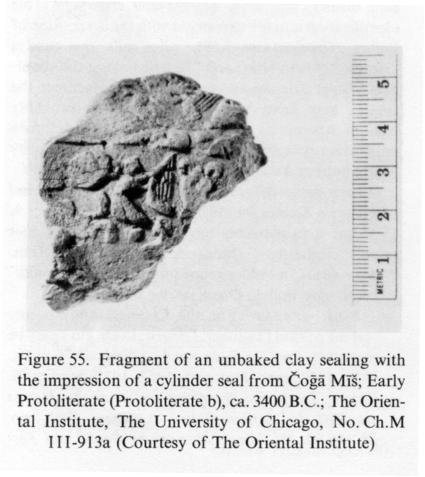

Sumerian bas relief depicting musicians playing various instruments. The steatite relief was excavated at ancient Adab, a city of ancient Sumer. The bas relief dates back to around 3000 BC. There are two harp players, a drummer, a trumpet player, and a conducter with a leaf baton.
http://www.bible-history.com/studybible/Genesis/4/8/
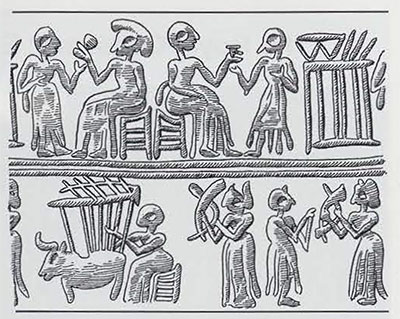
Mosaic panel (the 'Royal Standard of Ur') from Ur, ca. 2450 BCE (Rashid 1984: 45 Abb.12; Woolley 1934: pl. 91)
/detail-of-the-standard-of-ur-showing-a-sumerian-harpist-and-a-ruler-about-2600-2400-bc-501585375-589b3c525f9b5874eedd992b.jpg)
The association of 'harp' with a one-horned young bull is seen on this frieze from Ur. kundār ‘young bull' rebus: kundār ‘turner’ kundaṇa 'fine gold'.

From the Standard of Ur.


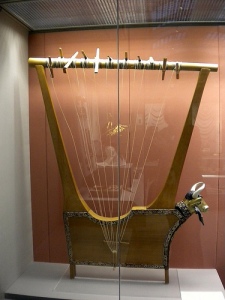

Bull-headed harp with inlaid sound box, from the tomb of Pu-abi (tomb 800), Royal Cemetery, Ur (modern Tell Muqayyar), Iraq, ca. 2600-2400 BCE. Wood, gold, lapis lazuli, red limestone, and shell, 3′ 8 1/8″ high. British Museum, London.

Sound box of the bull-headed harp from tomb 789 (“King’s Grave”), Royal Cemetery, Ur (modern Tell Muqayyar), Iraq,ca. 2600-2400 BCE. Wood, lapis lazuli, and shell, 1′ 7″ high. University of Pennsylvania Museum of Archaeology and Anthropology, Philadelphia.
"Great Lyre" from Ur: Ht 33 cm. 2550 - 2400 BCE, royal tomb at Ur (cf. pg. 106 of J. Aruz and R. Wallenfels (eds.) 2003 Art of the First Cities).
Great Lyre from the "King's Grave" (left)
and Detail of Front Panel of the Great Lyre from the "King's Grave" (right)
Ur, Iraq, ca. 2650–2550 B.C.
Gold, silver, lapis lazuli, shell, bitumen, and wood
Height: 35.6 cm (head), 33 cm (plaque)
PG 789; B17694 (U.10556)
University of Pennsylvania Museum of Archaeology and Anthropology
"The figures featured on the sound box of the harp are shell and red limestone and are seperated by registers. The bottom register features a scorpion-man in composite and a gazelle bearing goblets. Above them are an ass playing the harp, ajackal playing the zither and a bear steadying the harp or dancing. The second register from the top has a dog wearing a dagger and carrying a laden table with a lion bringing the beverage service. The uppermost register features the hero, also in composite, embracing two man-bulls in a heraldic composition. The meaning behind the sound box depictions is unclear but could be of funerary significance, suggesting that the creatures inhabit the land of the dead and the feast is what awaits in the afterlife. In any case, the sound box provides a very early specimen of the depiction of animals acting as people that will be found throughout history in art and literature."
https://klimtlover.wordpress.com/mesopotamia-and-persia/mesopotamia-and-persia-sumerian-art/
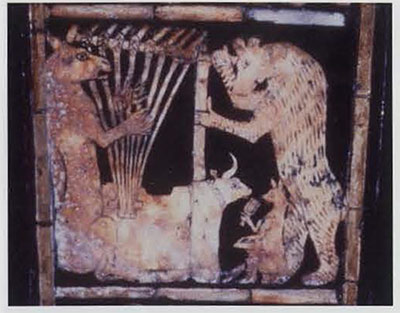
 Othmar Keel (2009) "Othmar Keel's scientific work exploring the links between the imagery of the Ancient Near East and the Bible and the religious history of Palestine / Israel...In his biblical studies, he has shown how the pictorial symbolism of ancient oriental cultures can serve as a key to the understanding of Old Testament texts (eg, High Song , Gospel in the Book of Job , YHWH Visions in the Books of Isaiah , Ezekiel and Zechariah )." An announcement on 24 Oct 2017 08:40 AM PDT referred to a newly added title to Orbis Biblicus et Orientalis Online
Othmar Keel (2009) "Othmar Keel's scientific work exploring the links between the imagery of the Ancient Near East and the Bible and the religious history of Palestine / Israel...In his biblical studies, he has shown how the pictorial symbolism of ancient oriental cultures can serve as a key to the understanding of Old Testament texts (eg, High Song , Gospel in the Book of Job , YHWH Visions in the Books of Isaiah , Ezekiel and Zechariah )." An announcement on 24 Oct 2017 08:40 AM PDT referred to a newly added title to Orbis Biblicus et Orientalis Online- Images as Sources: Studies on ancient Near Eastern artefacts and the Bible inspired by the work of Othmar Keel. Edited by: Bickel, Susanne; Schroer, Silvia; Schurte, René; Uehlinger, Christoph (2007). Fribourg, Switzerland / Göttingen, Germany: Academic Press / Vandenhoeck & Ruprecht.
On Figures 14, 15, and 16, onagers are signified as harp-players, performing in presence of a lion. The Indus Script hypertext readings: arye'lion' rebus: ara'brass'khar 'ass, onager' (Kashmiri) rebus: khār खार् 'blacksmith' A phonetic determinative: kora 'harp'.
On harp-playing onager on the lyre it is noted by Brent A. Strawn & Joel M. LeMon, that an onager as harp-player. On the hieroglyphs, deployed a one-horned young bull is also shown in the presence of a jackal. कोला (p. 105) kōlā m (Commonly कोल्हा) A jackal. For compounds see under कोल्हे. कोल्हा (p. 105) kōlhā m A jackal, Canis aureus. Linn. कोल्ही (p. 105) kōlhī A she-jackal.कोल्हें (p. 105) kōlhēṃ n A jackal. Without reference to sex. Pr. अडलें कोल्हें मंगळ गाय Even the yelling jackal can sing pleasantly when he is in distress. कोल्हें लागलें Applied to a practical joke. कोल्हेभूंक (p. 105) kōlhēbhūṅka or -भोंक f (कोल्हा & भुंकणें To bark.) The yelling of jackals. 2 Early dawn; peep of day. rebus: kolhe 'smelter' kol 'working in iron' kolle 'blacksmith' kole.l 'smithy, forge' kole.l 'temple'.
In the bottom register, a scorpion-man is shown. bici 'scorpion' rebus: bica 'haematite, ferrite ore'.
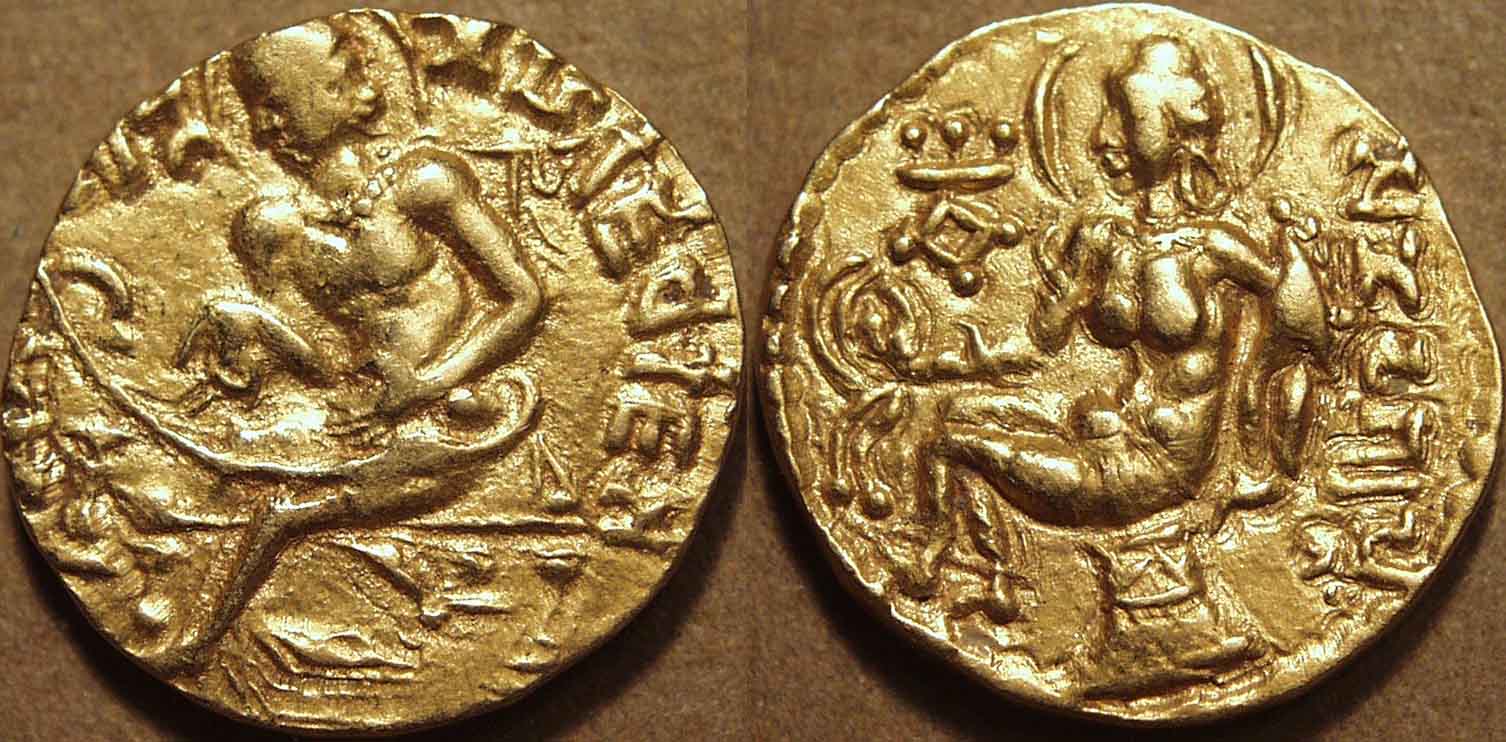
Weight: 7.85 gm, Diameter: 20 mm.
King seated left on a couch, playing the vina
circular Brāhmī legend around /
Lakshmi seated left on a stool, holding a cornucopia and diadem,
Brāhmī legend at right: Samudraguptah
This variety has a tamgha in front of Lakshmi's face and no letter below the king's couch.


Second dynasty of Lagash, reign of Gudea, c. 2120 BC
Tello (ancient Girsu)
Limestone
H. 1.20 m; W. 0.63 m; D. 0.25 m
E. de Sarzec excavations, 1881
AO 52
The building of Ningirsu's temple
Music in temple foundation ceremonies
When the work was complete, Ushumgalkalamma went before Gudea, leading all the musical instruments, to mark the arrival of the god in his new abode. Ushumgalkalamma is the god's counselor because its song calms the emotions that disturb the spirit, allowing the return of the reason indispensable to good judgement. Among the divine servants of Ningirsu, it is the lyre's duty to charm his master, a god of changeable mood. It is assisted by the spirit of another lyre that brings consolation in times of darkness: "So that the sweet-toned tigi-drum should play, so that the instruments algar and miritum should resound for Ningirsu, [...] his beloved musician Ushumgalkalamma accomplished his duties to the lord Ningirsu. To soothe the heart and calm the liver [the seat of thought], to dry the tears of weeping eyes, to banish grief from the grieving heart, to cast away the sadness in the heart of the god that rises like the waves of the sea, spreads wide like the Euphrates, and drowns like the flood of the storm, his lyre Lugaligihush accomplished his duties to his lord Ningirsu."
Representations of musicians in Mesopotamia
Bibliography
André-Salvini Béatrice, "Stèle de la musique", in Musiques au Louvre, Paris, Éditions de la Réunion des musées nationaux, 1994, pp. 10-11.Parrot André, Tello, vingt campagnes de fouilles, 1877-1933, Paris, Albin Michel, 1948, pp. 174-176, pl. 20a.
Rutten Marguerite-Maggie, "Scènes de musique et de danse", in Revue des arts asiatiques, Paris, École française d'Extrême-Orient, 1935, p. 220, fig. 8.
Sarzec Édouard de, Découvertes en Chaldée, Paris, Leroux, 1884-1912, pp. 36 et 219-221, pl. 23.
Sillamy Jean-Claude, La Musique dans l'ancien Orient ou la théorie musicale suméro-babylonienne, Villeneuve d'Ascq, Presses universitaires du Septentrion, 1998, p. 160. [unquote]
Music stele: tanbūra, tambura 'lyre' Rebus: tambra 'copper' (Santali) ḍangar ‘bull’; rebus: ḍangar‘blacksmith’ (Hindi)
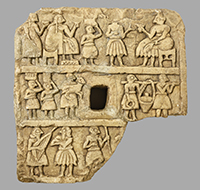 Banquet plaque. The top register of this plaque shows a seated man and woman celebrating an unidentified event or ritual by participating in a banquet. Two servants attend them while others bring a jar (probably filled with beer), an animal to be slaughtered, and other edibles carried in bundles on their heads. Musicians and dancers in the bottom register add to the festivities.
Banquet plaque. The top register of this plaque shows a seated man and woman celebrating an unidentified event or ritual by participating in a banquet. Two servants attend them while others bring a jar (probably filled with beer), an animal to be slaughtered, and other edibles carried in bundles on their heads. Musicians and dancers in the bottom register add to the festivities.


http://realhistoryww.com/world_history/ancient/Sumer_Iraq_1.htm

The ‘Boat-Shaped’ Lyre Restudy of a Unique Musical Instrument from Ur By: Maude de Schauensee Expedition, Volume 40, Issue 2
 Composition of two horned animals, sitting human playing a four-string musical instrument, a star and a moon.
Composition of two horned animals, sitting human playing a four-string musical instrument, a star and a moon.Hieroglyph: A. damrā ʻ young bull ʼ, dāmuri ʻ calf ʼ; B. dāmṛā ʻ castrated bullock ʼ; Or. dāmaṛī ʻ heifer ʼ, dāmaṛiā ʻ bullcalf, young castrated bullock ʼ, dāmuṛ, °ṛi ʻ young bullock ʼ.Addenda: damya -- : WPah.kṭg. dām m. ʻ young ungelt ox ʼ.damya ʻ tameable ʼ, m. ʻ young bullock to be tamed ʼ Mn. [~ *
tagara 'antelope'. Rebus 1: tagara 'tin' (ore) tagromi 'tin, metal alloy' (Kuwi) dhangar 'bull' Rebus 2: damgar 'merchant'. dhangar 'blacksmith'
*dab ʻ a noise ʼ. [Onom.]P. dabaṛ -- dabaṛ ʻ with the sound of heavy and noisy steps ʼ; N. dabdab ʻ mud ʼ; H. dabdabā m. ʻ noise ʼ; M. dabdab ʻ noise of a slack drum ʼ.(CDIAL 6170)
Hieroglyph: harp: tambur
The rebus reading of hieroglyphs are: తంబుర [tambura] or
Thus the seal connotes a merchant of copper.





 "These exchanges would have led to lengthy arguments carried out in various dialects. At best, the deals ended in banquets and at worst, in blood feuds. History abounds with trade arguments leading to wars. A bloody massacre such as that at Tell Brak would have led to the antagonists finding ways to appease tension during negotiations. Urukeans developed one of the most subtle and ancient arts as a possible solution. This is substantiated by the emergence of harps fitted with three or four strings, as depicted on a fourth millennium seal impression from Choga Mish, east of Uruk in Elam, in modern south-west Iran (Fig. 3). The seal depicts a four-string arched harp played by a seated person, while two others beat a drum, a bowl-drum and clappers. (Dubé, L.; Chebat, J.-C.; Morin, S., ‘The effects of background music on consumers desire to affiliate in buyer-seller interactions.’ Psychology and Marketing. Vol. 12/4. Published by Wiley-Blackwell (1995) pp. 305-319.)As early as the fourth millennium, Urukeans would have discovered that harp music could unite people, allowing them to share feelings and emotions that they could otherwise only have experienced individually. This was the primary function of the harp: the music it produced would have facilitated the exchange of goods. From the beginning it promoted equal understanding; in other words, ‘all were in tune’. From then on, owing to the fact that the harp was a remarkable mediator, music would have been included in communication procedures between different communities, changing people’s mindset and developing empathy between them. Being the first to understand that music could have a significantly smoothing effect on those that listened to it, Urukeans found that it could also affect protagonists during negotiations. If music cannot change the product itself, it can unconsciously act favourably on the customer’s mood. The smoothing effect of the harp on bad tempers, and its contribution to emotional reactions, would have meant that the instrument had high status, from dawn to dusk. The harp was found in potters’ and weavers’ workshops, on goods barges, in banquets (Fig. 6) and even during sexual intercourse (Fig. 4-B). The Urukeans’ pride in their invention was so great that they engraved it on cylinder seals; in its silent manifestation, it sounded to the inner ears of those looking at its impression on seals and tablets. On tablets it was denoted by the Sumerian words BAN.TUR, BAN meaning ‘bow’ and TUR meaning ‘small’, hence harp, and the Sumerogram BALAG, voiced as the onomatopoeic ‘dubdub’, a word echoing the sound of the object it depicts. Around 3,300 to 3,000 BCE, the pictogram with which it is associated clearly depicted a harp with three or four strings (Fig. 4) (Dumbrill, R. (1998). Période au cours de laquelle les cités-États sont en guerre.)." https://www.theoriesensorielle.com/analogy-between-the-urukean-harp-and-the-auditory-system/
"These exchanges would have led to lengthy arguments carried out in various dialects. At best, the deals ended in banquets and at worst, in blood feuds. History abounds with trade arguments leading to wars. A bloody massacre such as that at Tell Brak would have led to the antagonists finding ways to appease tension during negotiations. Urukeans developed one of the most subtle and ancient arts as a possible solution. This is substantiated by the emergence of harps fitted with three or four strings, as depicted on a fourth millennium seal impression from Choga Mish, east of Uruk in Elam, in modern south-west Iran (Fig. 3). The seal depicts a four-string arched harp played by a seated person, while two others beat a drum, a bowl-drum and clappers. (Dubé, L.; Chebat, J.-C.; Morin, S., ‘The effects of background music on consumers desire to affiliate in buyer-seller interactions.’ Psychology and Marketing. Vol. 12/4. Published by Wiley-Blackwell (1995) pp. 305-319.)As early as the fourth millennium, Urukeans would have discovered that harp music could unite people, allowing them to share feelings and emotions that they could otherwise only have experienced individually. This was the primary function of the harp: the music it produced would have facilitated the exchange of goods. From the beginning it promoted equal understanding; in other words, ‘all were in tune’. From then on, owing to the fact that the harp was a remarkable mediator, music would have been included in communication procedures between different communities, changing people’s mindset and developing empathy between them. Being the first to understand that music could have a significantly smoothing effect on those that listened to it, Urukeans found that it could also affect protagonists during negotiations. If music cannot change the product itself, it can unconsciously act favourably on the customer’s mood. The smoothing effect of the harp on bad tempers, and its contribution to emotional reactions, would have meant that the instrument had high status, from dawn to dusk. The harp was found in potters’ and weavers’ workshops, on goods barges, in banquets (Fig. 6) and even during sexual intercourse (Fig. 4-B). The Urukeans’ pride in their invention was so great that they engraved it on cylinder seals; in its silent manifestation, it sounded to the inner ears of those looking at its impression on seals and tablets. On tablets it was denoted by the Sumerian words BAN.TUR, BAN meaning ‘bow’ and TUR meaning ‘small’, hence harp, and the Sumerogram BALAG, voiced as the onomatopoeic ‘dubdub’, a word echoing the sound of the object it depicts. Around 3,300 to 3,000 BCE, the pictogram with which it is associated clearly depicted a harp with three or four strings (Fig. 4) (Dumbrill, R. (1998). Période au cours de laquelle les cités-États sont en guerre.)." https://www.theoriesensorielle.com/analogy-between-the-urukean-harp-and-the-auditory-system/See:
Dumbrill, R., ‘Appendix.’ A Queen’s Orchestra at the Court of Mari: New Perspectives on the Archaic Instrumentarium in the Third Millenium. M. Marcetteau. ICONEA Proceedings 2008 (2008) pp. 73-75.
Dumbrill, R., ‘Harps.’ The Archaeomusicology of the Ancient Near East. Trafford Publishing (2005) pp. 179-226.
Dumbrill, R., Götterzahlen and Scale Structure (1997).
Dumbrill, R., ‘Music Theorism in Ancient World.’ ICONEA Proceeding 2009-2010 (2010) pp. 107-132.




 [quote]Harps from Uruk and Djemdet Nasr were generally monoxyle or monostructural, meaning that there was no distinction between the soundbox and the part which would become the yoke, or the neck. They would have been made from gourds or calabashes, the natural shape of which were appropriate for this. It is possible that they were domesticated through simple cultivation techniques which made them grow in the shape of musical instruments. 6The dried fruit was hollowed out from an oval opening, which was then covered with a soundboard made from damp sheep, pig or calf raw hide. It was stretched at the back with wet hide strands. The strings were made from fresh twisted gut or vegetal fibres. A sliver of wood was tied at the end of each string, to prevent it slipping out of the soundboard during tuning. The upper ends of the strings were tied to a strip of woven material rolled around the neck, to ensure tuning by friction (Fig. 5-left). At that time, and especially towards the end of the fourth millennium, the size of soundboxes progressively increased while necks became thinner. Gourds and calabashes would still have been used for soundboxes, but necks would now be made of wood into which the Urukeans would later have plugged tuning pegs to ensure the tension of the strings (Fig. 5-right). Fourth millennium harps would have been small, with probably no more than three strings, stretched over a plan of around 110 degrees determined by the angle of the soundbox in relation to the neck. This suggests an anhemitonic disposition with a span of no more than a musical fifth, possibly including a third. These harps were always depicted in rural scenes, surrounded by animals, but with no reference to religious rituals; practical usage was thus implied, as is clearly shown on cylinder seals. However, from the third millennium onwards, harps were always shown in scenes depicting Inanna, the guardian Goddess of Uruk; they even symbolised her. Some texts record Inanna’s animals and her attributes, which included the reed, the palm, the aster Venus, and the harp itself.
[quote]Harps from Uruk and Djemdet Nasr were generally monoxyle or monostructural, meaning that there was no distinction between the soundbox and the part which would become the yoke, or the neck. They would have been made from gourds or calabashes, the natural shape of which were appropriate for this. It is possible that they were domesticated through simple cultivation techniques which made them grow in the shape of musical instruments. 6The dried fruit was hollowed out from an oval opening, which was then covered with a soundboard made from damp sheep, pig or calf raw hide. It was stretched at the back with wet hide strands. The strings were made from fresh twisted gut or vegetal fibres. A sliver of wood was tied at the end of each string, to prevent it slipping out of the soundboard during tuning. The upper ends of the strings were tied to a strip of woven material rolled around the neck, to ensure tuning by friction (Fig. 5-left). At that time, and especially towards the end of the fourth millennium, the size of soundboxes progressively increased while necks became thinner. Gourds and calabashes would still have been used for soundboxes, but necks would now be made of wood into which the Urukeans would later have plugged tuning pegs to ensure the tension of the strings (Fig. 5-right). Fourth millennium harps would have been small, with probably no more than three strings, stretched over a plan of around 110 degrees determined by the angle of the soundbox in relation to the neck. This suggests an anhemitonic disposition with a span of no more than a musical fifth, possibly including a third. These harps were always depicted in rural scenes, surrounded by animals, but with no reference to religious rituals; practical usage was thus implied, as is clearly shown on cylinder seals. However, from the third millennium onwards, harps were always shown in scenes depicting Inanna, the guardian Goddess of Uruk; they even symbolised her. Some texts record Inanna’s animals and her attributes, which included the reed, the palm, the aster Venus, and the harp itself.
"An initial comparison can now be made between the neck of the harp and the basilar membrane (BM). The tuning pegs, around which the strings are wound and then driven into the neck, are comparable to the basilar membrane where Deiters cells are attached, and to which one of the ends of the outer hair cells (OHCs) is affixed. The neck is an essential part, because all the components of a harp rest on it, directly or indirectly. The functional importance of the basilar membrane is equally critical, because the various elements constituting the organ of Corti, again directly or indirectly, are attached to it. The harpist plucks the strings with greater or lesser intensity, his fingers complementing the work of the neck which the musician holds against his chest with his palm. Similarly, the sound vibrations transmitted by the perilymph generate upward and downward movements of the basilar membrane, at a precise location, resulting in the outer hair cells vibrating more or less intensely. As with the neck, the basilar membrane remains motionless right along the organ of Corti (Fig. 11-left)." https://www.theoriesensorielle.com/analogy-between-the-urukean-harp-and-the-auditory-system/
The Sensory Theory Coding and Treatment of Sensory Information by the Brain
About the book (blurb translated from French) AN ARCHEOLOGY OF SENSORY PERCEPTION

![chapitre 1]() Chapitre 1
Chapitre 1
Origines: Levant, Mésopotamie
ANALOGY BETWEEN THE URUKEAN HARP AND THE AUDITORY SYSTEM
le 8 janvier 2014 | par Philippe Roi et Tristan GirardBy Philippe Roi(1), Tristan Girard(2), Richard Dumbrill(3), Michel Leibovici(4)
With the participation of Paul Avan(5)
Anahata Nada Brahman Unstruck sound as Brahman, this OM = Praṇava, which is also the Setu which joins svarga and pr̥thivī
अन्-ाहत mfn. unbeaten , unwounded , intact; produced otherwise than by beating; n. the fourth of the mystical चक्रस् , or circles of the body.
| कालिका-पुराण औ the सेतु or sacred syllable of the शूद्रs , Ka1lika1P. ?? ([ T. ]) औम् ind. the sacred syllable of the शूद्रs (» 3. औ) in RV. ix , 20 , 12, the शूद्र is said to have been born from the feet of पुरुष q.v. ; in Mn. i , 87 he is fabled to have sprung from the same part of the body of ब्रह्मा , and he is regarded as of higher rank than the present low and mixed castes so numerous throughout India ; केवल-श्° , a pure शूद्र) RV. &c kēvala केवल -आत्मन् a. one whose essence is absolute unity; नमस्त्रिमूर्तये तुभ्यं प्राक्सृष्टेः केवलात्मने Ku.2.4.केवला* त्मन् mfn. one whose nature is absolute unity Kum. ii , 4. |
Atharva Veda ( X - 7,8) --- Skambha Suktam provides some hints while the origins of the worship of the Shiva-Linga as a Fiery Pillar of Light and Flames, are unknown.
Shiva-Linga has one complete purana which is dedicated to its form and origin. It may be a symbolic representation of self (Atma Linga) or of everything. Some associate it with the physical form of Pranava (Om). Oval form represents even the shape of the Universe including the existing space. The beginning of the oval form is A in OM and prolonged part is U in OM and M is the ending part of the linga. It is single shape of Trimurti. Praying Shiva Linga is considered as praying the Thrimurti in absolute form. Linga represents absolute and Single power of this universe. Some associate them with the famous hymn in the Atharva-Veda Samhitâ sung in praise of the Yupa-Stambha, the sacrificial post. In that hymn a description is found of the beginningless and endless Stambha or Skambha and it is shown that the said Skambha is put in place of the eternal Brahman. As afterwards the Yajna (sacrificial) fire, its smoke, ashes and flames, the Soma plant and the ox that used to carry on its back the wood for the Vedic sacrifice gave place to the conceptions of the brightness of Shiva's body, his tawny matted-hair, his blue throat and the riding on the bull of the Shiva. The Yupa-Skambha gave place in time to the Shiva-Linga. In the Linga Purâna the same hymn is expanded in the shape of stories, meant to establish the glory of the great Stambha and the superiority of Mahâdeva.
In the context of Hindu mythology, stambha, also spelt as Skambha, is believed to a cosmic column. It is believed that the stambha functions as a bond, which joins the heaven (Svarga) and the earth (prithvi). A number of Hindu scriptures, including the Atharva Veda, have references to stambha. In the Atharva Veda, a celestial stambha has been mentioned, and that has been described as a scaffold, which supports the cosmos and material creation. http://bharatkalyan97.blogspot.in/2014/12/skambha-sukta-atharva-veda-x-7-pair-of.html |
औम mf(ई)n. (fr. उमा) , made of flax , flaxen Pa1n2. 4-3 , 158.; mfn. relating to the goddess उमा , Para1s3.(Monier-Williams).
![Carved stone tablets with the inscription Om syllables from Om Mani Padme Hum mantra - Everest region, Nepal, Himalayas]() Carved stone tablets with the inscription Om syllables from Om Mani Padme Hum mantra - Everest region, Nepal, Himalayas
Carved stone tablets with the inscription Om syllables from Om Mani Padme Hum mantra - Everest region, Nepal, Himalayas
OM is a direct path: Remembering the sound vibration of AUM (or OM), along with a deep feeling for the meaning of what it represents (1.28), brings both the realization of the individual Self and the removal of obstacles that normally block that realization (1.29). In a sense, this practice is like a short cut, in that it goes directly to the heart of the process. Systematically piercing the levels: This practice takes one on a direct route inward, systematically piercing the levels of consciousness. It is done with sincerity and dedication (1.23) towards the untainted creative source or pure consciousness (1.24), which AUM represents (1.27). That consciousness contains the seed of omniscience (1.25), which is the source of the teachings of all the ancient sages (1.26).Remember the meaning: For it to have its effect, the sound of AUM is remembered with deep feeling for the meaning of what it represents. (1.28)Yoga Sutras 1.23-1.29:
Contemplation on AUM (or OM)
1.23 (ishvara pranidhana va)
- ishvara = creative source, pure consciousness, purusha, God, supreme Guru or teacher
- pranidhana = practicing the presence, sincerity, dedication, devotion, surrender of fruits of practice
- va = or
OM and the 7 Levels of Consciousness
OM and 7 Methods of Practice
1.24 (klesha karma vipaka ashayaih aparamristah purusha-vishesha ishvara
- klesha = colored, painful, afflicted, impure; the root klish means to cause trouble
- karma = actions,
- vipaka = fruits of, maturing, ripening
- ashayaih = by the vehicles, resting place, storage of traces, propensities, accumulations
- aparamristah = untouched, unsmeared
- purusha-vishesha = a consciousness, a special or distinct purusha (purusha = a consciousness; vishesha = special, distinct)
- ishvara = creative source, God, supreme Guru or teacher1.26 From that consciousness (ishvara) the ancient-most teachers were taught, since it is not limited by the constraint of time.
(purvesham api guruh kalena anavachchhedat)
- purvesham = of the first, former, earlier, ancient
- api = too, also
- guruh = teacher
- kalena = by time
- anavachchhedat = not limited by (time), no break or division, continuous
1.25 (tatra niratishayam sarvajna bijam)
- tatra = there, in that (in that special purusha)
- niratishayam = unsurpassed, not exceeded by any others, limitless
- sarvajna = all knowing (sarva = all; jna = knowing)
- bijam = seed
1.26 (purvesham api guruh kalena anavachchhedat)
- purvesham = of the first, former, earlier, ancient
- api = too, also
- guruh = teacher
- kalena = by time
- anavachchhedat = not limited by (time), no break or division, continuous
1.27 The sacred word designating this creative source is the sound OM, called pranava.
1.27 (tasya vachakah pranavah)
- tasya = of that
- vachakah = designator, signifier, indicator, term
- pranavah = the mantra AUM or OM
1.28 (tat japah tat artha bhavanam)
- tat = its
- japah = repeated remembrance
- tat = its
- artha = meaning
- bhavanam = understanding with feeling, absorbing, dwelling upon
1.29 (tatah pratyak chetana adhigamah api antaraya abhavash cha)
- tatah = thence
- pratyak = individual
- chetana = consciousness
- adhigamah = understanding, realization, attainment
- api = also
- antaraya = of obstacles or impediments
- abhavash = absence, disappearance, removal
- cha = and, also
http://www.swamij.com/yoga-sutras-12329.htm
 ROM accession number 994.233.17, is made of serpentine and is 3.5 x 2.2 cm. It dates to the Akkadian period in Mesopotamia (about 2200 BCE). Royal Ontario Museum.The seal depicts a typical contest scene: a nude bearded hero fights a bull while a lion fights a bearded bull-man. The inscription identifies the seal's owner as "Shu-ili-su, the beer-maker".
ROM accession number 994.233.17, is made of serpentine and is 3.5 x 2.2 cm. It dates to the Akkadian period in Mesopotamia (about 2200 BCE). Royal Ontario Museum.The seal depicts a typical contest scene: a nude bearded hero fights a bull while a lion fights a bearded bull-man. The inscription identifies the seal's owner as "Shu-ili-su, the beer-maker". 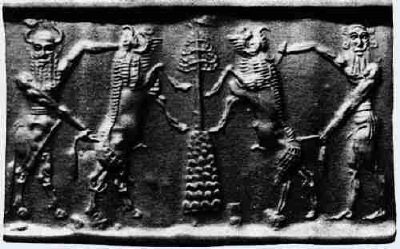

smiths. (Thus, this pictorial motif of leaf on summit is a phonetic determinant of the two glyptic motifs on either side).
(Skt.)]
off, stalks of certain plants, as Indian corn, after the grain has been taken off (Santali)
Ku. luwā, N. lohu, °hā, A. lo,B. lo, no, Or. lohā, luhā,Mth. loh, Bhoj. lohā, Aw.lakh.lōh, . loh, lohā m.,G. M. loh n.; Si. loho, lō ʻmetal, ore, iron ʼ; Md. ratu -- lō ʻ copper ʼ. *lōhala -- , *lōhila --, *lōhiṣṭha -- , lōhī -- , laúha -- ; lōhakāra -- , *lōhaghaṭa -- , *lōhaśālā-- , *lōhahaṭṭika -- , *lōhōpaskara -- ; vartalōha -- . Addenda: lōhá --: WPah.kṭg. (kc.) lóɔ ʻ iron ʼ, J. lohā m.,
kāra -- 1] Pa. lōhakāra --m. ʻ coppersmith, ironsmith ʼ; Pk. lōhāra -- m. ʻ blacksmithʼ, S. luhā̆ru m., L. lohār m., °rī f.,awāṇ. luhār, P. WPah.khaś. bhal. luhār m.,Ku. lwār, N. B. lohār, Or. lohaḷa, Bi.Bhoj.Aw.lakh. lohār, H. lohār, luh° m.,G. lavār m., M. lohār m.; Si. lōvaru ʻcoppersmith ʼ. Addenda: lōhakāra-- : WPah.kṭg. (kc.) lhwāˋr m. ʻ blacksmith ʼ, lhwàri f.ʻ his wife ʼ, Garh. lwār m. (CDIAL 11159)
Cylinder seal and modern impression: nude bearded hero wrestling with a water buffalo; bull-man wrestling with lion
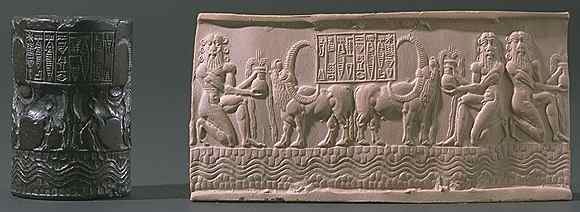
Sumerian cylinder seal line markings written in Akkadian (approx. 2250 BC, Louvre, Paris)

Gilgamesh and Enkidu struggle of the celestial bull and the lion (cylinder seal-print Approx. 2,400 BC, Walters Art Gallery, Baltimore)
a tiger, a fox on leashes held by a man kol 'tiger' Rebus: kol 'working in iron, alloys' lo ‘fox’ (WPah.) Rebus: lōha ʻmetalʼ (Pali)
a procession of boars (rhinoceros?) and tiger in two rows kāṇṭā 'rhinoceros. Rebus: āṇḍa ‘tools, pots and pans and metal-ware’ (Gujarati)
3. a stalk/twig, sprout (or tree branch) kūdī,kūṭī bunch of twigs (Sanskrit) Rebus: kuṭhi ‘smelting furnace‘(Santali)
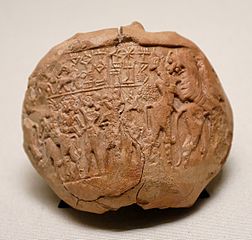 Cylinder seal impression.
Cylinder seal impression.Lugalanda, the dethroned monarch Lagas Seal (but Sarzec collection, Paris, Louvre)
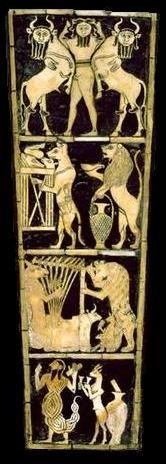 "Great Lyre" from Ur: Ht 33 cm. 2550 - 2400 BCE, royal tomb at Ur (cf. pg. 106 of J. Aruz and R. Wallenfels (eds.) 2003 Art of the First Cities).
"Great Lyre" from Ur: Ht 33 cm. 2550 - 2400 BCE, royal tomb at Ur (cf. pg. 106 of J. Aruz and R. Wallenfels (eds.) 2003 Art of the First Cities).


 Girdled nude hero attacking water buffalo; bull-man attacking lion; inscription. Kafaje, Akkadian.c. 2300 BCE, Iraq Museum, Baghdad. From a cylinder seal, in wo narrative frames flanking a star metonymy (Afer Fig. 1d in http://www.destiner.com/destiner_titles_dark_sect01_me.html)
Girdled nude hero attacking water buffalo; bull-man attacking lion; inscription. Kafaje, Akkadian.c. 2300 BCE, Iraq Museum, Baghdad. From a cylinder seal, in wo narrative frames flanking a star metonymy (Afer Fig. 1d in http://www.destiner.com/destiner_titles_dark_sect01_me.html)Seven bangles are depicted on the left arm and six on the right, with the hands resting on the knees. The heels are pressed together under the groin and the feet project beyond the edge of the throne. The feet of the throne are carved with the hoof of a bovine as is seen on the bull and unicorn seals. The seal may not have been fired, but the stone is very hard. A grooved and perforated boss is present on the back of the seal.
Material: tan steatite Dimensions: 2.65 x 2.7 cm, 0.83 to 0.86 thickness Mohenjo-daro, DK 12050
Islamabad Museum, NMP 50.296 Mackay 1938: 335, pl. LXXXVII, 222
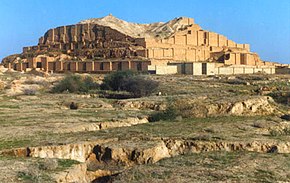

शोषिणी Ether. Fire is Shamash 'Sun divinity' celebrated on Sit Shamshi bronze and Mohenjo-daro śikhara, ziggurat
This is an addendum to:
Susa Sit Shamshi 'sunrise' is Vedic काण्डर्षि.tarpaṇam, purification by water & the Sun, veneration of ancestors http://tinyurl.com/qdny4v7

Sit Shamshi bronze model with a 60x40 cm base is a breathtaking narrative of an offering made at sunrise.
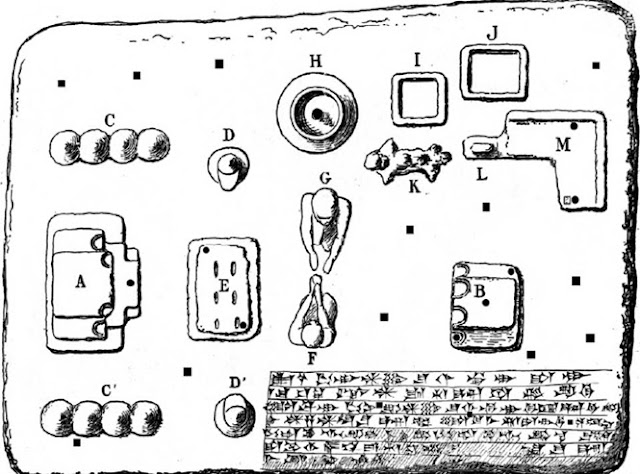
From one hand, I would like to discuss the interpretation of sit shamshi as an Akkadian syntagm, considering that the inscription is written in Elamite and that sit e sham- are also known as Elamite terms. On the other hand, I would like to have feedback from scholars skilled in ritual texts from Mesopotamia, trying also to understand if there is some further element in support of the sunrise ritual interpretation.
A ceremony
Chogha Zambil: a religious capital
The royal art of the Middle-Elamite period
kolmo 'three'; rebus; kolami 'smithy' (Telugu)
Annex
Sarasvati Research Centre
kárṇaka 'helmsman' karṇika 'scribe, accountant' of Indus Script is Kernunnos venerated, adored as Tvaṣṭṛ triśiras, a horned artisan architect, metalworker smith
https://tinyurl.com/yav9oxk3
Kernunnos on the Pilier des Nautes (The Boatmen's pillar, Paris), Tvaṣṭṛ triśiras seal m304, Kernunnos on Gundestrup cauldron are seated in a yoga, penance posture. There are many Indus Script inscriptions which represent this penance of a seated person. These indus Script inscriptions are deciphered as metalwork catalogues, wealth-accounting ledgers in this monograph, consistent with the association of Kernunnos with wealth-acquisition.


Indus Script evidence Tvaṣṭṛ triśiras seal m304 is deciphered as wealth-accounting ledgers of metalwork catalogues. The text message of the seal includes
![]()
![]() read rebus in Meluhha, from r.: aya kárṇaka 'fish, rim-of-jar' rebus: ayas kárṇaka'alloymetal, helmsman' karṇika 'scribe, accountant'.
read rebus in Meluhha, from r.: aya kárṇaka 'fish, rim-of-jar' rebus: ayas kárṇaka'alloymetal, helmsman' karṇika 'scribe, accountant'.
This is the representation of the Gallic divinity Cernunnos on Pilier des Nautes (The Boatmen’s pillar, Paris) is juxtaposed to Indus seal m304.. The head of Cernunnos is bald and bearded, has animal ears and antlers, from which hang Celtic necklaces. Photo: A. Chauvet / C2RMF. Drawing by J.-P. Adam.
http://www.paris.culture.fr/en/ow_pilier.htm
The Celtic necklaces worn by kárṇaka'helmsman'karṇika'scribe, accountant' of Indus Script are two torcs which are ceramic stoneware bangles with Indus Script hypertexts as Dharma saṁjñā Corporate badges of Indus Script Corpora, ceramic (stoneware) bangles, seals, fillets http://tinyurl.com/hvuruj3
See for e.g. the stoneware bangle fragment m1647 with Indus Script inscription. ![]() m1647bangle
m1647bangle![]() Sign 87 dula ‘pair’; rebus dul ‘cast (metal)’
Sign 87 dula ‘pair’; rebus dul ‘cast (metal)’![]() Sign 342 karNI 'rim of jar' rebus: 'supercargo', 'engraver''helmsman'.
Sign 342 karNI 'rim of jar' rebus: 'supercargo', 'engraver''helmsman'.
Rebus: karNika 'Supercargo'' merchant in charge of cargo of a shipment, helmsman, scribe. Rebus kañiāra 'helmsman' karaṇī 'scribe'.
kárṇaka 'rim of jar' handle of vessel'
kaṇṭu = rim of a vessel; kaṇṭuḍiyo = a small earthen vessel
kaṇḍa kanka = rim of a water-pot; kan:kha, kankha = rim of a vessel rebus: kanda, kanduka 'trench, furnace'. I suggest that the torcs of Kernunnos (cognate kárṇaka) are conclusive archaeological evidence which trace Kernunnos to the received, remembered, venerated tradition of Tvaṣṭṛ triśiras (apart from complementary evidence from pictographs on Gundestrup Cauldron).Bronze-age metalwork technology transfers from ancient India to Japan & Slovakia are reinforced by Japanese and Slavic words. The word med 'copper' in Slavic languages is cognate meḍ 'iron' (Mu.Ho.Santali of Indian sprachbund, 'speech union'). tatara 'smelter' (Japanese) < ṭhaṭṭhāra 'brass worker' (Prākr̥tam) (< is indicated as a possibile transfer mode in language contacts for metalwork technical gloss.)
A remarkable lead in the inscription on the Pillar of Boatmen comes from the expression in an inscription on the Pilier des Nautes (The Boatmen's pillar, Paris): Senan[t] U[s]e[t]lo[n]i in reference to three young men with shields and spears; a group of three older, bearded men with spears and shields, bearing the inscription Eurises (Dedicants/donateurs); and a group of three figures, at least one of which is female. They are unarmed, dressed in flowing gowns.
The guild of sailors who donated the Pillar are paying a tribute to the traditions of ancient metalworkers and armourers.
The Boatmen's pillar
This Latin inscription can be translated as follows :
« To Tiberius Caesar Augustus, and to Jupitery kind, very great, the boatmen of the territory of the Parisii have erected this monument at their own expense. ».Photo: A. Chauvet / C2RMF. Drawing by J.-P. Adam

Photo: A. Chauvet / C2RMF. Drawing by J.-P. Adam

Photo: A. Chauvet / C2RMF. Drawing by J.-P. Adam.

Photo: A. Chauvet / C2RMF. Drawing by J.-P. Adam.

Photo: A. Chauvet / C2RMF. Drawing by J.-P. Adam.

Photo: A. Chauvet / C2RMF. Drawing by J.-P. Adam.



 This group is particularly noteworthy because it mixes images from the Greco-Roman pantheon, Celtic divinities and inscriptions highlighted in red ocher. The Boatmen's Pillar is one of the rare testaments to Gallic mythology that has come down to us.
This group is particularly noteworthy because it mixes images from the Greco-Roman pantheon, Celtic divinities and inscriptions highlighted in red ocher. The Boatmen's Pillar is one of the rare testaments to Gallic mythology that has come down to us.http://www.paris.culture.fr/en/ow_pilier.htm
Meluhha merchant, copper-, black-smith on Elamite standard Indus Script hypertext http://tinyurl.com/hj5mtxj
![Image result for elamite standard]()
![Image result for elamite standard]()
![Image result for elamite standard]() Meluhha merchant,shows an upraised arm; this signifies copper-, black-smith, mint-worker on Elamite standard with bangles on arms, scarf headdress.
Meluhha merchant,shows an upraised arm; this signifies copper-, black-smith, mint-worker on Elamite standard with bangles on arms, scarf headdress.
kárṇaka 'helmsman'
![]() The bearded person with upraised right arm seems to hold an antelope (or, fish-fin?) on his left arm, held close to his chest. karã̄ n. pl. wristlets, bangles Rebus: khār खार् 'blacksmith' (Kashmiri) Hieroglyph: mlekh 'goat' Rebus: milakkhu 'copper'mleccha 'copper'. meḷh ‘goat’ (Br.) Rebus: meḍho ‘one who helps a merchant’ vi.138 ‘vaṇiksahāyah’ (deśi. Hemachandra). meḍh ‘helper of merchant’ (Pkt.) meṛha, meḍhi ‘merchant’s clerk; (Gujarati) मेढ ‘merchant’s helper’ (Pkt.); m. an elephant-keeper Gal. (cf. मेठ). meḷh ‘goat’ (Br.) mẽḍha ‘antelope’ meḍho a ram, a sheep (Gujarati)(CDIAL 10120) If the person is holding a fish-fin the reading is: khambhaṛā 'fish-fin' rebus: kammaṭa 'mint, coin, coinage'. With this hieroglyph, the person proclaims himself to be meluhha. Hiereoglyph: upraised arm: eraka 'upraised arm' rebus: eraka 'moltencast, copper'. Standing atop a bangle, the proclamation declares his profession:karã̄ n. pl. wristlets, bangles Rebus: khār खार् 'blacksmith' He is a worker in iron, a metalcaster: miṇḍāl markhor (Tor.wali) meḍho a ram, a sheep (G.)(CDIAL 10120) iron (Ho.) rebus: meṛed-bica = iron stone ore, in contrast to bali-bica, iron sand ore (Munda) meḍ ‘iron’. dula 'pair' rebus: dul 'metal casting'. Close to the tails of the markhors/rams are a pair of foxes (NOT dogs). They signify copper metal casters: lōpāka m. ʻa kind of jackalʼ Suśr., lōpākikā -- f. lex. 1. H. lowā m. ʻfoxʼ.2. Ash. ẓōki, žōkī ʻfoxʼ, Kt. ŕwēki, Bashg. wrikī, Kal.rumb. lawák: < *raupākya -- NTS ii 228; -- Dm. rɔ̈̄pak ← Ir.? lōpāśá m. ʻfox, jackalʼ RV., lōpāśikā -- f. lex. [Cf. lōpāka -- . -- *lōpi -- ] Wg. liwášä, laúša ʻfoxʼ, Paš.kch. lowóċ, ar. lṓeč ʻjackalʼ (→ Shum. lṓeč NTS xiii 269), kuṛ. lwāinč; K. lośu, lōh, lohu, lôhu ʻporcupine, foxʼ.1. Kho. lōw ʻfoxʼ, Sh.gil. lótilde;i f., pales. lṓi f., lṓo m., WPah.bhal. lōī f., lo m.2. Pr. ẓūwī ʻfoxʼ.(CDIAL 11140-2).Rebus:lōhá ʻred, copper -- colouredʼ ŚrS., ʻmade of copperʼ ŚBr., m.n. ʻcopperʼ VS., ʻironʼ MBh. [*rudh -- ] Pa. lōha -- m. ʻmetal, esp. copper or bronzeʼ; Pk. lōha -- m. ʻironʼ, Gy. pal. li°, lihi, obl. elhás, as. loa JGLS new ser. ii 258; Wg. (Lumsden) "loa"ʻsteelʼ; Kho. loh ʻcopperʼ; S. lohu m. ʻironʼ, L. lohā m., awāṇ. lōˋā, P. lohā m. (→ K.rām. ḍoḍ. lohā), WPah.bhad. lɔ̃u n., bhal. lòtilde; n., pāḍ. jaun. lōh, paṅ. luhā, cur. cam. lohā, Ku. luwā, N. lohu, °hā, A. lo, B. lo, no, Or. lohā, luhā, Mth. loh, Bhoj. lohā, Aw.lakh. lōh, H. loh, lohā m., G. M. loh n.; Si. loho, lō ʻ metal, ore, iron ʼ; Md. ratu -- lō ʻ copper lōhá -- : WPah.kṭg. (kc.) lóɔ ʻironʼ, J. lohā m., Garh. loho; Md. lō ʻmetalʼ. (CDIAL 11158).
The bearded person with upraised right arm seems to hold an antelope (or, fish-fin?) on his left arm, held close to his chest. karã̄ n. pl. wristlets, bangles Rebus: khār खार् 'blacksmith' (Kashmiri) Hieroglyph: mlekh 'goat' Rebus: milakkhu 'copper'mleccha 'copper'. meḷh ‘goat’ (Br.) Rebus: meḍho ‘one who helps a merchant’ vi.138 ‘vaṇiksahāyah’ (deśi. Hemachandra). meḍh ‘helper of merchant’ (Pkt.) meṛha, meḍhi ‘merchant’s clerk; (Gujarati) मेढ ‘merchant’s helper’ (Pkt.); m. an elephant-keeper Gal. (cf. मेठ). meḷh ‘goat’ (Br.) mẽḍha ‘antelope’ meḍho a ram, a sheep (Gujarati)(CDIAL 10120) If the person is holding a fish-fin the reading is: khambhaṛā 'fish-fin' rebus: kammaṭa 'mint, coin, coinage'. With this hieroglyph, the person proclaims himself to be meluhha. Hiereoglyph: upraised arm: eraka 'upraised arm' rebus: eraka 'moltencast, copper'. Standing atop a bangle, the proclamation declares his profession:karã̄ n. pl. wristlets, bangles Rebus: khār खार् 'blacksmith' He is a worker in iron, a metalcaster: miṇḍāl markhor (Tor.wali) meḍho a ram, a sheep (G.)(CDIAL 10120) iron (Ho.) rebus: meṛed-bica = iron stone ore, in contrast to bali-bica, iron sand ore (Munda) meḍ ‘iron’. dula 'pair' rebus: dul 'metal casting'. Close to the tails of the markhors/rams are a pair of foxes (NOT dogs). They signify copper metal casters: lōpāka m. ʻa kind of jackalʼ Suśr., lōpākikā -- f. lex. 1. H. lowā m. ʻfoxʼ.2. Ash. ẓōki, žōkī ʻfoxʼ, Kt. ŕwēki, Bashg. wrikī, Kal.rumb. lawák: < *raupākya -- NTS ii 228; -- Dm. rɔ̈̄pak ← Ir.? lōpāśá m. ʻfox, jackalʼ RV., lōpāśikā -- f. lex. [Cf. lōpāka -- . -- *lōpi -- ] Wg. liwášä, laúša ʻfoxʼ, Paš.kch. lowóċ, ar. lṓeč ʻjackalʼ (→ Shum. lṓeč NTS xiii 269), kuṛ. lwāinč; K. lośu, lōh, lohu, lôhu ʻporcupine, foxʼ.1. Kho. lōw ʻfoxʼ, Sh.gil. lótilde;i f., pales. lṓi f., lṓo m., WPah.bhal. lōī f., lo m.2. Pr. ẓūwī ʻfoxʼ.(CDIAL 11140-2).Rebus:lōhá ʻred, copper -- colouredʼ ŚrS., ʻmade of copperʼ ŚBr., m.n. ʻcopperʼ VS., ʻironʼ MBh. [*rudh -- ] Pa. lōha -- m. ʻmetal, esp. copper or bronzeʼ; Pk. lōha -- m. ʻironʼ, Gy. pal. li°, lihi, obl. elhás, as. loa JGLS new ser. ii 258; Wg. (Lumsden) "loa"ʻsteelʼ; Kho. loh ʻcopperʼ; S. lohu m. ʻironʼ, L. lohā m., awāṇ. lōˋā, P. lohā m. (→ K.rām. ḍoḍ. lohā), WPah.bhad. lɔ̃u n., bhal. lòtilde; n., pāḍ. jaun. lōh, paṅ. luhā, cur. cam. lohā, Ku. luwā, N. lohu, °hā, A. lo, B. lo, no, Or. lohā, luhā, Mth. loh, Bhoj. lohā, Aw.lakh. lōh, H. loh, lohā m., G. M. loh n.; Si. loho, lō ʻ metal, ore, iron ʼ; Md. ratu -- lō ʻ copper lōhá -- : WPah.kṭg. (kc.) lóɔ ʻironʼ, J. lohā m., Garh. loho; Md. lō ʻmetalʼ. (CDIAL 11158).
Top of standard with male figure and flanking ibexes attacked by dogs
Bronze Metalwork-Sculpture 11 3/4 x 4 3/4in. (29.8 x 12.1cm) Accession Number: 57.13.1
One of a pair, this cast bronze element was attached to a pole by the curved tang at the bottom. A hollow ring with ropelike ridges and incised rosettes in between is surmounted by a solid-cast striding male figure wearing a knee-length belted garment and boots with upturned toes. A snake supports his front foot. He holds an object, possibly an animal, at his chest while raising the other hand in a gesture of supplication. He has both a mustache and beard, and his hair projects slightly at the front. He is flanked by two solid recumbent horned animals whose haunches are attacked by crouching dogs. The style of the male figure and the snake point to Elam as the place of manufacture. The meaning of such an unusual composition is not known, but similar male figures are found among Elamite votive images. http://www.metmuseum.org/art/collection/search/324579
Links: http://bharatkalyan97.blogspot.in/2016/07/elamite-standard-is-dharma-samjna.html Mirror: http://tinyurl.com/hh8ndlg The ceramic stoneware bangle (badge) found in Mohenjo-daro and Harappa is the model for the Elamite standard with additional Indus Script hieroglyphs detailing the responsibilities assigned to the holder of the badge.

Randall Law and Shamoon excavated a red stoneware bangle in Period 3C levels just below the surface in Trench 43. https://www.harappa.com/indus4/76.html Red stoneware bangle (H2000-4490/9843-01) with no inscription. The lack of inscription may indicate that this may have been a place where the bangles were stored prior to inscribing them for distribution.
 Cernunnos is named in an inscription on the 1st cent. CE Pillar of the Boatmen (French Pilier des nautes) with bas-relief depictions. A pair of torcs which adorn the seafaring boatman on the Paris Pillar of Boatmen also are modelled after this stoneware bangle of Sarasvati Civilization.The pair of torcs decorating the horns signify metalcaster blacksmith. dula 'pair' rebus: dul 'metal casting' PLUS karã̄ n. pl. wristlets, bangles Rebus: khār खार् 'blacksmith' Horns signify: koḍ 'horn' rebus: koḍa 'workshop'. He is seated in a penance pose: kamaḍha 'penance' Rebus: kammaṭa 'mint, coiner'
Cernunnos is named in an inscription on the 1st cent. CE Pillar of the Boatmen (French Pilier des nautes) with bas-relief depictions. A pair of torcs which adorn the seafaring boatman on the Paris Pillar of Boatmen also are modelled after this stoneware bangle of Sarasvati Civilization.The pair of torcs decorating the horns signify metalcaster blacksmith. dula 'pair' rebus: dul 'metal casting' PLUS karã̄ n. pl. wristlets, bangles Rebus: khār खार् 'blacksmith' Horns signify: koḍ 'horn' rebus: koḍa 'workshop'. He is seated in a penance pose: kamaḍha 'penance' Rebus: kammaṭa 'mint, coiner'

Cypriot divinities with upraised arms, Indus Script hieroglyph eraka 'upraised hand' rebus: eraka 'molten cast, copper' https://tinyurl.com/ycy783ma

Ugarit relief, 2nd-1st millennium, BCE. Mountain-god and two bulls with human heads and arms. Basalt bas-relief on a socle (13th BCE) from Ain Dara, north of Aleppo, Syria. National Museum, Aleppo, Syria
Note: Indus Script Corpora signifies bull as a hieroglyph: dhangar 'bull' rebus: dhangar 'blacksmith'
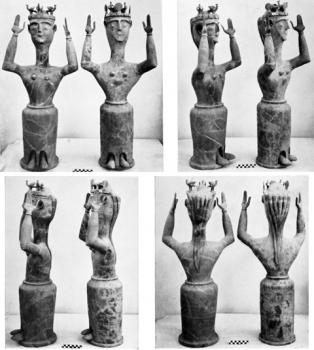
Goddesses Refusing to Appear? Reconsidering the Late Minoan III Figures with Upraised Arms Florence Gaignerot-Driessen "Large wheelmade terracotta figures with upraised arms, found together with typical cultic equipment, are characteristic of Cretan Postpalatial bench sanctuaries. It is generally assumed that these figures represent one or more deities and were used as cult images. Past and recent excavations on Crete illustrate a series of contexts that contain cultic equipment but lack such a figure with upraised arms. Most of these contexts date to Late Minoan (LM) IIIA–B and are found within larger building complexes that have potential communal functions. These complexes contrast with the contexts where the figures with upraised arms are found, which are freestanding public buildings and date to LM IIIB–C. This evolution suggests a change in the dynamics of and practices in cult spaces, an evolution that is here regarded as socially relevant. Within this framework, the figures with upraised arms are reconsidered as symbolic representations of votaries within the context of elite competition, rather than as cult images or cult statues."
Konḍa ṟeka wing, upper arm; Ka. eṟake, eṟaṅke, ṟakke, ṟekke wing; ṟaṭṭe, ṟeṭṭe wing, upper arm. (DEDR 2591) eraka 'shoulder'; wing రెక్క. A rib. పక్షియెముక (Telugu) Ka. eṟaka, eraka any metal infusion; molten state, fusion. Tu. eraka molten, cast (as metal);(DEDR 866)
British Museum number103225 Baked clay plaque showing a bull-man holding a post.
Old Babylonian 2000BC-1600BCE Length: 12.8 centimetres Width: 7 centimetres Barcelona 2002 cat.181, p.212 BM Return 1911 p. 66 ME 103225 Room 56 Baked clay plaques like this were mass-produced using moulds in southern Mesopotamia from the second millennium BCE. While many show informal scenes and reflect the private face of life, this example clearly has magical or religious significance.
![]() On this terracotta plaque, the mace is a phonetic determinant of the bovine (bull) ligatured to the body of the person holding the mace. The person signified is: dhangar ‘blacksmith’ (Maithili) ḍhangra ‘bull’. Rebus: ḍhangar ‘blacksmith’.
On this terracotta plaque, the mace is a phonetic determinant of the bovine (bull) ligatured to the body of the person holding the mace. The person signified is: dhangar ‘blacksmith’ (Maithili) ḍhangra ‘bull’. Rebus: ḍhangar ‘blacksmith’.
Mth. ṭhākur ʻ blacksmith ʼ (CDIAL 5488) N. ḍāṅro ʻ term of contempt for a blacksmith ʼ "... head and torso of a human but the horns, lower body and legs of a bull...Baked clay plaques like this were mass-produced using moulds in southern Mesopotamia from the second millennium BCE. British Museum. WCO2652. Bull-manTerracotta plaque. Bull-man holding a post. Mesopotamia, ca. 2000-1600 BCE."
Terracotta. This plaque depicts a creature with the head and torso of a human but the horns, lower body and legs of a bull. Though similar figures are depicted earlier in Iran, they are first seen in Mesopotamian art around 2500 BC, most commonly on cylinder seals, and are associated with the sun-god Shamash. The bull-man was usually shown in profile, with a single visible horn projecting forward. However, here he is depicted in a less common form; his whole body above the waist, shown in frontal view, shows that he was intended to be double-horned. He may be supporting a divine emblem and thus acting as a protective deity.
Hieroglyph carried on a flagpost by the blacksmith (bull ligatured man: Dhangar 'bull' Rebus: blacksmith'): karava 'pot with narrow neck' karNaka 'rim of jar' Rebus: kharva 'nidhi, wealth, karba 'iron'; karNI 'supercargo' karNIka 'scribe'.
Bull ligatured, horned man: Dhangar 'bull' Rebus: blacksmith'
mēd 'body' (Kur.)(DEDR 5099); meḍ 'iron' (Ho.) Ta. mēṉi body, shape, colour, beauty; mēl body. Ma. mēni body, shape, beauty, excellence; mēl body. Koḍ. me·lï body. Te. mēnu id.;
mēni brilliancy, lustre; belonging to the body, bodily, personal. Kol. me·n (pl.me·nḍl) body. Nk. mēn (pl. mēnuḷ) id. Nk. (Ch.) mēn id. Pa. mēn (pl. mēnul) id. Ga. (S.) mēnu (pl. mēngil), (P.) mēn id. Go. (Tr.) mēndur (obl. mēnduḍ-), (A. Y. W. M.) mēndul, (L.) meṇḍū˘l, (SR.) meṇḍol id. (Voc.2963). Konḍa mēndol human body. Kur. mē̃d, mēd body, womb, back. Malt. méth body (DEDR 5099)
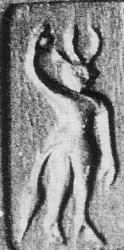
Indus Script bull-man hieroglyph-multiplex hypertext koḍu 'horn'; koḍ 'artisan’s workshop' eraka 'copper' dhangar 'smith'
![Image result for indus script standing person bovine]() On Pict-103, a decrepit woman with hanging breasts is ligatured to the hindpart of a bovine signifying a blacksmith. dhokra 'decrepit woman' Rebus: dhokra 'cire perdue metalcasting artisan'.
On Pict-103, a decrepit woman with hanging breasts is ligatured to the hindpart of a bovine signifying a blacksmith. dhokra 'decrepit woman' Rebus: dhokra 'cire perdue metalcasting artisan'.
Hieroglyph: eṛaka 'upraised arm' (Tamil); rebus: eraka = copper (Kannada) eraka 'molten cast' (Tulu) 'metal infusion' (Kannada)
kuTi 'tree' Rebus: kuThi 'smelter'
kamaDha 'archer' Rebus: kampaTTa 'mint'Hieroglyph: ḍhaṅgaru, ḍhiṅgaru m. ʻlean emaciated beastʼ(Sindhi) Rebus: dhangar ‘blacksmith’ (Maithili)
Hieroglyph: karava 'pot with narrow neck' karNaka 'rim of jar' Rebus: kharva 'nidhi, wealth, karba 'iron'; karNI 'supercargo' karNIka 'scribe'.![Image result for dhangar bharatkalyan97]() Harappa prism tablet
Harappa prism tablet
Field Symbol codes 50 to 53:
50. Personage wearing a diadem or tall head-dress Slanding between two posts or under an ornamental arch.51. Standing pe rsonage with horns and bovine features (hoofed legs an d/or tail).52. Standing personage with ho rns and bovine features. hold ing a bow in one hand and an arrow o r an un ce rtainobject in the other.53. Standing pe rsonage with horns and bovine features holding a staff or mace on his shoulder.![]()
![]() Stone seal. h179. National Museum, India. Carved seal. Scan 27418 Tongues of flame decorate the flaming pillar, further signified by two 'star' hieroglyphs on either side of the bottom of the flaming arch.
Stone seal. h179. National Museum, India. Carved seal. Scan 27418 Tongues of flame decorate the flaming pillar, further signified by two 'star' hieroglyphs on either side of the bottom of the flaming arch.
An early punch marked coin from Kosala similarly depicting a divinity under prabhavali 600-400 BCE
The canopy is visually and semantically reinforced by a series of decorative canopies (pegs) topped by umbrella hieroglyph along the arch.
Hieroglyph: canopy: nau -- maṇḍḗ n. du. ʻ the two sets of poles rising from the thwarts or the two bamboo covers of a boat (?)(CDIAL 9737) ![]() maṇḍapa m.n. ʻ open temporary shed, pavilion ʼ Hariv., °pikā -- f. ʻ small pavilion, customs house ʼ Kād. 2. maṇṭapa -- m.n. lex. 3. *maṇḍhaka -- . [Variation of ṇḍ with ṇṭ supports supposition of non -- Aryan origin in Wackernagel AiGr ii 2, 212: see EWA ii 557. -- Prob. of same origin as
maṇḍapa m.n. ʻ open temporary shed, pavilion ʼ Hariv., °pikā -- f. ʻ small pavilion, customs house ʼ Kād. 2. maṇṭapa -- m.n. lex. 3. *maṇḍhaka -- . [Variation of ṇḍ with ṇṭ supports supposition of non -- Aryan origin in Wackernagel AiGr ii 2, 212: see EWA ii 557. -- Prob. of same origin as maṭha -- 1 and maṇḍa -- 6 with which NIA. words largely collide in meaning and form]1. Pa. maṇḍapa -- m. ʻ temporary shed for festive occasions ʼ; Pk. maṁḍava -- m. ʻ temporary erection, booth covered with creepers ʼ, °viā -- f. ʻ small do. ʼ; Phal. maṇḍau m. ʻ wooden gallery outside a house ʼ; K. manḍav m. ʻ a kind of house found in forest villages ʼ; S. manahũ m. ʻ shed, thatched roof ʼ; Ku. mãṛyā, manyā ʻ resthouse ʼ; N. kāṭhmã̄ṛau ʻ the city of Kathmandu ʼ (kāṭh -- < kāṣṭhá -- ); Or. maṇḍuā̆ ʻ raised and shaded pavilion ʼ, paṭā -- maṇḍoi ʻ pavilion laid over with planks below roof ʼ, muṇḍoi, °ḍei ʻ raised unroofed platform ʼ; Bi. mã̄ṛo ʻ roof of betel plantation ʼ, mãṛuā, maṛ°, malwā ʻ lean -- to thatch against a wall ʼ, maṛaī ʻ watcher's shed on ground without platform ʼ; karã̄ 'wristlets' khār 'blacksmith' kūṭa, 'horn' kūṭa 'company'ʼ, mã̄ḍvɔ m. ʻ booth ʼ, mã̄ḍvī f. ʻ slightly raised platform before door of a house, customs house ʼ, mã̄ḍaviyɔm. ʻ member of bride's party ʼ; M. mã̄ḍav m. ʻ pavilion for festivals ʼ, mã̄ḍvī f. ʻ small canopy over an idol ʼ; Si. maḍu -- va ʻ hut ʼ, maḍa ʻ open hall ʼ SigGr ii 452.2. Ko. māṁṭav ʻ open pavilion ʼ.3. H. mã̄ḍhā, māṛhā, mãḍhā m. ʻ temporary shed, arbour ʼ (cf. OMarw. māḍhivo in 1); -- Ku. mã̄ṛā m.pl. ʻ shed, resthouse ʼ (or < maṇḍa -- 6 ?]*chāyāmaṇḍapa -- .Addenda: maṇḍapa -- : S.kcch. māṇḍhvo m. ʻ booth, canopy ʼ(CDIAL 9734)
maṇḍa6 ʻ some sort of framework (?) ʼ. [In nau -- maṇḍḗ n. du. ʻ the two sets of poles rising from the thwarts or the two bamboo covers of a boat (?) ʼ ŚBr. (as illustrated in BPL p. 42); and in BHSk. and Pa. bōdhi -- maṇḍa -- n. perh. ʻ thatched cover ʼ rather than ʻ raised platform ʼ (BHS ii 402). If so, it may belong to maṇḍapá -- and maṭha -- ]
Ku. mã̄ṛā m. pl. ʻ shed, resthouse ʼ (if not < *mã̄ṛhā < *maṇḍhaka -- s.v. maṇḍapá -- ).(CDIAL 9737)
maṇḍa2 m. ʻ ornament ʼ lex. [√maṇḍ ]Pk. maṁḍaya -- ʻ adorning ʼ; Ash. mōṇḍa, mōnda, mūnda NTS ii 266, mōṇə NTS vii 99 ʻ clothes ʼ; G. mã̄ḍ m. ʻ arrangement, disposition, vessels or pots for decoration ʼ, māṇ f. ʻ beautiful array of household vessels ʼ; M. mã̄ḍ m. ʻ array of instruments &c. ʼ; Si. maḍa -- ya ʻ adornment, ornament ʼ.(CDIAL 9736) maṇḍana n. ʻ adorning ʼ MBh., maṇḍaná -- adj. Pāṇ. [√maṇḍ ]
Pa. maṇḍana -- n., Pk. maṁḍaṇa -- n. and adj.; OMarw. māṁḍaṇa m. ʻ ornament ʼ; G. mã̄ḍaṇ n. ʻ decorating foreheads and cheeks of women on festive occasions ʼ. (CDIAL 9739) *maṇḍadhara ʻ ornament carrier ʼ. [maṇḍa -- 2 , dhara -- ]N. maṛher, maṛer ʻ one who carries ornaments &c. in the marriage procession ʼ. (CDIAL 9738) maṇḍáyati ʻ adorns, decorates ʼ Hariv., máṇḍatē, °ti Dhātup. [√maṇḍ ]
Pa. maṇḍēti ʻ adorns ʼ, Pk. maṁḍēi, °ḍaï; Ash. mū˘ṇḍ -- , moṇ -- intr. ʻ to put on clothes, dress ʼ, muṇḍaāˊ -- tr. ʻ to dress ʼ; K. manḍun ʻ to adorn ʼ, H. maṇḍnā; OMarw. māṁḍaï ʻ writes ʼ; OG. māṁḍīiṁ 3 pl. pres. pass. ʻ are written ʼ, G. mã̄ḍvũ ʻ to arrange, dispose, begin ʼ, M. mã̄ḍṇẽ, Ko. mã̄ṇḍtā.(CDIAL 9741)
Konḍa maṇḍi earthen pan, a covering dish. Pe. manḍi cooking pot. Kui manḍi brass bowl. Kuwi (S.) mandi basin; (Isr.) maṇḍi plate, bowl. Cf. 4682 Ta. maṇṭai(DEDR 4678)Ta. maṇṭai mendicant's begging bowl, earthen vessel, head, skull, cranium, brain-pan, top portion as of palms, a standard of measure. Ma. maṇṭa skull; similar objects. Ko. maṇḍ head. To. maḍ id. Ka. maṇḍe id.; (Hav.) maṇḍage a big jar. Koḍ. maṇḍe head. Tu. maṇḍè large earthen vessel, skull, head. Kor. (M.) maṇḍa, (O. T.) manḍe head. Cf. 4678 Konḍa maṇḍi. / Cf. Skt. (lex.) maṇḍa- head. (DEDR 4682)
Ta. maṇṭu (maṇṭi-) to blaze up, glow; maṭu (-pp-, -tt-) to kindle. Te. maṇḍu to burn, blaze, flame, cause or produce a burning pain, be angry, be in a fury or violent rage, be envious; maṇṭa flame, blaze, burning pain, anger, wrath, fury, envy; maṇḍincu to burn (tr.), inflame, provoke, irritate; maḍḍu great heat, redhot iron, brand; very hot; (K.) mrandu to be consumed by fire, burn. Kol. (Pat., p. 167) manḍeng to burn, scorch(intr.). Nk. manḍ- to burn (intr.). Go. (M.) maṛgānā to blaze; (Ma.) maṛg- to burn (intr.) (Voc. 2745); (Tr.) maṛūstānā to cook in oil (Voc. 2743); (ASu.) maṛū- (curry) to be charred. Kui mṛahpa (mṛaht-) to consume by fire, burn; n. destruction by fire.(DEDR 4680)
Grain market: OAw. māṁḍa m. ʻ a kind of thin cake ʼ, lakh. maṇḍī ʻ grain market ʼ(CDIAL 9735).
The hypertexts are read rebus in Meluhha Bhāratīya sprachbund (speech union):
1. The adorned, horned person standing within the canopy: karã̄ 'wristlets' khār 'blacksmith' kūṭa, 'horn'kūṭa 'company'
2. Headdress: kolmo 'rice plant' rebus: kolami 'smithy, forge'. Vikalpa: Vikalpa: kūtī = bunch of twigs (Skt.) Rebus: kuṭhi = furnace (Santali).Thus the standing person with twig headdress is a khār blacksmith working with khār smelter and furnace.
3. Canopy: M. mã̄ḍav m. ʻ pavilion for festivals ʼ, mã̄ḍvī f. ʻ small canopy over an idol ʼ(CDIAL 9734) rebus: maṇḍā 'warehouse, workshop' (Konkani) maṇḍī 'market' karã̄ n. pl.wristlets, banglesRebus: khār 'karmakāra -- ]Pa. kammāra -- m. ʻ worker in metal ʼ; Pk. kammāra -- , °aya -- m. ʻ blacksmith ʼ, A. kamār, B. kāmār; Or. kamāra ʻ blacksmith, caste of non -- Aryans, caste of fishermen ʼ; Mth. kamār ʻ blacksmith ʼ, Si. kam̆burā.*karmāraśālā -- .Addenda: karmāˊra -- : Md. kan̆buru ʻ blacksmith ʼ.(CDIAL 2898)
4 Decoration on canopy: umbrella on pegs: Hieroglyph: canopy, umbrella: Ta. kuṭai umbrella, parasol, canopy. Ma. kuṭa umbrella. Ko. koṛ umbrella made of leaves (only in a proverb); keṛ umbrella. To. kwaṛ id. Ka. koḍe id., parasol. Koḍ. koḍe umbrella. Tu. koḍè id. Te. goḍugu id., parasol. Kuwi (F.) gūṛgū, (S.) gudugu, (Su. P.) guṛgu umbrella (< Te.). / Cf. Skt. (lex.) utkūṭa- umbrella, parasol.Ta. kūṭāram(DEDR 1881) Rebus: kūṭa 'company' (Kannada)
khār 'blacksmith' emerges out of the tree or flaming pillar (skambha) identified by the 'star' hieroglyph'. The wristlets he wears and headdress signify that he is khār working with kuṭhi 'tree' Rebus: kuṭhi 'smelting furnace'. He is a smith engaged in smelting.
Hieroglyph:मेढा [ mēḍhā ] 'polar star' Rebus: mẽṛhẽt, meḍ 'iron' (Santali.Mu.Ho.) dula'two' rebus: dul 'metal casting' Thus, signifying a cast iron smelter.
![]() Santali glosses.
Santali glosses.
Hieroglyph: karã̄ n. pl. wristlets, bangles' rebus: khār 'blacksmith'
Hieroglyph: head-dress: kūdī, kūṭī bunch of twigs (Sanskrit) kuṭhi 'tree' Rebus: kuṭhi 'smelting furnace' (Santali) (Phonetic determinative of skambha, 'flaming pillar', rebus:kammaTa 'mint, coiner, coinage'). Skambha, flamiung pillar is the enquiry in Atharva veda Skambha Sukta (AV X.7,8)
Scan 27419.
5. The canopy is flanked by a pair of stars: Hieroglyph:मेढा [ mēḍhā ] 'polar star' Rebus: mẽṛhẽt, meḍ 'iron' (Santali.Mu.Ho.) dula'two' rebus: dul 'metal casting' Thus, signifying a cast iron smelter.
![]()
Hieroglyphs: backbone + four short strokes
Signs 47, 48: baraḍo = spine; backbone (Tulu) Rebus: baran, bharat ‘mixed alloys’ (5 copper, 4 zinc and 1 tin) (Punjabi) + gaṇḍa ‘four’ Rebus: kaṇḍ ‘fire-altar’. Thus, Sign 48 reads rebus: bharat kaṇḍ ‘fire-altar’, furnace for mixed alloy called bharat(copper, zinc, tin alloy), Pk. karaṁḍa -- m.n. ʻ bone shaped like a bamboo ʼ, karaṁḍuya -- n. ʻ backbone ʼ.( (CDIAL 2670) rebus: karaDa 'hard alloy'. Vikalpa: ![]() Alternative: Signs 47, 48khāra 2
Alternative: Signs 47, 48khāra 2 खार (= खार् (L.V. 96, K.Pr. 47, Śiv. 827) । द्वेषः m. (for 1, see khār 1 ), a thorn, prickle, spine (K.Pr. 47; Śiv. 827, 153)(Kashmiri) Rebus: khār खार् 'blacksmith' (Kashmiri) Hieroglyph: Pk. karaṁḍa -- m.n. ʻ bone shaped like a bamboo ʼ, karaṁḍuya -- n. ʻ backbone ʼ.*kaṇṭa3 ʻ backbone, podex, penis ʼ. 2. *kaṇḍa -- . 3. *karaṇḍa -- 4 . (Cf. *kāṭa -- 2 , *ḍākka -- 2 : poss. same as káṇṭa -- 1 ]1. Pa. piṭṭhi -- kaṇṭaka -- m. ʻ bone of the spine ʼ; Gy. eur. kanro m. ʻ penis ʼ (or < káṇṭaka -- ); Tir. mar -- kaṇḍḗ ʻ back (of the body) ʼ; S. kaṇḍo m. ʻ back ʼ, L. kaṇḍ f., kaṇḍā m. ʻ backbone ʼ, awāṇ. kaṇḍ, °ḍī ʻ back ʼ; P. kaṇḍ f. ʻ back, pubes ʼ; WPah. bhal. kaṇṭ f. ʻ syphilis ʼ; N. kaṇḍo ʻ buttock, rump, anus ʼ, kaṇḍeulo ʻ small of the back ʼ; B. kã̄ṭ ʻ clitoris ʼ; Or. kaṇṭi ʻ handle of a plough ʼ; H. kã̄ṭā m. ʻ spine ʼ, G. kã̄ṭɔ m., M. kã̄ṭā m.; Si. äṭa -- kaṭuva ʻ bone ʼ, piṭa -- k° ʻ backbone ʼ.2. Pk. kaṁḍa -- m. ʻ backbone ʼ.(CDIAL 2670) కరాళము karāḷamu karāḷamu. [Skt.] n. The backbone. వెన్నెముక (Telugu) Rebus: khār खार् 'blacksmith' (Kashmiri)![]() Sign 8 käti ʻwarrior' (Sinhalese)(CDIAL 3649). rebus: khātī m. ʻ 'member of a caste of wheelwrights'ʼVikalpa: bhaṭa 'warrior' rebus: bhaṭa 'furnace'. bhāthī m. ʻ warrior ʼ bhaṭa 'warrior' Rebus: bhaTa 'furnace', thus reinforcing the smelting process in the fire-altars. Smelters might have used bhaThi 'bellows'. bhástrā f. ʻ leathern bag ʼ ŚBr., ʻ bellows ʼ (CDIAL 9424) bhāthī m. ʻ warrior ʼ bhaTa 'warrior' Rebus: bhaTa 'furnace', thus reinforcing the smelting process in the fire-altars. Smelters might have used bhaThi 'bellows'. bhástrā f. ʻ leathern bag ʼ ŚBr., ʻ bellows ʼ Kāv., bhastrikā -- f. ʻ little bag ʼ Daś. [Despite EWA ii 489, not from a √bhas ʻ blow ʼ (existence of which is very doubtful). -- Basic meaning is ʻ skin bag ʼ (cf.
Sign 8 käti ʻwarrior' (Sinhalese)(CDIAL 3649). rebus: khātī m. ʻ 'member of a caste of wheelwrights'ʼVikalpa: bhaṭa 'warrior' rebus: bhaṭa 'furnace'. bhāthī m. ʻ warrior ʼ bhaṭa 'warrior' Rebus: bhaTa 'furnace', thus reinforcing the smelting process in the fire-altars. Smelters might have used bhaThi 'bellows'. bhástrā f. ʻ leathern bag ʼ ŚBr., ʻ bellows ʼ (CDIAL 9424) bhāthī m. ʻ warrior ʼ bhaTa 'warrior' Rebus: bhaTa 'furnace', thus reinforcing the smelting process in the fire-altars. Smelters might have used bhaThi 'bellows'. bhástrā f. ʻ leathern bag ʼ ŚBr., ʻ bellows ʼ Kāv., bhastrikā -- f. ʻ little bag ʼ Daś. [Despite EWA ii 489, not from a √bhas ʻ blow ʼ (existence of which is very doubtful). -- Basic meaning is ʻ skin bag ʼ (cf. bakura <-> ʻ bellows ʼ ~ bākurá -- dŕ̊ti -- ʻ goat's skin ʼ), der. from bastá -- m. ʻ goat ʼ RV. (cf.bastājina -- n. ʻ goat's skin ʼ MaitrS. = bāstaṁ carma Mn.); with bh -- (and unexpl. -- st -- ) in Pa. bhasta -- m. ʻ goat ʼ, bhastacamma -- n. ʻ goat's skin ʼ. Phonet. Pa. and all NIA. (except S. with a) may be < *bhāsta -- , cf. bāsta -- above (J. C. W.)]With unexpl. retention of -- st -- : Pa. bhastā -- f. ʻ bellows ʼ (cf. vāta -- puṇṇa -- bhasta -- camma -- n. ʻ goat's skin full ofwind ʼ), biḷāra -- bhastā -- f. ʻ catskin bag ʼ, bhasta -- n. ʻ leather sack (for flour) ʼ; K. khāra -- basta f. ʻ blacksmith's skin bellows ʼ; -- S. bathī f. ʻ quiver ʼ (< *bhathī); A. Or. bhāti ʻ bellows ʼ, Bi. bhāthī, (S of Ganges) bhã̄thī; OAw. bhāthā̆ ʻ quiver ʼ; H. bhāthā m. ʻ quiver ʼ, bhāthī f. ʻ bellows ʼ; G. bhāthɔ,bhātɔ, bhāthṛɔ m. ʻ quiver ʼ (whence bhāthī m. ʻ warrior ʼ); M. bhātā m. ʻ leathern bag, bellows, quiver ʼ, bhātaḍ n. ʻ bellows, quiver ʼ; <-> (X bhráṣṭra -- ?) N. bhã̄ṭi ʻ bellows ʼ, H. bhāṭhī f.Addenda: bhástrā -- : OA. bhāthi ʻ bellows ʼ .(CDIAL 9424) bhráṣṭra n. ʻ frying pan, gridiron ʼ MaitrS. [√bhrajj ]Pk. bhaṭṭha -- m.n. ʻ gridiron ʼ; K. büṭhü f. ʻ level surface by kitchen fireplace on which vessels are put when taken off fire ʼ; S. baṭhu m. ʻ large pot in which grain is parched, large cooking fire ʼ, baṭhī f. ʻ distilling furnace ʼ; L. bhaṭṭh m. ʻ grain -- parcher's oven ʼ, bhaṭṭhī f. ʻ kiln, distillery ʼ, awāṇ. bhaṭh; P. bhaṭṭhm., °ṭhī f. ʻ furnace ʼ, bhaṭṭhā m. ʻ kiln ʼ; N. bhāṭi ʻ oven or vessel in which clothes are steamed for washing ʼ; A. bhaṭā ʻ brick -- or lime -- kiln ʼ; B. bhāṭi ʻ kiln ʼ; Or. bhāṭi ʻ brick -- kiln, distilling pot ʼ; Mth. bhaṭhī, bhaṭṭī ʻ brick -- kiln, furnace, still ʼ; Aw.lakh. bhāṭhā ʻ kiln ʼ; H. bhaṭṭhā m. ʻ kiln ʼ, bhaṭ f. ʻ kiln, oven, fireplace ʼ; M. bhaṭṭā m. ʻ pot of fire ʼ, bhaṭṭī f. ʻ forge ʼ. -- X bhástrā -- q.v.bhrāṣṭra -- ; *bhraṣṭrapūra -- , *bhraṣṭrāgāra -- .Addenda: bhráṣṭra -- : S.kcch. bhaṭṭhī keṇī ʻ distil (spirits) ʼ.*bhraṣṭrāgāra ʻ grain parching house ʼ. [bhráṣṭra -- , agāra -- ]P. bhaṭhiār, °ālā m. ʻ grainparcher's shop ʼ.(CDIAL 9656, 9658)
![]() Sign 342 karṇaka, kanka 'rim of jar' rebs: karṇī 'scribe, supercargo' कर्णिक m. a steersman(Monier-Williams)
Sign 342 karṇaka, kanka 'rim of jar' rebs: karṇī 'scribe, supercargo' कर्णिक m. a steersman(Monier-Williams)
Ka. kūṭa joining, connexion, assembly, crowd, heap, fellowship, sexual intercourse; ku·ṭï gathering, assembly. Tu. kūḍuni to join (tr.), unite, copulate, embrace, adopt; meet (intr.), assemble, gather, be mingled, be possible; kūḍisuni to add; kūḍāvuni, kūḍisāvuni to join, connect, collect, amass, mix; kūṭuni, kūṇṭuni to mix, mingle (tr.); kūḍa along with; kūḍigè joining, union, collection, assemblage, storing, mixing; kūṭaassembly, meeting, mixture. Te. kūḍu to meet (tr.), join, associate with, copulate with, add together; meet (intr.), join, agree, gather, collect, be proper; kūḍali, kūḍika joining, meeting, junction; kūḍa along with; kūḍaniwrong, improper; kūḍami impropriety; kūṭamu heap, assembly, conspiracy; kūṭuva, kūṭuvu heap, collection, army; kūṭami meeting, union, copulation; kūṭakamu addition, mixture; kūr(u)cu to join, unite, bring together, amass, collect; caus. kūrpincu; kūrpu joining, uniting. Kol. (Kin.) kūṛ pāv meeting of ways (pāv way, path). Pa. kūṛ er- to assemble. Go. (S.) kūṛ- to join; (Mu.) gūḍ- to assemble (Voc. 833); (M.) guṛnā to swarm (Voc. 1160). Konḍa kūṛ- (-it-) to join, meet, assemble, come together; kūṛp- to mix (cereals, etc.), join or put together, collect; kūṛaŋa together. Pe. kūṛā- (kūṛa ā-) to assemble. Kuwi (Su.) kūṛ- id.; (Isr.) kūṛa ā-to gather together (intr.); kūṛi ki- to collect (tr.); (S.) kūḍi kīnai to gather; kūṛcinai to collect. Kur. xōṇḍnā to bring together, collect into one place, gather, wrinkle (e.g. the nose), multiply in imagination; xōṇḍrnā to meet or come together, be brought into the company of.(DEDR 1882).

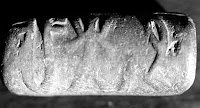 Stone seal. h179. National Museum, India. Carved seal. Scan 27418 Tongues of flame decorate the flaming pillar, further signified by two 'star' hieroglyphs on either side of the bottom of the flaming arch.
Stone seal. h179. National Museum, India. Carved seal. Scan 27418 Tongues of flame decorate the flaming pillar, further signified by two 'star' hieroglyphs on either side of the bottom of the flaming arch.Ku. mã̄ṛā m. pl. ʻ shed, resthouse ʼ (if not < *mã̄ṛhā < *maṇḍhaka -- s.v.
maṇḍa
Pa. maṇḍana -- n., Pk. maṁḍaṇa -- n. and adj.; OMarw. māṁḍaṇa m. ʻ ornament ʼ; G. mã̄ḍaṇ n. ʻ decorating foreheads and cheeks of women on festive occasions ʼ. (CDIAL 9739) *maṇḍadhara ʻ ornament carrier ʼ. [
Pa. maṇḍēti ʻ adorns ʼ, Pk. maṁḍēi, °ḍaï; Ash. mū˘ṇḍ -- , moṇ -- intr. ʻ to put on clothes, dress ʼ, muṇḍaāˊ -- tr. ʻ to dress ʼ; K. manḍun ʻ to adorn ʼ, H. maṇḍnā; OMarw. māṁḍaï ʻ writes ʼ; OG. māṁḍīiṁ 3 pl. pres. pass. ʻ are written ʼ, G. mã̄ḍvũ ʻ to arrange, dispose, begin ʼ, M. mã̄ḍṇẽ, Ko. mã̄ṇḍtā.(CDIAL 9741)
Ta. maṇṭu (maṇṭi-) to blaze up, glow; maṭu (-pp-, -tt-) to kindle. Te. maṇḍu to burn, blaze, flame, cause or produce a burning pain, be angry, be in a fury or violent rage, be envious; maṇṭa flame, blaze, burning pain, anger, wrath, fury, envy; maṇḍincu to burn (tr.), inflame, provoke, irritate; maḍḍu great heat, redhot iron, brand; very hot; (K.) mrandu to be consumed by fire, burn. Kol. (Pat., p. 167) manḍeng to burn, scorch(intr.). Nk. manḍ- to burn (intr.). Go. (M.) maṛgānā to blaze; (Ma.) maṛg- to burn (intr.) (Voc. 2745); (Tr.) maṛūstānā to cook in oil (Voc. 2743); (ASu.) maṛū- (curry) to be charred. Kui mṛahpa (mṛaht-) to consume by fire, burn; n. destruction by fire.(DEDR 4680)
Grain market: OAw. māṁḍa m. ʻ a kind of thin cake ʼ, lakh. maṇḍī ʻ grain market ʼ(CDIAL 9735).
Hieroglyph:मेढा [ mēḍhā ] 'polar star' Rebus: mẽṛhẽt, meḍ 'iron' (Santali.Mu.Ho.) dula'two' rebus: dul 'metal casting' Thus, signifying a cast iron smelter.
 Santali glosses.
Santali glosses.Hieroglyph: karã̄ n. pl. wristlets, bangles' rebus: khār 'blacksmith'
Hieroglyph: head-dress: kūdī, kūṭī bunch of twigs (Sanskrit) kuṭhi 'tree' Rebus: kuṭhi 'smelting furnace' (Santali) (Phonetic determinative of skambha, 'flaming pillar', rebus:kammaTa 'mint, coiner, coinage'). Skambha, flamiung pillar is the enquiry in Atharva veda Skambha Sukta (AV X.7,8)
Scan 27419.
miṇḍ ʻ ram ʼ, miṇḍāˊl ʻ markhor ʼ (Torwali) mẽḍhɔ 'ram' (Gujarati)(CDIAL 10310) Rebus: me~Rhet, meD 'iron' (Mu.Ho.Santali)
dhangra 'bull' rebus: dhangar 'blacksmith'![]() Horned, standing person terracotta is Indus Script hypertext mēd 'body' meḍ 'iron' kōḍu 'horn' koḍ 'workshop' His arms are filled with armlets from wrist to shoulder. He wears a scarf. A twig, sprout is his headdress. The curved arch canopy is decorated with ficus leaves.
Horned, standing person terracotta is Indus Script hypertext mēd 'body' meḍ 'iron' kōḍu 'horn' koḍ 'workshop' His arms are filled with armlets from wrist to shoulder. He wears a scarf. A twig, sprout is his headdress. The curved arch canopy is decorated with ficus leaves.
dhatu 'scarf' Rebus: dhatu 'mineral'. Hieroglyph: karã̄ n. pl. wristlets, bangles' rebus: khār 'blacksmith'
Hieroglyph: head-dress: kūdī, kūṭī bunch of twigs (Sanskrit) kuṭhi 'tree' Rebus: kuṭhi 'smelting furnace' (Santali) loa'ficus religiosa' Rebus: loh'copper' PLUS mã̄ḍvī f. ʻ small canopy over an idol ʼ(CDIAL 9734) Rebus:
Hieroglyph: head-dress: kūdī, kūṭī bunch of twigs (Sanskrit) kuṭhi 'tree' Rebus: kuṭhi 'smelting furnace' (Santali)
This monograph uses archaeology evidence, identifies Kernunnos of Celtic tradition as Tvaṣṭṛ triśiras त्रि--शिरस् of Veda tradition authenticated in Indus Script hypertexts, wealth-accounting ledgers, metalwork catalogues.
tvāṣṭrī signifies copper. துவட்டன்tuvaṭṭaṉ , n. < Tvaṣṭṛ. A deity representing the sun, one of the tuvātacātittar, q.v.; துவாதசாதித்தருள்ஒருவன். (திவா.) துவட்டாtuvaṭṭā, n. < Tvaṣṭā Tvaṣṭṛ. Višvakarmā, the architect of the gods; தெய்வத்தச்சனாகியவிசுவகருமா. துவட்டாவீன்றதனயன் (திருவிளை. இந்திரன்பழி. 8). 11) త్వష్ట tvaṣṭa tvashṭa. [Skt.] n. A carpenter, వడ్లవాడు. triśiras त्रि--शिरस् mfn. three-headed (त्वाष्ट्र , author of RV. x , 8.) ताण्ड्य-ब्राह्मण xvii;बृहद्-देवता, कौषीतकि-उपनिषद्, MBh., कामन्दकीय-नीतिसार, KaushUp. MBh. Ka1m.; (ज्वर) भागवत-पुराण x, 63,22. त्वष्टृm. a carpenter , maker of carriages (= त्/अष्टृ) AV. xii , 3 , 33; " creator of living beings " , the heavenly builder , N. of a god (called सु-क्/ऋत् , -पाण्/इ , -ग्/अभस्ति , -ज्/अनिमन् , स्व्-/अपस् , अप्/असाम् अप्/अस्तम , विश्व्/अ-रूप&c RV. ; maker of divine implements , esp. of इन्द्र's thunderbolt and teacher of the ऋभुs i , iv-vi , x Hariv. 12146 f. R. ii , 91 , 12 ; former of the bodies of men and animals , hence called " firstborn " and invoked for the sake of offspring , esp. in the आप्री hymns RV. AV. &c MBh. iv , 1178 Hariv. 587 ff. Ragh. vi , 32 ; associated with the similar deities धातृ , सवितृ , प्रजा-पति , पूषन् , and surrounded by divine females [ग्न्/आस् , जन्/अयस् , देव्/आनाम् प्/अत्नीस् ; cf. त्व्/अष्टा-व्/अरूत्री] recipients of his generative energy RV. S3Br. i Ka1tyS3r. iii ; supposed author of RV. x , 184 with the epithet गर्भ-पति RAnukr. ; father of सरण्यू [सु-रेणु Hariv. ; स्व-रेणु L. ] whose double twin-children by विवस्वत् [or वायु ? RV. viii , 26 , 21 f.] are यमयमी and the अश्विन्s x , 17 , 1 f. Nir. xii , 10 Br2ih. Hariv. 545 ff. VP. ; also father of त्रि-शिरस् or विश्वरूप ib. ; overpowered by इन्द्र who recovers the सोम [ RV. iii f. ] concealed by him because इन्द्र had killed his son विश्व-रूप TS. ii S3Br. i , v , xii ; regent of the नक्षत्र चित्रा TBr. S3a1n3khGr2. S3a1ntik.VarBr2S. iic , 4 ; of the 5th cycle of Jupiter viii , 23 ; of an eclipse iii , 6 ; त्वष्टुर् आतिथ्य N. of a सामन् A1rshBr. )(Monier-Williams) त्वष्टृ tvaṣṭṛ त्वष्टृ m. [त्वक्ष्-तृच्] 1 A carpenter, builder, workman, त्वष्ट्रेव विहितं यन्त्रम् Mb.12.33.22. -2 Viśvakarman, the architect of the gods. [Tvaṣtṛi is the Vulcan of the Hindu mythology. He had a son named Triśiras and a daughter called संज्ञा, who was given in marriage to the sun. But she was unable to bear the severe light of her husband, and therefore Tvaṣtṛi mounted the sun upon his lathe, and carefully trimmed off a part of his bright disc; cf. आरोप्य चक्रभ्रमिमुष्णतेजास्त्वष्ट्रेव यत्नो- ल्लिखितो विभाति R.6.32. The part trimmed off is said to have been used by him in forming the discus of Viṣṇu, the Triśūla of Śiva, and some other weapons of the gods.] पर्वतं चापि जग्राह क्रुद्धस्त्वष्टा महाबलः Mb.1.227. 34. -3 Prajāpati (the creator); यां चकार स्वयं त्वष्टा रामस्य महिषीं प्रियाम् Mb.3.274.9. -4 Āditya, a form of the sun; निर्भिन्ने अक्षिणी त्वष्टा लोकपालो$विशद्विभोः Bhāg.3.6.15. त्वाष्ट्र tvāṣṭra त्वाष्ट्र a. Belonging or coming from त्वष्टृ; त्वाष्ट्रं यद् दस्रावपिकक्ष्यं वाम् Rv.1.117.22. -ष्ट्रः Vṛitra; येनावृता इमे लोकास्तमसा त्वाष्ट्रमूर्तिना । स वै वृत्र इति प्रोक्तः पापः परमदारुणः ॥ Bhāg.6.9.18;11.12.5. -ष्ट्री 1 The asterism Chitra. -2 A small car. -ष्ट्रम् 1 Creative power; तपःसारमयं त्वाष्ट्रं वृत्रो येन विपाटितः Bhāg.8.11.35. -2 Copper.(Apte)
Variations of his name have been found. At Verespatak, Rumania, he is called ‘Cernenus’. He is called ‘Deo Cernunico’ at Seinsel-Relent in Germany. The semantic link with the ‘horn’ indicates that Kernunnos is a title. This title may have been used to refer to a horned divinity. Two inscriptions on metal plaques from Seinsel-Rëlent (Luxembourg) give a rendering of Deo Ceruninco, 'to the God Cerunincos'. A Gaulish inscription written in Greek letters from Montagnac (Hérault, Languedoc-Roussilion, France) is a dedication to ‘Karnonos’; has a Hellenistic form of the name: Karnonos. The Gaulish inscription RIG 1, number G-224 reads:αλλετ[ει]νος καρνονου αλ[ι]σο[ντ]εας (Alletinos [dedicated this] to Karnonos of Alisontea), with the last word possibly a place name based on Alisia, "service-tree" or "rock"
As a title, the horned Kernunnos signifies kárṇaka'helmsman' and the torc on his ears signify karã̄ 'wristlets, bangles', khãr 'ironsmith'. The horns are Indus script hieroglyphs: kōḍu'horn' rebus koḍ 'workplace'. The body hieroglyph is: meḍ 'body' Rebus1: mēda m. ʻ a mixed caste, any one living by a degrading occupation ʼ Mn. [→ Bal. mēd ʻ boatman, fisher- man ʼ. -- Cf. Tam. metavar ʻ basket -- maker ʼ &c. DED 4178]k. mēa -- m., mēī -- f. ʻ member of a non -- Aryan tribe ʼ; S. meu m. ʻ fisherman ʼ (whence miāṇī f. ʻ a fishery ʼ), L. mē m.; P. meũ m., f. meuṇī ʻ boatman ʼ. -- Prob. separate from S. muhāṇo m. ʻ member of a class of Moslem boatmen ʼ, L. mohāṇā m., °ṇī f.: see *mr̥gahanaka -- .(CDIAL 10320) Rebus2:meḍhā 'stake, yupa' rebus: medha 'yajña, nidhi'. Rebus 3: मृदु mṛdu, mẽṛhẽt, meḍ 'metal' (Samskrtam. Santali.Mu.Ho).
See: Indus Script catalogue of pot kiln for ceramic (stoneware) bangles. kō̃da कोँद'young bull', kō̃da 'kiln'; karã̄ 'wristlets, bangles', khãr 'ironsmith' ANE rod and ring, insignia of a guild functionary https://tinyurl.com/y959qsd9
Bronze anthropomorphs & torcs are Indus Script professional calling cards of metalworkers, seafaring Meluhha merchants in Eurasia from 3rd m BCEhttps://tinyurl.com/y9dz7cmq
Balakot, inscribed bangle Inscription: dhatu कारणी or कारणीक [ kāraṇī or kāraṇīka ] 'supercargo of a ship responsible for the cargo of mineral ores'.
karã̄ 'wristlets, bangles', khãr 'ironsmith' ANE rod and ring, insignia of a guild functionary
![]() mēd 'body' (Kur.)(DEDR 5099) Rebus: meḍ 'iron' (Ho.) mē
mēd 'body' (Kur.)(DEDR 5099) Rebus: meḍ 'iron' (Ho.) mēd 'boatman' (Bal.) Ta. mēṉi body, shape, colour, beauty; mēl body. Ma. mēni body, shape, beauty, excellence; mēl body. Koḍ. me·lï body. Te. mēnu id.;mēni brilliancy, lustre; belonging to the body, bodily, personal. Kol. me·n (pl.me·nḍl) body. Nk. mēn (pl. mēnuḷ) id. Nk. (Ch.) mēn id. Pa. mēn (pl. mēnul) id. Ga. (S.) mēnu (pl. mēngil), (P.) mēn id. Go. (Tr.) mēndur (obl. mēnduḍ-), (A. Y. W. M.) mēndul, (L.) meṇḍū˘l, (SR.) meṇḍol id. (Voc.2963). Konḍa mēndol human body. Kur. mē̃d, mēd body, womb, back. Malt. méth body (DEDR 5099)Basket-maker: mēda m. ʻ a mixed caste, any one living by a degrading occupation ʼ Mn. [→ Bal. mēd ʻ boatman, fisher- man ʼ. -- Cf. Tam. metavar ʻ basket -- maker ʼ &c. DED 4178]k. mēa -- m., mēī -- f. ʻ member of a non -- Aryan tribe ʼ; S. meu m. ʻ fisherman ʼ (whence miāṇī f. ʻ a fishery ʼ), L. mē m.; P. meũ m., f. meuṇī ʻ boatman ʼ. -- Prob. separate from S. muhāṇo m. ʻ member of a class of Moslem boatmen ʼ, L. mohāṇā m., °ṇī f.: see *mr̥gahanaka -- .(CDIAL 10320) meḍhā 'stake, yupa' rebus: medha 'yajña, nidhi'.
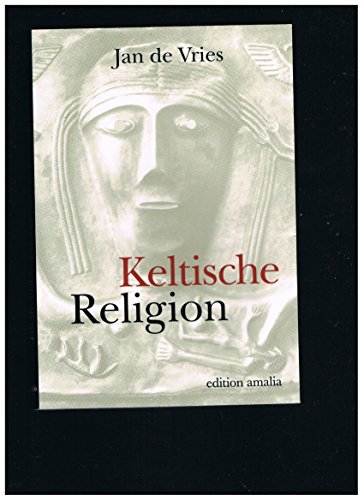 The cover page of the work by Jan de Vries has this image taken from Gundestrup Cauldron. Keltische Religion. Jan de Vries Published by Edition Amalia, 2004
The cover page of the work by Jan de Vries has this image taken from Gundestrup Cauldron. Keltische Religion. Jan de Vries Published by Edition Amalia, 2004


A segment from Gundestrup Cauldron. Shows Kernunnos with upraised fisted hands, next to a spoked wheel. Mercury-like image holds a wheel is also held by a non-horned figure. The wheel has been linked as a solar symbol, thus linking Cernunnos to Sun Divinity. In Veda tradition the me taphor of Tvaṣṭṛ.triśiras is a solar divinity. Budha is Soumya, signifier of Soma. He is described as the son of Rohini and Soma.Budha is linked to the three steps of Viṣṇu. In iconography, his chariot made of air and fire, drawn by eight wind horses; he rides a lion.

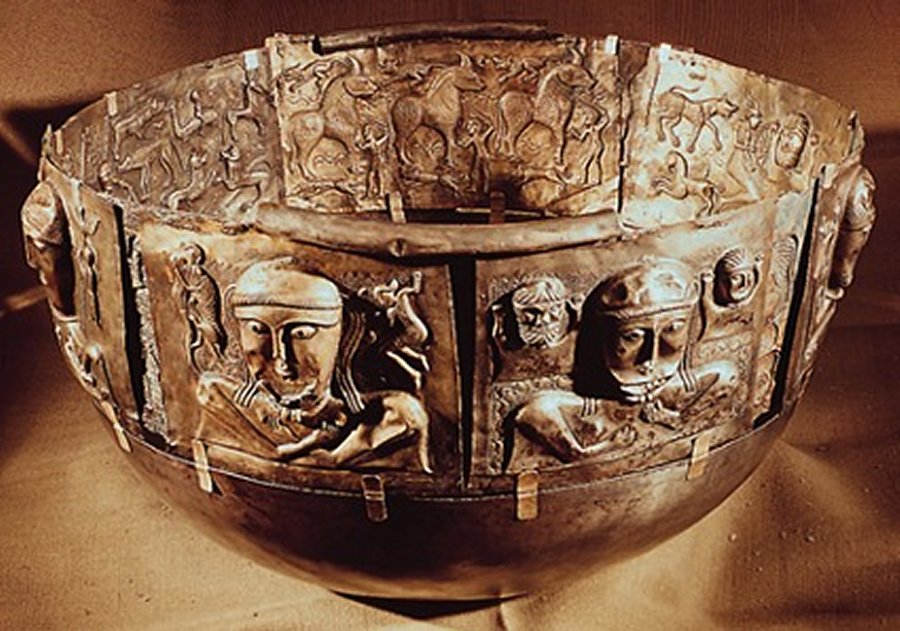
Gundestrup Cauldron. National Museum. Copenhagen. "The Gundestrup Cauldron is the largest (9 kg.) single silver object known from the La Tene era, when La Tène Culture flourished from about 500 BC to the Roman conquest in the 1st century BC, in several countries such as Belgium, eastern France, Switzerland, Austria, Southern Germany, the Czech Republic, Poland, Slovakia, Slovenia, Croatia and parts of Hungary and Romania."http://www.ancientpages.com/2016/05/30/gundestrup-cauldron-great-gilded-silver-vessel-decorated-scenes-derived-celtic-mythology
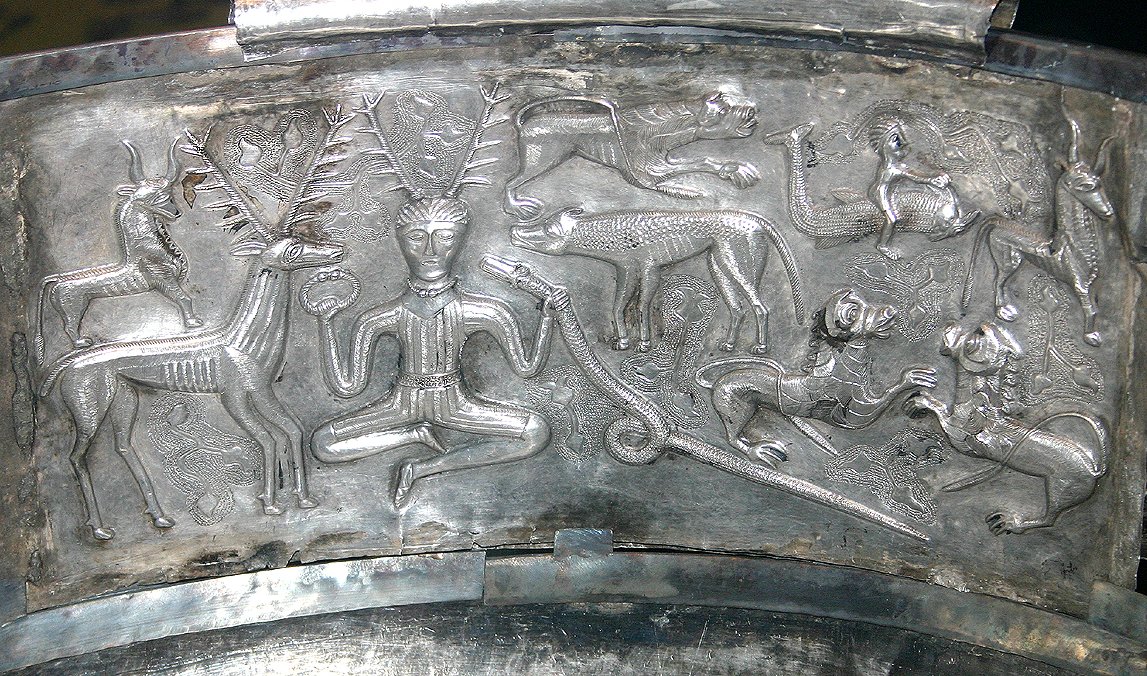
The "Cernunnos" type antlered figure or "horned god", on the Gundestrup Cauldron, on display, at the National Museum of Denmarkin Copenhagen
Kernunnos association with maritime themes is reinforced by a relief found in Bourdeax which shows a horned Divinity holding an anchor in his left hand. Maritime trade also hints Mercury whose name may mean 'merchant'. In a conflation of Kernunnos and Mercury, a relief in York shows Mercury standing behind an altar.Mercury bears the cadeuceus in his left hand and a large purse in the right hand. To his left stands a stag and to his left a cock. “A bronze figure from StAlbans showed Mercury, again with caduceus and moneybag, wearing a torcand accompanied by a ram and cock, again accompanied by a horned beast(hinting at the ‘horned one’), and the ram being indicative of the ram-headedserpent. This is a much more logical conflation than might originally beconsidered. The ancient Greek god Hermes was largely assumed into theRoman Mercury, and his symbolic connections to Cernunnos are clearlyapparent.” (Sorita d’Este, The witch God Cernunnos, in: Sorita d’Este (ed.), 2008, Horns of Power Manifestations of the Horned God, An anthology of essays exploring the Horned Gods of myth and folklore, ancient history through to modern times, Avalonia
"The clearest image of Cernunnos is found on the silver votive cauldron, the Gundestrup Cauldron, discovered in Denmark which shows him seated, wearing a stripy close-fitting tunic and trousers, with a royal torc or neck-ring about his neck. In one hand he holds up another torc while in the other he holds a ram-headed snake. (At display at the National Museum (Nationalmuseet) in Denmark). photo via wikipedia."

Exterior plate. Torc wearing head.Three strands of hair plaiting.


Gundestrup cauldron. Exterior plate f, with torc-wearing head
Votive models of carriages, pulled by stags, oxen or swans, sometimes with a divinity standing in the middle, such as the bronze model cult wagon, dated 7th c. BCE, from Strettweg (Austria). In the centre, a female deity supports a massive vessel with her head and two hands and is surrounded by deer, horses and soldiers .(Birkhan, 1999, p. 261, n° 407 ; Green, 1995, p. 1 ; Green, 2001, p. 137, fig. 56.)Source: http://theses.univ-lyon2.fr/documents/getpart.php?id=lyon2.2009.beck_n&part=159144

Cernunnos Circa 14 CE



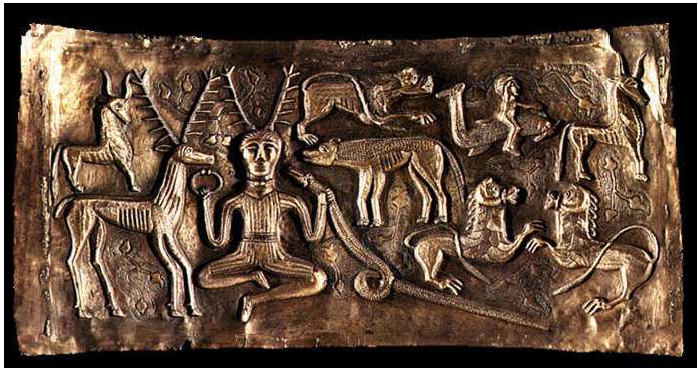
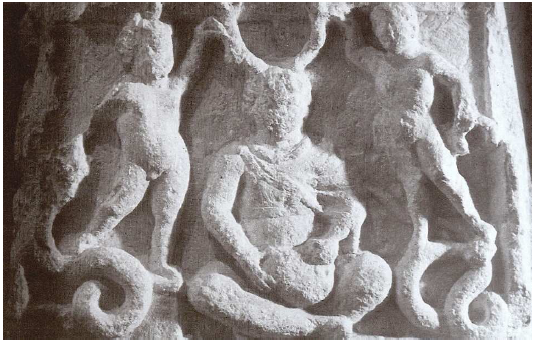
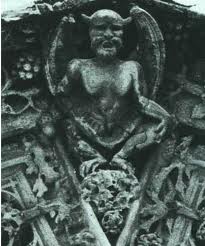 Representation of Cernunnos on the c. 1437 CE Nautes Parisiacae monument, excavated under the choir of the Cathedral Notre Dame de Paris. (Source: Musée National du Moyen Age, Cluny, Paris).
Representation of Cernunnos on the c. 1437 CE Nautes Parisiacae monument, excavated under the choir of the Cathedral Notre Dame de Paris. (Source: Musée National du Moyen Age, Cluny, Paris). Source: https://www.manygods.org.uk/articles/essays/Cernunnos.shtml "God of Etang-sur-Arroux, a possible depiction of Cernunnos. He wears a torc at the neck and on the chest. Two snakes with ram heads encircle him at the waist. Two cavities at the top of his head are probably designed to receive deer antlers. Two small human faces at the back of his head indicate that he is tricephalic. Musée d'Archéologie Nationale(National Archaeological Museum), in France." https://en.wikipedia.org/wiki/Cernunnos
Source: https://www.manygods.org.uk/articles/essays/Cernunnos.shtml "God of Etang-sur-Arroux, a possible depiction of Cernunnos. He wears a torc at the neck and on the chest. Two snakes with ram heads encircle him at the waist. Two cavities at the top of his head are probably designed to receive deer antlers. Two small human faces at the back of his head indicate that he is tricephalic. Musée d'Archéologie Nationale(National Archaeological Museum), in France." https://en.wikipedia.org/wiki/Cernunnos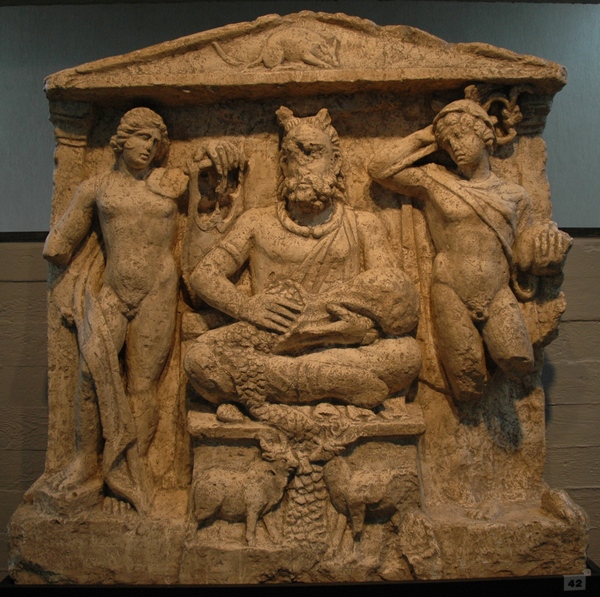
The Pilier des nautes links Cernunnos with with commerce, suggesting that he was also associated with material wealth as does the coin pouch from the Cernunnos of Rheims (Marne, Champagne, France)—in antiquity, Durocortorum, the civitas capital of the Remi tribe—and the stag vomiting coins from Niedercorn-Turbelslach (Luxembourg) in the lands of the Treveri. The god may have symbolised the fecundity of the stag-inhabited forest.
One of the most important finds on Titelberg has been a huge number of Celtic coins which come not only from the Treveri themselves but from several other Celtic / Gallic tribes. This indicates that it was a centre of trade and commerce during the Celtic period. In addition, facilities for minting coins have also been excavated close to the residential area and appear to have been used over an extended period.
About 20 years after the Roman conquest, the Celtic oppidum was completely reworked and two streets perpendicular to the main were constructed. The houses too were replaced with Roman buildings which had stone foundations and cellars. These were however generally demolished two decades later at the time the Romans moved their centre of interest from Titelberg to Trier.
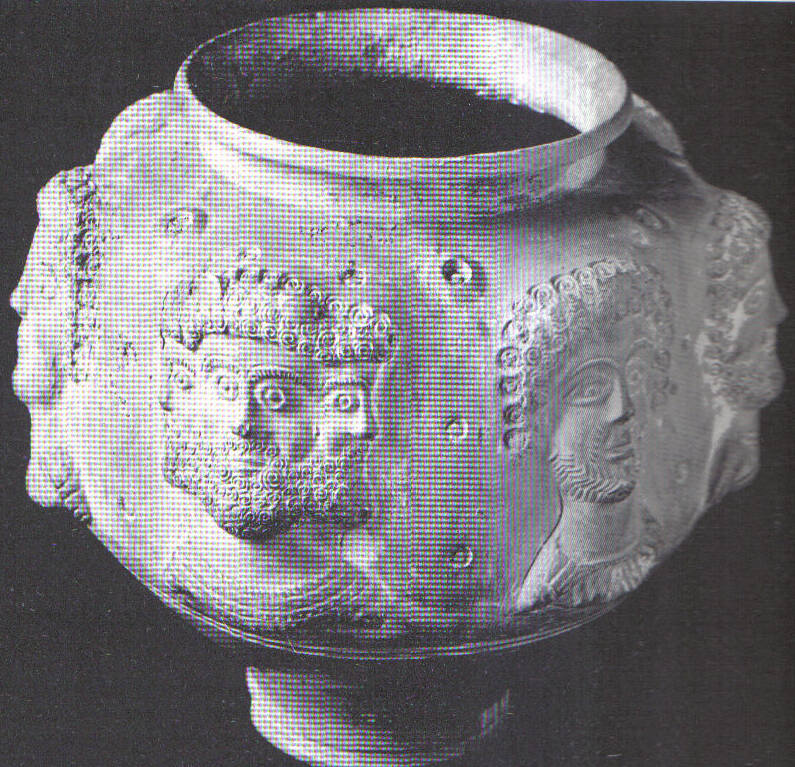
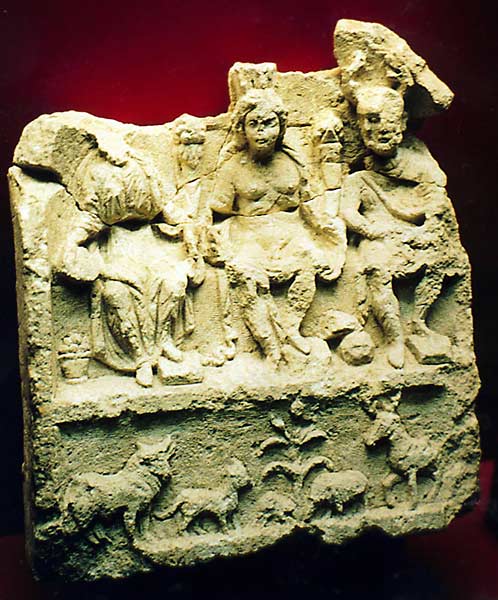
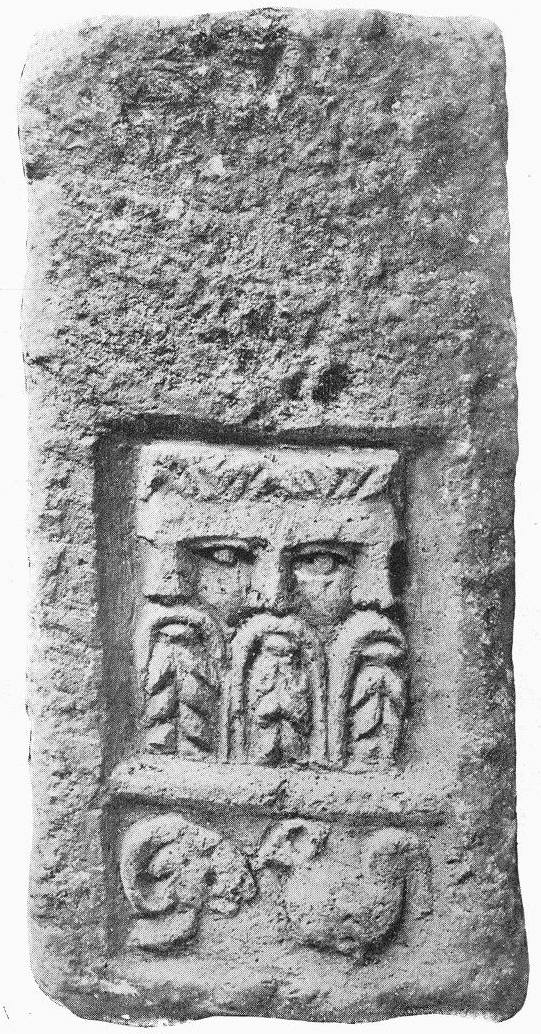

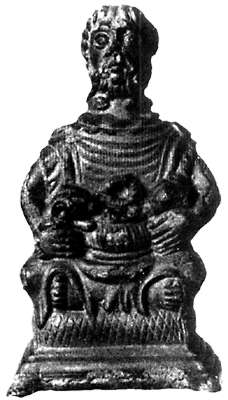
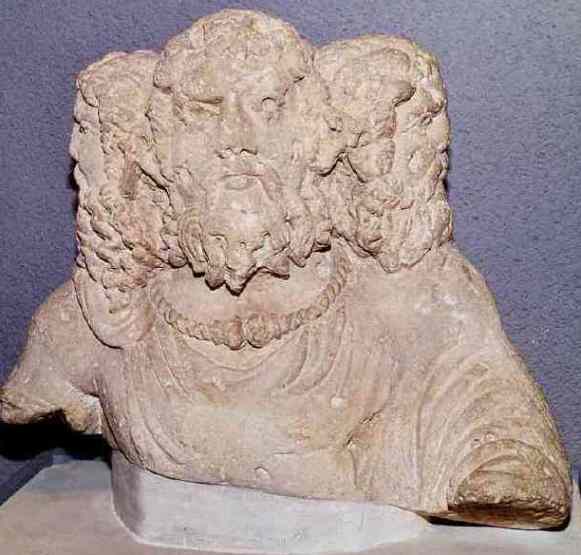
Cernunnos: Looking a Different Way David Fickett-Wilbar Proceedings of the Harvard Celtic Colloquium Vol. 23 (2003), pp. 80-111 https://www.jstor.org/stable/25660728
hill, mountain. Ga. (S.3, LSB 20.3) meṭṭa high land. Go. (Tr. W. Ph.) maṭṭā, (Mu.)maṭṭa mountain; (M. L.) meṭā id., hill; (A. D. Ko.) meṭṭa, (Y. Ma. M.) meṭa hill; (SR.) meṭṭā hillock (Voc. 2949). Konḍa meṭa id. Kuwi (S.) metta hill; (Isr.) meṭa sand hill. (DEDR 5058) (b) Ta. mēṭai platform, raised floor, artificial mound, terraced house. Ma. mēṭa raised place, tower, upper story, palace. Te. mēḍa house with two or more stories, upper chamber. Pa. mēṛ ole bungalow. Go. (Ko.) mēṛā large house, bungalow (Voc. 2965). Konḍa mēṛa mide terraced building (see 5069). Pe. mēṛ storied house, mansion.Kuwi (S.) mēḍa illu storied house; (Isr.) mēṛa upstair building. / Cf. Skt. (lex.) meṭa- whitewashed storied house; Pkt. meḍaya- id. (DEDR 4796b)
 Signs 45, 46 Mahadevan Concordance. In Sign 46, Sign 45 is ligatured with a pot held by the adoring hands of the kneeling adorant wearing a scarf-type pigtail. I suggest that the rimless pot held on Sign 46 is a phonetic determinant: baTa 'rimless pot' Rebus: bhaTa 'furnace'. So, is the kneeling adorant, a worshippper of a person seated in penance, a bhaTa 'worshipper in a temple' Rebus: bhaTa 'furnace'. For him the kole.l 'temple' is kole.l 'smithy, forge' (Kota language).
Signs 45, 46 Mahadevan Concordance. In Sign 46, Sign 45 is ligatured with a pot held by the adoring hands of the kneeling adorant wearing a scarf-type pigtail. I suggest that the rimless pot held on Sign 46 is a phonetic determinant: baTa 'rimless pot' Rebus: bhaTa 'furnace'. So, is the kneeling adorant, a worshippper of a person seated in penance, a bhaTa 'worshipper in a temple' Rebus: bhaTa 'furnace'. For him the kole.l 'temple' is kole.l 'smithy, forge' (Kota language).Hieroglyph: kamadha 'penance' Rebus: kammata 'coiner, mint'.
Hieroglyph: rango 'buffalo' Rebus: rango 'pewter'.
![]()
Horned person in penance and “temple,” Harappa (H95-2487/4466-01) (Courtesy of the Department of Archaeology and Museums, Government of Pakistan)..
Text on obverse of the tablet m453A: Text 1629. m453BC Seated in penance, the person is flanked on either side by a kneeling adorant, offering a pot and a hooded serpent rearing up.
Glyph: kaṇḍo ‘stool’. Rebus; kaṇḍ ‘furnace’. Vikalpa: kaṇḍ ‘stone (ore) metal’. Rebus: kamaḍha ‘penance’. Rebus 1: kaṇḍ ‘stone ore’. Rebus 2: kampaṭṭa ‘mint’.
Glyph: ‘serpent hood’: paṭa. Rebus: pata ‘sharpness (of knife), tempered (metal). padm ‘tempered iron’ (Ko.)
Glyph: rimless pot: baṭa. Rebus: bhaṭa ‘smelter, furnace’. It appears that the message of the glyphics is about a mint or metal workshop which produces sharpened, tempered iron (stone ore) using a furnace.
Rebus readings of glyphs on text of inscription:
koṇḍa bend (Ko.); Tu. Kōḍi corner; kōṇṭu angle, corner, crook. Nk. Kōnṭa corner (DEDR 2054b) G. khū̃ṭṛī f. ʻangleʼRebus: kõdā ‘to turn in a lathe’(B.) कोंद kōnda ‘engraver, lapidary setting or infixing gems’ (Marathi) koḍ ‘artisan’s workshop’ (Kuwi) koḍ = place where artisans work (G.) ācāri koṭṭya ‘smithy’ (Tu.) कोंडण [kōṇḍaṇa] f A fold or pen. (Marathi) B. kõdā ‘to turn in a lathe’; Or.kū̆nda ‘lathe’, kũdibā, kū̃d ‘to turn’ (→ Drav. Kur. Kū̃d ’ lathe’) (CDIAL 3295)
aṭar ‘a splinter’ (Ma.) aṭaruka ‘to burst, crack, sli off,fly open; aṭarcca ’ splitting, a crack’; aṭarttuka ‘to split, tear off, open (an oyster) (Ma.); aḍaruni ‘to crack’ (Tu.) (DEDR 66) Rebus: aduru ‘native, unsmelted metal’ (Kannada)
ãs = scales of fish (Santali); rebus: aya ‘metal, iron’ (Gujarati.) cf. cognate to amśu 'soma' in Rigveda: ancu 'iron' (Tocharian)
G.karã̄ n. pl. ‘wristlets, bangles’; S. karāī f. ’wrist’ (CDIAL 2779). Rebus: khār खार् ‘blacksmith’ (Kashmiri)
dula ‘pair’; rebus dul ‘cast (metal)’
Glyph of ‘rim of jar’: kárṇaka m. ʻ projection on the side of a vessel, handle ʼ ŚBr. [kárṇa -- ]Pa. kaṇṇaka -- ʻ having ears or corners ʼ; (CDIAL 2831) kaṇḍa kanka; Rebus: furnace account (scribe). kaṇḍ = fire-altar (Santali); kan = copper (Tamil) khanaka m. one who digs , digger , excavator Rebus: karanikamu. Clerkship: the office of a Karanam or clerk. (Telugu) káraṇa n. ʻ act, deed ʼ RV. [√kr̥1] Pa. karaṇa -- n. ʻdoingʼ; NiDoc. karana, kaṁraṁna ʻworkʼ; Pk. karaṇa -- n. ʻinstrumentʼ(CDIAL 2790)
The suggested rebus readings indicate that the Indus writing served the purpose of artisans/traders to create metalware, stoneware, mineral catalogs -- products with which they carried on their life-activities in an evolving Bronze Age.
Horned person in penance and “temple,” Harappa (H95-2487/4466-01) (Courtesy of the Department of Archaeology and Museums, Government of Pakistan)..
Text on obverse of the tablet m453A: Text 1629. m453BC Seated in penance, the person is flanked on either side by a kneeling adorant, offering a pot and a hooded serpent rearing up.
Glyph: kaṇḍo ‘stool’. Rebus; kaṇḍ ‘furnace’. Vikalpa: kaṇḍ ‘stone (ore) metal’. Rebus: kamaḍha ‘penance’. Rebus 1: kaṇḍ ‘stone ore’. Rebus 2: kampaṭṭa ‘mint’.
Rebus readings of glyphs on text of inscription:
koṇḍa bend (Ko.); Tu. Kōḍi corner; kōṇṭu angle, corner, crook. Nk. Kōnṭa corner (DEDR 2054b) G. khū̃ṭṛī f. ʻangleʼRebus: kõdā ‘to turn in a lathe’(B.) कोंद kōnda ‘engraver, lapidary setting or infixing gems’ (Marathi) koḍ ‘artisan’s workshop’ (Kuwi) koḍ = place where artisans work (G.) ācāri koṭṭya ‘smithy’ (Tu.) कोंडण [kōṇḍaṇa] f A fold or pen. (Marathi) B. kõdā ‘to turn in a lathe’; Or.kū̆nda ‘lathe’, kũdibā, kū̃d ‘to turn’ (→ Drav. Kur. Kū̃d ’ lathe’) (CDIAL 3295)
aṭar ‘a splinter’ (Ma.) aṭaruka ‘to burst, crack, sli off,fly open; aṭarcca ’ splitting, a crack’; aṭarttuka ‘to split, tear off, open (an oyster) (Ma.); aḍaruni ‘to crack’ (Tu.) (DEDR 66) Rebus: aduru ‘native, unsmelted metal’ (Kannada)
ãs = scales of fish (Santali); rebus: aya ‘metal, iron’ (Gujarati.) cf. cognate to amśu 'soma' in Rigveda: ancu 'iron' (Tocharian)
Glyph of ‘rim of jar’: kárṇaka m. ʻ projection on the side of a vessel, handle ʼ ŚBr. [kárṇa -- ]Pa. kaṇṇaka -- ʻ having ears or corners ʼ; (CDIAL 2831) kaṇḍa kanka; Rebus: furnace account (scribe). kaṇḍ = fire-altar (Santali); kan = copper (Tamil) khanaka m. one who digs , digger , excavator Rebus: karanikamu. Clerkship: the office of a Karanam or clerk. (Telugu) káraṇa n. ʻ act, deed ʼ RV. [√kr̥1] Pa. karaṇa -- n. ʻdoingʼ; NiDoc. karana, kaṁraṁna ʻworkʼ; Pk. karaṇa -- n. ʻinstrumentʼ(CDIAL 2790)
The suggested rebus readings indicate that the Indus writing served the purpose of artisans/traders to create metalware, stoneware, mineral catalogs -- products with which they carried on their life-activities in an evolving Bronze Age.
 Kalibangan terracotta cake
Kalibangan terracotta cakeIndus Script unravels announcement of metals caravensarai, evidence of 11 ft. tall copper plated flagpost from Girsu (Telloh), Ancient Near East
There are two seals of Indus script (m1186 and m0488) depicting a kneeling person with some offerings on a stool/tray. In a vivid orthographic analysis, John C. Huntington identifies the nature of the offering on m1186: it is a bowl with ladles. The offering kept on a stool on m0488 is likely to be a similar glyph, though analysis of a higher resolution image is not possible because the tablet with this glyph is worn-out.
m1186 seal. kaula— m. ‘worshipper of Śakti according to left—hand ritual’, khōla—3 ‘lame’; Khot. kūra— ‘crooked’ BSOS ix 72 and poss. Sk. kōra— m. ‘movable joint’ Suśr.] Ash. kṓlƏ ‘curved, crooked’; Dm. kōla ‘crooked’, Tir. kṓolƏ; Paš. kōlā́ ‘curved, crooked’, Shum. kolā́ṇṭa; Kho. koli ‘crooked’, (Lor.) also ‘lefthand, left’; Bshk. kōl ‘crooked’; Phal. kūulo; Sh. kōlu̯ ‘curved, crooked’ (CDIAL 3533).
Rebus: kol ‘pancaloha’ (Tamil)
bhaTa 'worshipper' Rebus: bhaTa 'furnace' baTa 'iron' (Gujarati)
saman 'make an offering (Santali) samanon 'gold' (Santali)
miṇḍ ʻ ram ʼ, miṇḍāˊl ʻ markhor ʼ (Torwali) mẽḍhɔ 'ram' (Gujarati)(CDIAL 10310) Rebus: me~Rhet, meD 'iron' (Mu.Ho.Santali)
heraka 'spy' (Samskritam) Rebus:eraka 'molten metal, copper'
maNDa 'branch, twig' (Telugu) Rebus: maNDA 'warehouse, workshop' (Konkani)\karibha, jata kola Rebus: karba, ib, jasta, 'iron, zinc, metal (alloy of five metals)
maNDi 'kneeling position' Rebus: mADa 'shrine; mandil 'temple' (Santali)
dhatu 'scarf' Rebus: dhatu 'mineral ore' (Santali)
The rice plant adorning the curved horn of the person (woman?) with the pig-tail is kolmo; read rebus, kolme ‘smithy’. Smithy of what? Kol ‘pancaloha’. The curving horn is: kod.u = horn; rebus: kod. artisan’s workshop (Kuwi)
The long curving horns may also connote a ram on h177B tablet:
![]() h177B
h177B![]() 4316 Pict-115: From R.—a person standing under an ornamental arch; a kneeling adorant; a ram with long curving horns.
4316 Pict-115: From R.—a person standing under an ornamental arch; a kneeling adorant; a ram with long curving horns.
The ram read rebus: me~d. ‘iron’; glyph: me_n.d.ha ram; min.d.a_l markhor (Tor.); meh ram (H.); mei wild goat (WPah.) me~r.hwa_ a bullock with curved horns like a ram’s (Bi.) me~r.a_, me~d.a_ ram with curling horns (H.) miṇḍ 'ram' rebus: mẽṛhet iron (metal), meD 'iron' (Ho.) med 'copper' (Slavic)
Indus Script hieroglyphs of Prakrtam sprachbund lexis khambhaṛā 'fin' rebus: kammaṭa 'mint' has a synonym கண்வட்டம் kaṇ-vaṭṭam 'mint, coiner, coinage'
The note has recorded evidence that கண்வட்டம் kaṇ-vaṭṭam 'mint' has a synonym (demonstrably, a phonetic variant in mleccha/meluhha): khambhaṛā 'fin' (Lahnda) rebus: kammaTa 'mint' and these two expressions are combined in the Begram ivory (Plate 389)
Hieroglyph componens are: face in profile, one eye, circumfix (circle) and 6 curls of hair. Readings: muh 'face' rebus: muhA 'ingot'; கண்வட்டம் kaṇ-vaṭṭam 'eye PLUS circumfix' rebus: கண்வட்டம் kaṇ-vaṭṭan 'mint'; baTa 'six' rebus: baTa 'iron' bhaTa 'furnace' PLUS meD 'curl' rebus: meD 'iron' (Mu.Ho.) med 'copper' (Slavic) Thus, the message is: mint with furnace for iron, copper. Tigers: dula 'two' rebus: dul 'cast metal' kola 'tiger' rebus: kol 'working in iron' kolhe 'smelter' kolle 'blacksmith' kariba 'elephant trunk' ibha 'elephant' rebus: karba 'iron' ib 'iron' eraka 'nave of wheel' rebus: eraka 'moltencast, copper' arA 'spoke' rebus: Ara 'brass'.

Mark Kenoyer writes that "discoveries of this motif on seals from Mohenjo-daro definitely show a male figure and most scholars have assumed some connection with the carved seals from Mesopotamia that illustrate episodes from the famous Gilgamesh epic. The Mesopotamian motifs show lions being strangled by a hero, whereas the Indus narratives render tigers being strangled by a figure, sometime clearly males, sometimes ambiguous or possibly female. This motif of a hero or heroine grappling with two wild animals could have been created independently for similar events that may have occurred in Mesopotamia as well as the Indus valley," ( Ancient Cities, p. 114).
கண்வட்டம் kaṇ-vaṭṭam , n. < id. +. 1. Range of vision, eye-sweep, full reach of one's observation; கண்பார்வைக்குட்பட்ட இடம். தங்கள்கண்வட்டத்திலே உண்டுடுத்துத்திரிகிற (ஈடு, 3, 5, 2). 2. Mint; நாணயசாலை.aya khambhaṛā (Lahnda) rebus: aya 'iron' PLUS khambhaṛā 'fish fin'
Rebus: kammaTa 'mint, coiner, coinage' (Kannada)== 'fish PLUS fin' rebus: ayas kammaTa 'metal mint'.
kola 'woman' rebus: kol 'working in iron'
taṭu 'thwart' Ta. taṭu (-pp-, -tt-) to hinder, stop, obstruct, forbid, prohibit, resist, dam, block up, partition off, curb, check, restrain, control, ward off, avert; n. hindering, checking, resisting; taṭuppu hindering, obstructing, resisting, restraint; Kur. ṭaṇḍnā to prevent, hinder, impede. Br. taḍ power to resist; Ma. taṭa resistance, warding off (as with a shield), what impedes, resists, stays, or stops, a prop; taṭa-kūṭuka to hinder; taṭaṅṅalhindrance, stoppage; taṭaccal impeding, stop, stumbling; taṭayuka to be obstructed, stop between, stop; taṭavu what resists, wards off, a prison; taṭassu obstruction, hindrance; taṭukkuka to stop, hinder; taṭekka to stop; taṭṭuka to ward off, beat off, oppose. Ko. taṛv- (taṛt-) to obstruct, stop; taṛ, taṛv obstruction. To. taṛf- (taṛt-) to delay, prevent, screen; taṛprevention, screen; taḍgïl hindrance, obstruction, delay. Ka. taḍa impeding, check, impediment, obstacle, delay;(DEDR 3031) ḍāṭnā ʻ to threaten, check, plug ʼ (→ P. ḍāṭṇā ʻ to check, cram ʼ(M.); B. ḍã̄ṭā ʻ to threaten ʼ; Or. ḍāṇṭibā ʻ to check ʼ; H. ḍã̄ṭnā ʻ to threaten, check, plug ʼ (→ N. ḍã̄ṭnu ʻ to threaten ʼ, (Tarai) dã̄ṭnu). (CDIAL 6618) rebus: dhatu 'mineral'.
kāṇa काण 'one-eyed' RV. x , 155 , 1 AV. xii , 4 , 3 TS. ii , 5 , 1 , 7 Mn. MBh. PLUS Pa. vaṭṭa -- ʻ round ʼ, n. ʻ circle ʼ; Pk. vaṭṭa -- , vatta -- , vitta -- , vutta -- ʻ round ʼ(CDIAL 12069) rebus: Ta. kampaṭṭam coinage, coin. Ma. kammaṭṭam, kammiṭṭam coinage, mint. Ka. kammaṭa id.; kammaṭi a coiner. (DEDR 1236) கண்வட்டம் kaṇ-vaṭṭam Mint; நாணயசாலை. கண்வட்டக்கள்ளன் (ஈடு.)
Pk. kolhuya -- , kulha -- m. ʻ jackal ʼ < *kōḍhu -- ; H. kolhā, °lām. ʻ jackal ʼ, adj. ʻ crafty ʼ; G. kohlũ, °lũ n. ʻ jackal ʼ, M. kolhā, °lā m.(CDIAL 3615) rebus: kol 'working in iron'
dula 'pair' rebus: dul 'metal casting' PLUS kola 'tiger' rebus: kol 'working in iron', kolle 'blackmith', kolhe 'smelter'.
Thus, the message of the inscription on this side of the plano convex Harappa tablet is: mint metalcasting work of iron, brass and minerals.

Dimensions: 3.91 length, 1.5 to 1.62 cm width
Harappa, Lot 4651-01
Harappa Museum, H95-2486
Meadow and Kenoyer 1997 karA 'crocodile' Rebus: khAr 'blacksmith' (Kashmiri)
kāṇī m. ʻone-eyed' rebus: kārṇī m. ʻ prime minister, supercargo of a shipʼ
Hypertext of one-eyed woman with six locks of hair: kaṇṇahāra -- m. ʻhelmsman, sailorʼ.
kola 'tiger' rebus: kotiya 'outrigger boat, dhow' (with cargo of dhatu 'mineral').
Bengali word: f. kāṇī ʻone -- eyedʼ: kāṇá ʻ one -- eyed ʼ RV.Pa. Pk. kāṇa -- ʻ blind of one eye, blind ʼ; Ash. kã̄ṛa, °ṛī f. ʻ blind ʼ, Kt. kãŕ, Wg. kŕãmacrdotdot;, Pr. k&schwatildemacr;, Tir. kāˊna, Kho. kāṇu NTS ii 260, kánu BelvalkarVol 91; K. kônu ʻ one -- eyed ʼ, S.kāṇo, L. P. kāṇã̄; WPah. rudh. śeu. kāṇā ʻ blind ʼ; Ku. kāṇo, gng. kã̄&rtodtilde; ʻ blind of one eye ʼ, N. kānu; A. kanā ʻ blind ʼ; B. kāṇā ʻ one -- eyed, blind ʼ; Or. kaṇā, f. kāṇī ʻ one -- eyed ʼ, Mth. kān, °nā,kanahā, Bhoj. kān, f. °ni, kanwā m. ʻ one -- eyed man ʼ, H. kān, °nā, G. kāṇũ; M. kāṇā ʻ one -- eyed, squint -- eyed ʼ; Si. kaṇa ʻ one -- eyed, blind ʼ. -- Pk. kāṇa -- ʻ full of holes ʼ, G. kāṇũ ʻ full of holes ʼ, n. ʻ hole ʼ (< ʻ empty eyehole ʼ? Cf. ã̄dhḷũ n. ʻ hole ʼ < andhala -- ).*kāṇiya -- ; *kāṇākṣa -- .Addenda: kāṇá -- : S.kcch. kāṇī f.adj. ʻ one -- eyed ʼ; WPah.kṭg. kaṇɔ ʻ blind in one eye ʼ, J. kāṇā; Md. kanu ʻ blind ʼ.*kāṇākṣa ʻ one -- eyed ʼ. [kāṇá -- , ákṣi -- ]Ko. kāṇso ʻ squint -- eyed ʼ.(CDIAL 3019, 3020) Rebus: कारणी or कारणीक kāraṇī or kāraṇīka a (कारण S) That causes, conducts, carries on, manages. Applied to the prime minister of a state, the supercargo of a ship (Marathi)
Glyph: ‘woman’: kola ‘woman’ (Nahali). Rebus kol ‘working in iron’ (Tamil)
Glyph: ‘impeding, hindering’: taṭu (Ta.) Rebus: dhatu ‘mineral’ (Santali) Ta. taṭu (-pp-, -tt) to hinder, stop, obstruct, forbid, prohibit, resist, dam, block up, partition off, curb, check, restrain, control, ward off, avert; n. hindering, checking, resisting; taṭuppu hindering, obstructing, resisting, restraint; Kur. ṭaṇḍnā to prevent, hinder, impede. Br. taḍ power to resist. (DEDR 3031) baTa 'six' rebus: bhaTa 'furnace'. Alternative: Ta. āṟu six; aṟu-patu sixty; aṟu-nūṟu 600; aṟumai six; aṟuvar six persons; avv-āṟu by sixes. Ma. āṟu six; aṟu-patu sixty; aṟu-nnūṟu 600; aṟuvar six persons. Ko. a·r six; ar vat sixty; a·r nu·r 600;ar va·ṇy six pa·ṇy measures. To. o·ṟ six; pa·ṟ sixteen; aṟoQ sixty; o·ṟ nu·ṟ 600; aṟ xwa·w six kwa·x measures. Ka. āṟu six; aṟa-vattu, aṟu-vattu, ar-vattu sixty; aṟu-nūṟu, āṟu-nūṟu 600; aṟuvar, ārvarusix persons. Koḍ. a·rï six; a·rane sixth; aru-vadï sixty; a·r-nu·rï 600. Tu. āji six; ājane sixth; ajipa, ajippa, ājipa, ājpa sixty. Te. āṟu six; āṟuguru, āṟuvuru six persons; aṟu-vadi, aruvai, aravai sixty;aṟuvaṇḍru sixty persons. Kol. (SR. Kin., Haig) ār six; (SR.) ārgur six persons. Nk(Ch.) sādi six. Go. (Tr.) sāṟung six; sārk six each; (W.) sārūṅg, (Pat.) harung, (M.) ārū, hārūṃ, (L.) hārūṅg six; (Y.)sārvir, (G.) sārvur, (Mu.) hārvur, hāruṛ, (Ma.) ār̥vur six (masc.) (Voc. 3372); sarne (W.) fourth day after tomorrow, (Ph.) sixth day (Voc. 3344); Kui (Letchmajee) sajgi six; sāja pattu six times twelve dozen (= 864); (Friend-Pereira; Gūmsar dialect) saj six; sajgi six things; (K.) hāja six (DEDR 2485) Together, the reading of the hypertext of one-eyed PLUS six hair-knots is: kArNI-Ara, i.e. kaṇṇahāra -- m. ʻ helmsman, sailor ʼ (Prakrtam): karṇadhāra m. ʻ helmsman ʼ Suśr. [kárṇa -- , dhāra -- 1] Pa. kaṇṇadhāra -- m. ʻ helmsman ʼ; Pk. kaṇṇahāra -- m. ʻ helmsman, sailor ʼ; H. kanahār m. ʻ helmsman, fisherman ʼ.(CDIAL 2836) PLUS मेढा [mēḍhā] A twist rebus: mẽṛhẽt, meD 'iron' Thus, the narrative hypertext signifies helmsman carrying cargo of smelted iron.
काण [p= 269,1] mf(आ)n. (etym. doubtful ; g. कडारा*दि) one-eyed , monoculous (अक्ष्णाकाणः , blind of one eye Comm. on Pa1n2. 2-1 , 30 and 3 , 20) RV. x , 155 , 1 AV. xii , 4 , 3 TS. ii , 5 , 1 , 7 Mn. MBh." having only one loop or ring " and " one-eyed " Pan5cat. Rebus: kārṇī m. ʻ prime minister, supercargo of a ship ʼ Pa. usu -- kāraṇika -- m. ʻ arrow -- maker ʼ; Pk. kāraṇiya -- m. ʻ teacher of Nyāya ʼ; S. kāriṇī m. ʻ guardian, heir ʼ; N. kārani ʻ abettor in crime ʼ; M. kārṇī m. ʻ prime minister, supercargo of a ship ʼ, kul -- karṇī m. ʻ village accountant ʼ.(CDIAL 3058)
Side A narrative is common to both tablets: arA 'spoked wheel' rebus: Ara 'brass'; eraka 'knave of wheel' rebus: eraka 'moltencast, copper' PLUS karabha 'trunk of elephant' ibha 'elephant' rebus: karba 'iron' ib 'iron' PLUS karA 'crocodile' rebus: khAr 'blacksmith' PLUS one-eyed woman thwarting rearing tigers:
The obverse side of the tablets of Harappa have two different narratives: 1. One narrative shows a tiger looking up at a spy ona tree branch (H2001-5075/2922-01). 2. Another narrative shows a person kicking and spearing a bovine (m489B) PLUS crocodile and a horned person seated in penance with twig head-dress as field hieroglyphs.
The first type of narrative records products from a smelter. The second type of narrative records products from a smithy/mint.
Flipped horizontally![]()
Molded terracotta tablet (H2001-5075/2922-01) with a narrative scene of a man in a tree with a tiger looking back over its shoulder. The tablet, found in the Trench 54 area on the west side of Mound E, is broken, but was made with the same mold as ones found on the eastern side of Mound E and also in other parts of the site (see slide 89 for the right hand portion of the same scene). The reverse of the same molded terra cotta tablet shows a deity grappling with two tigers and standing above an elephant (see slide 90 for a clearer example from the same mold). https://www.harappa.com/indus3/185.html heraka 'spy' rebus: eraka 'moltencast copper' kuTi 'tree' rebus:kuThi 'smelter' karA 'crocodile' rebus: khAr 'blacksmith' barad 'bull' rebus: baraDo 'alloy of pewter, copper, tin'. Another animal (perhaps bovine) is signified in a procession together with the tiger. This may signify barad, balad 'ox' rebus: bharat 'alloy of pewter, copper, tin'. Thus the products shown as from smithy (blacksmith).with a smelter.
One side of a molded tablet m 492 Mohenjo-daro (DK 8120, NMI 151. National Museum, Delhi. A person places his foot on the horns of a buffalo while spearing it in front of a cobra hood.
Hieroglyph: kolsa = to kick the foot forward, the foot to come into contact with anything when walking or running; kolsa pasirkedan = I kicked it over (Santali.lex.)mēṛsa = v.a. toss, kick with the foot, hit with the tail (Santali)
kol ‘furnace, forge’ (Kuwi) kol ‘alloy of five metals, pancaloha’ (Ta.) •kolhe (iron-smelter; kolhuyo, jackal) kol, kollan-, kollar = blacksmith (Ta.lex.)•kol‘to kill’ (Ta.)•sal ‘bos gaurus’, bison; rebus: sal ‘workshop’ (Santali)me~ṛhe~t iron; ispat m. = steel; dul m. = cast iron; kolhe m. iron manufactured by the Kolhes (Santali); meṛed (Mun.d.ari); meḍ (Ho.)(Santali.Bodding)
nAga 'serpent' Rebus: nAga 'lead'
Hieroglyph: rã̄go ʻ buffalo bull ʼ
Rebus: Pk. raṅga 'tin' P. rã̄g f., rã̄gā m. ʻ pewter, tin ʼ Ku. rāṅ ʻ tin, solder ʼOr. rāṅga ʻ tin ʼ, rāṅgā ʻ solder, spelter ʼ, Bi. Mth. rã̄gā, OAw. rāṁga; H. rã̄g f., rã̄gā m. ʻ tin, pewter ʼraṅgaada -- m. ʻ borax ʼ lex.Kho. (Lor.) ruṅ ʻ saline ground with white efflorescence, salt in earth ʼ *raṅgapattra ʻ tinfoil ʼ. [raṅga -- 3, páttra -- ]B. rāṅ(g)tā ʻ tinsel, copper -- foil ʼ.
paTa 'hood of serpent' Rebus: padanu 'sharpness of weapon' (Telugu)
Hieroglyph: kunta1 ʻ spear ʼ. 2. *kōnta -- . [Perh. ← Gk. konto/s ʻ spear ʼ EWA i 229]1. Pk. kuṁta -- m. ʻ spear ʼ; S. kundu m. ʻ spike of a top ʼ, °dī f. ʻ spike at the bottom of a stick ʼ, °diṛī, °dirī f. ʻ spike of a spear or stick ʼ; Si. kutu ʻ lance ʼ.
2. Pa. konta -- m. ʻ standard ʼ; Pk. koṁta -- m. ʻ spear ʼ; H. kõt m. (f.?) ʻ spear, dart ʼ; -- Si. kota ʻ spear, spire, standard ʼ perh. ← Pa.(CDIAL 3289)
Rebus: kuṇṭha munda (loha) 'hard iron (native metal)'
Allograph: कुंठणें [ kuṇṭhaṇēṃ ] v i (कुंठ S) To be stopped, detained, obstructed, arrested in progress (Marathi)
Slide 90.
m0489A One side of a prism tablet shows: crocodile + fish glyphic above: elephant, rhinoceros, tiger, tiger looking back and up.
m1431A m1431B Crocodile+ three animal glyphs: rhinoceros, elephant, tiger
It is possible that the broken portions of set 2 (h1973B and h1974B) showed three animals in procession: tiger looking back and up + rhinoceros + tiger.
Reverse side glyphs:
eraka ‘nave of wheel’. Rebus: era ‘copper’.
Animal glyph: elephant ‘ibha’. Rebus ibbo, ‘merchant’.
Composition of glyphics: Woman with six locks of hair + one eye + thwarting + two pouncing tigers + nave with six spokes. Rebus: kola ‘woman’ + kaṇga ‘eye’ (Pego.), bhaṭa ‘six’+ dul ‘casting (metal)’ + kũdā kol (tiger jumping) + era āra (nave of wheel, six spokes), ibha (elephant). Rebus: era ‘copper’; kũdār dul kol ‘turner, casting, working in iron’; kan ‘brazier, bell-metal worker’;
The glyphic composition read rebus: copper, iron merchant with taṭu kanḍ kol bhaṭa ‘iron stone (ore) mineral ‘furnace’.
Glypg: ‘woman’: kola ‘woman’ (Nahali). Rebus kol ‘working in iron’ (Tamil)
Glyph: ‘impeding, hindering’: taṭu (Ta.) Rebus: dhatu ‘mineral’ (Santali) Ta. taṭu (-pp-, -tt) to hinder, stop, obstruct, forbid, prohibit, resist, dam, block up, partition off, curb, check, restrain, control, ward off, avert; n. hindering, checking, resisting; taṭuppu hindering, obstructing, resisting, restraint; Kur. ṭaṇḍnā to prevent, hinder, impede. Br. taḍ power to resist. (DEDR 3031)
See: http://bharatkalyan97.blogspot.in/2016/03/indus-script-hieroglyph-narrative-of.html
 Excerpts from a recent report (Dr. Vasant Shinde and Dr. Rick Willis) on copper plates with Indus script inscriptions:"The copper plates described in this article are believed to date from the Mature Harappan period, 2600–1900 BC. They were given to the second author in 2011, who realized that the plates were unusual, as they were large and robust, and bore mirrored Indus script as found in seals, but the inscriptions were relatively finely incised and unlikely capable of leaving satisfactory impressions, as with a seal...The copper plates superficially resemble large Indus Valley seals, as seven of the plates bear an image of an animal or person, plus reversed text. Two of the copper plates bear only mirrored Indus characters boldly engraved in two rows. The plates are illustrated in Figure 2...
Excerpts from a recent report (Dr. Vasant Shinde and Dr. Rick Willis) on copper plates with Indus script inscriptions:"The copper plates described in this article are believed to date from the Mature Harappan period, 2600–1900 BC. They were given to the second author in 2011, who realized that the plates were unusual, as they were large and robust, and bore mirrored Indus script as found in seals, but the inscriptions were relatively finely incised and unlikely capable of leaving satisfactory impressions, as with a seal...The copper plates superficially resemble large Indus Valley seals, as seven of the plates bear an image of an animal or person, plus reversed text. Two of the copper plates bear only mirrored Indus characters boldly engraved in two rows. The plates are illustrated in Figure 2...![]() Triangula tablet. Horned seated person. crocodile. Split ellipse (parenthesis). On this tablet inscription, the hieroglyphs are: crocodile, fishes, person with a raised hand, seated in penance on a stool (platform). eraka 'raised hand' rebus: eraka 'molten cast, copper' arka 'copper'. manca 'platform' rebus: manji 'dhow, seafaring vessel' karA 'crocodile' rebus: khAr 'blacksmith'
Triangula tablet. Horned seated person. crocodile. Split ellipse (parenthesis). On this tablet inscription, the hieroglyphs are: crocodile, fishes, person with a raised hand, seated in penance on a stool (platform). eraka 'raised hand' rebus: eraka 'molten cast, copper' arka 'copper'. manca 'platform' rebus: manji 'dhow, seafaring vessel' karA 'crocodile' rebus: khAr 'blacksmith'
dula 'pair' rebus: dul 'metal casting' PLUS ayo, aya 'fish' rebus: aya 'iron' ayas 'metal'. Thus, cast iron.
Hieroglyph: kamaḍha 'penance' (Prakrit) kamaḍha, kamaṭha, kamaḍhaka, kamaḍhaga, kamaḍhaya = a type of penance (Prakrit)
Kashmiri glosses:
See:
http://bharatkalyan97.blogspot.in/2015/08/indus-script-evidence-pasupati-seal.html
Comparing the seal m304 with pictographs in the Gundestrup cauldron, “All the symbols associated with the cult of Shiva – the erect phallus, the horned god, the bull,the snake, the ram, the Lady of the Mountain – are found in this cultural andagricultural complex which, starting from 6000 BC, spread westward to Europe and Africa and eastward to southern Asia.” (Alan Danielou, Gods of Love an Ecstasy:The Traditions of Shiva
and Dionysus; 1992; Inner Traditions International; Vermont ).
There is a star in both loops of the buffalo horns worn by the deity in the head-dress, which also bears a fig branch, a twig.
mēḍh 'pole star' rebus: mēḍ 'iron' med 'copper' (Slavic) ...
kuThi 'twig' Rebus: kuThi 'smelter' karA 'arm with bangles' Rebus: khAr 'blacksmith' dhatu 'scarf' Rebus: dhatu 'mineral'; taTThAr 'buffalo horn' Rebus: taTTAr 'brass worker' meDhA 'polar star' Rebus: meD 'iron' (Mu.Ho.) gaNda 'four' Rebus: khaNDa 'metal imlements' aya 'fish' Rebus: aya 'iron' ayas 'metal' (Rigveda) See: http://tinyurl.com/ozyobnc
kamaḍha 'penance' (Pkt.) Rebus: kampaṭṭam ‘mint’ (Ta.) Kur. kaṇḍō a stool. Malt. kanḍo stool, seat. (DEDR 1179) Rebus: kaṇḍ = a furnace, altar (Santali)ḍato = claws of crab (Santali); dhātu = mineral (Skt.), dhatu id. (Santali) kūdī, kūṭī bunch of twigs (Skt.lex.) kūdī (also written as kūṭī in manuscripts) occurs in the Atharvaveda (AV 5.19.12) and Kauśika Sūtra (Bloomsfield's ed.n, xliv. cf. Bloomsfield, American Journal of Philology, 11, 355; 12,416; Roth, Festgruss an Bohtlingk, 98) denotes it as a twig. This is identified as that of Badarī, the jujube tied to the body of the dead to efface their traces. (See Vedic Index, I, p. 177). Rebus: kuṭhi 'smelting furnace‘ (Santali) koṭe ‘forged (metal) (Santali)mēḍha The polar star. (Marathi) Rebus: meḍ ‘iron’ (Ho.)ḍabe, ḍabea ‘large horns, with a sweeping upward curve, applied to buffaloes’ (Santali) Rebus: ḍab,ḍhimba, ḍhompo ‘lump (ingot?)’, clot, make a lump or clot, coagulate, fuse, melt together (Santali)
Thus, the entire glyphic composition of the seated, horned person is decoded rebus: meḍ dhatu kampaṭṭaḍab kuṭhi kaṇḍ iron, mineral, mint (copper casting, forging workshop)furnace.
The text of the inscription shows two types of 'fish' glyphs: one fish + fish with scaled circumscribed by four short-strokes: aya 'fish' (Mu.); rebus: aya 'metal' (Samskritam)gaṇḍa set of four (Santali) kaṇḍa ‘fire-altar’ cf. ayaskāṇḍa a quantity of iron, excellent iron (Pāṇ.gaṇ) The reading is consistent with the entire glyphic composition related to the mineral, mint forge.
The hieroglyph above the leaping, running tiger: karNika 'spread legs' rebus: karNIka 'helmsman'. Thus, the top 5 animal hieroglyphs signify a helmsman (seafaring merchant) handling the cargo of: karibha 'elephant' rebus: karba 'iron' kANDa 'rhinoceros' rebus: kaNDa 'implements', rango 'buffalo' rebus: rango 'pewter', kola 'tiger' rebus: kolhe'smelter'. The pair of antelopes or markhors on the base platform signify: miṇḍāl ‘markhor’ (Tōrwālī) meḍho a ram, a sheep (G.)(CDIAL 10120); rebus: mẽṛhẽt, meḍ ‘iron’ (Mu.Ho.) PLUS dula 'pair' rebus: dul 'metal casting'. kundavum = manger, a hayrick (Gujarati.) Rebus: kundār turner (Assamese).maṇḍā 'raised platform, stool' Rebus: maṇḍā 'warehouse'.
The Horned Divinity is sometimes specifically referred to as Cernunnos, or sometimes also as Kernunno (The Rebirth of Witchcraft, Doreen Valiente, page 52-53).
I suggest that the root of this word is traceable to Indus Script tradition
(Mohenjo-daro seal m304):
Ta. tuttā̆ri a kind of bugle-horn. Ma. tuttāri horn, trumpet. Ka. tutūri, tuttāri, tuttūri a long trumpet. Tu. tuttāri, tuttūri trumpet, horn, pipe. Te. tutārā a kind of trumpet. / Cf. Mar. tutārī a wind instrument, a sort of horn. (DEDR 3316)Rebus: తుత్తము [ tuttamu ] or తుత్తరము tuttamu. [Tel.] n. sulphate of zinc.
Playing the tutari, 'trumpet'.
Ta. tuttā̆ri a kind of bugle-horn. Ma. tuttāri horn, trumpet. Ka. tutūri, tuttāri, tuttūri a long trumpet. Tu. tuttāri, tuttūri trumpet, horn, pipe. Te. tutārā a kind of trumpet. / Cf. Mar. tutārī a wind instrument, a sort of horn. (DEDR 3316)Rebus: తుత్తము [ tuttamu ] or తుత్తరము tuttamu. [Tel.] n. sulphate of zinc. మైలతుత్తము sulphate of copper, blue-stone.తుత్తినాగము [ tuttināgamu ] tutti-nāgamu. [Chinese.] n. Pewter. Zinc. లోహవిశేషము (Telugu)
Use of buffalo horns on a tiger-woman toy: kola 'woman' kola'tiger' Rebus: kol 'working in iron' kolhe 'smelters' kolle 'blacksmith'
If the buffalo horns were attached, the hieroglyphs would have been pronounced in Meluhha speech as taTThAr, 'buffalo horn' Rebus: taTTAr 'goldsmith guild'; ṭhaṭherā 'brass worker' (Punjabi)
Hieroglyph: chain, necklace, anklet: śã̄gal, śã̄gaḍ ʻchainʼ (WPah.) śr̥ṅkhala m.n. ʻ chain ʼ MārkP., °lā -- f. VarBr̥S., śr̥ṅkhalaka -- m. ʻ chain ʼ MW., ʻ chained camel ʼ Pāṇ. [Similar ending in mḗkhalā -- ]Pa. saṅkhalā -- , °likā -- f. ʻ chain ʼ; Pk. saṁkala -- m.n., °lā -- , °lī -- , °liā -- , saṁkhalā -- , siṁkh°, siṁkalā -- f. ʻ chain ʼ, siṁkhala -- n. ʻ anklet ʼ; Sh. šăṅāli̯ f., (Lor.)š*l ṅāli, ši ṅ° ʻ chain ʼ (lw .with š -- < śr̥ -- ), K. hö̃kal f.; S. saṅgharu m. ʻ bell round animal's neck ʼ, °ra f. ʻ chain, necklace ʼ, saṅghāra f. ʻ chain, string of beads ʼ,saṅghirī f. ʻ necklace with double row of beads ʼ; L. saṅglī f. ʻ flock of bustard ʼ, awāṇ. saṅgul ʻ chain ʼ; P. saṅgal m. ʻ chain ʼ, ludh. suṅgal m.; WPah.bhal. śaṅgul m. ʻ chain with which a soothsayer strikes himself ʼ, śaṅgli f. ʻ chain ʼ, śiṅkhal f. ʻ railing round a cow -- stall ʼ, (Joshi) śã̄gaḷ ʻ door -- chain ʼ, jaun. śã̄gal, śã̄gaḍ ʻ chain ʼ; Ku. sã̄glo ʻ doorchain ʼ, gng. śāṅaw ʻ chain ʼ; N. sāṅlo ʻ chain ʼ, °li ʻ small do. ʼ, A. xikali, OB. siṅkala, B. sikal, sikli, chikal, chikli, (Chittagong) hĩol ODBL 454, Or.sāṅk(h)uḷā, °ḷi, sāṅkoḷi, sikaḷā̆, °ḷi, sikuḷā, °ḷi; Bi. sīkaṛ ʻ chains for pulling harrow ʼ, Mth. sī˜kaṛ; Bhoj. sī˜kar, sĩkarī ʻ chain ʼ, OH. sāṁkaḍa, sīkaḍa m., H. sã̄kal, sã̄kar,°krī, saṅkal, °klī, sikal, sīkar, °krī f.; OG. sāṁkalu n., G. sã̄kaḷ, °kḷī f. ʻ chain ʼ, sã̄kḷũ n. ʻ wristlet ʼ; M. sã̄k(h)aḷ, sāk(h)aḷ, sã̄k(h)ḷī f. ʻ chain ʼ, Ko. sāṁkaḷ; Si. säkilla, hä°, ä° (st. °ili -- ) ʻ elephant chain ʼ.i ) ʻ chain ʼ, J. śã̄gaḷ f., Garh. sã̄gaḷ.śr̥ṅkhalayati ʻ enchains ʼ Daś. [
Ku.gng. śāṅaī ʻ intertwining of legs in wrestling ʼ (< śr̥ṅkhalita -- ); Or. sāṅkuḷibā ʻ to enchain ʼ.(CDIAL 12580, 12581)சங்கிலி ¹ caṅkili, n. < šṛṅkhalaā. [M. caṅ- kala.] 1. Chain, link; தொடர். சங்கிலிபோலீர்ப்புண்டு (சேதுபு. அகத். 12). 2. Land-measuring chain, Gunter's chain 22 yards long; அளவுச்சங்கிலி. (C. G .) 3. A superficial measure of dry land=3.64 acres; ஓர்நிலவளவு. (G. T n. D. I , 239). 4. A chain-ornament of gold, inset with diamonds; வயிரச்சங்கிலிஎன்னும்அணி. சங்கிலிநுண்டொடர் (சிலப். 6, 99). 5. Hand-cuffs, fetters; விலங்கு.
Rebus: Vajra Sanghāta 'binding together': Mixture of 8 lead, 2 bell-metal, 1 iron rust constitute adamantine glue. (Allograph) Hieroglyph: sãghāṛɔ 'lathe'.(Gujarati)
i f. ʻ stick tied with ropes placed along the back of mules for carrying loads ʼ.(CDIAL 2931)
Ta. kalappai plough, ploughshare. Ma. kalappa plough and what belongs to it. Ka. kalapu materials for a house, for a plough, etc. Te. kalapa materials for a plough, timber for buildings.(DEDR 1304)
Hieroglyph: stag's horns: miṇḍā́l 'markhor' (CDIAL 10310) Rebus: meḍ (Ho.); mẽṛhet 'iron' (Munda.Ho.) miṇḍāl 'markhor' (Tor.wali) meḍho 'a ram, a sheep' (G.)(CDIAL 10120)mēṇḍhaʻramʼ(CDIAL 9606).मेंढा [mēṇḍhā] m (मेष S through H) A male sheep, a ram or tup. मेंढका or क्या [ mēṇḍhakā or kyā ] a (मेंढा) A shepherd (Marathi) Rebus: meḍ 'iron' (Ho.) mēṇḍh 'gold' as in: मेंढसर [ mēṇḍhasara ] m A bracelet of gold thread. (Marathi)![]()
tAttAru 'buffalo horn'(Mu.) Rebus: ThaThero ‘brass worker’(Ku.) (L) {N} ``^buffalo horn''. #64001.(S) {N} ``long ^horn, kind of ^conch''. #64010. So(L){N} ``^buffalo horn''.Ta.tu tt&ab revmacr;ri a kind of bugle-horn. Rebus: silversmith: Rebus: N. ṭhaṭāunu ʻ to strike, beat ʼ, ṭhaṭāi ʻ striking ʼ, ṭhaṭāk -- ṭhuṭuk ʻ noise of beating ʼ; H. ṭhaṭhānā ʻ to beat ʼ, ṭhaṭhāī f. ʻ noise of beating ʼ.(CDIAL 5490). *ṭhaṭṭhakāra ʻ brass worker ʼ. 2. *ṭhaṭṭhakara -- . [*ṭhaṭṭha -- 1, kāra -- 1]1. Pk. ṭhaṭṭhāra -- m., K. ṭhö̃ṭhur m., S. ṭhã̄ṭhāro m., P. ṭhaṭhiār, °rā m.2. P. ludh. ṭhaṭherā m., Ku. ṭhaṭhero m., N. ṭhaṭero, Bi. ṭhaṭherā, Mth. ṭhaṭheri, H. ṭhaṭherā m.(CDIAL 5493).Ta. taṭṭu (taṭṭi-) to knock, tap, pat, strike against, dash against, strike, beat, hammer, thresh; n. knocking, patting, breaking, striking against, collision; taṭṭam clapping of the hands; taṭṭal knocking, striking, clapping, tapping, beating time; taṭṭāṉ gold or silver smith; fem. taṭṭātti. Ma. taṭṭu a blow, knock; taṭṭuka to tap, dash, hit, strike against, knock; taṭṭān goldsmith; fem. taṭṭātti; taṭṭāran washerman; taṭṭikka to cause to hit; taṭṭippu beating. Ko. taṭ- (tac-) to pat, strike, kill, (curse) affects, sharpen, disregard (words); taṭ a·ṛ- (a·c) to stagger from fatigue. To. toṭ a slap; toṭ- (toṭy-) to strike (with hammer), pat, (sin) strikes; toṛ- (toṭ-) to bump foot; toṭxn, toṭxïn goldsmith; fem. toṭty, toṭxity; toṭk ïn- (ïḏ-) to be tired, exhausted. Ka. taṭṭu to tap, touch, come close, pat, strike, beat, clap, slap, knock, clap on a thing (as cowdung on a wall), drive, beat off or back, remove; n. slap or pat, blow, blow or knock of disease, danger, death, fatigue, exhaustion. Koḍ. taṭṭ- (taṭṭi-) to touch, pat, ward off, strike off, (curse) effects; taṭṭë goldsmith; fem. taṭṭati (Shanmugam). Tu. taṭṭāvuni to cause to hit, strike. Te. taṭṭu to strike, beat, knock, pat, clap, slap; n. stripe, welt; taṭravã̄ḍu goldsmith or silversmith. Kur. taṛnā (taṛcas) to flog, lash, whip. Malt. taṛce to slap.(DEDR 3039).
tatara 'smelter' (Japanese) < ṭhaṭṭhāra 'brass worker' (Prakritam) (< is indicated as a possibile transfer mode in language contacts for metalwork technical gloss.)
"The tatara (鑪?) is the traditional Japanese furnace used for smelting iron and steel. The word later also came to mean the entire building housing the furnace...tatara is foreign to Japan, originating in India or Central Asia...Tokutaro Yasuda suggests that the word may be from the Sanskrit word taatara, meaning "heat," noting that the Sanskrit word for steel is sekeraa, which is very similar to the word used in Japan for the steel bloom which the tatara produces..."
*ṭhaṭṭha ʻ brass ʼ. [Onom. from noise of hammering brass? -- N. ṭhaṭṭar ʻ an alloy of copper and bell metal ʼ. *ṭhaṭṭhakāra ʻ brass worker ʼ. 2. *ṭhaṭṭhakara -- 1. Pk. ṭhaṭṭhāra -- m., K. ṭhö̃ṭhur m., S. ṭhã̄ṭhāro m., P. ṭhaṭhiār, °rā m.2. P. ludh. ṭhaṭherā m., Ku. ṭhaṭhero m., N. ṭhaṭero, Bi. ṭhaṭherā, Mth. ṭhaṭheri, H. ṭhaṭherā m. (CDIAL 5491, 5493) Tatta
 m304 Thanks to Donal B Buchanan, the remarkable Indus Script seal m0304 has been virtually reconstructed except for the small fragment related to the hindlegs of a jumping, leaping, running tiger
m304 Thanks to Donal B Buchanan, the remarkable Indus Script seal m0304 has been virtually reconstructed except for the small fragment related to the hindlegs of a jumping, leaping, running tigerSee:
http://bharatkalyan97.blogspot.in/2015/08/indus-script-evidence-pasupati-seal.html
The hieroglyph above the leaping, running tiger: karNika 'spread legs' rebus: karNIka 'helmsman'. Thus, the top 5 animal hieroglyphs signify a helmsman (seafaring merchant) handling the cargo of: karibha 'elephant' rebus: karba 'iron' kANDa 'rhinoceros' rebus: kaNDa 'implements', rango 'buffalo' rebus: rango 'pewter', kola 'tiger' rebus: kolhe'smelter'. The pair of antelopes or markhors on the base platform signify: miṇḍāl ‘markhor’ (Tōrwālī) meḍho a ram, a sheep (G.)(CDIAL 10120); rebus: mẽṛhẽt, meḍ ‘iron’ (Mu.Ho.) PLUS dula 'pair' rebus: dul 'metal casting'. kundavum = manger, a hayrick (Gujarati.) Rebus: kundār turner (Assamese).maṇḍā 'raised platform, stool' Rebus: maṇḍā 'warehouse'.
त्वष्ट [p= 464,1] mfn. ( √ त्वक्ष्) = तष्ट L. तष्ट [p= 441,2]mfn. ( √ तक्ष्) pared , hewn , made thin L.fashioned , formed in mind , produced RV. AV. xi , 1 , 23विभ्व-तष्ट्/अ. तष्टृ [p= 441,2] m. a carpenter , builder of chariots RV. i , 61 , 4 ; 105 , 18 ; 130 , 4 ii f. , vii , xविश्व-कर्मन् (cf. त्व्/अष्टृ) L. N. of one of the 12 आदित्यs L.தொட்டா toṭṭā, n. < TvaṣṭāTvaṣṭṛ. One of tuvātacātittar, q.v.; துவாத சாதித்தருள் ஒருவன்.நள்ளிரு ளெறிதொட்டா (கூர்மபு. ஆதவர்சிறப். 2). துவட்டர் tuvaṭṭar , n. < tvaṣṭṛ. Artificers, smiths; சிற்பியர். (சூடா.) துவட்டன் tuvaṭṭaṉ , n. < Tvaṣṭṛ. A deity representing the sun, one of the tuvātacātittar, q.v.; துவாதசாதித்தருள் ஒருவன். (திவா.) துவட்டா tuvaṭṭā, n. < TvaṣṭāTvaṣṭṛ. Višvakarmā, the architect of the gods; தெய்வத்தச்சனாகிய விசுவகருமா. துவட்டா வீன்ற தனயன் (திருவிளை. இந்திரன்பழி. 8). 11) త్వష్ట (p. 573) tvaṣṭa tvashṭa. [Skt.] n. A carpenter, వడ్లవాడు. The maker of the universe. విశ్వకర్త. One of the 12 Adityas, ద్వాదశాదిత్యులలో నొకడు.
Head gear: Hieroglyph: taTThAr 'buffalo horn' Rebus: taTTAr 'brass worker';
tatara 'smelter' (Japanese) < ṭhaṭṭhāra 'brass worker' (Prakritam) (< is indicated as a possibile transfer mode in language contacts for metalwork technical gloss.)
 |
The dissemination of iron-manufacturing technology to Japan |
*ṭhaṭṭha ʻ brass ʼ. [Onom. from noise of hammering brass? -- N. ṭhaṭṭar ʻ an alloy of copper and bell metal ʼ. *ṭhaṭṭhakāra ʻ brass worker ʼ. 2. *ṭhaṭṭhakara -- 1. Pk. ṭhaṭṭhāra -- m., K. ṭhö̃ṭhur m., S. ṭhã̄ṭhāro m., P. ṭhaṭhiār, °rā m.2. P. ludh. ṭhaṭherā m., Ku. ṭhaṭhero m., N. ṭhaṭero, Bi. ṭhaṭherā, Mth. ṭhaṭheri, H. ṭhaṭherā m.(CDIAL 5491, 5493)
The face of the seated person is an enigma. Does the artist intend to show three faces as for TvaSTR tris'iras? Or, does the artist intend to focus on strands of facial hair or wisps -- dhāī f. ʻ wisp of fibres added from time to time to a rope that is being twisted ʼ, dhāī˜ f. (Sindhi.Lahnda)(CDIAL 6773) Rebus: dhāū, dhāv m.f. ʻ a partic. soft red stone ʼ (whence dhā̆vaḍ m. ʻ a caste of iron -- smelters ʼ, dhāvḍī ʻ composed of or relating to iron ʼ)(Marathi)?
I suggest that the orthography signifies both conjectures: three faces, hairy face. In the overall context of the hieroglyph-hypertexts constituting the m0304 inscription, the hytext signifies a metalwork description:
For e.g.,
Side A narrative is common to both tablets: arA 'spoked wheel' rebus: Ara 'brass'; eraka 'knave of wheel' rebus: eraka 'moltencast, copper' PLUS karabha 'trunk of elephant' ibha 'elephant' rebus: karba 'iron' ib 'iron' PLUS karA 'crocodile' rebus: khAr 'blacksmith' PLUS one-eyed woman thwarting rearing tigers:
The obverse side of the tablets of Harappa have two different narratives: 1. One narrative shows a tiger looking up at a spy ona tree branch (H2001-5075/2922-01). 2. Another narrative shows a person kicking and spearing a bovine (m489B) PLUS crocodile and a horned person seated in penance with twig head-dress as field hieroglyphs.
The first type of narrative records products from a smelter. The second type of narrative records products from a smithy/mint.
Flipped horizontally

 m489A
m489A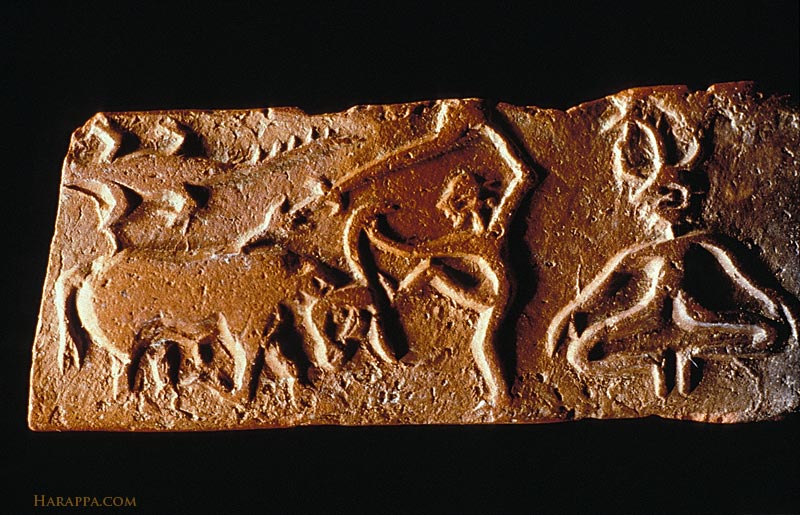 m489B
m489BSlide 89 Plano convex molded tablet showing an individual spearing a water buffalo with one foot pressing the head down and one arm holding the tip of a horn. A gharial is depicted above the sacrifice scene and a figure seated in yogic position, wearing a horned headdress, looks on. The horned headdress has a branch with three prongs or leaves emerging from the center.
Dimensions: 3.91 length, 1.5 to 1.62 cm width
Harappa, Lot 4651-01
Harappa Museum, H95-2486
Meadow and Kenoyer 1997 karA 'crocodile' Rebus: khAr 'blacksmith' (Kashmiri)
See: http://bharatkalyan97.blogspot.in/2016/03/indus-script-hieroglyph-narrative-of.html
The rebus readings of hypertext on Side A of the two tablets of Harappa are: kāṇī ʻone -- eyedʼ (feminine) rebus: kārṇī 'Supercargo' -- a representative of the ship's owner on board a merchant ship, responsible for overseeing the cargo and its sale. By denoting six curls on locks of hair, the word suggested is Ara 'six' rebus read together with kārṇī + Ara = kaṇṇahāra -- m. ʻhelmsman, sailorʼ. Thus, the hieroglyph of the six-locks of hair on woman signifies a 'helmsman + Supercargo'.
She is thwarting two rearing tigers: dula 'two' rebus: dul 'cast metal' PLUS kola 'tiger' rebus: kol 'working in iron' kolhe 'smelter' PLUS taTu 'thwart' rebus: dhatu 'mineral'. Thus, 'mineral smelter'. Together the hieroglyph-multiplex or hypertext of a woman thwarting two tigers signifies: 'helmsman, supercargo of metal casting products from mineral smelter'.
What minerals? The top hieroglyph is a spoked wheel; the bottom hieroglyph is an elephant. They signify copper and iron minerals. eraka 'nave of wheel'rebus: eraka 'moltencast, copper' karibha 'trunk of elephant' ibha 'elephant' rebus: karba 'iron' ib 'iron.
Thus the entire narrative on Side A of the Harappa tablets signifies 'helmsnan, supercargo of products from copper and iron mineral smelters.
See: http://bharatkalyan97.blogspot.in/2016/06/evidence-of-masted-sail-boat-of-mohenjo.html
kāṇī m. ʻone-eyed' rebus: kārṇī m. ʻ prime minister, supercargo of a shipʼ
Itihāsa. Kernunnos, kárṇaka 'helmsman' karṇika 'scribe, accountant' venerated, adored as Tvaṣṭṛ triśiras
https://tinyurl.com/y79ngunl
This is an addendum to: kárṇaka 'helmsman' karṇika 'scribe, accountant' of Indus Script is Kernunnos venerated, adored as Tvaṣṭṛ triśiras, a horned artisan architect, metalworker smith https://tinyurl.com/yav9oxk3
Hieroglyph: stag: N. dāre ʻ tusked, male (of stag) ʼ; -- S. ḍ̠āṛhaṇu ʻ to bite ʼ; Ku. dāṛaṇo ʻ to bite, injure ʼ. -- X
 Cernunnos + stag vomiting coins. Luxembourg. The coins discharged signify wealth-creation associated with Kernunnos. The rebus reading of dhāi 'stag'rebus: dhāi 'mineral ore' indicates the metalwork process of creating wealth as an artisan working with mineral ores.
Cernunnos + stag vomiting coins. Luxembourg. The coins discharged signify wealth-creation associated with Kernunnos. The rebus reading of dhāi 'stag'rebus: dhāi 'mineral ore' indicates the metalwork process of creating wealth as an artisan working with mineral ores.Venerated Trefoil. Mohenjo-daro and Bactrian priests wear तार्प्य Sky Garment of Varuṇa Indus Script signifiers of dhā̆vaḍ potr̥, 'smelter, purifier priest'
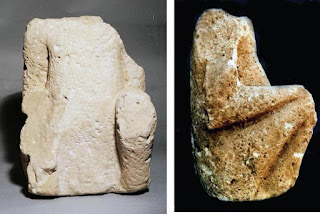 Dholavira. Stone statue.
Dholavira. Stone statue. (After Ardeleanu-Jansen, A., 'The sculptural art of the Harappan culture' in M Jansen et al, ed., Forgotten cities on the Indus: early cvilization in Pakistan from the 8th to the 2nd millennium BCE, Mainz: Verlag Philipp von Zabern, 1991.)![]() Trefoil designs on the shawl garment of the 'priest' Mohenjo-daro statue. The left shoulder is covered with a cloak decorated with trefoil, double circle and single circle designs that were originally filled with red pigment. Drill holes in the center of each circle indicate they were made with a specialized drill and then touched up with a chisel. Material: white, low fired steatiteDimensions: 17.5 cm height, 11 cm width Mohenjo-daro, DK 1909 National Museum, Karachi, 50.852 Marshall 1931: 356-7, pl. XCVIII
Trefoil designs on the shawl garment of the 'priest' Mohenjo-daro statue. The left shoulder is covered with a cloak decorated with trefoil, double circle and single circle designs that were originally filled with red pigment. Drill holes in the center of each circle indicate they were made with a specialized drill and then touched up with a chisel. Material: white, low fired steatiteDimensions: 17.5 cm height, 11 cm width Mohenjo-daro, DK 1909 National Museum, Karachi, 50.852 Marshall 1931: 356-7, pl. XCVIII
Trefoil design on the uttarIyam of the priest, AcArya, PotR. This denotes: three strands of rope: dāmā 'rope' rebus: dhāma ʻreligious conduct'.

"Inlaid bead. No. 53 (L445). (See also Pl. CLII,17) Steatite. An exceptionally fine bead. The interiors of the trefoils were probably filled in with either paste or colour. The former is the more probable, for in the base of each foil there is a small pitting that may been used for keying a coloured paste. The depth of the cutting is 0.05 inch. Level, 3 feet below surface. late Period. Found in Chamber 27, Block 4, L Area. The most interesting of these beads are those with the trefoil pattern, which also occurs on the robe worn by the statue pictured in Pl. XCVIII. The trefoils on both the beads and statue are irregular in shape and in this respect differ from the pattern as we ordinarily know it. (For another example of this ornamentation, see the bull illustrated in Jastrow, Civilization of Babylonia and Assyria, pl. liii, and the Sumerian bull from Warka shown in Evans, Palace of Minos, vol. ii, pt. 1, p.261, fig. 156. Sir Arthus Evans has justly compared the trefoil markings on this latter bull with the quatrefoil markings of Minoan 'rytons', and also with the star-crosses on Hathor's cow. Ibid., vol. i, p.513. Again, the same trefoil motif is perhaps represented on a painted sherd from Tchechme-Ali in the environs of Teheran. Mem. Del. en Perse, t.XX, p. 118, fig. 6)."(John Marshall, opcit., p.517)
The paper discusses the published fragment of a statuette made of a buff-grey limestone, recently found on the surface of Shahr-i Sokhta (Sistan, Iran) and currently on exhibit in a showcase of the archaeological Museum of Zahedan (Sistan-Baluchistan, Iran). Most probably, it belongs to a sculptural type well known in some sites of Middle and South Asia dating to the late 3rd-early 2nd millennium BCE - a male character sitting on the right heel, with the left hand on the raised left knee, and a robe leaving bare the left shoulder. Preliminary comments on the cultural, historical and chronological implications of this important find are included.
https://www.sciencedirect.com/science/article/pii/S23522267173

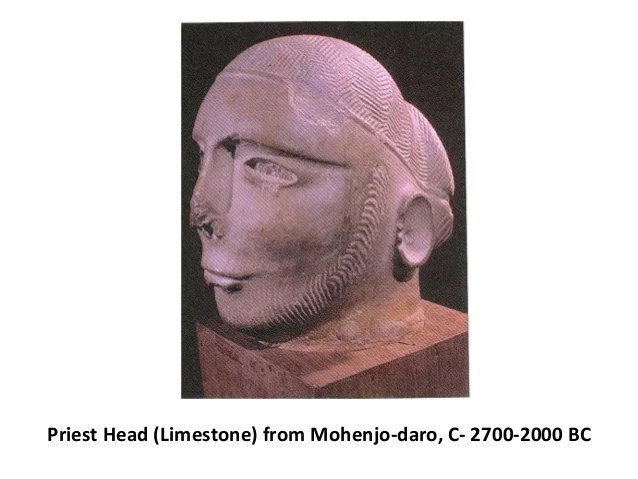
 Mohenjo-daro Seated person (Head missing)
Mohenjo-daro Seated person (Head missing)
![Harappa Terracotta bangle fragments]()

Detail of terracotta bangle with red and white trefoil on a green background (H98-3516/8667-01 from Trench 43). Trefoil motifs are carved on the robe of the so-called "priest-king" statuette from Mohenjo-daro and are also known from contemporary sites in western Pakistan, Afghanistan, and southern Central Asia. Source: https://www.harappa.com/blog/jewelry-mohenjo-daro
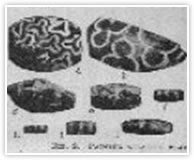 Trefoils painted on steatite beads, Harappa (After Vats, Pl. CXXXIII, Fig.2)
Trefoils painted on steatite beads, Harappa (After Vats, Pl. CXXXIII, Fig.2)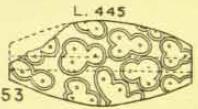
Trefoil Decorated bead. Pl. CXLVI, 53 (Marshall, opcit.)
Hieroglyph-multiplex of dotted circles as 'beads': kandi 'bead' Rebus: kanda 'fire-altar' khaNDa 'metal implements'. Alternative: dotted circles as dice: dhāv, dāya 'one in dice' + vaṭṭa 'circle' rebus धावड dhāvaḍa 'red ferrite ore smelter'
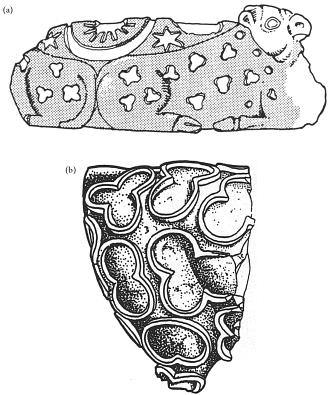
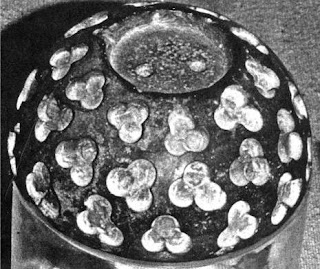
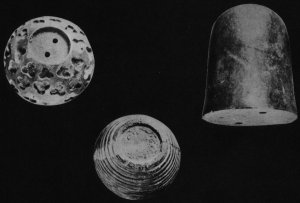
![]()
![]()
![]()
![]()
 composing the trefoil is a semantic determinant of the signified object: smithy, forge.
composing the trefoil is a semantic determinant of the signified object: smithy, forge.Rebus: Soma priest, jeweller's polishing stone
पोतृ pōtṛ " Purifier " , Name of one of the 16 officiating priests at a sacrifice (the assistant of the Brahman (Rigveda) pōtrá
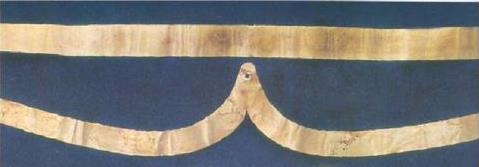

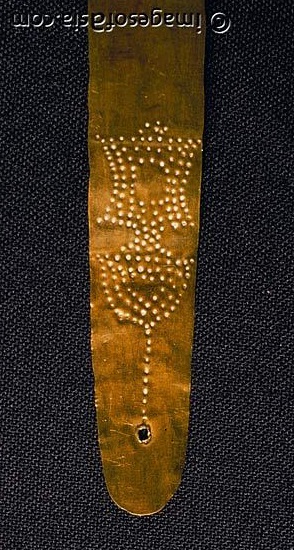 Gold fillet, Mohenjo-daro, with Indus script hypertext of dotted circles, lathe, brazier signify पोतृ purifier priest of kole.l 'smithy, temple'.
Gold fillet, Mohenjo-daro, with Indus script hypertext of dotted circles, lathe, brazier signify पोतृ purifier priest of kole.l 'smithy, temple'.dāntā 'ivory' rebus dhāˊtu 'ore of red colour' (Rigveda)
 Kot Diji type seals with concentric circles from (a,b) Taraqai Qila (Trq-2 &3, after CISI 2: 414), (c,d) Harappa(H-638 after CISI 2: 304, H-1535 after CISI 3.1:211), and (e) Mohenjo-daro (M-1259, aftr CISI 2: 158). (From Fig. 7 Parpola, 2013).
Kot Diji type seals with concentric circles from (a,b) Taraqai Qila (Trq-2 &3, after CISI 2: 414), (c,d) Harappa(H-638 after CISI 2: 304, H-1535 after CISI 3.1:211), and (e) Mohenjo-daro (M-1259, aftr CISI 2: 158). (From Fig. 7 Parpola, 2013).
 Dotted circles and three lines on the obverse of many Failaka/Dilmun seals are read rebus as hieroglyphs:
Dotted circles and three lines on the obverse of many Failaka/Dilmun seals are read rebus as hieroglyphs: Hieroglyph: ḍāv m. ʻdice-throwʼ rebus: dhāu 'ore'; dã̄u ʻtyingʼ, ḍāv m. ʻdice-throwʼ read rebus: dhāu 'ore' in the context of glosses: dhā̆vaḍ m. ʻa caste of iron -smelters', dhāvḍī ʻcomposed of or relating to ironʼ. Thus, three dotted circles signify: tri-dhāu, tri-dhātu 'three ores' (copper, tin, iron).
"The embroidered circles and trefoils as lnages of fireplaces The vedie bãrpya garment, then, as decorated with images of dhisjmyas resembling the circular patterns on the Harappan priest-king’s garment." (Parpola, opcit., p.55) धिष्ण्य m. (f(आ). only RV. iv , 3 , 6 ; n. MBh. i , 7944) a sort of subordinate or side-altar (generally a heap of earth covered with sand on which the fire is placed , and of which 8 are enumerated , viz. besides the आग्नीध्रीय [in the आग्नीध्र] those in the सदस् [see s.v.] belonging to the होतृ , the मैत्रा-वरुण or प्र-शस्तृ , the ब्राह्मणाच्छंसिन् , the पोतृ , नेष्टृ and अच्छा-वाक ; and the मार्जालीय) Br. S3rS. &c (cf. कॢप्त-) &c
The + glyph of Sibri evidence is comparable to the large-sized 'dot', dotted circles and + glyph shown on this Mohenjo-daro seal m0352 with dotted circles repeated on 5 sides A to F. Mohenjo-daro Seal m0352 shows dotted circles in the four corners of a fire-altar and at the centre of the altar together with four raised 'bun' ingot-type rounded features. Rebus readings of m0352 hieroglyphs:dhātu 'layer, strand'; dhāv 'strand, string' Rebus: dhāu, dhātu 'ore'
1. Round dot like a blob -- . Glyph: raised large-sized dot -- (gōṭī ‘round pebble);goTa 'laterite (ferrite ore)2. Dotted circle khaṇḍa ‘A piece, bit, fragment, portion’; kandi ‘bead’;3. A + shaped structure where the glyphs 1 and 2 are infixed. The + shaped structure is kaṇḍ ‘a fire-altar’ (which is associated with glyphs 1 and 2)..Rebus readings are: 1. khoṭ m. ʻalloyʼgoTa 'laterite (ferrite ore); 2. khaṇḍā ‘tools, pots and pans and metal-ware’; 3. kaṇḍ ‘furnace, fire-altar, consecrated fire’.
Four ‘round spot’; glyphs around the ‘dotted circle’ in the center of the composition: gōṭī ‘round pebble; Rebus 1: goTa 'laterite (ferrite ore); Rebus 2:L. khoṭf ʻalloy, impurityʼ, °ṭā ʻalloyedʼ, awāṇ. khoṭā ʻforgedʼ; P. khoṭ m. ʻbase, alloyʼ M.khoṭā ʻalloyedʼ (CDIAL 3931) Rebus 3: kōṭhī ] f (कोष्ट S) A granary, garner, storehouse, warehouse, treasury, factory, bank. khoṭā ʻalloyedʼ metal is produced from kaṇḍ ‘furnace, fire-altar’ yielding khaṇḍā ‘tools, pots and pans and metal-ware’. This word khaṇḍā is denoted by the dotted circles.
![ahar12]() Stepped cross seals with Indus Script hieroglyphs
Stepped cross seals with Indus Script hieroglyphs
![ahar33]() Hieroglyph: eruvai ‘kite’ Rebus: eruvai = copper (Ta.lex.) eraka, er-aka = any metal infusion (Ka.Tu.); erako molten cast (Tu.lex.) Rebus: eraka = copper (Ka.) eruvai = copper (Ta.); ere – a dark-red colour (Ka.)(DEDR 817). eraka, era, er-a = syn. erka, copper, weapons (Ka.) The central dot in the cross (which signifies a fire-altar) is: goTa ’round’ Rebus: khoT ‘ingot’. gaNDA ‘four’ rebus: kanda.’fire-altar’.khamba ‘wing’ rebus: kammaTa ‘mint’. (s)phaṭa-, sphaṭā- a serpent's expanded hood, Pkt. phaḍā id. rebus: phaḍā, paṭṭaḍa 'metals manufactory'.
Hieroglyph: eruvai ‘kite’ Rebus: eruvai = copper (Ta.lex.) eraka, er-aka = any metal infusion (Ka.Tu.); erako molten cast (Tu.lex.) Rebus: eraka = copper (Ka.) eruvai = copper (Ta.); ere – a dark-red colour (Ka.)(DEDR 817). eraka, era, er-a = syn. erka, copper, weapons (Ka.) The central dot in the cross (which signifies a fire-altar) is: goTa ’round’ Rebus: khoT ‘ingot’. gaNDA ‘four’ rebus: kanda.’fire-altar’.khamba ‘wing’ rebus: kammaTa ‘mint’. (s)phaṭa-, sphaṭā- a serpent's expanded hood, Pkt. phaḍā id. rebus: phaḍā, paṭṭaḍa 'metals manufactory'.
![]() Artifacts from Jiroft.
Artifacts from Jiroft.
![]()
Ivory combs. Turkmenistan.
![]()
![]()
Ivory objects. Sarasvati Civilization
![]()
![]()
Tablets.Ivory objects. Mohenjo-daro.
Ivory rod, ivory plaques with dotted circles. Mohenjo-daro (Musee National De Arts Asiatiques, Guimet, 1988-1989, , Les cites oubliees de l’Indus Archeologie du Pakistan.] dhātu '
फडझडती (p. 313) phaḍajhaḍatī f sometimes फडझाडणी f A clearing off of public business (of any business comprehended under the word फड q. v.): also clearing examination of any फड or place of public business.
फड (p. 313) phaḍa m ( H) A place of public business or public resort; as a court of justice, an exchange, a mart, a counting-house, a custom-house, an auction-room: also, in an ill-sense, as खेळण्या- चा फड A gambling-house, नाचण्याचा फड A nach house, गाण्याचा or ख्यालीखुशा
phaḍa फड ‘manufactory, company, guild, public office’, keeper of all accounts, registers.फडपूस (p. 313) phaḍapūsa f (फड & पुसणें) Public or open inquiry. फडफरमाश or स (p. 313) phaḍapharamāśa or sa f ( H & P) Fruit, vegetables &c. furnished on occasions to Rajas and public officers, on the authority of their order upon the villages; any petty article or trifling work exacted from the Ryots by Government or a public officer. फडनिविशी or सी (p. 313) phaḍaniviśī or sī & फडनिवीस Commonly फड- निशी & फडनीस. फडनीस (p. 313) phaḍanīsa m ( H) A public officer,--the keeper of the registers &c. By him were issued all grants, commissions, and orders; and to him were rendered all accounts from the other departments. He answers to Deputy auditor and accountant. Formerly the head Kárkún of a district-cutcherry who had charge of the accounts &c. was called फडनीस. फडकरी (p. 313) phaḍakarī m A man belonging to a company or band (of players, showmen &c.) 2 A superintendent or master of a फड or public place. See under फड. 3 A retail-dealer (esp. in grain).
फडझडती (p. 313) phaḍajhaḍatī f sometimes फडझाडणी f A clearing off of public business (of any business comprehended under the word फड q. v.): also clearing examination of any फड or place of public business.
फड (p. 313) phaḍa m ( H) A place of public business or public resort; as a court of justice, an exchange, a mart, a counting-house, a custom-house, an auction-room: also, in an ill-sense, as खेळण्या- चा फड A gambling-house, नाचण्याचा फड A nach house, गाण्याचा or ख्यालीखुशालीचा फड A singing shop or merriment shop. The word expresses freely Gymnasium or arena, circus, club-room, debating-room, house or room or stand for idlers, newsmongers, gossips, scamps &c. 2 The spot to which field-produce is brought, that the crop may be ascertained and the tax fixed; the depot at which the Government-revenue in kind is delivered; a place in general where goods in quantity are exposed for inspection or sale. 3 Any office or place of extensive business or work, as a factory, manufactory, arsenal, dock-yard, printing-office &c. 4 A plantation or field (as of ऊस, वांग्या, मिरच्या, खरबुजे &c.): also a standing crop of such produce. 5 fig. Full and vigorous operation or proceeding, the going on with high animation and bustle (of business in general). v चाल, पड, घाल, मांड. 6 A company, a troop, a band or set (as of actors, showmen, dancers &c.) 7 The stand of a great gun. फड पडणें g. of s. To be in full and active operation. 2 To come under brisk discussion. फड मारणें- राखणें-संभाळणें To save appearances, फड मारणें or संपादणें To cut a dash; to make a display (upon an occasion). फडाच्या मापानें With full tale; in flowing measure. फडास येणें To come before the public; to come under general discussion.


 Artifacts from Jiroft.
Artifacts from Jiroft.
Ivory combs. Turkmenistan.


Ivory objects. Sarasvati Civilization


Tablets.Ivory objects. Mohenjo-daro.
 Circular seal, of steatite, from Bahrein, found at Lothal.
Circular seal, of steatite, from Bahrein, found at Lothal.See:
 Mesopotamian lama deity, a bull with a human head, kind, protective spirits associated with the great sun god Shamash. In one inscription, an Assyrian king called upon lama deities to "turn back an evil person, guard the steps, and secure the path of the king who fashioned them." 2100-2000 BCE Serpentine, a smooth green stone the color of life-giving water in a desert area. The hollowed-out shapes on the body originally were inlaid with pearly shell or lapis lazuli.
Mesopotamian lama deity, a bull with a human head, kind, protective spirits associated with the great sun god Shamash. In one inscription, an Assyrian king called upon lama deities to "turn back an evil person, guard the steps, and secure the path of the king who fashioned them." 2100-2000 BCE Serpentine, a smooth green stone the color of life-giving water in a desert area. The hollowed-out shapes on the body originally were inlaid with pearly shell or lapis lazuli.![Bovine head rhyton]() Crete. Cow-head rhython with trefoil decor.
Crete. Cow-head rhython with trefoil decor.
1 G. Contenau, Manual d'archeologie orientale, II, Paris, 1931, p. 698-9.2 ibid. and A. Evans, the Palace of Mines, II, 1928, p. 2613 The Babylonian Legends of the Creation (Brit. Mus. 1931), p. 59; Antiquaries Journal, III, 1923, p.3314 Evans, op cit. I, 1921, pp. 513-145 ibid. IV, 1935, p. 315
miṇḍāl markhor (Tor.wali) meḍho a ram, a sheep (G.)(CDIAL 10120)Rebus: meḍ (Ho.); mẽṛhet ‘iron’ (Mu.Ho.)mẽṛh t iron; ispat m. = steel; dul m. = cast iron (Munda)
 Crete. Cow-head rhython with trefoil decor.
Crete. Cow-head rhython with trefoil decor. Late Harappan Period dish or lid with perforation at edge for hanging or attaching to large jar. It shows a Blackbuck antelope with trefoil design made of combined circle-and-dot motifs, possibly representing stars. It is associated with burial pottery of the Cemetery H period, dating after 1900 BC. Credit Harappa.com
Late Harappan Period dish or lid with perforation at edge for hanging or attaching to large jar. It shows a Blackbuck antelope with trefoil design made of combined circle-and-dot motifs, possibly representing stars. It is associated with burial pottery of the Cemetery H period, dating after 1900 BC. Credit Harappa.com
[p= 514,3] m. pl. N. of a class of superhuman beings MBh.; abode (Samskrtam) This may explain the significance of three dotted circles (trefoil) on the couch of Tuutankhamun with damkom bull calves signified on the couch.Evolution ḍha-, dha- in Brahmi script syllables are evocative of 'string' and 'circle, dotted circle' as may be seen from the following orthographic evidence of epigraphs dated from ca. 300 BCE:
Sumerian marble calf with inlaid trefoils of blue stone. From the late Uruk era, Jemdet Nasr cira 3300 - 2900 B.C.E 5.3 cm. long; Vorderasiatisches Museum, Berlin; Parpola, 1994, p. 213. Trefoil inlay decorated on a bull calf. Uruk (W.16017) ca. 3000 BCE.
kõdā 'young bull calf' Rebus: kõdā 'turner-joiner' (forge); kundaṇa 'fine gold'.
2. Pk. potta -- , ˚taga -- , ˚tia -- n. ʻ cotton cloth ʼ, pottī -- , ˚tiā -- , ˚tullayā -- , puttī -- f. ʻ piece of cloth, man's dhotī, woman's sāṛī ʼ, pottia -- ʻ wearing clothes ʼ; S. potī f. ʻ shawl ʼ, potyo m. ʻ loincloth ʼ; L. pot, pl. ˚tã f. ʻ width of cloth ʼ; P. potṛā m. ʻ child's clout ʼ, potṇā ʻ to smear a wall with a rag ʼ; N. poto ʻ rag to lay on lime -- wash ʼ, potnu ʻ to smear ʼ; Or. potā ʻ gunny bag ʼ; OAw. potaï ʻ smears, plasters ʼ; H. potā m. ʻ whitewashing brush ʼ, potī f. ʻ red cotton ʼ, potiyā m. ʻ loincloth ʼ, potṛā m. ʻ baby clothes ʼ; G. potn. ʻ fine cloth, texture ʼ, potũ n. ʻ rag ʼ, potī f., ˚tiyũ n. ʻ loincloth ʼ, potṛī f. ʻ small do. ʼ; M. pot m. ʻ roll of coarse cloth ʼ, n. ʻ weftage or texture of cloth ʼ, potrẽ n. ʻ rag for smearing cowdung ʼ.3. Pa. potthaka -- n. ʻ cheap rough hemp cloth ʼ, potthakamma -- n. ʻ plastering ʼ; Pk. pottha -- , ˚aya -- n.m. ʻ cloth ʼ; S. potho m. ʻ lump of rag for smearing, smearing, cloth soaked in opium ʼ.4. Pa. ponti -- ʻ rags ʼ.5. Wg. pōč ʻ cotton cloth, muslin ʼ, Kt. puč; Pr. puč ʻ duster, cloth ʼ, pūˊčuk ʻ clothes ʼ; S. poco m. ʻ rag for plastering, plastering ʼ; P. poccā m. ʻ cloth or brush for smearing ʼ, pocṇā ʻ to smear with earth ʼ; Or. pucā̆ra, pucurā ʻ wisp of rag or jute for whitewashing with, smearing with such a rag ʼ.(CDIAL 8400)
See: https://tinyurl.com/y85goask Wealth of a nation...
Trefoil decorated bull; traces of red pigment remain inside the trefoils. Steatite statue fragment. Mohenjo-daro (Sd 767). After Ardeleanu-Jansen, 1989: 196, fig. 1; cf. Parpola, 1994, p. 213. Trefoils painted on steatite beads. Harappa (After Vats. Pl. CXXXIII, Fig. 2) Trefoil on the shawl of the priest. Mohenjodaro. The discovery of the King Priest acclaimed by Sir John Marshall as “the finest piece of statuary that has been found at Moenjodaro….draped in an elaborate shawl with corded or rolled over edge, worn over the left shoulder and under the right arm. This shawl is decorated all over with a design of trefoils in relief interspersed occasionally with small circles, the interiors of which are filled with a red pigment “. Gold fillet with ‘standard device’ hieroglyph. Glyph ‘hole’: pottar, பொத்தல் pottal, n. < id. [Ka.poṭṭare, Ma. pottu, Tu.potre.] trika, a group of three (Skt.) The occurrence of a three-fold depiction on a trefoil may thus be a phonetic determinant, a suffix to potṛ as in potṛka.
"Seated male sculpture, or "Priest King" from Mohenjo-daro. Fillet or ribbon headband with circular inlay ornament on the forehead and similar but smaller ornament on the right upper arm. The two ends of the fillet fall along the back and though the hair is carefully combed towards the back of the head, no bun is present. The flat back of the head may have held a separately carved bun as is traditional on the other seated figures, or it could have held a more elaborate horn and plumed headdress. Two holes beneath the highly stylized ears suggest that a necklace or other head ornament was attached to the sculpture. The left shoulder is covered with a cloak decorated with trefoil, double circle and single circle designs that were originally filled with red pigment. Drill holes in the center of each circle indicate they were made with a specialized drill and then touched up with a chisel. Eyes are deeply incised and may have held inlay. The upper lip is shaved and a short combed beard frames the face. The large crack in the face is the result of weathering or it may be due to original firing of this object.Material: white, low fired steatite
Dimensions: 17.5 cm height, 11 cm widthMohenjo-daro, DK 1909National Museum, Karachi, 50.852Marshall 1931: 356-7, pl. XCVIII" (Jonathan Mark Kenoyer) https://www.harappa.com/slide/priest-king-mohenjo-daro
The Bactrian vase shows floating figures of seated men wearing tārpya garment which signifies the seated men to be manes. The presence of a fire-altar and an octagonal pillar in Binjor (Anupgarh) on the banks of River Sarasvati signifies the performance of a yajna. The presence of a seal with Indus Script signifying metalwork catalogues, wealth-accounting ledger attests to this archaeological site to be a Veda cultural site of ca. 2500 BCE. (तृपा f. N. of a plant (शतपथ-ब्राह्मण v , 3 , 5 , 20 Sāyaṇa) The priests shown on the Bactrian vase are 'floating figuress' because they were the Sky Garment of Varuṇa.
|
“Ardeeeleanu-Jansen’s Reconstruction. Ardeleanu-Jansen has recreated an interesting reconstruction of the priest-king as a statue of a seated man with his left leg raised and bent at the knee (Figure 6.7). This is a posture assumed by other statuary found at Mohenjo-daro; one of which I have named the ‘Seated Man’, another, the ‘Sad Man’, as well as figures from Bactria (Figure 6.8). Parpola's thoughts. A. Parpola attempts to demonstrate that the robe of the priest-king is something called the tārpya, found in Vedic ritual and said to be the garment of the divine king Varuna. Parpola postulates that this statue is a representation of a seated deity, which had an elaborate, changeable headdress of the type he proposes is found on the Mahayogi seal...The Seated Man (L-950). A headless seated male statue made of gray alabaster was found by Mackay at L Area on the southern half of the mound of the Great Bath. It has been attributed to the Late Period (Figure 6.5)…This is the one statue from Mohenjo-daro that clearly is seated and costumed in the same manner as those seen in Bactrian art (Figure 8), and the pose has been proposed by Ardeleanu-Jansen for the priest-king. This admits the possibility that the Mohenjo-daro representations are of Bactrians. The men on the Bactrian vase are ‘floating’ in the sky above other men behind plows being pulled by Bos Taurus, not the Indian zebu. Everyone looks perfectly at home. Of course, the dress could be Harappan and the Bactrian vase could represent ‘Harappans’ floating in the sky above the plowmen. But nowhere else in the art of the Mature Harappan do we find this form of dress, so the balance tips a bit toward the notion that the Seated Man from L Area, and the priest-king, if Ardeleanu-Jansen is correct, represent Bactrians at Mohenjo-daro in the Late Period there. This might be late enough to somehow figure in the contacts between the Indus Civilization and the Bactria-Margiana-Archaeological Complex, and the Middle Asian Interaction sphere.” (Gregory L. Possehl, 2002,The Indus Civilization: A Contemporary Perspective, Rowman Altamira, 11-Nov-2002, pp.115-116).
See:Parpola, Asko, 1985. The Sky-Garment: A study of the Harappan religion and its relation to the Mesopotamian and later Indian religions. (Studia Orientalia 57.) Helsinki: The Finnish Oriental Society. 25 cm, 216 pp. + 35 figs.
November 26, 2008
Elamo-Harappan origins for Haplogroup J2 in India? Note: Full text of the cited paper of Sengupta et al 2005 is at https://pdfs.semanticscholar.org/acf0/898d9eebbd3f84a60c7dbca2808da3b00ece.pdf This paper of Sengupta et al concluded: "Overall, therefore, our data provide overwhelming support for an Indian origin of Dravidian speakers." The Abstract noted: "Although considerable cultural impact on social hierarchy and language in South Asia is attributable to the arrival of nomadic Central Asian pastoralists, genetic data (mitochondrial and Y chromosomal) have yielded dramatically conflicting inferences on the genetic origins of tribes and castes of South Asia. We sought to resolve this conflict, using high-resolution data on 69 informative Y-chromosome binary markers and 10 microsatellite markers from a large set of geographically, socially, and linguistically representative ethnic groups of South Asia. We found that the influence of Central Asia on the pre-existing gene pool was minor. The ages of accumulated microsatellite variation in the majority of Indian haplogroups exceed 10,000–15,000 years, which attests to the antiquity of regional differentiation. Therefore, our data do not support models that invoke a pronounced recent genetic input from Central Asia to explain the observed genetic variation in South Asia. R1a1 and R2 haplogroups indicate demographic complexity that is inconsistent with a recent single history. Associated microsatellite analyses of the high-frequency R1a1 haplogroup chromosomes indicate independent recent histories of the Indus Valley and the peninsular Indian region. Our data are also more consistent with a peninsular origin of Dravidian speakers than a source with proximity to the Indus and with significant genetic input resulting from demic diffusion associated with agriculture. Our results underscore the importance of marker ascertainment for distinguishing phylogenetic terminal branches from basal nodes when attributing ancestral composition and temporality to either indigenous or exogenous sources. Our reappraisal indicates that pre-Holocene and Holocene-era—not Indo-European—expansions have shaped the distinctive South Asian Y-chromosome landscape."
Another interesting characteristic in the distribution of M172 and more specifically, M410, in India was its higher frequencies in Upper Caste Dravidians. M410+ chromosomes were found in 13% of Upper Caste Dravidians. Sengupta goes on to suggest an Indian origin of Dravidian speakers but from a Y chromosome perspective, the paper seems to acknowledge M172 arriving in India from Middle Eastern and Indus Valley Civilizations.
Despite an apparent exogenous frequency spread pattern of J2a toward North and Central India from the west, it is premature to attribute the spread to a simplistic demic expansion of early agriculturists from the Middle East....it may also reflect subsequent Bronze Age Harappans of uncertain provenance.
Subclades of M172 such as M67 and M92 were not found in either Indian or Pakistani samples which also might hint at a partial common origin. And while there may be multiple events and origins for M172 lineages in India, it does seem likely that the Indus Valley and Elamo-Dravidian speaking groups may be the origin of some of the M172 found in India today. http://m172.blogspot.com/2008/11/elamo-harappan-origins-for-haplogroup.html
Infusion of carbon to produce crucible ukku (wootz) steel in perforated jars holding iron and plant material
Not all pottery which have hole at the bottom and small holes all over the body of a jar are such strainers.
Some pottery could also have been used for making crucible steel as discussed in an excellent article by Thilo Rehren (reproduced below for ready reference).
Thilo Rehren demonstrates two types of perforated pottery which were used as container-crucibles to produce crucible steel: 1) Central Asia and 2) South Asia and notes: “The metallurgy involved is the same for South and Central Asia, but the ceramic traditions are very different. In South Asia, a black-firing, porous and relatively thick-walled ceramic material was used, probably at the limit of its stability when in use, which allowed only small vessels to be built. In Central Asia, a white-firing, denser and much more refractory (heat-resistant) ceramic material was employed, which enabled more voluminous vessels with slender walls to be built, and hence much larger steel ingots to be produced.”
This is a remarkable insight. I suggest that the perforated pottery found in many sites of Sarasvati Civilization shoule be analysed again to is the perforated pottery are made of black-firing, porous and relatively thick walled ceramic material. If so, such perforated pottery may have been used in making crucible steel by infusion of carbon into liquid iron combined with plant material kept in the crucible.
Veda texts (Śatapatha Brāhmaṇa) refer to a mechanism called caṣāla, a ring of wheat-chall (godhuma) which is kept atop a fiery pillar (yupa or skambha) and the resulting fumes infuse carbon into moltel metal in the fire-altar. Such fumes of wheat-chaff constitute infusion of carbon to make crucible steel with about 3% carbon.
See: Itihāsa. Steelmaking crucibles from South and Central Asia -- Thilo Rehren (2003)
http://bharatkalyan97.blogspot.com/2019/01/itihasa-steelmaking-crucibles-from.html
As similar as black and white: steelmaking crucibles from South and Central Asia
''27. Now there is a pitcher perforated either with a hundred, or with nine, holes. If it is one with a hundred holes,--man lives up to a hundred (years), and has a hundred energies, and a hundred powers: therefore it is perforated with a hundred holes. And if with nine holes,--there are in man those nine vital airs: therefore it is perforated with nine holes.'' http://www.sacred-texts.com/hin/sbr/sbe41/sbe4126.htm
And :
''13. There is a pot (kumbhî) perforated with a hundred holes 1, for in many ways did that (Soma) flow out of (Indra); and a hundred-sized also, indeed, is the sacrifice: it is the sacrifice he thereby secures. There is a bowl (rata 2): it is the real (or good) thing (sat) he thereby secures. There is a dish (kapya) for him to secure food. There is a filter, for they cleanse him, (the Sacrificer, by this offering). There is a tail (-whisk) for turning away evil. There is gold for him to secure form (or colour); it weighs a hundred (grains), for man has a life of a hundred (years) and a hundred energies: life, and energy, vital power, he thus lays into his own self.''
http://www.sacred-texts.com/hin/sbr/sbe44/sbe44066.htm
''87 The pitcher was the father of the rectum by powers, the
womb which first contained the infant.
Plain was the hundred-streaming fount as penis: the jar
poured forth libations to the Father.''
http://www.sacred-texts.com/hin/wyv/wyvbk19.htm
Pa. vaṭṭi -- , ˚ikā -- f. ʻ wick ʼ, Pk. vaṭṭĭ̄ -- , ˚ṭiā -- , vatti -- f.; Sh. batīˊ ʻ unlit native lamp, candle, wick of European lamp ʼ (← H.?); S. vaṭi f. ʻ wick ʼ; L. vaṭṭ f. ʻ roll of grass, wick ʼ, awāṇ. vaṭ ʻ wick ʼ, P. vaṭṭī, ba˚, battī f.; N. bāti ʻ lamp ʼ (bati ← H.), A. bāti; B. bāti ʻ wick, lamp, candle ʼ; Or. bati ʻ lamp ʼ (← H.), Bi. Mth. Bhoj. bātī; OAw. bātĭ̄ ʻ wick ʼ, H. bātī, battī f. (→ N. Or. and prob. Sh.); G. vāṭ f. ʻ lamp ʼ, vātī f. ʻ perfumed match or taper ʼ; M. vāt f. ʻ wick ʼ, Ko. vāti; Si. väṭ -- a ʻ lamp ʼ, väṭi -- ya ʻ wick ʼ; Md. vo'ʻ lamp ʼ; -- with -- o as from an orig. masculine: Ku. bāto m. ʻ wick, lamp ʼ; N. bāto ʻ rope of twisted cane (to tie down thatch) ʼ.
Addenda: várti --
Pa. ukkā -- f. ʻ torch ʼ, Pk. ukkā -- f ʻ meteor, fire -- ball ʼ; B. ūk, ukā ʻ torch ʼ; Or. uka ʻ torch, flash of fire, meteor ʼ, ukiā ʻ sun's rays ʼ; Mth. ūk ʻ torch ʼ; H. ūk m. ʻ torch, blaze, meteor ʼ.
1. Pa. jāla -- m. ʻ glow, blaze ʼ, ˚lā f. ʻ flame ʼ; Pk. jāla -- , ˚laya -- m. ʻ flame, fire ʼ, ˚lā -- f. ʻ flame ʼ; Paš. ar. ǰ
2. Bshk. ǰūl ʻ iron lamp ʼ; Ku. jwālo ʻ flame ʼ, N. juwālo, jwālo (ND 226 b 26 wrongly ← Sk.).
Addenda: jvālá -- : Ko. j̈āḷa n.pl. ʻ entry ʼ; -- j̈aḷāra ʻ mosquito ʼ < *jvā̆lā̆kāra -- ?

- Title: A Cylindrical Terracotta Perforated Jar
- Date Created: -2600/-1900
- Location: Lahore Museum, Lahore
- Location Created: Harappa
- Physical Dimensions: 12.2x5.7cm
- Rights: Lahore Museum, Lahore, Pakistan.
- Medium: Terracotta Wheel Modelled (Pottery)
- https://artsandculture.google.com/asset/a-cylindrical-terracotta-perforated-jar/_QFx9ZEcxArY5A

Itihāsa. Archaeology and language of Indus Script, Sarasvati Civilization. Thanks to the leads of Lamberg-Karlovsky on Language of Indo-Iranians.



kuṭi 'tree' rebus: kuṭhi 'smelter'
moraka, 'peacock' rebus: morakkaka (loha) 'calcining metal'.
Gāndhāri, Parsu, Araṭṭa Meluhha artisans & Indus Script evidence for their metalwork in Gonur https://tinyurl.com/ybhlynzk
"The merchants of Gonur and Central Asia could even have been the possible originators of the Silk Roads." -- K.E. Eduljee
I suggest that the settlement of Gonur Tepe was by people from Sarasvati-Sindhu civilization. Parallels between Sarasvati-Sindhu civilization settlements and Gonur settlements are vivid and emphatic, apart from the commonly shared writing system of Indus Script cipher.
The fortified settlements of Gonur Tepe with citadel compare with the layout of Dholavira fortified settlement and citadel with gateway suggesting that the Dholavira artisans migrated to Gonur in search of minerals and settled there for metalwork. The evidence for metalwork of Gonur Tepe is provided by a seal with Indus Script inscription including pictorial motif of an elephant and text message of 8 hieroglyphs/hypertexts deciphered in this monograph.

Dholavira. gateway. A designer's impressions (reconstruction) of the world's first signboard on the gateway of fortification or citadel.
Gonur south complex.

Decipherment of Gonur Tepe Indus Script inscription on seal

Gonur Tepe.Indus Script. Seal, Seal impression. t:


 Distribution of archaeological sites (in red)
Distribution of archaeological sites (in red)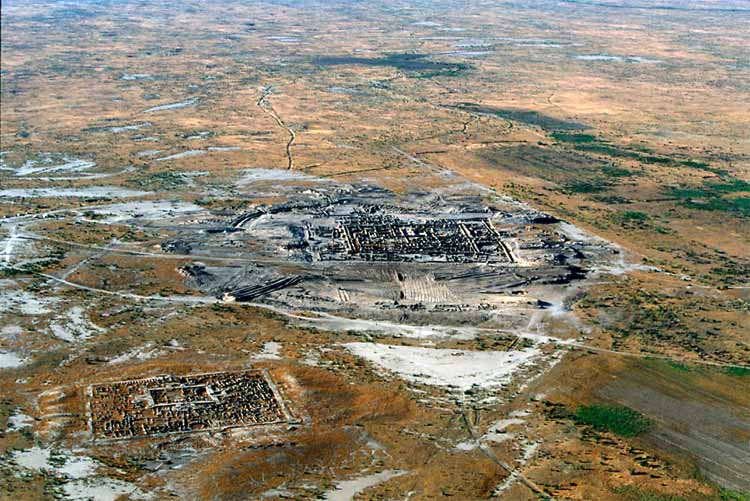

Gonur south complex.


 Artist's reconstruction of the Gonur north complex. Note the successive protective walls with the outer-most surrounding what appear to be dwellings.
Artist's reconstruction of the Gonur north complex. Note the successive protective walls with the outer-most surrounding what appear to be dwellings.

Excavations at Southern Gonur, by V. Sarianidi, 1993, British Institute of Persian Studies.
» Brief History of Researches in Margiana by Museo-on
Other web articles include Discover Magazine, Anahita Gallery, Kar Po's Travel Blog, Dan & Mary's Monastery, Archaeology Online, Turkmenistan June 2006 and Stantours. Generally, we find the quality of research and reports available of the web to be poorly researched, highly speculative and sensationalistic. (Note: All citations from KE Eduljee http://www.heritageinstitute.com/zoroastrianism/merv/gonur.htm)
Gonur excavation
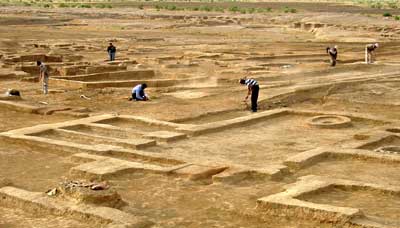


"The next and last shrine excavated is located in the settlement of Togolok 21, which dates to the late 2nd millennium. Taking into account its large overall size (larger than the fortress of South Gonur), it is possible that the shrine of Togolok 21 served the inhabitants of the whole country of Margiana in the late Bronze Age. Similar to the above-described shrines, there is a domestic area near Togolok 21 associated with the shrine. At Gonur depe and Togolok 1 the settlements are many times larger than the shrines, while in Togolok 21 the settlement is a great deal smaller than the shrine itself. "The shrine of Togolok 21 was built at the top of a small natural hill. Along the outer face of the exterior wall are circular and semicircular hollow towers. In the northern part of the wall are two pylons between which a central gateway, supposed to be the entrance to the shrine, is located. The second entrance was built in the middle of the southern wall. The whole inner area was not built up except at the western side where some extremely narrow rooms are located which appear to have had arched ceilings. Their purpose is unclear. Two altar sites located opposite each other in the northern part of the shrine were perhaps used for carrying out ritual ceremonies associated with libations and fire rituals." [unquote] http://www.heritageinstitute.com/zoroastrianism/merv/gonur3.htm#sarianidi
Claims of Viktor Sarianidi about Soma-Haoma processing in Margiana refuted
[Click here for the article by Viktor Sarianidi titled Margiana and Soma-Haomapublished in the electronic Journal of Vedic Studies (EJVS) Vol. 9 (2003) Issue 1d (May 5) and with Jan E.M. Houben of Leiden University as Guest Editor. We note that Sarianidi's references do not include a single authentic Zoroastrian source even though he claims to associate certain findings with Zoroastrianism.]
According to James P. Mallory 1989 & 1997 "... remains of ephedras have also been reported from the temple-fortress complex of Togolok 21 in the Merv oasis (ancient Margiana – Parpola 1988; Meier-Melikyan 1990) along with the remains of poppies. ... In 1990 I received some samples from the site [forwarded by Dr. Fred Hiebert of Harvard University], which were subjected to pollen analysis at the Department of Botany, University of Helsinki. .... The largest amount of pollen was found in the bone tube (used for imbibing liquid?) from Gonur 1, but even in this sample, which had been preserved in a comparatively sheltered position when compared with the other investigated samples, only pollen of the family Caryophyllaceae was present. No pollen from ephedras or poppies was found and even the pollen left in the samples showed clear traces of deterioration (typical in ancient pollen having been preserved in a dry environment in contact with oxygen). Our pollen analysis was carefully checked for any methodological errors, but no inaccuracies were found."
Yet another refutation of Sarianidi's wild and unsubstantiated claims of 1. having found narcotics and 2. associating what he found is found with haoma and thereby a Zoroastrian cult (sic) ritual is found in a journal article of which Jan E.M. Houben of Leiden University, Netherlands [E. Journal of Vedic Studies Vol. 9 (2003) Issue 1c (May 5)]. [Click here for an excerpt of the article by Professor C.C. Bakels titled Report concerning the contents of a ceramic vessel found in the "white room" of the Gonur Temenos, Merv Oasis, Turkmenistan.] Bakels concludes, "The material we examined contained broomcorn millet. This cereal is known from the Merv oasis, at least from the Bronze Age onwards (Nesbitt 1997). The crop plant most probably has its origin in Central Asia, perhaps even in the Aralo-Caspian basin."
Professor Houben states, "After a few months I received messages indicating that no proof could be found of any of the substances indicated by Sarianidi. Rather than hastily sticking to this conclusion, Prof. Bakels made efforts to show the specimens to other paleobotanists whom she met at international professional meetings. At the end of this lengthy procedure, no confirmation could be given of the presence of the mentioned plants in the material that was investigated. The traces of plant-substances rather pointed in the direction of a kind of millet."
Metalwork and artifacts from Gonur
Gonur's Exquisite Artefacts
[quote] The quality, artistry and workmanship of the artefacts unearthed at Gonur has surprised observers. They include intricate jewellery and metalwork incorporating gold, silver, lapis lazuli, and carnelian.
 |
| Necklace with carnelian obsidian beads found in the necropolis at Gonur. Carnelian is a hard reddish translucent semiprecious gemstone that is a variety of chalcedony, a form of banded quartz. Obsidian is a jet-black volcanic glass, chemically similar to granite and formed by the rapid cooling of molten lava. Photo credit: Anna Garner at Flickr. The beads are now part of Anna Garner's collection. |
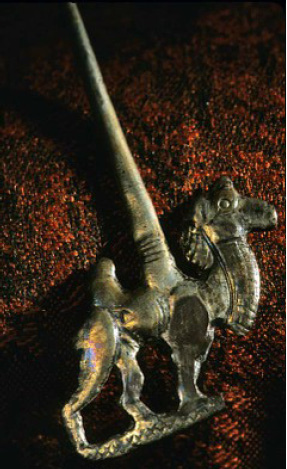 |
| Pin with camel ornament. Photo credit: Katy Tzaralunga at Flickr |
 |
| Fine containers. Photo credit: Katy Tzaralunga at Flickr |
 |
| Artistic wall decorations(?). Photo credit: Katy Tzaralunga at Flickr |
|
 |
| A rich find of pottery at Gonur. Photo credit: josephescu at Flickr |
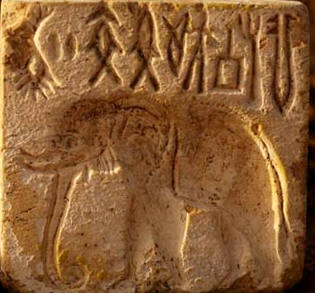 |
| Seal of the type found and used in the Indus Valley |
Wares in this distinctive style had long been found in regions far and near. As close as Gonur's southern neighbour Balkh in today's Afghanistan, and as far as Mesopotamia to the west, the shores of the Persian Gulf to the south, the Russian steppes to the north, and to the southeast across the Hindu Kush - the great cities of Harappa and Mohenjo Daro, which once flourished on the banks of the Indus River in today's Pakistan.
Archaeologists had long puzzled over the origin of the fine artefacts found in the Indus Valley and in the distant lands - artefacts made from materials not native to those areas. The Gonur excavations provide one possible answer: that the items originated in the region around Gonur. For the artefacts to have spread to lands thousands of kilometres apart indicate the presence of an active trade network consisting of artisans, traders, merchants, an extensive road network and possibly even bazaars. It is conceivable that the hub of the network was Central Asia and that Gonur lay at its heart. The merchants of Gonur and Central Asia could even have been the possible originators of the Silk Roads.
That all of this together in an advanced urban setting supported by an irrigated agricultural system was already developed and functioning in the Bronze Age (2500-1700 BCE) is astounding.
Age, People & Culture
"The archaeology of Margiana is fundamentally tied into the Kopet Dag foothill chronological framework of the Namazga culture (see note 1). Of prime importance has been the association of the monumental architecture in Margiana with numerous miniature stone columns, steatite bowls, bronze seals, and stone amulets. None of the materials of these objects is locally available (see note 2), yet they have a style distinctive to the desert oases of Margiana and Bactria. The oasis sites have provided the first known cultural context for the Bactrian-Margiana Archaeological Complex."
After earlier independent work by Soviet archaeologists that would have included Viktor Sarianidi, Hiebert worked with Sarianidi, an effort that resulted in a change of previous conclusions. Hiebert writes, "This study is based on collaborative excavations conducted by V. Sarianidi and myself (our note: misplaced reflective pronoun "myself" here – should be the object pronoun "me") at the Bronze Age site of Gonur Depe in Margiana. It is proposed that the rapid occupation of sites in the Murgab delta oasis was contemporary with the Namazga V settlement in the foothill region, which was the period of largest urban settlement at the site of Altyn Depe (see note 3). The present study proposes that the Bactrian-Margiana Archaeological Complex developed from local traditions at the beginning of the second millennium (our note: say 2,000 – 1,600 BCE see note 4). In contrast to previously suggested reconstructions of the origins of the Bactrian-Margiana Archaeological Complex, I show that this development does not result from migrations from Iran, South Asia, or Mesopotamia, nor from the sedentarization of nomads (see note 5).
"The diverse geography and natural resources of Central Asia form a framework for the pattern of human settlement. The differential development of culture in the areas of oasis and foothill plain is largely due to this diversity of environments.
"The archaeological context of the Bronze Age sites of Margiana is special, in that very little post-Bronze Age architectural remains are preserved just below the surface. The area is highly deflated, leaving little more than the ground plan and a small amount of deposit just above the floors. These have been cleared over wide areas, exposing entire building complexes."
"the oasis regions of ancient Bactria and Margiana developed their own artistic tradition on stone and metal artefacts despite the lack of natural resources on which they were made."
Note (general): It seems the Margians imported the raw material of the artefacts in main part from their southern Arian neighbours, the Bactrians and others, and then fashioned the artefacts for domestic use and export for the artefacts are reported to have been found in the Indus Valley. This activity points to a shared understanding between the Arian nations, a network of roads that connected them and policed to assure safe passage of the travellers, knowledge of tools suitable to work with the properties of different materials, and craft shops if not small factories. Aryan society would have had to be fairly complex, with agriculture supported by a network of canals, cities supported by a water and sewage distribution network, architects, builders of buildings and infrastructure, traders, administrators, a military and laws to govern society and keep the peace.
Note 1: Namazga or Namazgah (meaning prayer-place, "ga" is a contraction of "gah" meaning place) is a Bronze Age archaeological site in Turkmenistan, some 100 km from Ashgabat, near the Iranian border. Numbers in Roman numerals beside the name indicate the age of an excavation layer (at times settlements were rebuilt on top of previous ones). Namazgah IV is dated around 2,500 BCE, V to around 2,000-1,600 BCE, and VI to around 1,600-1,000 BCE.
Note 2: This phenomenon of the discovery of materials not native to an area is a common denominator of the various nations of Ancient Aryana who actively traded amongst themselves.
Note 3: Namazga(h) V is dated to around 2,500 BCE. An article (1989 updated 2011) by V. M. Mason at Iranica states, "The excavations (at Altyn Depe) show continuous development of an early agricultural culture from the 5th to the early 2nd millennium BCE Though a settlement of the Neolithic Jaitun culture (6th millennium BCE) is situated nearby… in the 4th millennium B.C. the inhabited area of Altyn Tepe increased to 12 hectares… at the end of the 4th to the early 3rd millennium B.C., Altyn Tepe covered 25 hectares, acquiring the character of a large inhabited center… Altyn Tepe reached its most flourishing stage at the end of the 3rd-early 2nd millennium B.C. (complex of the Namazga V type), when it was a settlement of the early urban type."
Note 4. Hiebert notes on page 2, "The previous radiocarbon dates from Margiana and from other areas of Central Asia have provided unsatisfactory results for archaeologists." (Hiebert's) "chronology is based primarily on a new series of radiocarbon dates, which came from the Margiana excavations, both from my own excavations and from previous excavations."
The residents of Gonur did not, however, materialize from nowhere. They were residents of the area who built Gonur. We do not know if any lower excavation layers have been found.
Note 5: Saka and Turkic migrations occurred later – after Alexander’s invasion and subsequent occupation weakened the infrastructure. Nomadic raids from the north were constant – thus the fortifications. The raids were for plunder and not for settlement (the nomads had no interest in settling and working for a living).
According to Discover Magazine, "Fredrik Hiebert, a young American graduate student, learned Russian, visited Gonur in 1988, and then a few years later returned with his Harvard adviser, Lamberg-Karlovksy. A team of Italians followed to dig at nearby sites and to examine Gonur's extensive cemetery." [unquote]
Raphael Pumpelly (1837-1923)
Champion of a Central Asian Cradle of Civilization
 |
| Raphael Pumpelly |
Raphael Pumpelly arrived at this conclusion after visiting Central Asia as a geologist and observing the ruins of cities on the ancient shorelines of huge, dried inland seas. By studying the geology of the area, he became one of the first individuals to investigate how environmental conditions could influence human settlement and culture. Pumpelly speculated that a large inland sea in central Asia might have once supported a sizeable population. He knew from his travels and study that the climate in Central Asia had become drier and drier since the time of the last ice age. As the sea began to shrink, it could have forced these people to move west, bringing civilization to westward and to the rest of the world. He hypothesized that the ruins of cities he saw were evidence of a great ancient civilization that existed when Central Asia was more wet and fertile than it is now.
Such assertions that civilization as we know it originated in Central Asia sounded radical at a time when the names of Egypt and Babylon, regions connected to the Bible, were considered to be the cradle of civilization. But Raphael Pumpelly was persistent. Forty years after his first trip to Central Asia, he convinced the newly established Andrew Carnegie Foundation to fund an expedition. Since the Russians controlled Central Asia, he charmed the authorities in Saint Petersburg into granting him permission for an archaeological excavation. The latter even provided Pumpelly with a private railcar. At the age of 65, Pumpelly was given the opportunity to prove his theory and he wasted no time in starting his work.
Anau is a site eight kilometres southeast of Turkmenistan's Ashgabat modern-day capital, Ashgabat, and its name is derived from Abi-Nau, meaning new water. In earlier times, its name was Gathar.
In 1886, a Russian general A. V. Komarov who mistakenly thought the mound was an ancient burial site with treasure worth plundering, had his army brigade cut through the north mound, bisecting the mound. When Pumpelly visited the site in 1903, his training as a geologist enabled him to see twenty stratified occupational layers in this trench. Pumpelly returned to the site in 1904 to start excavations along the Russian trench using sophisticated methods - methods in stark contrast with the plundering dig of the Russians...

Ancient Kopet Dag Foothill Townships
 |
| Archaeological sites along the northern foothills of the Kopet Dag Mountains Image credit: A Central Asian village at the dawn of civilization, excavations at Anau, Turkmenistan by Fredrik Talmage Hiebert, Kakamurad Kurbansakhatov, Hubert Schmidt |
A number of the sites, for instance Altyn depe (#32 above and meaning golden hill), contain artefacts from Harappa in the Indus valley and Sumer / Mesopotamia in the Tigris-Euphrates valley indicating extensive and far-reaching trading along the Silk Roads during the Eneolithic Age (between the late 4th and the late 3rd millennia BCE). (cf. Altyn-Depe by Vadim Mikhailovich Masson and Henry N. Michael, Published by Univ. of Pennsylvania Museum of Archaeology.)
» Altyn-Depe by Vadim Mikhailovich Masson and Henry N. Michael
» Altin / Altyn Depe at Iranica by V. M. Masson
» A Central Asian village at the dawn of civilization, excavations at Anau, Turkmenistan by Fredrik Talmage Hiebert, Kakamurad Kurbansakhatov, Hubert Schmidt
» Historical/Achaeological sites in Turkmenistan


 Bactria Margiana. Silver ceremonial axes.
Bactria Margiana. Silver ceremonial axes. Bactria. Ceremonial axe. British Museum
Bactria. Ceremonial axe. British Museum
 Iran, Luristan bronze Bridle ring with two crouching lions, ca 1200-800 BCE
Iran, Luristan bronze Bridle ring with two crouching lions, ca 1200-800 BCE
 Ceremonial axe (inscribed with name) of king Untash-Napirisha, from his capital Tchoga Zambil. Back of the axe adorned with an electrum boar; the blade issues from a lion's mouth. Silver and electrum, H: 5,9 cm Sb 3973 Louvre, Departement des Antiquites Orientales, Paris, France
Ceremonial axe (inscribed with name) of king Untash-Napirisha, from his capital Tchoga Zambil. Back of the axe adorned with an electrum boar; the blade issues from a lion's mouth. Silver and electrum, H: 5,9 cm Sb 3973 Louvre, Departement des Antiquites Orientales, Paris, FranceOriginally, this would have been fitted to a short haft, or given the large size of it, it may well have been fitted to a long shaft to make a pole arm. A decorative piece, possibly used for feng shui in a building, possibly used as a prop in Chinese opera. Made of carved hardwood with a thick red-brown lacquer finish." http://tigers-den-swords.blogspot.in/2011/09/chinese-wooden-axe-head.html


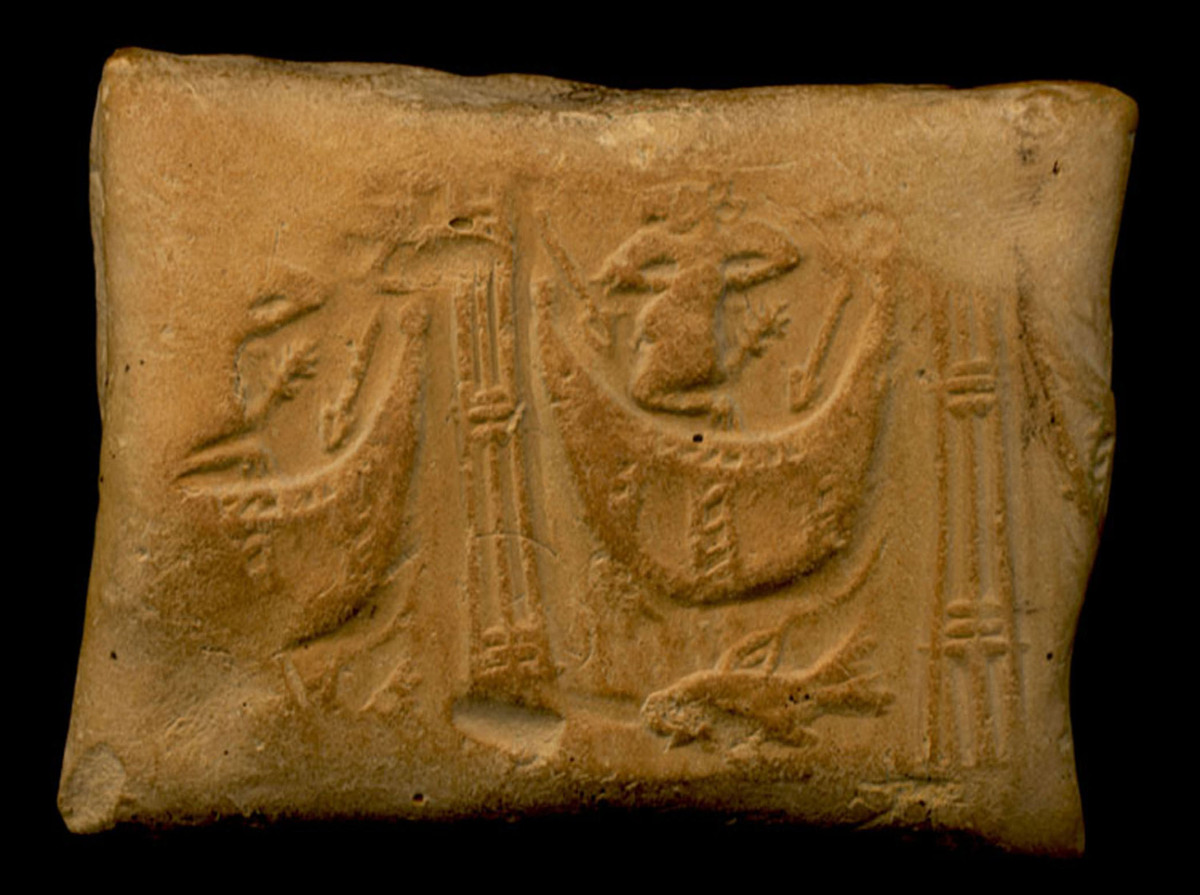
 Tablet Sb04823: receipt of 5 workers(?) and their monthly(?) rations, with subscript and seal depicting animal in boat; excavated at Susa in the early 20th century; Louvre Museum, Paris (Image courtesy of Dr Jacob L. Dahl, University of Oxford) Cited in an article on Reflectance Transformation Imaging (RTI) System. The animal in boat may be a boar and may signify supercargo of wood and iron products. baḍhia = a castrated boar, a hog; rebus: baḍhi ‘a caste who work both in iron and wood’.
Tablet Sb04823: receipt of 5 workers(?) and their monthly(?) rations, with subscript and seal depicting animal in boat; excavated at Susa in the early 20th century; Louvre Museum, Paris (Image courtesy of Dr Jacob L. Dahl, University of Oxford) Cited in an article on Reflectance Transformation Imaging (RTI) System. The animal in boat may be a boar and may signify supercargo of wood and iron products. baḍhia = a castrated boar, a hog; rebus: baḍhi ‘a caste who work both in iron and wood’. 











http://tinyurl.com/hmgm93z
 Inscription. Altyn Depe seal.
Inscription. Altyn Depe seal. Altyn-depe. Silver seal. Pictograph of ligatured animal with three heads.
Altyn-depe. Silver seal. Pictograph of ligatured animal with three heads. Two seals found at Altyn-depe (Excavation 9 and 7) found in the shrine and in the 'elite quarter'
Two seals found at Altyn-depe (Excavation 9 and 7) found in the shrine and in the 'elite quarter'
 Copper hoard including anthropomorphic figures, harpoons, shouldered axes,from Ganga valley, India. The Bactrian find of a hilted sword which compares with the sworf of Fathehgarh may thus be seen as produced by artisans from Ganga valley who migrated to Bactria.
Copper hoard including anthropomorphic figures, harpoons, shouldered axes,from Ganga valley, India. The Bactrian find of a hilted sword which compares with the sworf of Fathehgarh may thus be seen as produced by artisans from Ganga valley who migrated to Bactria. Selected hoard artefacts from 1-2 South Haryana, 3-4 Uttar Pradesh, 5 Madhya Pradesh, 6-8 South Bihar-North Orissa-Bengal. Haryana hoard artefacts are deposited in the Kanya Gurukul Museum of Narela, Haryana.(Paul Yule, The Bronze Age Metalwork of India, Prähistorische Bronzefunde XX,8 (München 1985), http://archiv.ub.uni-heidelberg.de/savifadok/volltexte/2011/1895/ ).
Selected hoard artefacts from 1-2 South Haryana, 3-4 Uttar Pradesh, 5 Madhya Pradesh, 6-8 South Bihar-North Orissa-Bengal. Haryana hoard artefacts are deposited in the Kanya Gurukul Museum of Narela, Haryana.(Paul Yule, The Bronze Age Metalwork of India, Prähistorische Bronzefunde XX,8 (München 1985), http://archiv.ub.uni-heidelberg.de/savifadok/volltexte/2011/1895/ ). Shaft-hole axe head with bird-headed demon, boar, and dragon Period: Bronze Age Date: ca. late 3rd–early 2nd millennium B.C. Geography: Bactria-Margiana Culture: Bactria-Margiana Archaeological Complex Medium: Silver, gold foil Dimensions: L. 15 cm Classification: Metalwork-Implement Description. Ancient Bactria and Margiana were areas along the Oxus and Murghab rivers in modern Uzbekistan, Tajikistan, and Afghanistan. While these areas were sparsely inhabited during much of the third millennium B.C., by about 2200 B.C. permanent settlements with distinctive forms of architecture, burial practices, and material culture had been established, supported in part by active trade with parts of Iran, Mesopotamia, and the Indus Valley.
Shaft-hole axe head with bird-headed demon, boar, and dragon Period: Bronze Age Date: ca. late 3rd–early 2nd millennium B.C. Geography: Bactria-Margiana Culture: Bactria-Margiana Archaeological Complex Medium: Silver, gold foil Dimensions: L. 15 cm Classification: Metalwork-Implement Description. Ancient Bactria and Margiana were areas along the Oxus and Murghab rivers in modern Uzbekistan, Tajikistan, and Afghanistan. While these areas were sparsely inhabited during much of the third millennium B.C., by about 2200 B.C. permanent settlements with distinctive forms of architecture, burial practices, and material culture had been established, supported in part by active trade with parts of Iran, Mesopotamia, and the Indus Valley.Terms borrowed from an otherwise unknown language include those relating to cereal-growing and bread-making (bread, ploughshare, seed, sheaf, yeast), water-works (canal, well), architecture (brick, house, pillar, wooden peg), tools or weapons (axe, club), textiles and garments (cloak, cloth, coarse garment, hem, needle) and plants (hemp, cannabis, mustard, Soma plant).[Michael Witzel, Central Asian Roots and Acculturation in South Asia. Linguistic and Archaeological Evidence from Western Central Asia, the Hindukush and Northwestern South Asia for Early Indo-Aryan Language and Religion. In: T. Osada (ed.), Linguistics, Archaeology and the Human Past (Kyoto : Indus Project, Research Institute for Humanity and Nature 2005), pp. 87-211.]Lubotsky pointed out that the phonological and morphological similarity of 55 loanwords in Proto-Indo-Iranian and in Sanskrit indicates that a substratum of Indo-Iranian and a substratum of Indo-Aryan represent the same language, or perhaps two dialects of the same language. He concludes that the language of the original population of the towns of Central Asia, where Indo-Iranians must have arrived in the second millennium BCE, and the language spoken in Punjab (see Harappan below) were intimately related.[A. Lubotsky, The Indo-Iranian Substratum, in: Early Contacts between Uralic and Indo-European: Linguistic and Archaeological Considerations, ed. Chr. Carpelan, A. Parpola, P.Koskikallio (Helsinki, Suomalais- Ugrilainen Seura 2001), pp. 301-317.]However an alternative interpretation is that 55 loanwords entered common Proto-Indo-Iranian during its development in the Sintashta culture in distant contact with the Bactria–Margiana Archaeological Complex, and then many more words with the same origin enriched Old Indic as it developed among pastoralists who integrated with and perhaps ruled over the declining BMAC.[D.W. Anthony, The Horse, the Wheel and Language (2007), pp. 455-6.
[See also:
F.B.J. Kuiper, Aryans in the Rigveda, (Amsterdam-Atlanta: Rodopi 1991) from which some of these examples are taken.
Lubotsky, Alexander, 2001, The Indo-Iranian substratum. In: Carpelan Christian, Asko Parpola & Petteri Koskikallio, eds,Early contacts between Uralic and Indo-European: Linguistic and Archaeological considerations (papers presented at the international symposium, Tvarminne, 8-10 January, 1999) = Suomalais-Ugrilaisen Seuran Toimituksia, 242. Helsinki: Suomalais-Ugrilainen Seura, pp. 301-317.
Lubotsky pointed out that the phonological and morphological similarity of 55 loanwords in Proto-Indo-Iranian and in Sanskrit indicates that a substratum of Indo-Iranian and a substratum of Indo-Aryan represent the same language, or perhaps two dialects of the same language. He concludes that the language of the original population of the towns of Central Asia, where Indo-Iranians must have arrived in the second millennium BCE, and the language spoken in Punjab (see Harappan below) were intimately related.

The bronze statue of a zebu from marlik tepe,northern Iran- Gilan ca, 1200 -900 BC. تندیس گاو کوهان دار مفرغی ، کشف شده در تپه مارلیک، گیلان، ۱۲۰۰ تا ۹۰۰ پیش از میلاد by:Virtual Museum of Iran Art / موزه مجازی هنر ایران (page on facebook).

Northern Iran, pottery spouted zoomorphic vessel , Marlik- Amlash art ca 1000 B.C. ظرف سفالین به شکل گاو کوهان دار معروف به گاو مارلیک، حدود ۱۰۰۰ پیش از میلاد by:Virtual Museum of Iran Art / موزه مجازی هنر ایران (page on facebook).

Marlik tepe ceramic zebu,, Northern Iran ca 1200-1000 BC, tomb No 18. گاو مارلیک ، شمال ایران، هنر املش، ۱۲۰۰ تا ۱۰۰۰ پیش از میلاد، یافت شده قبر شماره ۱۸ by:Virtual Museum of Iran Art / موزه مجازی هنر ایران (page on facebook).
Tepe Hissar
"The site is notable for its uninterrupted occupational history from the 5th to the 2nd millennium BCE. The quantity and elaborateness of its excavated artifacts and funerary customs position the site prominently as a cultural bridge between Mesopotamia and Central Asia. The human occupation has been divided into three major periods (I, II and III) (Voigt and Dyson 1992). The earliest dating is uncertain but established as after 5000BCE in the Chalcolithic period. This period (Hissar IA and IB) is characterized by mud-bricks buildings and hand-made (IA) and fine wheel-made (IB) ware, decorated with geometric, plant and animal patterns. The most widespread shapes are represented by small cups, bowls and vases. In the second period (Hissar IIA and IIB), dated to the 4th millennium BC and the beginning of the 3rd, the burnished grey ware becomes predominant and the large number of lapis lazuli beads and alabasterfinds, as well as the evidence of large-scale production of copper-based alloys and lead-silver, suggests that the site was playing a very important role in the trade and export of metal artifacts and semi-precious stones from the Middle Asia quarries to Mesopotamia and Egypt. The third period of development (Hissar IIIA, IIIB and IIIC, chronologically attributed to the second half of the 3rd millennium BC and the beginning of the 2nd (Bronze Age), can be described as a proto-urban phase, mainly characterized by increased wealth, demographic concentration, mass production of plain ware and the construction of large public and ceremonial buildings. Among these, the Burned Building of Hissar IIIB phase is worth mentioning. It has been variously interpreted due to the richness of its contents and the presence of burned human bodies and flint arrowheads (Dyson 1972). Firstly interpreted as a fortification, the discovery of a small fire altar suggests that it may be a shrine (Dyson and Remsen 1989). Significant changes happened at the end of the 3rd millennium BC. The well-planned architecture of period Hissar IIIB was abandoned and replaced by the poorly organized structures of the Hissar IIIC period, laid out without regard to the plan of the earlier settlement. Moreover, we can mention the first appearance of truly elite burials, such as those of the so-called “Warriors”, the “Priest” and the “Little Girl” (Schmidt 1933), some of them contained BMAC items such as grooved stone columns." https://en.wikipedia.org/wiki/Tepe_Hissar
"In Hissar I daggers, knife blades, arrowheads, pins, tacks, points, and needles were made. In Hissar II and III copper artifacts increase in quality and variety (Pigott, Howard and Epstein, p. 222) and include personal ornaments (earrings, pendants, bracelets, bands), tools and weapons (bidents, lances, mattocks, chisels, maceheads), and luxury items (vessels, mirrors, boxes and intricately cast pins and rods). Lab study shows “remarkable technological conservatism persisting from Hissar I through III” (Pigott, 1999). In Hissar IIB lead, silver, and gold were added to copper for the first time." http://www.iranicaonline.org/articles/tepe-hissar#
Urals are the world's extant oldest mountain ranges, 250 to 300 million years old. Urals are a source of iron, copper, gold, malachite, alexandrite, and other gems". The Ural Mountains (Russian: Ура́льские го́ры, tr. Uralskiye gory; IPA: [ʊˈralʲskʲɪjə ˈgorɨ]; Bashkir: Урал тауҙары, Ural tauźarı), or simply the Urals, are a mountain range that runs approximately from north to south through western Russia, from the coast of the Arctic Ocean to the Ural River and northwestern Kazakhstan." In Turkic, Bashkir means 'stone belt'; also called Bashkir үр "elevation; upland". In Turkic, oralu- means a "gird or belt.". From the 13th century, in Bashkortostan there has been a legend about a hero named Ural. He sacrificed his life for the sake of his people and they poured a stone pile over his grave, which later turned into the Ural Mountains.(Koriakova, Ludmila & Epimakhov, Andrei (2007). The Urals and Western Siberia in the Bronze and Iron Ages. Cambridge University Press. p. 338).
https://en.wikipedia.org/wiki/Ural_Mountains
Pani and Avesta
 A drachm (quarter shekel) coin from the Persian province of Yehud Medinata, possibly representing Yahweh seated on a winged and wheeled throne. (Edelman, opcit., p.190)
A drachm (quarter shekel) coin from the Persian province of Yehud Medinata, possibly representing Yahweh seated on a winged and wheeled throne. (Edelman, opcit., p.190)[quote]Brahman practised penance. Bhrgu, Atharvan and Angiras were produced by Brahman. Ten Athrvans, and ten Angirasas were born. The Veda recited by them was produced from penance and hence, became superior to other Vedas. The Veda got the names such as Atharvangiras Veda, Bhrgvangiras Veda, Brahma Veda and Atharva Veda. The teaching of the Veda appeals to the deities and supernatural powers residing in the objects of nature. Powers are received from Atharvanic seers, who sought it by their penance and Brahmacarya (practise of Brahman). These seers believed in the enormous power of Rigvedic deities such as Indra, Agni, the Sun, the Moon, the Waters; plants, herbs, amulets, ointments; and deities presiding over human feelings and emotions and good and bad spirits. The seers claim to receive the power in themselves, to benefit mankind. Their activity extended from the Himalayas to the north, Vindhyas in the south, the land of the five rivers in the west, and thick jungles and marshy lands of the east.
Bronze age sites of Iran and Afghanistan

"Archeological research of recent years in southern Turkmenistan has led to the discovery of protourban centers existing there at the end of the third and beginning of the second millennia B.C., whose establishment was the logical culmination of the socioeconomic evolution of the local communities of settled agriculturalists from the sixth to the fourth millennia B.C. Two such centers are known: Namazga-depe at Kaakhka and Altyn-depe at Meana, where systematic excavations have been conducted since 1965 through the joint efforts of the Kara Kum Expedition of the Leningrad Branch of the Archeology Institute, USSR Academy of Sciences, and the Southern Turkmenistan Complex Archeological Expedition of the Turkmenian Academy of Sciences (IuTAKE).1 This work established that Altyn-depe had a complex internal structure with a separate quarter for craftsmen, a religious center with a monumental ziggurat and a tomb for priests alongside it, quarters for ordinary citizens, and an area occupied by the spacious homes of the local elite. From the size of the dwellings, the composition of the meat foods of the inhabitants of the houses, and the grave goods of the associated tombs, it is possible to identify three social groups in the population of Altyn-depe. The materials obtained made it possible to propose that in this instance we are dealing with the most ancient civilization that existed on the territory of the USSR, and one that clearly belonged to the cultural world of the ancient East.2 The culture of Altyn-depe was not a self-contained and isolated phenomenon but was part of the system of early urban civilizations of the Bronze Age, which archeological research during the past decade3 has documented in the broad zone between Mesopotamia and India."
(Masson, VM, 1981, Seals of a Proto-Indian ype from Altyn-depe in: Soviet Anthropology and Archeology, Volume 19 1981 - Issue 1-2, pp. 149-163).
http://www.tandfonline.com/doi/abs/10.2753/AAE1061-1959190102149?journalCode=maae19
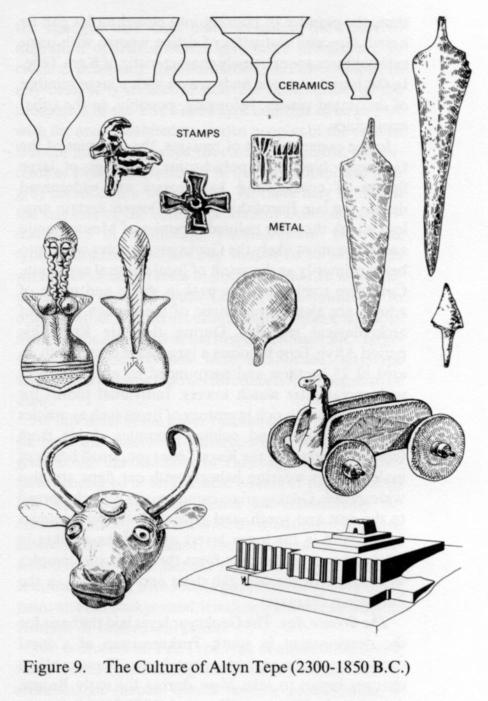
Source: http://www.iranicaonline.org/articles/archeology-v
 Inscription. Altyn Depe seal.
Inscription. Altyn Depe seal. Altyn-depe. Silver seal. Pictograph of ligatured animal with three heads.
Altyn-depe. Silver seal. Pictograph of ligatured animal with three heads. Two seals found at Altyn-depe (Excavation 9 and 7) found in the shrine and in the 'elite quarter'
Two seals found at Altyn-depe (Excavation 9 and 7) found in the shrine and in the 'elite quarter'
kuṭhi ‘vagina’; rebus: kuṭhi ‘smelting furnace bichā 'scorpion' (Assamese). Rebus: bica 'stone ore' as in meṛed-bica = iron stone ore, in contrast to bali-bica, iron sand ore (Mu.lex.) dul 'pair, likeness' Rebus: dul 'cast metal' (Santali) Thus the hieroglyphs connote a smelter for smelting and casting metal stone ore.
strand (of hair): dhāˊtu *strand of rope ʼ (cf. tridhāˊtu -- ʻ threefold ʼ RV.,ayugdhātu -- ʻ having an uneven number of strands ʼ KātyŚr.). [√dhā ]S. dhāī f. ʻ wisp of fibres added from time to time to a rope that is being twisted ʼ, L. dhāī˜ f. (CDIAL 6773)
Rebus: dhāvḍī 'iron smelting': Shgh. ċīw, ċōw, ċū ʻ single hair ʼ ; Ash. dro ʻ woman's hair ʼ, Kt. drū, Wg.drū, drū̃; Pr. ḍui ʻ a hair ʼ; Kho. dro(h) ʻ hair ʼ, (Lor.) ʻ hair (of animal), body hair (human) ʼ: → Orm. dra , drī IIFL i 392 (semant. cf. Psht. pal ʻ fringe of hair over forehead ʼ < *pata -- (CDIAL 6623) drava द्रव [p= 500,3] flowing , fluid , dropping , dripping , trickling or overflowing with (comp.) Ka1t2h. Mn.MBh. Ka1v. fused , liquefied , melted W. m. distilling , trickling , fluidity Bha1sha1p. dhāˊtu n. ʻ substance ʼ RV., m. ʻ element ʼ MBh., ʻ metal, mineral, ore (esp. of a red colour) ʼ Pa. dhātu -- m. ʻ element, ashes of the dead, relic ʼ; KharI. dhatu ʻ relic ʼ; Pk. dhāu -- m. ʻ metal, red chalk ʼ; N. dhāu ʻ ore (esp. of copper) ʼ; Or. ḍhāu ʻ red chalk, red ochre ʼ (whence ḍhāuā ʻ reddish ʼ; M. dhāū, dhāv m.f. ʻ a partic. soft red stone ʼ (whence dhā̆vaḍ m. ʻ a caste of iron -- smelters ʼ, dhāvḍī ʻ composed of or relating to iron ʼ)(CDIAL 6773)
Three lines below the belly of the figure: kolom 'three' rebus: kolimi 'smithy, forge'
Hieroglyph: kuṭhi ‘vagina’ Rebus: kuṭhi ‘smelter furnace’ (Santali) kuṛī f. ‘fireplace’ (H.); krvṛi f. ‘granary (WPah.); kuṛī, kuṛo house, building’(Ku.)(CDIAL 3232) kuṭi ‘hut made of boughs’ (Skt.) guḍi temple (Telugu) kuṭhi ‘a furnace for smelting iron ore to smelt iron’; kolheko kuṭhieda koles smelt iron (Santali) kuṭhi, kuṭi (Or.; Sad. koṭhi) (1) the smelting furnace of the blacksmith; kuṭire bica duljad.ko talkena, they were feeding the furnace with ore; (2) the name of ēkuṭi has been given to the fire which, in lac factories, warms the water bath for softening the lac so that it can be spread into sheets; to make a smelting furnace; kuṭhi-o of a smelting furnace, to be made; the smelting furnace of the blacksmith is made of mud, cone-shaped, 2’ 6” dia. At the base and 1’ 6” at the top. The hole in the centre, into which the mixture of charcoal and iron ore is poured, is about 6” to 7” in dia. At the base it has two holes, a smaller one into which the nozzle of the bellow is inserted, as seen in fig. 1, and a larger one on the opposite side through which the molten iron flows out into a cavity (Mundari) kuṭhi = a factory; lil kuṭhi = an indigo factory (koṭhi - Hindi) (Santali.Bodding) kuṭhi = an earthen furnace for smelting iron; make do., smelt iron; kolheko do kuṭhi benaokate baliko dhukana, the Kolhes build an earthen furnace and smelt iron-ore, blowing the bellows; tehen:ko kuṭhi yet kana, they are working (or building) the furnace to-day (H. koṭhī ) (Santali. Bodding) kuṭṭhita = hot, sweltering; molten (of tamba, cp. uttatta)(Pali.lex.) uttatta (ut + tapta) = heated, of metals: molten, refined; shining, splendid, pure (Pali.lex.) kuṭṭakam, kuṭṭukam = cauldron (Ma.); kuṭṭuva = big copper pot for heating water (Kod.)(DEDR 1668). gudgā to blaze; gud.va flame (Man.d); gudva, gūdūvwa, guduwa id. (Kuwi)(DEDR 1715). dāntar-kuṭha = fireplace (Sv.); kōti wooden vessel for mixing yeast (Sh.); kōlhā house with mud roof and walls, granary (P.); kuṭhī factory (A.); koṭhābrick-built house (B.); kuṭhī bank, granary (B.); koṭho jar in which indigo is stored, warehouse (G.); koṭhīlare earthen jar, factory (G.); kuṭhī granary, factory (M.)(CDIAL 3546). koṭho = a warehouse; a revenue office, in which dues are paid and collected; koṭhī a store-room; a factory (Gujarat) koḍ = the place where artisans work (Gujarati)
Hieroglyph: sprig: ḍāla 5546 ḍāla1 m. ʻ branch ʼ Śīl. 2. *ṭhāla -- . 3. *ḍāḍha -- . [Poss. same as *dāla -- 1 and dāra -- 1 : √dal, √d&rcirclemacr; . But variation of form supports PMWS 64 ← Mu.]1. Pk. ḍāla -- n. ʻ branch ʼ; S. ḍ̠āru m. ʻ large branch ʼ, ḍ̠ārī f. ʻ branch ʼ; P. ḍāl m. ʻ branch ʼ, °lā m. ʻ large do. ʼ, °lī f. ʻ twig ʼ; WPah. bhal. ḍām. ʻ branch ʼ; Ku. ḍālo m. ʻ tree ʼ; N. ḍālo ʻ branch ʼ, A. B. ḍāl, Or. ḍāḷa; Mth. ḍār ʻ branch ʼ, °ri ʻ twig ʼ; Aw. lakh. ḍār ʻ branch ʼ, H. ḍāl, °lām., G. ḍāḷi , °ḷī f., °ḷũ n.2. A. ṭhāl ʻ branch ʼ, °li ʻ twig ʼ; H. ṭhāl, °lā m. ʻ leafy branch (esp. one lopped off) ʼ.3. Bhoj. ḍāṛhī ʻ branch ʼ; M. ḍāhaḷ m. ʻ loppings of trees ʼ, ḍāhḷā m. ʻ leafy branch ʼ, °ḷī f. ʻ twig ʼ, ḍhāḷā m. ʻ sprig ʼ, °ḷī f. ʻ branch ʼ.*ḍāla -- 2 ʻ basket ʼ see *ḍalla -- 2 .ḍālima -- see dāḍima -- .*ḍāva -- 1 ʻ box ʼ see *ḍabba -- .*ḍāva -- 2 ʻ left ʼ see *ḍavva -- .Addenda: ḍāla -- 1 . 1. S.kcch. ḍār f. ʻ branch of a tree ʼ; WPah.kṭg. ḍāḷ m. ʻ tree ʼ, J. ḍā'l m.; kṭg. ḍaḷi f. ʻ branch, stalk ʼ, ḍaḷṭi f. ʻ shoot ʼ; A. ḍāl(phonet. d -- ) ʻ branch ʼ AFD 207.टाळा (p. 196) ṭāḷā ...2 Averting or preventing (of a trouble or an evil). 3 The roof of the mouth. 4 R (Usually टाहळा) A small leafy branch; a spray or sprig. टाळी (p. 196) ṭāḷī f R (Usually टाहळी) A small leafy branch, a sprig.ढगळा (p. 204) ḍhagaḷā m R A small leafy branch; a sprig or spray. डगळा or डघळा (p. 201) ḍagaḷā or ḍaghaḷā m A tender and leafy branch: also a sprig or spray. डांगशी (p. 202) ḍāṅgaśī f C A small branch, a sprig, a spray. डांगळी (p. 202) ḍāṅgaḷī f A small branch, a sprig or spray. डाहळा (p. 202) ḍāhaḷā लांख esp. the first. 2 (dim. डाहळी f A sprig or twig.) A leafy branch. Pr. धरायाला डाहळी न बसायाला सावली Used.
Rebus: ḍhāla 'large ingot' (Gujarati)
The rebus rendering of dhAU 'mineral' is seen on the following hypertexts of the Gundestrup Cauldron. Persons are seen holding three strands as if to plait into a triveNi 'three-plaited pigtail'. http://bharatkalyan97.blogspot.in/2016/08/indus-script-hieroglyphs-on-artifacts.html See also: https://bharatkalyan97.blogspot.in/2016/08/absurd-suggestion-of-soma-haoma-as.html
![]()
![]()
![]()
![]()
![]() Exterior plate f, with torc-wearing headGlyph of a crocodile and a lying-in woman
Exterior plate f, with torc-wearing headGlyph of a crocodile and a lying-in woman


kut.hi = pubes. kola ‘foetus’ [Glyph of a foetus emerging from pudendum muliebre on a Harappa tablet.]kut.hi = the pubes (lower down than pan.d.e) (Santali.lex.) kut.hi = the womb, the female sexual organ; sorrege kut.hi menaktaea, tale tale gidrakoa lit. her womb is near, she gets children continually (H.kot.hi_, the womb) (Santali.Bodding)
 The squatting woman on the Ur cylinder seal impression may be showing dishevelled hair providing for rebus reading: <rabca?>(D) {ADJ} ``with ^dishevelled ^hair''. Rebus: రాచ (adj.) Pertaining to a stone. bicha, bichā ‘scorpion’ (Assamese) Rebus: bica ‘stone ore’ (Mu.) sambr.o bica = gold ore (Mundarica) Thus, the reading of the Ur cylinder seal impression may depict: meṛed-bica ‘iron stone-ore’ kuṭhi‘smelter, furnace’.
The squatting woman on the Ur cylinder seal impression may be showing dishevelled hair providing for rebus reading: <rabca?>(D) {ADJ} ``with ^dishevelled ^hair''. Rebus: రాచ (adj.) Pertaining to a stone. bicha, bichā ‘scorpion’ (Assamese) Rebus: bica ‘stone ore’ (Mu.) sambr.o bica = gold ore (Mundarica) Thus, the reading of the Ur cylinder seal impression may depict: meṛed-bica ‘iron stone-ore’ kuṭhi‘smelter, furnace’.


| uttarāpathaBuddhist Dictionary of Pali Proper Names by G P Malalasekera |
|---|
| Uttarāpatha:The northern division of Jambudīpa.Its boundaries are nowhere explicitly stated in Pāli literature.It has been suggested (See Law,Early Geog.of Bsm.pp.48ff) that Uttarāpatha was originally the name of a great trade-route,the northern high road which extended from Sāvatthi toTakkasilā in Gandhāra,and that it lent its name - as did theDakkhināpatha - to the region through which it passed.If this be so,the name would include practically the whole of Northern India,from Anga in the east to Gandhāra in the north-west,and from the Himālaya in the north to the Vindhyā in the south. According to the brahmanical tradition,as recorded in the Kāvyamīmāmsā (p.93),the Uttarāpatha is to the west of Prithudaka (Pehoa,about fourteen miles west of Thāneswar). The chief divisions included in this territory are mentioned in the Pāli literature as Kasmīra-Gandhāra andKamboja.This region was famous from very early times for its horses and horse-dealers (See,e.g.Vin.iii.6; Sp.i.175),and horses were brought down for sale from there to such cities as Benares (J.ii.287). In Uttarāpatha was Kamsabhoga,where,in the city of Asitañjana,King Mahākamsa reigned (J.iv.79).The Divyāvadana (p.470) mentions another city,Utpalavatī. According to the Mahāvastu (iii.303),Ukkala,the residence ofTapassu and Bhalluka,was in Uttarāpatha,as well as Takkasilā,the famous university (Mtu.ii.166). There was regular trade between Sāvatthi and Uttarāpatha (PvA.100). Anganika Bhāradvāja had friends in Uttarāpatha (ThagA.i.339). |
Lokesh Chandra argues that Bhallika is a kind of copper enumerated under the eight kinds of Pisakalohani or the metals coming from the Pisaca country, as described in the Vibhaga Athakatha. Could Kamsabhoga be identified with Balkh?

Artifacts of the Bactria-Margiana Archaeological Complex, 2100–1800 BCE: (top left) a sample of BMAC stamp seals, adapted after Salvatori 2000, and Hiebert 1994; (top center)cast silver pin head from Gonur North showing a goddess in a ritual dress, after Klochkov 1998, figure 3; (top right) ceramic female figurines from Gonur North, after Hiebert 1994; (center left) crested shaft-hole axes from the art market, probably from BMAC sites, with a possible horse-head on the lower one, after Aruz 1998, figure 24; and Amiet 1986, figure 167; (center right) a crested axe with eye amulet, and a copper mirror and dagger excavated from Gonur North, after Hiebert 1994; and Sarianidi 1995, figure 22; (bottom) ceramic vessel shapes from Gonur, after Hiebert 1994. (After Fig.16.5 in:
Source: http://erenow.com/ancient/the-horse-the-wheel-and-language/16.html
 Harappa seal. Eagle in flight. Cobras, fire-altar.Text 3235
Harappa seal. Eagle in flight. Cobras, fire-altar.Text 3235
There are two rebus readings of śyena, 'eagle' rebus 1) śeṇvi 'general', 2) sena 'thunderbolt'.
 kambha 'wing' rebus: kammaṭa 'mint' PLUS kola 'tiger' rebus; kol 'working in iron' PLUS baḍhia = a castrated boar, a hog; rebus: baḍhi 'artisans who work both in iron and wood' PLUS śyena, 'eagle' rebus 1) śeṇvi 'general', 2) sena 'thunderbolt'. (i.e. gaṇḍa 'hero' PLUS भेरुण्ड 'formidable').
kambha 'wing' rebus: kammaṭa 'mint' PLUS kola 'tiger' rebus; kol 'working in iron' PLUS baḍhia = a castrated boar, a hog; rebus: baḍhi 'artisans who work both in iron and wood' PLUS śyena, 'eagle' rebus 1) śeṇvi 'general', 2) sena 'thunderbolt'. (i.e. gaṇḍa 'hero' PLUS भेरुण्ड 'formidable')."Bronze Ax Head from Bactria, ca. 2000 BCE.....Bird-headed , boar and dragon, c.2300-1900 BCE.....A Magnificent and Highly Important Bactrian Silver and Gold Foil Shaft.....This shaft-hole axhead is a masterpiece of three-dimensional and relief sculpture. Expertly cast in silver and gilded with gold foil, it depicts a bird-headed hero grappling with a wild boar and a winged dragon. The idea of the heroic bird-headed creature probably came from western Iran, where it is first documented on a cylinder seal impression. The hero's muscular body is human except for the bird talons that replace the hands and feet. He is represented twice, once on each side of the ax, and consequently appears to have two heads. On one side, he grasps the boar by the belly and on the other, by the tusks. The posture of the boar is contorted so that its bristly back forms the shape of the blade. With his other talon, the bird-headed hero grasps the winged dragon by the neck. The dragon, probably originating in Mesopotamia or Iran, is represented with folded wings, a feline body, and the talons of a bird of prey.......Source: Shaft-hole axhead with a bird-headed demon, boar, and dragon [Central Asia (Bactria-Margiana)] (1982.5) | Heilbrunn Timeline of Art History | The Metropolitan Museum of Art."
kola 'tiger' rebus: kol 'working in iron' kolhe 'smelter'pañja 'claw,paw' rebus: pañja 'kiln, furnace'pajhar 'eagle' rebus: pasra 'smithy'eraka 'wing' rebus: eraka 'moltencast, copper' arka 'gold'kambha 'wing' rebus: kammaṭa 'mint'ḍangur 'bull' Rebus: dhangar 'blacksmith'arye 'lion' rebus: āra 'brass'
Field symbol 1: पोळा [ pōḷā ] 'zebu, bos indicus taurus' rebus: पोळा [ pōḷā ] 'magnetite, ferrite ore: Fe3O4'
Field symbol 2: seṇa 'falcon' rebus: seṇa, aśani 'thunderbolt', āhan gar 'blacksmith' PLUS kambha 'wing' rebus: kammaṭa 'mint, coiner, coinage[Metwork catalogues: ferrite ore, blacksmith mint] Alternate titles: sēnāpati m. ʻ leader of an army ʼ AitBr. [sḗnā -- , páti -- ]Pa. sēnāpati -- , °ika -- m. ʻ general ʼ, Pk. sēṇāvaï -- m.; M. śeṇvaī, °vī, śeṇai m. ʻ a class of Brahmans ʼ, Ko. śeṇvi; Si. senevi ʻgeneralʼ.(CDIAL 13589) Vikalpa:eruvai ‘eagle’ rebus: eruvai ‘copper’

http://bharatkalyan97.blogspot.in/2011/09/central-asian-seals-seal-impressions.html
Soma source: from the mountains brught by S'yena



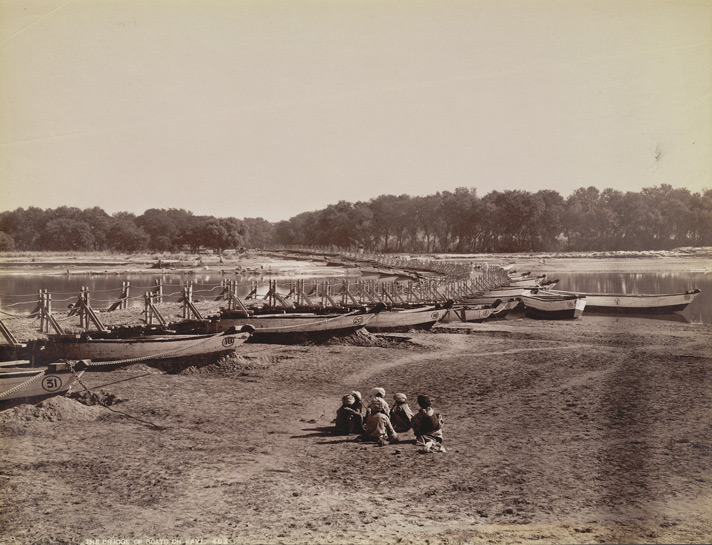

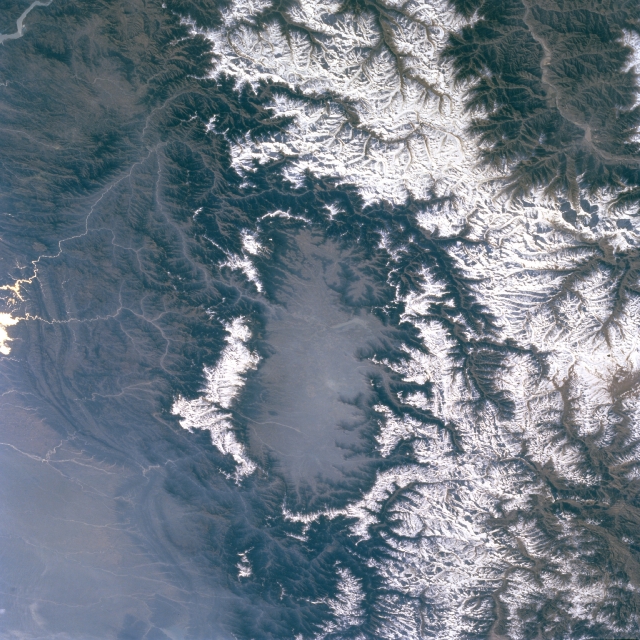


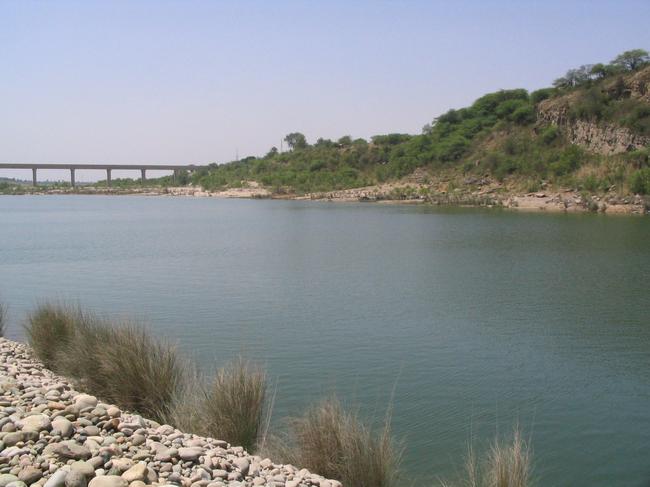
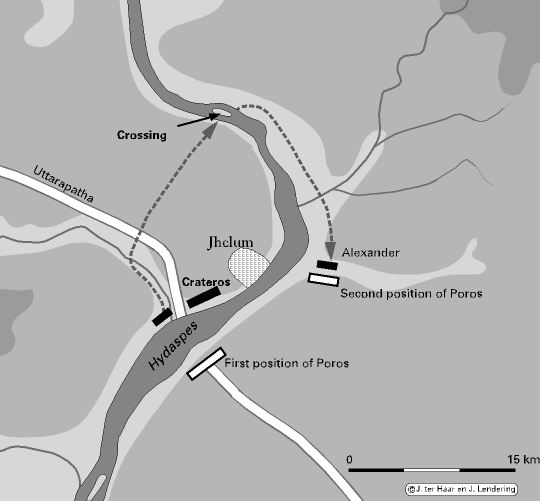
Griffith translation: RV 10.75.1-6 1. THE singer, O ye Waters in Vivasvan's place, shall tell your grandeur forth that is beyond compare. The Rivers have come forward triply, seven and seven. Sindhu in might surpasses all the streams that flow. 2 Varuna cut the channels for thy forward course, O Sindhu, when thou rannest on to win the race. Thou speedest o'er precipitous ridges of the earth, when thou art Lord and Leader of these moving floods. 3 His roar is lifted up to heaven above the earth: he puts forth endless vigour with a flash of light. Like floods of rain that fall- in thunder from the cloud, so Sindhu rushes on bellowing like a bull. 4 Like mothers to their calves, like milch kine with their milk, so, Sindhu, unto thee the roaring rivers run.Thou leadest as a warrior king thine army's wings what time thou comest in the van of these swift streams. 5 Favour ye this my laud, O Ganga, Yamuna, O Sutudri, Parusni and Sarasvati: With Asikni, Vitasta, O Marudvrdha, O Arjikiya with Susoma hear my call. 6 First with Trstama thou art eager to flow forth, with Rasa, and Susartu, and with Svetya here, With Kubha; and with these, Sindhu and Mehatnu, thou seekest in thy course Krumu and Gomati.

Elamite bird (eagle?) with spread wings on an axe head from Tepe Yahya (Lamberg-Karlovsky and Potts 2001: 216).
![]() m0451A
m0451A![]() m0451B
m0451B![]() Text 3235
Text 3235
 Harappa seal. Eagle in flight. Cobras, fire-altar.
Harappa seal. Eagle in flight. Cobras, fire-altar. m1390 Mohenjo-daro seal. Elephant. Eagle in flight.Text.
m1390 Mohenjo-daro seal. Elephant. Eagle in flight.Text.
sēṇa 'eagle' Indus script hieroglyph, senmurv (Ancient Persian) are Ancient Near East intimations of (army) weapon-making, smelting ores. The link of eagle and smelting of the early Bronze Age is evidenced by a Bogazkoy seal with Indus Script inscription.
श्येन [p= 1095,2] m. a hawk , falcon , eagle , any bird of prey (esp. the eagle that brings down सोम to man) RV. &c; firewood laid in the shape of an eagle Śulbas. (Monier-Williams) śyēná m. ʻ hawk, falcon, eagle ʼ RV. Pa. sēna -- , °aka -- m. ʻ hawk ʼ, Pk. sēṇa -- m.; WPah.bhad. śeṇ ʻ kite ʼ; A. xen ʻ falcon, hawk ʼ, Or. seṇā, H. sen, sẽ m., M. śen m., śenī f. (< MIA. *senna -- ); Si. sen ʻ falcon, eagle, kite ʼ.(CDIAL 12674) Rebus: sena 'thunderbolt' (Sinhala):
aśáni f. ʻ thunderbolt ʼ RV., °nī -- f. ŚBr. [Cf. áśan -- m. ʻ sling -- stone ʼ RV.] Pa. asanī -- f. ʻ thunderbolt, lightning ʼ, asana -- n. ʻ stone ʼ; Pk. asaṇi -- m.f. ʻ thunderbolt ʼ; Ash. ašĩˊ ʻ hail ʼ, Wg. ašē˜ˊ, Pr. īšĩ, Bashg. "azhir", Dm. ašin, Paš. ášen, Shum. äˊšin, Gaw. išín, Bshk. ašun, Savi išin, Phal. ã̄šun, L. (Jukes) ahin, awāṇ. &circmacrepsilon;n (both with n, not ṇ), P. āhiṇ, f., āhaṇ, aihaṇ m.f., WPah. bhad. ã̄ṇ, hiṇi f., N. asino, pl. °nā; Si. sena, heṇa ʻ thunderbolt ʼ Geiger GS 34, but the expected form would be *ā̤n; -- Sh. aĩyĕˊr f. ʻ hail ʼ (X ?). -- For ʻ stone ʼ > ʻ hailstone ʼ cf. upala -- and A. xil s.v.śilāˊ -- . (CDIAL 910) vajrāśani m. ʻ Indra's thunderbolt ʼ R. [vájra -- , aśáni -- ]Aw. bajāsani m. ʻ thunderbolt ʼ prob. ← Sk.(CDIAL 11207)eraka ‘wing’ Rebus: eraka ‘moltencast’ garuDa ‘eagle’ Rebus: karaDa ‘hard alloy’; garuDa ‘gold’ (Samskritam)Hieroglyph: eruvai ‘eagle’; synonym: गरुड ‘eagle’ eraka ‘wing’. Rebus: eruvai ‘copper’ (Tamil. Malayalam)+ करडा [ karaḍā ] Hard from alloy–iron, silver &c. erako ‘moltencast’
![ahar12]() Harappa seal h166A, h166B. Vats, 1940, Excavations in Harappa, Vol. II, Calcutta: Pl. XCI. 255
Harappa seal h166A, h166B. Vats, 1940, Excavations in Harappa, Vol. II, Calcutta: Pl. XCI. 255
 Harappa seal h166A, h166B. Vats, 1940, Excavations in Harappa, Vol. II, Calcutta: Pl. XCI. 255
Harappa seal h166A, h166B. Vats, 1940, Excavations in Harappa, Vol. II, Calcutta: Pl. XCI. 255
Ta. eruvai a kind of kite whose head is white and whose body is brown; eagle. Ma. eruva eagle, kite.(DEDR 818). Rebus: eruvai ‘copper’ (Tamil).eṟaka ‘wing’ (Telugu) Rebus: erako ‘molten cast’ (Tulu) loa ‘ficus’; rebus: loh ‘copper’. Pajhar ‘eagle’; rebus: pasra ‘smithy’.Hieroglyph: वज्र[p= 913,1] mfn. shaped like a kind of cross (cf. above ) , forked , zigzag ib. [cf. Zd. vazra , ” a club. “]Rebus: वज्र[p= 913,1] mn. n. a kind of hard iron or steel L. mfn. adamantine , hard , impenetrable W.” the hard or mighty one ” , a thunderbolt (esp. that of इन्द्र , said to have been formed out of the bones of the ऋषिदधीच or दधीचि [q.v.] , and shaped like a circular discus , or in later times regarded as having the form of two transverse bolts crossing each other thus x ; sometimes also applied to similar weapons used by various gods or superhuman beings , or to any mythical weapon destructive of spells or charms , also to मन्यु , ” wrath ” RV. or [with अपाम्] to a jet of water AV. &c ; also applied to a thunderbolt in general or to the lightning evolved from the centrifugal energy of the circular thunderbolt of इन्द्र when launched at a foe ; in Northern Buddhist countries it is shaped like a dumb-bell and called Dorje ; » MWB. 201 ; 322 &c ) RV. &ca diamond (thought to be as hard as the thunderbolt or of the same substance with it) , Shad2vBr. Mn. MBh. &cm. a form of military array , Mn. MBh. &c (cf. -व्यूह)a kind of hard mortar or cement (कल्क) VarBr2S. (cf. -लेप)![ahar16]() Two seals from Gonur 1 in thee Murghab delta; dark brown stone ((Sarianidi 1981 b: 232-233, Fig. 7, 8) eagle engraved on one face. paṛge, (Mu.) baṛak, (Ma.) baṛki, (F-H.) biṛki hood of serpent (Voc. 2154). / Turner, CDIAL, no. 9040, Skt. (s)phaṭa-, sphaṭā- a serpent's expanded hood, Pkt. phaḍā- id. For IE etymology, see Burrow, The Problem of Shwa in Sanskrit, p
Two seals from Gonur 1 in thee Murghab delta; dark brown stone ((Sarianidi 1981 b: 232-233, Fig. 7, 8) eagle engraved on one face. paṛge, (Mu.) baṛak, (Ma.) baṛki, (F-H.) biṛki hood of serpent (Voc. 2154). / Turner, CDIAL, no. 9040, Skt. (s)phaṭa-, sphaṭā- a serpent's expanded hood, Pkt. phaḍā- id. For IE etymology, see Burrow, The Problem of Shwa in Sanskrit, p
Ta. eruvai a kind of kite whose head is white and whose body is brown; eagle. Ma. eruva eagle, kite.(DEDR 818). Rebus: eruvai ‘copper’ (Tamil).
 Two seals from Gonur 1 in thee Murghab delta; dark brown stone ((Sarianidi 1981 b: 232-233, Fig. 7, 8) eagle engraved on one face. paṛge, (Mu.) baṛak, (Ma.) baṛki, (F-H.) biṛki hood of serpent (Voc. 2154). / Turner, CDIAL, no. 9040, Skt. (s)phaṭa-, sphaṭā- a serpent's expanded hood, Pkt. phaḍā- id. For IE etymology, see Burrow, The Problem of Shwa in Sanskrit, p
Two seals from Gonur 1 in thee Murghab delta; dark brown stone ((Sarianidi 1981 b: 232-233, Fig. 7, 8) eagle engraved on one face. paṛge, (Mu.) baṛak, (Ma.) baṛki, (F-H.) biṛki hood of serpent (Voc. 2154). / Turner, CDIAL, no. 9040, Skt. (s)phaṭa-, sphaṭā- a serpent's expanded hood, Pkt. phaḍā- id. For IE etymology, see Burrow, The Problem of Shwa in Sanskrit, pGodavari-Cauvery link. One link in National Water Grid. Congratulations to NaMo team.
Centre to soon take up linking of Godavari and Cauvery: Gadkari
The objective of the project was to make good use of about 1100 tmc ft of Godavari water that currently drained into the sea
Itihāsa. BJP's eastcoast challenge -- Milan Vaishnav, jamie Hintson
INDIA’S EAST COAST BATTLEGROUND


REGIONAL VERSUS REGIONALIST PARTIES




ODISHA

WEST BENGAL

ANDHRA PRADESH
TELANGANA
TAMIL NADU
IMPLICATIONS FOR 2019
Itihāsa. Bull-man hypertext deciphered rebus Meluhha reading helmsman, supercargo, blacksmith, copper smelter, metalcaster workshop.
 Bull-man steatite seal. Harappa.
Bull-man steatite seal. Harappa.dhangra 'bull' rebus: dhangar 'blacksmith'
ఎరక (p. 190) eraka eraka. [Tel.] n. Wing
Horn: Ta. kōṭu (in cpds. kōṭṭu-) horn, tusk, branch of tree, cluster, bunch, coil of hair, line, diagram, bank of stream or pool; kuvaṭu branch of a tree; kōṭṭāṉ, kōṭṭuvāṉ rock horned-owl (cf. 1657 Ta. kuṭiñai). Ko. ko·ṛ (obl. ko·ṭ-) horns (one horn is kob), half of hair on each side of parting, side in game, log, section of bamboo used as fuel, line marked out. To. kwï·ṛ (obl. kwï·ṭ-) horn, branch, path across stream in thicket. Ka. kōḍu horn, tusk, branch of a tree; kōr̤ horn. Tu. kōḍů, kōḍu horn. Te. kōḍu rivulet, branch of a river. Pa. kōḍ (pl. kōḍul) horn. Ga. (Oll.) kōr (pl. kōrgul) id. Go. (Tr.) kōr (obl. kōt-, pl. kōhk) horn of cattle or wild animals, branch of a tree; (W. Ph. A. Ch.) kōr (pl.kōhk), (S.) kōr (pl. kōhku), (Ma.) kōr̥u (pl. kōẖku) horn; (M.) kohk branch (Voc. 980); (LuS.) kogoo a horn. Kui kōju (pl. kōska) horn, antler.(DEDR 2200) Rebus: kōḍ 'artisan's workplace' (Gujarati)
kūdī 'twig' kuṭhi 'smelter'
कर्णक m. du. the two legs spread out AV. xx , 133 'spread legs'; (semantic determinant) karNI 'scribe, account''supercargo' (a representative of the ship's owner on board a merchant ship, responsible for overseeing the cargo and its sale.) कर्णक 'helmsnam'.
The message rendered rebus is: blacksmith, copper smelter, metalcaster workshop.
Itihāsa. Deepa Lakṣmi, Uṣā Mohenjodaro cire perdue bronze sculptures, dance-step, lamp-holder girls, signify Indus Script khāra-bhāṭi 'blacksmith's smelter’; meṭṭu 'step' meḍ iron, मेधा, धन, मेधः' yajna
https://tinyurl.com/yaf3vsuc
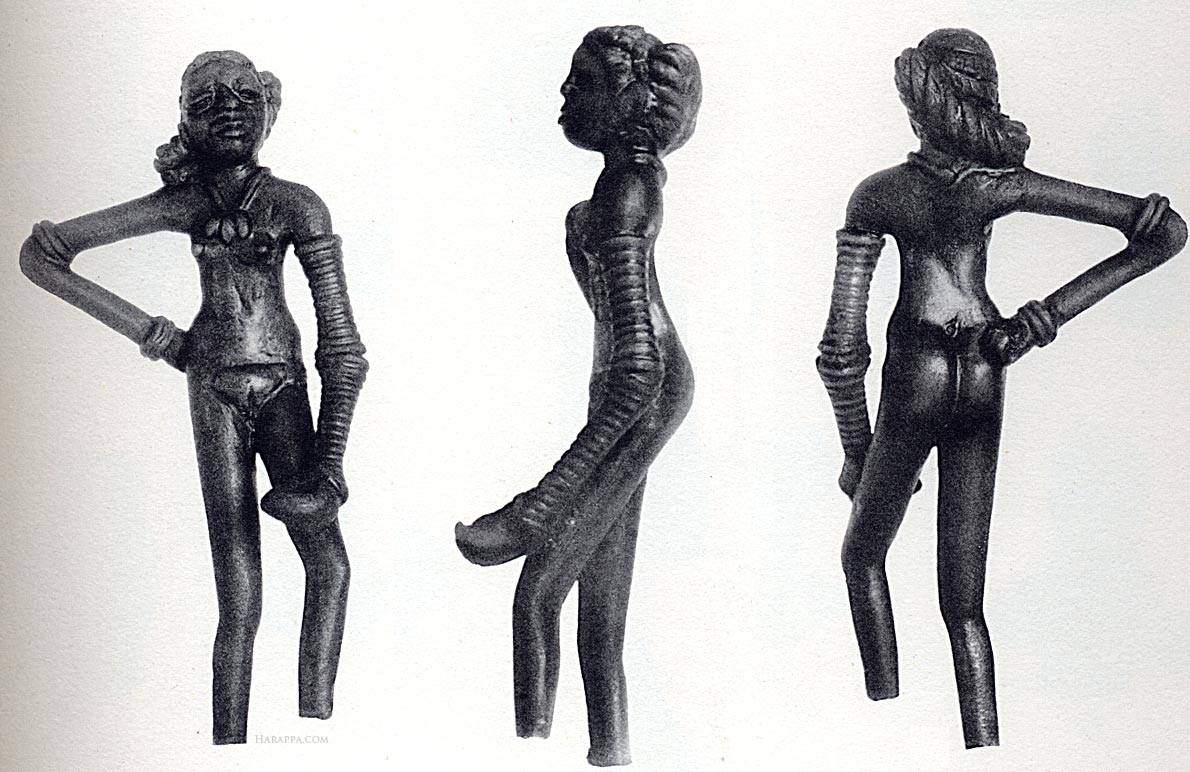

Place of Origin: Mohenjodaro Materials: Bronze Dimensions: 10.5 x 5 x 2.5 cm. Acc. No. 5721/195 National Museum. New Delhi ca. 2500 BCEThe dancing girl statue is shown wearing wristlets and bangles on her arms. Dancing girl, Posted by StephanieV. April 5th, 2014 "The dancing girl of Mohenjo-daro in three views, with close-ups of face, choker and bangles, and next to a dancing girl from Jaipur around 1900. John Marshall writes of this figure: "the arms and legs . . . are adorned with armlets, bangles, and anklets. These ornaments may sometimes have been made of metal, but in all probability the majority of them were shell. The custom of wearing so many shell bracelets as almost to conceal the whole of the forearm is very common in India at the present day." (Mohenjo-daro and the Indus Civilization, 1931, p. 339)."https://www.harappa.com/blog/dancing-girl-figurine Ntional Museum, New Delhi


https://www.facebook.com/photo.php?fbid=607194443075908
https://www.facebook.com/groups/416065382227600/permalink/533235367177267/
 Bronze statue of a woman holding something in her hand, Mohenjodaro; copper alloy made using cire perdue method DK 12728; Mackay 1938: 274, pl. LXXIII, 9-11. Now displayed at Karachi Museum, Pakistan. Ernest Mackay, Further Excavations at Mohenjo-Daro, 1927-31, New Delhi (1937-38). Ernest Mackay discovered this during his final full season of 1930-31 at DK-G area in a house, Mohenje-daro. "Bronze female figure, Mohenjodaro". masterfile.com. Masterfile. Retrieved 15 November 2014. https://en.wikipedia.org/wiki/Dancing_Girl_(Mohenjo-daro)#cite_note-7
Bronze statue of a woman holding something in her hand, Mohenjodaro; copper alloy made using cire perdue method DK 12728; Mackay 1938: 274, pl. LXXIII, 9-11. Now displayed at Karachi Museum, Pakistan. Ernest Mackay, Further Excavations at Mohenjo-Daro, 1927-31, New Delhi (1937-38). Ernest Mackay discovered this during his final full season of 1930-31 at DK-G area in a house, Mohenje-daro. "Bronze female figure, Mohenjodaro". masterfile.com. Masterfile. Retrieved 15 November 2014. https://en.wikipedia.org/wiki/Dancing_Girl_(Mohenjo-daro)#cite_note-7See: http://www.masterfile.com/image/en/841-02824318/Bronze-female-figure-Mohenjodaro-Karachi-Museum-Pakistan-Asia

 What is the female figurine with wristlets, bracelets, anklets and hair-knot carrying in her right hand?
What is the female figurine with wristlets, bracelets, anklets and hair-knot carrying in her right hand?One girl on the bronze sculpture with a dance step seems to hold a deepam on her left hand.
Another girl on another bronze sculpture (also made by lost wad or cire perdue technique) holds a deepam on her right hand.
I call them Deepa Lakṣmi, Female divinity of wealth holding a lamp. Was the lamp to lit the fire in the fire-altar or furnace to process metal ores?
Both the girls on the bronze sculptures are on a dance post with a hand on the hip. The same pose is signified on a potsherd from Bhirrana. The orthography compares with the two cire perdue dance-step and lamp-holding sculptures of Mohenjo-daro.

The focus is on the dance-step with an anklet on the lamp-holder bronze sculpture. The step is an Indus Script hieroglyph: meṭ sole of foot, footstep, footprint (Ko.); meṭṭu step, stair, treading, slipper (Te.)(DEDR 1557). Rebus:meḍ ‘iron’(Munda); मेढ meḍh‘merchant’s helper’(Pkt.) meḍ iron (Ho.) meṛed-bica = iron stone ore, in contrast to bali-bica, iron sand ore (Munda) मृदु mṛdu, mẽṛhẽt, meḍ 'metal' (Samskrtam. Santali.
मेधा = धन 'यज्ञो वै मेधः'इति श्रुतेः yajna is medhā is wealth; Sarasvati civilization is Veda culture http://tinyurl.com/js8z7ta
Hieroglyph: karã̄ n. pl. ʻwristlets, bangles ʼ(Gujarati)(CDIAL 2779) Rebus: khār खार् 'blacksmith' (Kashmiri) khār 1
Hieroglyph: várti
Thus karã̄ 'hands with wristlets and bangles' PLUS baṭi 'lamp' Rebus: khāra-bhāṭi 'blacksmith's smelter'.
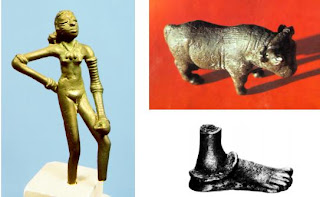
The ‘Dancing Girl’ (Mohenjo-daro), made by the lost-wax process; a bronze foot and anklet from Mohenjo-daro; and a bronze figurine of a bull (Kalibangan). (Courtesy: ASI) "Archaeological excavations have shown that Harappan metal smiths obtained copper ore (either directly or through local communities) from the Aravalli hills, Baluchistan or beyond. They soon discovered that adding tin to copper produced bronze, a metal harder than copper yet easier to cast, and also more resistant to corrosion.
Whether deliberately added or already present in the ore, various ‘impurities’ (such as nickel, arsenic or lead) enabled the Harappans to harden bronze further, to the point where bronze chisels could be used to dress stones! The alloying ranges have been found to be 1%–12% in tin, 1%–7% in arsenic, 1%–9% in nickel and 1%–32% in lead. Shaping copper or bronze involved techniques of fabrication such as forging, sinking, raising, cold work, annealing, riveting, lapping and joining. Among the metal artefacts produced by the Harappans, let us mention spearheads, arrowheads, axes, chisels, sickles, blades (for knives as well as razors), needles, hooks, and vessels such as jars, pots and pans, besides objects of toiletry such as bronze mirrors; those were slightly oval, with their face raised, and one side was highly polished. The Harappan craftsmen also invented the true saw, with teeth and the adjoining part of the blade set alternatively from side to side, a type of saw unknown elsewhere until Roman times. Besides, many bronze figurines or humans (the well-known ‘Dancing Girl’, for instance) and animals (rams, deer, bulls...) have been unearthed from Harappan sites. Those figurines were cast by the lost-wax process: the initial model was made of wax, then thickly coated with clay; once fired (which caused the wax to melt away or be ‘lost’), the clay hardened into a mould, into which molten bronze was later poured. Harappans also used gold and silver (as well as their joint alloy, electrum) to produce a wide variety of ornaments such as pendants, bangles, beads, rings or necklace parts, which were usually found hidden away in hoards such as ceramic or bronze pots. While gold was probably panned from the Indus waters, silver was perhaps extracted from galena, or native lead sulphide...While the Indus civilization belonged to the Bronze Age, its successor, the Ganges civilization, which emerged in the first millennium BCE, belonged to the Iron Age. But recent excavations in central parts of the Ganges valley and in the eastern Vindhya hills have shown that iron was produced there possibly as early as in 1800 BCE. Its use appears to have become widespread from about 1000 BCE, and we find in late Vedic texts mentions of a ‘dark metal’ (krṣnāyas), while earliest texts (such as the Rig-Veda) only spoke of ayas, which, it is now accepted, referred to copper or bronze.
See: Mother uṣas, veneration of mother divine and participant, smelting process, in Indus Script Corpora https://tinyurl.com/ycu5csoxDo the girls on the bronze sculptures signify Mother uṣas?
Br̥haspati is अधिष्ठाता देवता of puṣya nakshatra. In Bhāratīya Itihāsa, ‘ancient traditions’, पुष्य--रथ of इन्द्र--मह Indra festival carries गण--देवता, उषा and two Aśvinīkumāras. उषा f. morning light , dawn , morning RV. AV. xii , 2 , 45 VS. &c.
Uṣā (उषस्) is R̥gveda identification with dawn, revealing herself with the daily coming of light to the world, chasing away darkness evil demons, rousing all life, setting all things and activity in motion. She is the life of all living creatures, the impeller of action and breath, the foe of chaos and confusion, the auspicious arouser of cosmic and moral order called the Ṛta in Hinduism. Mother is venerated in all ancient Hindu texts, her disciplined devotion is signified by the sindhur she wears on the maang, the parting of her hair. This method of applying sindhur on the maang is evidenced on to terracotta toys discovered in Nausharo.
1.095.02 The vigilant and youthful Ten beget, through the wind, this embryo Agni, inherent (in all beings), sharp-visaged, universally renowned, shining among men; him they conduct (to every dwelling). [Ten: the ten regions of space, which generate lightning, as an embryo in the clouds, using the winds: agner hi va_yuh ka_ran.am, va_yor agnih, wind is the cause of fire, fire of wind. Tvas.t.uh = wind or its agency: dipta_nmadhyama_d va_yoh sa_kas.a_t, the brilliant central proximity of wind. Ten: the ten fingers which generate Agni through the act of attrition as an embryo in the sticks. vibhr.tram = deposited in all creatures,i.e. inherent].
1.095.03 They contemplate three places of his birth; one in the ocean, one in the heaven, one in the firmament; and, dividing the seasons of the year for the benefit of earthly creatures, he formed, in regular succession, the eastern quarter.
1.095.04 Which of you discerns the hidden Agni? a son, he begets his mothers by oblations; the germ of many (waters), he issues from the ocean, mighty and wise, the recipient of oblations. [hidden agni: latent heat in the waters, in the woods and in all fixed and moveable things; he begets his mothers: Agni, as lightning is the son of the waters collected in the clouds; he generates those waters by the oblations which he conveys; he issues from the ocean: upastha_t (smudra_t) nirgacchati, Agni is thought to rise in the morning in the shape of the sun from out of the ocean].
1.095.05 Appearing amongst them (the waters), the bright-shining (Agni) increases, rising above the flanks of the waving waters, spreading his own renown; both (heaven and earth) are alarmed, as the radiant Agni is born, and, approaching the lion, they pay him honour. [above the flanks of the waving waters: jihma_na_m apa_m upasthe, above, on the side, or tip, of the crooked waters; reference to Agni as the lightning; approaching the lion: sim.ha applied to Agni, implying sahanas'i_lam, abhibha_vana s'i_lam, ability to suffer or be overcome].
1.095.06 Both the auspicious ones (day and night or two pieces of wood rubbed together to produce flame) wait upon him like two female attendants, as lowing kine (follow their calves) by the paths (that they have gone); he has been the lord of might among the mighty, whom (the priests) on the right (of the altar) anoint.
1.095.07 Like the sun, he stretches forth his arms, and the formidable Agni, decorating both heaven and earth (with brightness), labours (in his duties); he draws up from everything the essential (moisture), and clothes (the earth) with new vestments (derived) from his maternal (rains).
1.095.08 Associated in the firmament with the moving waters, he assumes an excellent and lustrous form, and the wise sustainer (of all things) sweeps over the source (of the rains with his radiance), whence a concentration of light is spread abroad by the sportive deity. [budhna = antariks.a or firmament, as the source of the rains].
1.095.09 The vast and victorious radiance of you, the mighty one, pervades the firmament; Agni, who have been kindled by us, preserve us with all your undiminished and protecting glories.
1.095.10 He causes the waters to flow in a torrent through the sky, and with those pure waves he inundates the earth; he gathers all (articles of) food in the stomach, and for that purpose sojourns in the new-sprung parents (of the gain). [navasu prasus.u = in the new parents, or mothers; i.e. in the os.adhis, the annual crops which ripen after the rains and bear food, being impregnated by the terrestrial Agni].
1.095.11 Agni, who are the purifier, growing with the fuel we have supplied, blaze for the sake of (securing) food to us, who are possessed of wealth; and may Mitra, Varun.a, Aditi--ocean, earth, and heaven, preserve it to us.
1. To fair goals travel Two unlike in semblance: each in succession nourishes an infant.
One bears a Godlike Babe of golden colour; bright and fairshining-, is he with the other.
2 Tvastars' ten daughters, vigilant and youthful, produced this Infant borne to sundry quarters.
They bear around him whose long flames are pointed, fulgent among mankind with native splendour.
3. Three several places of his birth they honour, in midair-, in the heaven, and in the waters.
Governing in the east of earthly regions, the seasons hath he stablished in their order.
4 Who of you knows this secret One? The Infant by his own nature hath brought forth his Mothers.
The germ of many, from the waters' bosom he goes forth, wise and great, of Godlike nature.
5 Visible, fair, he grows in native brightness uplifted in the lap of waving waters.
When he was born both Tvastars' worlds were frightened: they turn to him and reverence the Lion.
6 The Two auspicious Ones, like women, tend him: like lowing cows they seek him in their manner.
He is the Lord of Might among the mighty; him, on the right, they balm with their oblations.
7 Like Savitar his arms with might he stretches; awful, he strives grasping the worlds' two
borders.
He forces out from all a brilliant vesture, yea, from his Mothers draws forth new raiment.
8 He makes him a most noble form of splendour, decking him in his home with milk and waters.
The Sage adorns the depths of air with wisdom: this is the meeting where the Gods are worshipped.
9 Wide through the firmament spreads forth triumphant the far resplendent- strength of thee the
Mighty.
Kindled by us do thou preserve us, Agni, with all thy selfbright- undiminished succours.
10 In dry spots he makes stream, and course, and torrent, and inundates the earth with floods that glisten.
All ancient things within his maw he gathers, and moves among the new fresh sprouting- grasses.
11 Fed with our fuel, purifying Agni, so blaze to us auspiciously for glory.
This prayer of ours may Varuna grant, and Mitra, and Aditi and Sindhu, Earth and Heaven.
To whom, O radiant, dost thou go?
21 For we have had thee in our thoughts whether anear or far away,
Redhued- and like a dappled mare.
22 Hither, O Daughter of the Sky, come thou with these thy strengthenings,
And send thou riches down to us.
1 DAWN on us with prosperity, O Usas, Daughter of the Sky,
Dawn with great glory, Goddess, Lady of the Light, dawn thou with riches, Bounteous One.
2 They, bringing steeds and kine, boongivers- of all wealth, have oft sped forth to lighten us.
O Usas, waken up for me the sounds of joy: send us the riches of the great.
3 Usas hath dawned, and now shall dawn, the Goddess, driver forth of cars
Which, as she cometh nigh, have fixed their thought on her, like gloryseekers- on the flood.
4 Here Kanva, chief of Kanvas' race, sings forth aloud the glories of the heroes' names,
The. princes who, O Usas, as thou comest near, direct their thoughts to liberal gifts.
5 Like a good matron Usas comes carefully tending everything:
Rousing all life she stirs all creatures that have feet, and makes the birds of air fly up.
6 She sends the busy forth, each man to his pursuit: delay she knows not as she springs.
O rich in opulence, after thy dawning birds that have flown forth no longer rest.
7 This Dawn hath yoked her steeds afar, beyond the rising of the Sun:
Borne on a hundred chariots she, auspicious Dawn, advances on her way to Men.
8 To meet her glance all living creatures bend them down: Excellent One, she makes the light.
Usas, the Daughter of the Sky, the opulent, shines foes and enmities away.
9 Shine on us with thy radiant light, O Usas, Daughter of the Sky,
Bringing to us great store of high felicity, and beaming on our solemn rites.
10 For in thee is each living creatures' breath and life, when, Excellent! thou dawnest forth.
Borne on thy lofty car, O Lady of the Light, hear, thou of wondrous wealth, our call.
11 O Usas, win thyself the strength which among men is wonderful.
Bring thou thereby the pious unto holy rites, those who as priests sing praise to thee.
12 Bring from the firmament, O Usas, all the Gods, that they may drink our Soma juice,
And, being what thou art, vouchsafe us kine and steeds, strength meet for praise and hero might.
13 May Usas whose auspicious rays are seen resplendent round about,
Grant us great riches, fair in form, of all good things, wealth which light labour may attain.
14 Mighty One, whom the Rsis of old time invoked for their protection and their help,
O Usas, graciously answer our songs of praise with bounty and with brilliant light.
15 Usas, as thou with light to day hast opened the twin doors of heaven,
So grant thou us a dwelling wide and free from foes. O Goddess, give us food with kine.
16 Bring us to wealth abundant, sent in every shape, to plentiful refreshing food,
To allsubduing- splendour, Usas, Mighty One, to strength, thou rich in spoil and wealth.
RV 1.49
HYMN XLIX. Dawn. 49
1 EEN' from above the skys' bright realm come, Usas, by auspicious ways:
Let red steeds bear thee to the house of him who pours the Soma, juice.
2 The chariot which thou mountest, fair of shape, O Usas light to move,
Therewith, O Daughter of the Sky, aid men of noble fame today.
3 Bright Usas, when thy times return, all quadrupeds and bipeds stir,
And round about flock winged birds from all the boundaries of heaven.
4 Thou dawning with thy beams of light illumest all the radiant realm.
Thee, as thou art, the Kanvas, fain for wealth, have called with sacred songs.
RV 1.92
HYMN XCII. Dawn. 92
their shining light.
Like heroes who prepare their weapons for the war, onward they come bright red in hue, the Mother
Cows.
2 Readily have the purple beams of light shot up; the Red Cows have they harnessed, easy to be
yoked.
The Dawns have brought distinct perception as before: redhued-, they have attained their fulgent
brilliancy.
3 They sing their song like women active in their tasks, along their common path hither from far
away,
Bringing refreshment to the liberal devotee, yea, all things to the worshipper who pours the juice.
4 She, like a dancer, puts her broidered garments on: as a cow yields her udder so she bares her
breast.
Creating light for all the world of life, the Dawn hath laid the darkness open as the cows their
stall.
5 We have beheld the brightness of her shining; it spreads and drives away the darksome monster.
Like tints that deck the Post at sacrifices, Heavens' Daughter hath attained her wondrous
splendour.
6 We have overpast the limit of this darkness; Dawn breaking forth again brings clear perception.
She like a flatterer smiles in light for glory, and fair of face hath wakened to rejoice us.
7 The Gotamas have praised Heavens' radiant Daughter, the leader of the charm of pleasant voices.
Dawn, thou conferrest on us strength with offspring and men, conspicuous with kine and horses.
8 O thou who shinest forth in wondrous glory, urged onward by thy strength, auspicious Lady,
Dawn, may I gain that wealth, renowned and ample, in brave sons, troops of slaves, farfamed- for
horses.
9 Bending her looks on all the world, the Goddess shines, widely spreading with her bright eye
westward.
Waking to motion every living creature, she understands the voice of each adorer.
10 Ancient of days, again again born newly, decking her beauty with the selfsame- raiment.
The Goddess wastes away the life of mortals, like a skilled hunter cutting birds in pieces.
11 She hath appeared discovering heavens' borders: to the far distance she drives off her Sister.
Diminishing the days of human creatures, the Lady shines with all her lovers' splendour.
12 The bright, the blessed One shines forth extending her rays like kine, as a flood rolls his
waters.
Never transgressing the divine commandments, she is beheld visible with the sunbeams.
13 O Dawn enriched with ample wealth, bestow on us the wondrous gift
Wherewith we may support children and childrens' sons.
14 Thou radiant mover of sweet sounds, with wealth of horses and of kine
Shine thou on us this day, O Dawn auspiciously.
15 O Dawn enriched with holy rites, yoke to thy car thy purple steeds,
And then bring thou unto us all felicities.
16 O Asvins wonderful in act, do ye unanimous direct
Your chariot to our home wealthy in kine and gold.
17 Ye who brought down the hymn from heaven, a light that giveth light to man,
Do ye, O Asvins, bring strength hither unto us.
18 Hither may they who wake at dawn bring, to drink Soma both the Gods
Healthgivers- WonderWorkers-, borne on paths of gold.
1. This light is come, amid all lights the fairest; born is the brilliant, farextending-
brightness.
Night, sent away for Savitars' uprising, hath yielded up a birthplace- for the Morning.
2 The Fair, the Bright is come with her white offspring; to her the Dark One hath resigned her
dwelling.
Akin, immortal, following each other, changing their colours both the heavens move onward.
3 Common, unending is the Sisters' pathway; taught by the Gods, alternately they travel.
Fairformed-, of different hues and yet oneminded-, Night and Dawn clash not, neither do they
travel.
4 Bright leader of glad sounds, our eyes behold her; splendid in hue she hath unclosed the portals.
She, stirring up the world, hath shown us riches: Dawn hath awakened every living creature.
5 Rich Dawn, she sets afoot the coiledup- sleeper, one for enjoyment, one for wealth or worship,
Those who saw little for extended vision. All living creatures hath the Dawn awakened.
6 One to high sway, one to exalted glory, one to pursue his gain, and one his labour:
All to regard their different vocations, all moving creatures hath the Dawn awakened.
7 We see her there, the Child of Heaven apparent, the young Maid, flushing in her shining raiment.
Thou sovran Lady of all earthly treasure, flush on us here, auspicious Dawn, this morning.
8 She first of endless morns to come hereafter, follows the path of morns that have departed.
Dawn, at her rising, urges forth the living him who is dead she wakes not from his slumber.
9 As thou, Dawn, hast caused Agni to be kindled, and with the Suns' eye hast revealed creation.
And hast awakened men to offer worship, thou hast performed, for Gods, a noble service.
10 How long a time, and they shall be together, Dawns that have shone and Dawns to shine hereafter?
She yearns for former Dawns with eager longing, and goes forth gladly shining with the others.
11 Gone are the men who in the days before us looked on the rising of the earlier Morning.
We, we the living, now behold her brightness and they come nigh who shall hereafter see her.
12 Foechaser-, born of Law, the Laws' protectress, joygiver-, waker of all pleasant voices,
Auspicious, bringing food for Gods enjoyment, shine on us here, most bright, O Dawn, this morning.
13 From days eternal hath Dawn shone, the Goddess, and shows this light today-, endowed with
riches.
So will she shine on days to come immortal she moves on in her own strength, undecaying.
14 In the skys' borders hath she shone in splendour: the Goddess hath thrown off the veil of
darkness.
Awakening the world with purple horses, on her wellharnessed- chariot Dawn approaches.
15 Bringing all lifesustaining- blessings with her, showing herself she sends forth brilliant
lustre.
Last of the countless mornings that have vanished, first of bright morns to come hath Dawn arisen.
16 Arise! the breath, the life, again hath reached us: darkness hath passed away and light
approacheth.
She for the Sun hath left a path to travel we have arrived where men prolong existence.
17 Singing the praises of refulgent Mornings with his hymns' web the priest, the poet rises.
Shine then today-, rich Maid, on him who lauds thee, shine down on us the gift of life and
offspring.
18 Dawns giving sons all heroes, kine and horses, shining upon the man who brings oblations,
These let the Somapresser- gain when ending his glad songs louder than the voice of Vayu.
19 Mother of Gods, Aditis' form of glory, ensign of sacrifice, shine forth exalted.
Rise up, bestowing praise on our devotion allbounteous-, make us chief among the people.
20 Whatever splendid wealth the Dawns bring with them to bless the man who offers praise and
worship,
Even that may Mitra, Varuna vouchsafe us, and Aditi and Sindhu, Earth and Heaven.
RV 1.123
HYMN CXXIII. Dawn. 123
Fain to bring light to homes of men the noble and active Goddess hath emerged from darkness.
2 She before all the living world hath wakened, the Lofty One who wins and gathers treasure.
Revived and ever young on high she glances. Dawn hath come first unto our morning worship.
3 If, Dawn, thou Goddess nobly born, thou dealest fortune this day to all the race of mortals,
May Savitar the God, Friend of the homestead, declare before the Sun that we are sinless.
4 Showing her wonted form each day that passeth, spreading the light she visiteth each dwelling.
Eager for conquest, with bright sheen she cometh. Her portion is the best of goodly treasures.
5 Sister of Varuna, sister of Bhaga, first among all sing forth, O joyous Morning.
Weak be the strength of him who worketh evil: may we subdue him with our car the guerdon.
6 Let our glad hymns and holy thoughts rise upward, for the flames brightly burning have ascended.
The farrefulgent- Mornings make apparent the lovely treasures which the darkness covered.
7 The one departeth and the other cometh: unlike in hue days', halves march on successive.
One hides the gloom of the surrounding Parents. Dawn on her shining chariot is resplendent.
8 The same in form today-, the same tomorrow, they still keep Varunas' eternal statute.
Blameless, in turn they traverse thirty regions, and dart across the spirit in a moment.
9 She who hath knowledge Of the first days' nature is born refulgent white from out the darkness.
The Maiden breaketh not the law of Order, day by day coming to the place appointed.
10 In pride of beauty like a maid thou goest, O Goddess, to the God who longs to win thee,
And smiling youthful, as thou shinest brightly, before him thou discoverest thy bosom.
11 Fair as a bride embellished by her mother thou showest forth thy form that all may see it.
Blessed art thou O Dawn. Shine yet more widely. No other Dawns have reached what thou attainest.
12 Rich in kine, horses, and all goodly treasures, in constant operation with the sunbeams,
The Dawns depart and come again assuming their wonted forms that promise happy fortune.
13 Obedient to the rein of Law Eternal give us each thought that more and more shall bless us.
Shine thou on us today-, Dawn, swift to listen. With us be riches and with chiefs who worship.
HYMN CXXIV. Dawn. 124
Savitar, God, hath sent us forth to labour, each quadruped, each biped, to be active.
2 Not interrupting heavenly ordinances, although she minisheth human generations.
The last of endless morns that have departed, the first of those that come, Dawn brightly shineth.
3 There in the eastern region she, Heavens' Daughter, arrayed in garments all of light, appeareth.
Truly she followeth the path of Order, nor faileth, knowing well, the heavenly quarters.
4 Near is she seen, as it were the Bright Ones' bosom: she showeth sweet things like a new
songsinger-.
She cometh like a fly awaking sleepers, of all returning dames most true and constant.
5 There in the east half of the watery region the Mother of the Cows hath shown her ensign.
Wider and wider still she spreadeth onward, and filleth full the laps of both heir Parents.
6 She, verily, exceeding vast to look on debarreth from her light nor kin nor stranger.
Proud of her spotless form she, brightly shining, turneth not from the high nor from the humble.
7 She seeketh men, as she who hath no brother, mounting her car, as it were to gather riches.
Dawn, like a loving matron for her husband, smiling and well attired, unmasks her beauty.
8 The Sister quitteth, for the elder Sister, her place, and having looked on her departeth.
She decks her beauty, shining forth with sunbeams, like women trooping to the festal meeting.
9 To all these Sisters who ere now have vanished a later one each day in course succeedeth.
So, like the past, with days of happy fortune, may the new Dawns shine forth on us with riches.
10 Rouse up, O Wealthy One, the liberal givers; let niggard traffickers sleep on unwakened:
Shine richly, Wealthy One, on those who worship, richly, glad.
Dawn while wasting, on the singer.
11 This young Maid from the east hath shone upon us; she harnesseth her team of bright red oxen.
She will beam forth, the light will hasten hither, and Agni will be present in each dwelling.
12 As the birds fly forth from their resting places, so men with store of food rise at thy dawning.
Yea, to the liberal mortal who remaineth at home, O Goddess Dawn, much good thou bringest.
13 Praised through my prayer be ye who should be lauded. Ye have increased our wealth, ye Dawns
who love us.
Goddesses, may we win by your good favour wealth to be told by hundreds and by thousands.
HYMN LXI. Usas. 61
1. O Usas, strong with strength, endowed witli knowledge, accept the singers' praise, O wealthy
Lady.
Thou, Goddess, ancient, young, and full of wisdom, movest, allbounteous-! as the Law ordaineth.
2 Shine forth, O Morning, thou auspicious Goddess, on thy bright car awaking pleasant voices.
Let docile horses of farreaching- splendour convey thee hitherward, the goldencoloured.
3 Thou, Morning, turning thee to every creature, standest on high as ensign of the Immortal,
To one same goal ever and ever wending now, like a wheel, O newlyborn-, roll hi ther.
4 Letting her reins drop downward, Morning cometh, the wealthy Dame, the Lady of the dwelling;
Bringing forth light, the Wonderful, the Blessed hath spread her from the bounds of earth and
heaven.
5 Hither invoke the radiant Goddess Morning, and bring with reverence your hymn to praise her.
She, dropping sweets, hath set in heaven her brightness, and, fair to look on, hath beamed forth
her splendour.
6 From heaven, with hymns, the Holy One was wakened: brightly to both worlds came the wealthy Lady.
To Morning, Agni, when she comes refulgent, thou goest forth soliciting fair riches.
7 On Laws' firm base the speeder of the Mornings, the Bull, hath entered mighty earth and heaven.
Great is the power of Varuna and Mitra, which, bright, hath spread in every place its splendour.
RV 4.30
8 And this heroic deed of might thou, Indra, also hast achieved,
That thou didst smite to death the Dame, Heavens' Daughter, meditating ill.
9 Thou, Indra, Mighty One, didst crush Usas, though Daughter of the Sky.
When lifting up herself in pride.
10 Then from her chariot Usas fled, affrighted, from her ruined car.
When the strong God had shattered it.
11 So there this car of Usas lay, broken to pieces, in Vipas,
And she herself fled far away.
RV 4.51, 4.52
HYMN LI. Dawn. 51
1. FORTH from the darkness in the region eastward this most abundant splendid light hatb mounted.
Now verily the farrefulgent- Mornings, Daughters of Heaven, bring welfare to the people.
2 The richlycoloured- Dawns have mounted eastward, like pillars planted at our sacrifices,
And, flushing far, splendid and purifying, unbarred the portals of the fold of darkness.
3 Dispelling gloom this day the wealthy Mornings urge liberal givers to present their treasures.
In the unlightened depth of darkness round them let niggard traffickers sleep unawakened.
4 O Goddesses, is this your car, I ask you, ancient this day, or is it new, ye Mornings,
Wherewith, rich Dawns, ye seek with wealth Navagva, Dasagva Angira, the seventoned- singer?
5 With horses harnessed by eternal Order, Goddesses, swiftly round the worlds ye travel,
Arousing from their rest, O Dawns, the sleeping, and all that lives, man, bird, and beast, to
motion.
6 Which among these is eldest, and where is she through whom they fixed the Rbhus' regulations?
What time the splendid Dawns go forth for splendour, they are not known apart, alike, unwasting.
7 Blest were these Dawns of old, shining with succour, true with the truth that springs from holy
Order;
With whom the toiling worshipper, by praises, hymning and lauding, soon attained to riches.
8 Hither from eastward all at once they travel, from one place spreading in the selfsame manner.
Awaking, from the seat of holy Order the Godlike Dawns come nigh like troops of cattle.
9 Thus they go forth with undiminished colours, these Mornings similar, in selfsame- fashion,
Concealing the gigantic might of darkness with radiant bodies bright and pure and shining.
10 O Goddesses, O Heavens' refulgent Daughters, bestow upon us wealth with store of children.
As from our pleasant place of rest ye rouse us may we be masters of heroic vigour.
11 Wellskilled- in lore of sacrifice, ye Daughters of Heaven, refulgent Dawns, I thus address you.
May we be glorious among the people. May Heaven vouchsafe us this, and Earth the Goddess,
HYMN LII. Dawn. 52
1. THIS Lady, giver of delight, after her Sister shining forth, Daughter of Heaven, hath shown
herself.-
2 Unfailing, Mother of the Kine, in colour like a bright red mare,
The Dawn became the Asvins' Friend.
3 Yea, and thou art the Asvins' Friend, the Mother of the Kine art thou:
O Dawn thou rulest over wealth.
4 Thinking of thee, O joyous One, as her who driveth hate away,
We woke to meet thee with our lauds.
5 Our eyes behold thy blessed rays like troops of cattle loosed to feed.
Dawn hath filled full the wide expanse.
6 When thou hast filled it, Fulgent One! thou layest bare the gloom with light.
After thy nature aid us, Dawn.
7 Thou overspreadest heaven with rays, the dear wide region of midair-.
With thy bright shining lustre, Dawn.
RV 5.79
HYMN LXXIX. Dawn. 79
1. O HEAVENLY Dawn, awaken us to ample opulence today-
Even as thou hast wakened us with Satyasravas, Vayyas' son, highborn-! delightful with thy steeds!
2 Daughter of Heaven, thou dawnedst on Sunitha Sucadrathas' son,
So dawn thou on one mightier still, on Satyasravas, Vayyas' son, highborn-! delightful with thy
steeds!
3 So, bringing treasure, dawn today- on us thou Daughter of the Sky,
As thou, O mightier yet. didst shine for Satyatravas, Vayyas' son, highborn-! delightful with thy
steeds!
4 Here round about thee are the priests who laud thee, Bright One, with their hymns,
And men with gifts, O Bounteous Dame, splendid with wealth and offering much, highborn-!
delightful with thy steeds!
5 Whatever these thy bands perform to please thee or to win them wealth,
even fain they gird us round and give rich gifts which Never are reft away, highborn-! delightful
with thy steeds!
6 Give to these wealthy patrons fame, O affluent Dawn, with hero sons,
To these our princes who have brought rich gifts Never to be reft away, highborn! delightful with
thy steeds!
7 Bring lofty and resplendent fame, O thou munificent Dawn, to these
Our wealthy patrons who bestow rich gifts on us of steeds and kine, highborn-! delightful with thy
steeds!
8 Bring us, O Daughter of the Sky, subsistence in our herds of kine,
Together with the sunbeams, with the shine of pure refulgent flames, highborn! delightful with thy
steeds!
9 O Daughter of the Sky, shine forth; delay not to perform thy task.
Let not the Sun with fervent heat consume thee like a robber foe, highborn-! delightful with the
steeds!
10 So much, and more exceedingly, O Dawn, it suits thee to bestow,
Thou Radiant One who ceasest not to shine for those who sing thy praise, highborn! delightful with
thy steeds!
RV 5.80
HYMN LXXX. Dawn. 80
1. THE singers welcome with their hymns and praises the Goddess Dawn who bringeth in the sunlight,
Sublime, by Law true to eternal Order, bright on her path, redtinted-, farrefulgent-.
2 She comes in front, fair, rousing up the people, making the pathways easy to be travelled.
High, on her lofty chariot, allimpelling-, Dawn gives her splendour at the days' beginning.
3 She, harnessing her car with purple oxen. injuring none, hath brought perpetual riches.
Opening paths to happiness, the Goddess shines, praised by all, giver of every blessing.
4 With changing tints she gleams in double splendour while from the eastward she displays her body.
She travels perfectly the path of Order, nor fails to reach, as one who knows, the quarters.
5 As conscious that her limbs are bright with bathing, she stands, as it were, erect that we may
see her.
Driving away malignity and darkness, Dawn, Child of Heaven, hath come to us with lustre.
6 The Daughter of the Sky, like some chaste woman, bends, opposite to men, her forehead downward.
The Maid, disclosing boons to him who worships, hath brought again the daylight as aforetime.
RV 6.64, RV 6.65
HYMN LXIV. Dawn. 64
1. THE radiant Dawns have risen up for glory, in their white splendour like the waves of waters.
She maketh paths all easy, fair to travel, and, rich, hath shown herself benign and friendly.
2 We see that thou art good: far shines thy lustre; thy beams, thy splendours have flown up to
heaven.
Decking thyself, thou makest bare thy bosom, shining in majesty, thou Goddess Morning.
3 Red are the kine and luminous that bear her the Blessed One who spreadeth through the distance.
The foes she chaseth like a valiant archer, like a swift warrior she repelleth darkness.
4 Thy ways are easy on the hills: thou passest Invincible! Se1fluminous-! through waters.
So lofty Goddess with thine ample pathway, Daughter of Heaven, bring wealth to give us comfort.
5 Dawn, bring me wealth: untroubled, with thine oxen thou bearest riches at thy will and pleasure;
Thou who, a Goddess, Child of Heaven, hast shown thee lovely through bounty when we called thee
early.
6 As the birds fly forth from their restingplaces, so men with store of food rise at thy dawning.
Yea, to the liberal mortal who rernaineth at home, O Goddess Dawn, much good thou bringest.
HYMN LXV. Dawn. 65
She who at nighttime- with her argent lustre hath shown herself even through the shades of
darkness.
2 All this with redrayed- steeds have they divided: the Dawns on bright cars shine in wondrous
fashion.
They, bringing near the stately rites' commencement, drive far away the nights' surrounding
shadows.
3 Dawns, bringing hither, to the man who worships, glory and power and might and food and vigour,
Opulent, with imperial sway like heroes, favour your servant and this day enrich him.
4 Now is there treasure for the man who serves you, now for the hero, Dawns! who brings oblation;
Now for the singer when he sings the praisesong-. Even to one like me ye brought aforetime.
5 O Dawn who standest on the mountain ridges, Angirases now praise thy stalls of cattle.
With prayer and holy hymn they burst them open: the heroes' calling on the Gods was fruitful.
6 Shine on us as of old, thou Child of Heaven on, him, rich Maid! who serves like Bharadvaja.
Give to the singer wealth with noble heroes, and upon us bestow widespreading- glory.
HYMN XLI. Bhaga. 41
6 To this our worship may all Dawns incline them, and come to the pure place like Dadhikravan.
As strong steeds draw a chariot may they bring us hitherward Bhaga who discovers treasure.
7 May blessed Mornings dawn on us for ever, with wealth of kine, of horses, and of heroes,
Streaming with all abundance, pouring fatness. Preserve us evermore, ye Gods, with blessings.
RV 7.75 to RV 7.81
HYMN LXXV. Dawn. 75
1. BORN in the heavens the Dawn hath flushed, and showing her majesty is come as Law ordaineth.
She hath uncovered fiends and hateful darkness; best of Angirases, hath waked the pathways.
2 Rouse us this day to high and happy fortune: to great felicity, O Dawn, promote us.
Vouchsafe us manifold and splendid riches, famed among mortals, manbefriending- Goddess!
3 See, lovely Mornings' everlasting splendours, bright with their varied colours, have approached
us.
Filling the region of midair-, producing the rites of holy worship, they have mounted.
4 She yokes her chariot far away, and swiftly visits the lands where the Five Tribes are settled,
Looking upon the works and ways of mortals, Daughter of Heaven, the worlds' Imperial Lady.
5 She who is rich in spoil, the Spouse of Surya, wondrously opulent, rules all wealth and
treasures.
Consumer of our youth, the seers extol her: lauded by priests rich Dawn shines out refulgent.
6 Apparent are the steeds of varied colour, the red steeds carrying resplendent Morning.
On her alllovely- car she comes, the Fair One, and brings rich treasure for her faithful servant.
7 True with the True and Mighty with the Mighty, with Gods a Goddess, Holy with the Holy,
She brake strong fences down and gave the cattle: the kine were lowing as they greeted Morning.
8 O Dawn, now give us wealth in kine and heroes, and horses, fraught with manifold enjoyment.
Protect our sacred grass from mans' reproaches. Preserve us evermore, ye Gods, with blessings.
HYMN LXXVI. Dawn. 76
1. SAVITAR God of all men hath sent upward his light, designed for all mankind, immortal.
Through the Gods power that Eye was first created. Dawn hath made all the universe apparent.
2 I see the paths which Gods are wont to travel, innocuous paths made ready by the Vasus.
Eastward the flag of Dawn hath been uplifted; she hath come hither over the tops of houses.
3 Great is, in truth, the number of the Mornings which were aforetime at the Suns' uprising.
Since thou, O Dawn, hast been beheld repairing as to thy love, as one no more to leave him.
4 They were the Gods companions at the banquet, the ancient sages true to Law Eternal.
The Fathers found the light that lay in darkness, and with effectual words begat the Morning.
5 Meeting together in the same enclosure, they strive not, ofone mind, one with another.
They never break the Gods eternal statutes, and injure none, in rivalry with Vasus.
6 Extolling thee, Blest Goddess, the Vasisthas, awake at early mom, with lauds implore thee.
Leader of kine and Queen of all that strengthens, shine, come as first to us, O highborn- Morning.
7 She bringeth bounty and sweet charm of voices. The flushing Dawn is sung by the Vasisthas,
Giving us riches famed to distant places. Preserve us evermore, ye Gods, with blessings.
HYMN LXXVIT. Dawn. 77
1. SHE hath shone brightly like a youthful woman, stirring to motion every living creature.
Agni hath come to feed on mortal? fuel. She hath made light and chased away the darkness.
2 Turned to this All, farspreading-, she hath risen and shone in brightness with white robes about
her.
She hath beamed forth lovely with golden colours, Mother of kine, Guide of the days she bringeth.
3 Bearing the Gods own Eye, auspicious Lady, leading her Courser white and fair to look on,
Distinguished by her beanis- Dawn shines apparent, come forth to all the world with wondrous
treasure.
4 Draw nigh with wealth and dawn away the foeman: prepare for us wide pasture free from danger.
Drive away those who hate us, bring us riches: pour bounty, opulent Lady, on the singer.
5 Send thy most excellent beams to shine and light us, giving us lengthened days, O Dawn, O
Goddess,
Granting us food, thou who hast all things precious, and bounty rich in chariots, kine, and horses.
6 O Usas, noblyborn-, Daughter of Heaven, whom the Vasisthas with their hymns make mighty,
Bestow thou on us vast and glorious riches. Preserve us evermore, ye Gods, with blessings.
HYMN LXXVIII. Dawn. 78
1. WE have beheld her earliest lights approaching: her many glories part, on high, asunder.
On car sublime, refulgent, wending hither, O Usas, bring the Wealth that makes us happy.
2 The fire wellkindIed- sings aloud to greet her, and with their hymns the priests are chaming
welcome.
Usas approaches in her splendour, driving all evil darkness far away, the Goddess.
3 Apparent eastward are those lights of Morning, sending out lustre, as they rise, around them.
She hath brought forth Sun, sacrifice, and Agni, and far away hath fled detested darkness.
4 Rich Daughter of the Sky, we all behold her, yea, all men look on Dawn as she is breaking.
fler car that moves selfharnessed- hath she mounted, the car drawn onward by her wellyoked- horses.
5 Inspired with loving thoughts this day to greet thee, we and our wealthy nobles have awakened.
Show yourselves fruitful, Dawns, as ye are rising. Preserve us evermore, ye Gods, with blessings.
HYMN LXXIX. Dawn. 79
1. ROUSING the lands where mens' Five Tribes are settled, Dawn hath disclosed the pathways of the
people.
She hath sent out her sheen with beauteous oxen. The Sun with light hath opened earth and heaven.
2 They paint their bright rays on the skys' far limits. the Dawns come on like tribes arrayed for
battle.
Thy cattle, closely shutting up the darkness, as Savitar spreads his arms, give forth their lustre.
3 Wealthy, most like to Indra, Dawn hath risen, and brought forth lauds that shall promote our
welfare.
Daughter of Heaven, a Goddess, she distributes, best of Angirases, treasures to the pious.
4 Bestow on us, O Dawn, that ample bounty which thou didst send to those who sang thy praises;
Thou whom with bellowings of a bull they quickened: thou didst unbar the firmset- mountains'
portals.
5 Impelling every God to grant his bounty sending to us the charm of pleasant voices,
Vouchsafe us thoughts, for profit, as thou breakest. Preserve us evermore, ye Gods, with blessings.
HYMN LXXX. Dawn. 80
1 THE priests, Vasisthas, are the first awakened to welcome Usas with their songs and praises,
Who makes surrounding regions part asunder and, shows apparent all existing creatures.
2 Giving fresh life when she hath hid the darkness, this Dawn hath wakened there with newborn-
lustre.
Youthful and unrestrained she cometh forward: she hath turned thoughts to Sun and fire and worship.
3 May blessed Mornings shine on us for ever, with wealth of kine, of horses, and of heroes,
Streaming with all abundance, pouring fatness. Preserve us evermore, ye Gods, with blessings.
HYMN LXXXI. Dawn. 81
Uncovering, that we may see, the mighty gloom, the friendly Lady makes the light.
2 The Sun ascending, the refulgent Star, pours down his beams together with the Dawn.
O Dawn, at thine arising, and the Suns', may we attain the share allotted us.
3 Promptly we woke to welcome thee, O Usas, Daughter of the Sky,
Thee, Bounteous One, who bringest all we long to have, and to the offerer health and wealth.
4 Thou, dawning, workest fain to light the great world, yea, heaven, Goddess! that it may be seen.
We yearn to be thine own, Dealer of Wealth: may we be to this Mother like her sons.
5 Bring us that wondrous bounty, Dawn, that shall be famed most far away.
What, Child of Heaven, thou hast of nourishment for man, bestow thou on us to enjoy.
6 Give to our princes opulence and immortal fame, and strength in herds of kine to us.
May she who prompts the wealthy, Lady of sweet strains, may Usas dawn our foes away.
HYMN XLVII. Adityas. 47
1. GREAT help ye give the worshipper, Varuna, Mitra, Mighty Ones! No sorrow ever reaches him whom
ye, Adityas, keep from harm. Yours are incomparable aids, and good the succour they afford.
2 O Gods, Adityas, well ye know the way to keep all woes afar.
As the birds spread their sheltering wings, spread your protection over us.
3 As the birds spread their sheltering wings let your protection cover us.
We mean all shelter and defence, ye who have all things for your own.
4 To whomsoever they, Most Wise, have given a home and means of life,
Over the whole riches of this man they, the Adityas, have control.
5 As drivers of the car avoid ill roads, let sorrows pass us by.
May we be under Indras' guard, in the Adityas' favouring grace.
6 For verily men sink and faint through loss of wealth which ye have given.
Much hath he gained from you, O Gods, whom ye, Adityas, have approached.
7 On him shall no fierce anger fall, no sore distress shall visit him,
To whom, Adityas, ye have lent your shelter that extendeth far.
8 Resting in you, O Gods, we are like men who fight in coats of mail.
Ye guard us from each great offence, ye guard us from each lighter fault.
9 May Aditi defend us, may Aditi guard and shelter us,
Mother of wealthy Mitra and of Aryaman and Varuna.
10 The shelter, Gods, that is secure, auspicious, free from malady,
A sure protection, triply strong, even that do ye extend to us.
11 Look down on us, Adityas, as a guide exploring from the bank.
Lead us to pleasant ways as men lead horses to an easy ford.
12 Ill be it for the demons' friend to find us or come near to us.
But for the milchcow- be it well, and for the man who strives for fame.
13 Each evil deed made manifest, and that which is concealed, O Gods,
The whole thereof remove from us to Trita Aptya far away.
14 Daughter of Heaven, the dream that bodes evil to us or to our kine,
Remove, O Lady of the Light, to Trita Aptya far away.
15 Even if, O Child of Heaven, it make a garland or a chain of gold,
The whole bad dream, whatever it be, to Trita Aptya we consign.
16 To him whose food and work is this, who comes to take his share therein,
To Trita, and to Dvita, Dawn! bear thou the evil dream away.
17 As we collect the utmost debt, even the eighth and sixteenth part,
So unto Aptya we transfer together all the evil dream.
18 Now have we conquered and obtained, and from our trespasses are free.
Shine thou away the evil dream, O Dawn, whereof we are afraid. Yours are incomparable aids, and good the succour they afford.
RV 10.172
2 Come with kind thoughts, most liberal, rousing the warriors' hymn of praise, with bounteous ones,
3 As nourishers we tie the thread, and, liberal with our bounty, offer sacrifice.
4 Dawn drives away her Sisters' gloom, and, through her excellence, makes her retrace her path.
Itihāsa. Mohenjodaro dancing girls' posture is ಕರಣ (Kannada) rebus: करण m. writer,scribe; a class whose occupation is writing, accounts
Indian dance (nritta, नृत्त) traditions have roots in the aesthetics of Natyashastra. The text defines the basic dance unit to be a karana, which is a specific combination of the hands and feet integrated with specific body posture and gait (sthana and chari respectively). Chapter 4 describes 108 karanas as the building blocks to the art of dance. The text states the various movements of major and minor limbs with facial states as means of articulating ideas and expressing emotions.
Katherine Young; Arvind Sharma (2004). Her Voice, Her Faith: Women Speak on World Religions. Westview Press. pp. 20–21
Nina Mirnig; Peter-Daniel Szanto; Michael Williams (2013). Puspika: Tracing Ancient India Through Texts and Traditions: Contributions to Current Research in Indology Volume I. Oxbow, pp. 186–187; pp.174-177
Ananda Lal (2004). The Oxford Companion to Indian Theatre. Oxford University Press, pp. 95–99.
See: Full text translation at
https://ia800607.us.archive.org/34/items/NatyaShastra/natya_shastra_translation_volume_1_-_bharat_muni.pdf
https://archive.org/stream/NatyaShastra/natya_shastra_translation_volume_1_-_bharat_muni#page/n87/mode/2up
 The Natyashastra influenced other arts in ancient and medieval India. The dancing Shiva sculpture in Badami cave temples (6th–7th century CE), for example, illustrates its dance movements and Lalatatilakam pose (Archana Verma (2011). Performance and Culture: Narrative, Image and Enactment in India. Cambridge Scholars Publishing. pp. 10–12). Gaṇeśa in a dance-step. karibha, ibha 'elephant' rebus; karba, ib 'iron'. karaṇa 'dance step, dance posture' rebus: karaṇa'scribe'. meṭṭu 'step' meḍ iron, मेधा, धन, मेधः' yajna.
The Natyashastra influenced other arts in ancient and medieval India. The dancing Shiva sculpture in Badami cave temples (6th–7th century CE), for example, illustrates its dance movements and Lalatatilakam pose (Archana Verma (2011). Performance and Culture: Narrative, Image and Enactment in India. Cambridge Scholars Publishing. pp. 10–12). Gaṇeśa in a dance-step. karibha, ibha 'elephant' rebus; karba, ib 'iron'. karaṇa 'dance step, dance posture' rebus: karaṇa'scribe'. meṭṭu 'step' meḍ iron, मेधा, धन, मेधः' yajna.This is an addendum to: Itihāsa. Deepa Lakṣmi, Uṣā Mohenjodaro cire perdue bronze sculptures, dance-step, lamp-holder girls, signify Indus Script khāra-bhāṭi 'blacksmith's smelter’; meṭṭu 'step' meḍ iron, मेधा, धन, मेधः' yajna https://tinyurl.com/yaf3vsuc

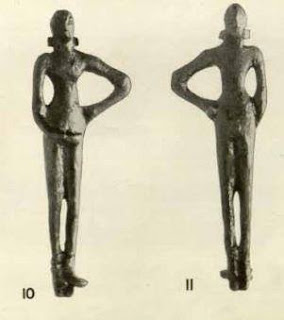
I suggest the cire perdue dancing girls of Mohenjo-daro signify the profession of writing. Hence the dancing postures of the girls signify a scribe.
Hieroglyph: ಕರಣ rhythm, dramatic actin, dancing posture (Kannada)Rebus: करण m. writer , scribe; a class whose occupation is writing, accounts (Monier-Williams)
Rebus: करण m. writer , scribe; m. a man of a mixed class (the son of an outcast क्षत्रिय Mn. x , 22 ; or the son of a शूद्र woman by a वैश्य Ya1jn5. i , 92 ; or the son of a वैश्य woman by a क्षत्रिय MBh. i , 2446 ; 4521 ; the occupation of this class is writing , accounts &c ); n. the special business of any tribe or caste (Monier-Williams)
The researchers have to explain a navigable river used by Sarasvati seafaring merchants with links to Mesopotamia
I agree with KS Valdiya's views on thi study of Dave et al. Archaeological evidence is abundant that a navigable waterway linked over 2000 sites of the Sarasvati River Basin with Persian Gulf and the Tigris-Euphrates doab in Mesopotamia. This maritime trade activity cannot be wished away by anecdotal studies of the this Dave et al type.
Revisiting the contemporaneity of a mighty river and the Harappans: Archaeological, stratigraphic and chronometric constraints Article in Quaternary Geochronology · May 2018
Sands of time

Pottery with Indus Script hypertexts, wealth-accounting ledgers, metalwork catalogues
https://tinyurl.com/yb7ucrfr
1. Body, peacock, ficus Indus Script hypertexts on potsherds signify helmsman metalsmith expertise on calcining metal, copper, iron https://tinyurl.com/yaxhgoka
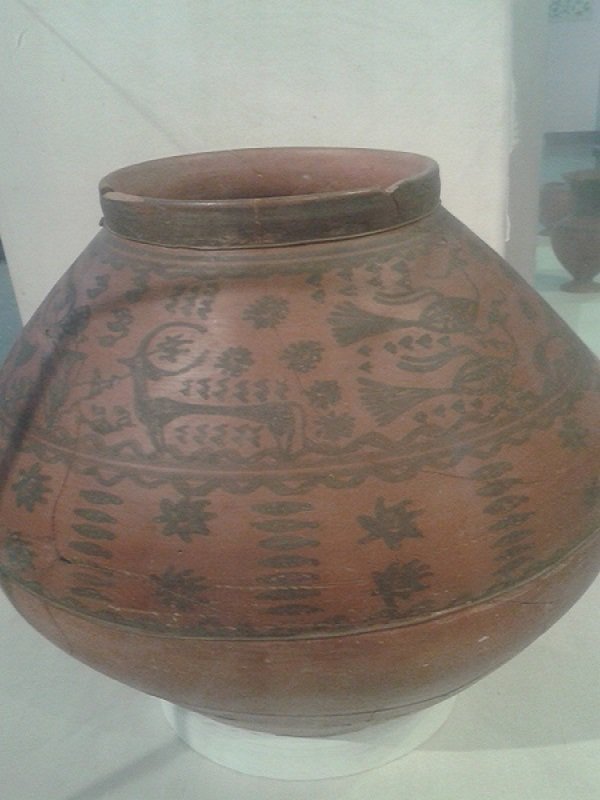
Pot from Indus Valley Sarasvati Civilization. National Museum , Delhi ca. 2000 BCE.
maraka 'peacock' rebus: marakaka'copper alloy, calcining metal'
miṇḍā́l 'markhor' (CDIAL 10310) Rebus: meḍ (Ho.); mẽṛhet 'iron' (Munda.Ho.).
mēḍh 'pole star' rebus: mēḍ 'iron' med 'copper' (Slavic) .medhā 'dhana,yajna'

Terracotta slip painted bowl depicting deer. Indus Valley Sarasvati Civilization http://heritage.gov.pk/html_pages/indus_pots.htm

kola 'woman' rebus: kol 'working in iron'
mēḍh 'pole star' rebus: mēḍ 'iron' med 'copper' (Slavic) .medhā 'dhana,yajna'
hattār 'buffalo horn' Rebus: taṭṭār 'brass worker'
See: http://www.bbc.co.uk/schools/primaryhistory/indus_valley/art_and_writing/teachers_resources.shtml Indus Valley Teachers' Resources
http://www.nationalmuseumindia.gov.in/pdfs/Harappan-Civilization.pdf Download the Museum's Activity Book for children.











































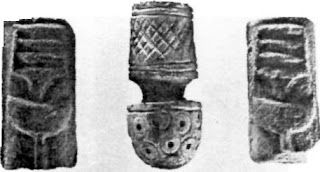












































 m1429
m1429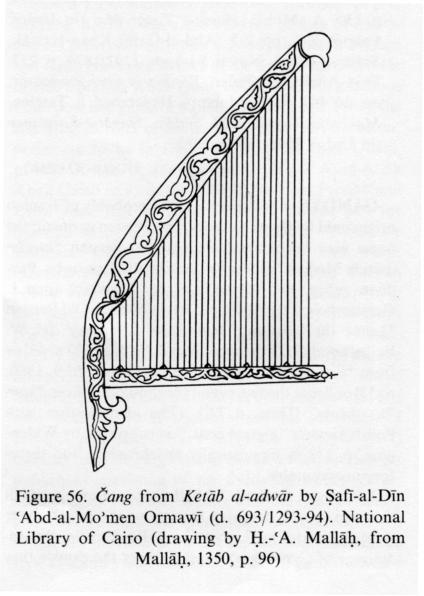
 Chapitre 1
Chapitre 1


 Carved stone tablets with the inscription Om syllables from Om Mani Padme Hum mantra - Everest region, Nepal, Himalayas
Carved stone tablets with the inscription Om syllables from Om Mani Padme Hum mantra - Everest region, Nepal, Himalayas



![clip_image033[4]](http://kalyan97.files.wordpress.com/2007/06/clip-image0334-thumb.jpg?w=71&h=44)

